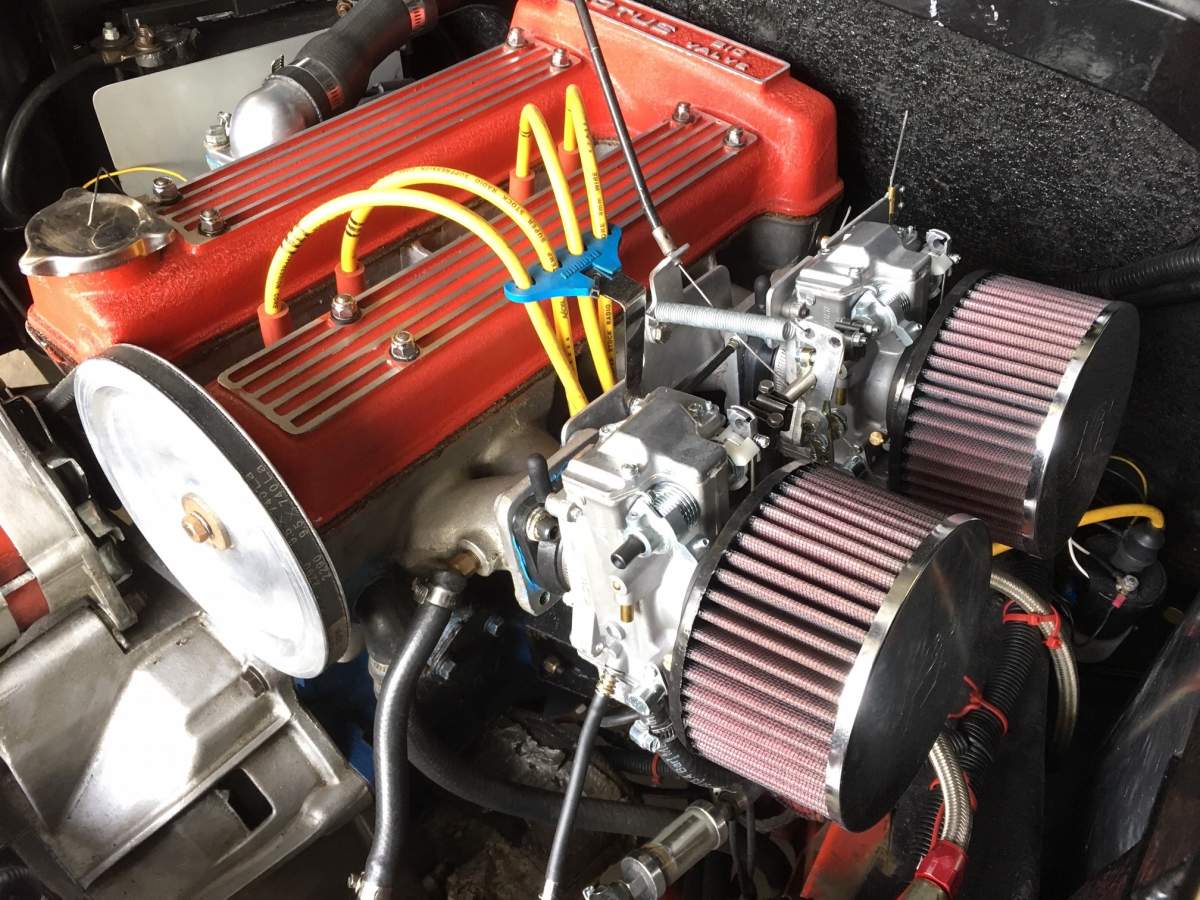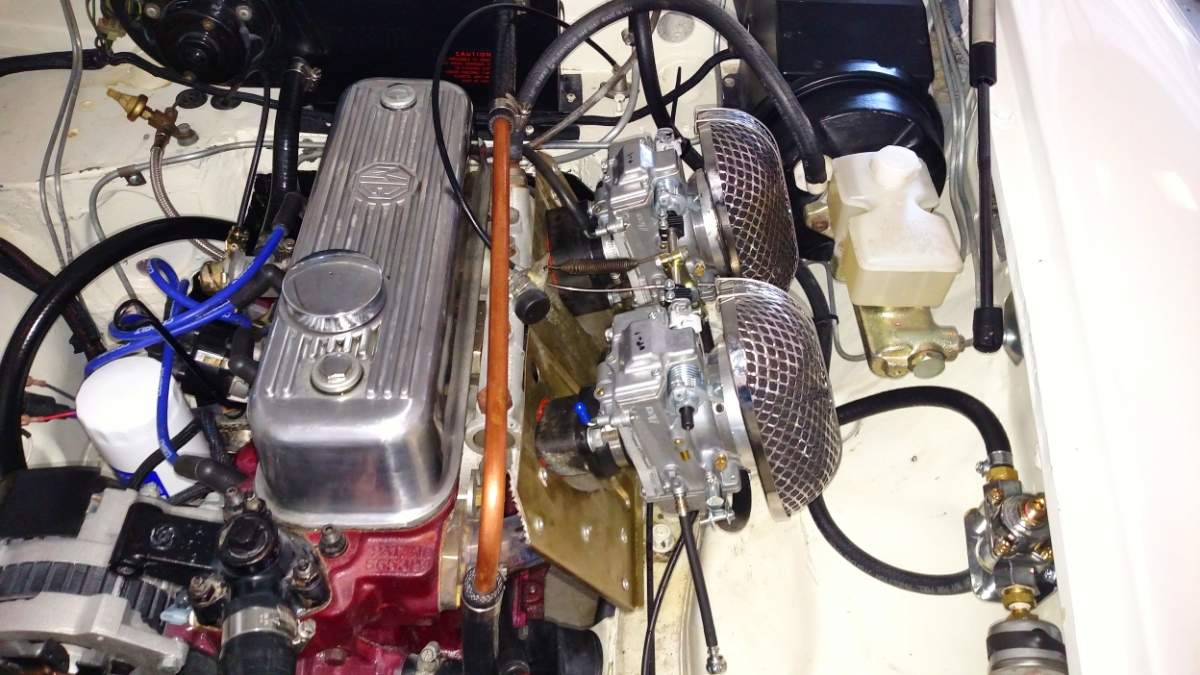Printable Catalog: Updated 2024-02-20
|

>> Questions - Order Process - PaymentsQuestions -Email correspondence strongly preferred. Email with questions on your particular needs as we have many other parts and services available. If we don't have it we can usually get it or make it. If you need to call, the best time and number is usually 315 478 1229 mornings 10:00 AM - 1:00 P.M. eastern US time. Leave a message if there is no answer as we may be in the shop and cannot get to the phone. If we do not answer or call back try cell # 315 440 6560 and leave a message. There are often periods of 3 - 5 days, especially during the summer, when we are away due to other commitments and the office is closed, though shipping and engine work is continuing at other locations. Although I try to return calls and emails even when out of town, some are replied to when we return. Orders - The easiest way to order is to send an email listing your parts order along with your address and we will reply with information on parts availability and a total price with shipping. Please include information indicating the car model & year with each email, and indicate under "subject " the make of the vehicle and type of part you would like to order. This will keep it from being filtered out as spam. Payments - Payments are normally made by check, credit card, or through Paypal (www.paypal .com) Payments made by Paypal should be made to the account under our email address: jparker3@twcny.rr.com, or we can send you a paypal invoice. We also accept bank wires for larger amounts. |
Supercharger
The Supercharger Kit for Vintage Volvos
The Supercharger Kits described below are unfortunately no longer available.
Described below is the supercharger kit that we developed starting in 2000 and offered for many years after. It was a great project, that demonstrated what could be done and the level of performance that could be achieved from an old Volvo b20 engine. In the future tis possible that we may do a few custom supercharger installations, but this will be on a very limited and exclusive basis. As an alternative, we now offer larger displacement normally aspirated B20 engines that produce more power than superchargers installed on stock engines. Below is the information on the last kits offered, to be used as a reference.
-----------------------------------------------------------------------------------------------------------------------------------------------------------------------------------
The Supercharger System Kit for Volvo B18/B20 engines comes complete with Autorotor Supercharger, Laminova 3 tube water to air intercooler, Nissens intercooler radiator, new custom modified Mikuni carb for the carbed version, and all other parts needed to make this a bolt on kit. The fuel injected version does not include the programmable fuel injection system which is needed to replace the original D Jet system. Recommended FI systems include Megasquirt and Simple Digital Systems.
Prices for the complete supercharger system are $4195 for the Mikuni carbed version, $3595 for the fuel injection ready version without throttle body, and $3895 for the fuel injected version with throttle body and linkage, including recent upgrades, plus $75 in refundable core charges.
Currently, no further supercharger orders are being accepted for the .87 liter displacement supercharger until more are available from Autorotor/Lysholm. However there is a good supply of the slightly smaller .76 liter compressors and these can also be used in our kits.
Below is the supercharger section from our old website.
In the spring of 2000 I began testing a modern, positive displacement, belt driven supercharger on a 1968 1800. The results were truly astounding and transformed the car's performance. Zero - 60 MPH times were reduced by more than 6 seconds with a stock B18 engine. Since then there have been numerous refinements that have allowed that first prototype to evolve into a bolt on kit available to fellow vintage Volvo owners. In the process we have added a state of the art water to air intercooler as an integral part of the kit. On an otherwise stock B20 in an 1800ES, with modified head and exhaust, the system has been dynoed at over 200 HP at only 8 lbs. boost with 0 - 60 times of under 7 seconds.
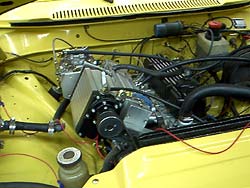 |
| Supercharger in a 140-series Volvo |
Why a supercharger rather than a turbocharger? There are two basic reasons. First, simplicity - we wanted to make a reliable kit that would be available as a true bolt-on with no engine modifications. Second, driveability - we wanted to produce a system that not only had outstanding performance, but was also easy to drive, with good power throughout the RPM range. Essentially, you don't know that it is supercharged until you put your right foot down.
Our supercharger choice is a belt driven, positive displacement, twin-screw, Lysholm principle supercharger, built by Autorotor in Sweden. Extensive research showed that Lysholm principle superchargers provide several advantages over other designs including greater low rpm boost, higher volumetric efficiency, reduced drive power requirement, and lowered discharge temperatures. These superchargers have the highest thermal efficiency of any fixed displacement superchargers available. But perhaps the greatest benefit of the twin-screw supercharger is its inherent ability to produce consistent, high boost pressures across a wide RPM range.
Although the high efficiency of the supercharger used allows it to function effectively without an intercooler, developments after doing the first prototype made it possible to incorporate a water to air intercooler into the system. As with the supercharger, the Laminova intercooler cores are a patented Swedish design. Using these cores allowed us to create a package that uses one structural unit for both the intake plenum and the intercooler, saving both weight and space, and increasing both horsepower and reliability at minimal additional cost. The system uses a small electric pump to circulate water through the intercooler cores and a front mounted radiator. With the intercooler, supercharger discharge air temperatures are reduced. Lower intake air temps mean a denser charge, less chance of detonation, less engine stress and more POWER!
Are their disadvantages to this design? One disadvantage is cost - you have to pay for high quality. Being the highest quality supercharger/intercooler combination available, the same as used in various Porsche, Mercedes, and BMW aftermarket installations and the same basic design as used in recently introduced high performance AMG Mercedes models, the choice here was to go for quality rather than the lowest possible cost. However, it is another example of getting what you pay for - the best product for your money, and that is consistent with our product philosophy and Volvo's.
The supercharger-intercooler unit bolts on in place of the stock carburetors or fuel injection manifold.
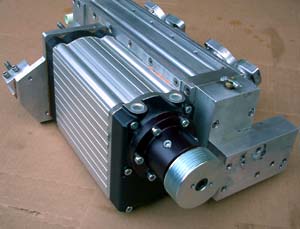 |
| Supercharger and Intercooler |
Installation of the whole system requires 4-8 hours depending on skill levels. Installation on fuel injected 1800s and 140s requires a few extra steps, but does not require replacement of the fuel injection fuel pump, lines, filter, etc. If you perform the maintenance on your own vehicle you have the skill required to install this supercharger system, and do it in a day. The system comes complete with a suitably tuned sidedraft Weber 45 DCOE carb, air cleaner, modified crank pulley, belt tensioner, hardware, belts, hoses, connectors and adapters, and is ready to install. Once installed and tuned it is essentially a maintenance free system, other than the routine type of inspection needed for any automotive accessory drive belt drive.
The initial kits have been designed for all B18 and B20 engines, whether carbed or fuel injected, but without air conditioning. A second version, available soon, with a modified belt drive system will accommodate air conditioned vehicles. Work on a system that will allow the use of an aftermarket fuel injection system is underway. Continued development and testing will produce additional modifications designed to incrementally increase all aspects of the car's performance.
Reservations should be made in advance as kits are done on a custom basis and take approximately 12 - 14 weeks from the date of order to delivery. Costs have gone up due largely to the lower value of the dollar. The current price is $4195 for the new Mikuni carbed version, $3595 for the fuel injection ready version without throttle body, and $3895 for the fuel injected version with throttle body and linkage, including recent upgrades, plus $75 in refundable core charges. The kit comes complete with Autorotor Supercharger, Laminova 3 tube water to air intercooler, Nissens intercooler radiator, new custom modified Mikuni carb for the carbed version, and all other parts needed to make this a bolt on kit. The fuel injected version does not include a programmable fuel injection system which is needed to replace the original D Jet system.
Currently, no further supercharger orders are being accepted for the .87 liter displacement supercharger until more are available from Autorotor/Lysholm. However there is a good supply of the slightly smaller .76 liter compressors and these can also be used in our kits.
The Supercharger
Our system uses an Autorotor supercharger of unsurpassed quality, designed and built in Sweden. It is a positive displacement, twin rotor, Lyshom principle supercharger of approximately one liter displacement. The Lysholm principle provides several key advantages over all other types of superchargers: greater low rpm boost, higher volumetric efficiency, reduced drive power requirement, and lower discharge temperatures. This supercharger has the highest thermal efficiency of any fixed displacement supercharger in production in the world today. This efficiency is reflected in an intake temperature rise, before the intercooler, of less than 90 degrees F at full boost and is a key to significantly increasing engine power without over stressing the engine.
From the driver's point of view, the chief advantage of this supercharger is its inherent ability to produce consistent boost pressures across its operating range, starting at extremely low engine RPMs. There is no feeling of "coming on the cam," or "turbo lag," only prodigious low end torque that continues as the car accelerates. In tests, full boost has been achieved as low as 1500 RPM. The resulting flexibility in engine operation is clearly unmatched by any other performance system.
A supercharger is basically an air compressor. The basic features of this type of compressor are two helical, gear driven shafts, one with concave lobes, the other with convex cavities which intermesh at high speed, thereby compressing the air. 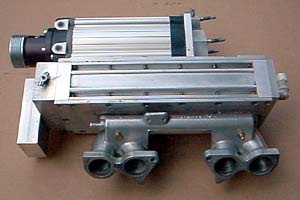 It is a positive displacement pump but has no contacting parts to wear out as in the old vane type superchargers. The air is drawn in at one end of the case, compressed between the rotors and expelled from the other end of the case in a fixed ratio. These superchargers have been used in demanding industrial applications for years where extreme reliability and low maintenance were primary requirements. Only recently have advances in manufacturing techniques allowed their cost to be reduced to the level that they can be economically produced for automotive applications where they are considered to be the highest quality supercharger available.
It is a positive displacement pump but has no contacting parts to wear out as in the old vane type superchargers. The air is drawn in at one end of the case, compressed between the rotors and expelled from the other end of the case in a fixed ratio. These superchargers have been used in demanding industrial applications for years where extreme reliability and low maintenance were primary requirements. Only recently have advances in manufacturing techniques allowed their cost to be reduced to the level that they can be economically produced for automotive applications where they are considered to be the highest quality supercharger available.
The supercharger itself is essentially a sealed, self lubricating unit, with an industrial use rating of 22,000 hours at 15,000 RPM. That translates into more than 1 million miles at 60 MPH before a rebuild would be required. The gears which drive the twin screws do require lubrication. In order to eliminate the need for maintenance, or checking oil levels as in some other kits, our system lubricates the gears using engine oil fed by the engine's own lubrication system. All oil lines and fittings for the lubrication system are included.
With an appropriately sized supercharger in relation to engine displacement, boost levels are determined largely by the speed ratio between the supercharger and the engine. As it is a positive displacement supercharger, this is a linear ratio. A 50% increase in the RPM of the supercharger in relation to engine speed will produce a theoretical 50% increase in boost pressure, all other things being equal. See the "drive system" section for more information on changing boost levels.
The Next Generation of the Supercharger System
It has now been 7 years since our first supercharger system hit the road. Followed by the intercooled version a year later, it revolutionized the concept of the power that could be obtained from a B18/B20 pushrod motor and the kind of performance that you could enjoy in a vintage Volvo. Since then, changes have been more evolutionary in nature.
Development of the system continues and now allows us to produce more power per pound of boost with improved fuel economy. Improvements in cam, head and exhaust design have been essential to this process. One result has been a cam designed specifically for use with the SC system. For 200 HP or more, one of our Street Performance Heads is a necessary element. Customers using other ported heads have not been able to achieve the same power.
In the beginning, producing power was almost the only consideration. But having met our original performance goals, the goals for the system have broadened, with improvements in long term reliability and fuel mileage becoming more important than power increases.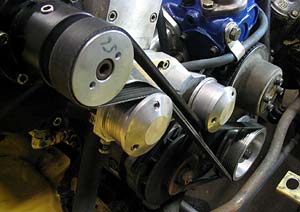 To implement these improvements, changes to the system include CNC machined aluminum crank pulleys, a spring loaded belt tensioner system for the drive belt, new anodized aluminum idler pulleys of our own design, and an intercooler radiator 40% larger than the original. But the most significant change to date is in the carburetor. We now use a modified version of the same HSR 45 Mikuni described above as an "SU replacement," and use it to get an increase of more than 50% in cruising fuel mileage. With this carb you no longer have to sacrifice fuel mileage when you opt for supercharger performance - cruising at 25 mpg is routine.
To implement these improvements, changes to the system include CNC machined aluminum crank pulleys, a spring loaded belt tensioner system for the drive belt, new anodized aluminum idler pulleys of our own design, and an intercooler radiator 40% larger than the original. But the most significant change to date is in the carburetor. We now use a modified version of the same HSR 45 Mikuni described above as an "SU replacement," and use it to get an increase of more than 50% in cruising fuel mileage. With this carb you no longer have to sacrifice fuel mileage when you opt for supercharger performance - cruising at 25 mpg is routine.
With normally aspirated B20s available with power in the 150 - 200 HP range, our basic recommendation is to reserve supercharging for those customers who want at least 180 HP. We also recommend that all supercharged cars have suspension upgrades and other modifications that are necessary to safely accommodate power levels that will completely transform your car's performance.
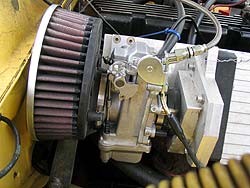 For those who want to use fuel injection, and it is recommended for anyone with a car that currently has FI, we offer a "fuel injection ready" version of the supercharger system. No, it does not include a fuel injection control system. And, no, you can't use it with D-Jet. But you can use it with your stock injectors, fuel rail, fuel pump, fuel lines and fuel pressure regulator. Since we now offer the fuel injected version with an adapter plate, Mustang throttle body with TPS, and throttle linkage, you can now install Megasquirt or Simple Digital Systems, etc, instead of the D-Jet ECU, sensors and wiring, and you are ready to go with a fuel injected supercharger system. See Steve Berry's website www.1800philes.com and an article he wrote that appeared in the Nov. 2006 issue of Grassroots Motorsports magazine for details on using Megasquirt with our supercharger system. Steve also has an S60R, and says his supercharged 1800, even at midrange boost settings, is faster.
For those who want to use fuel injection, and it is recommended for anyone with a car that currently has FI, we offer a "fuel injection ready" version of the supercharger system. No, it does not include a fuel injection control system. And, no, you can't use it with D-Jet. But you can use it with your stock injectors, fuel rail, fuel pump, fuel lines and fuel pressure regulator. Since we now offer the fuel injected version with an adapter plate, Mustang throttle body with TPS, and throttle linkage, you can now install Megasquirt or Simple Digital Systems, etc, instead of the D-Jet ECU, sensors and wiring, and you are ready to go with a fuel injected supercharger system. See Steve Berry's website www.1800philes.com and an article he wrote that appeared in the Nov. 2006 issue of Grassroots Motorsports magazine for details on using Megasquirt with our supercharger system. Steve also has an S60R, and says his supercharged 1800, even at midrange boost settings, is faster.
And for those of you who insist on ruining the traditional sports car experience of being either too hot or too cold by insisting on air conditioning, for 2006 we will have a kit that will allow the supercharger system to be used with AC.
Our original power goal with an otherwise perfectly stock engine was 150 HP. The next goal, with a modified head and exhaust system, was 200 HP at 8 lbs. boost, then 250 HP at 15 lbs. All were achieved. Then the priorities became refinement, reliability, and fuel mileage. Now, having met our goals in those areas we can turn back to power. So for 2007 our power goal will be double the original: 300 HP from a 2 liter street engine, 3 times stock HP, while still getting 25 - 30 miles per gallon. Check back for details.
The dyno chart below shows the power progression from stock engine to the most popular configuration - 10 lbs. of boost producing 216 HP at the flywheel and 221 ft. lbs. of torque.

The dyno chart compares tests of flywheel horsepower of a stock 1800ES with three different supercharged configurations. The bottom line is the stock ES. The 2nd line from the bottom represents the same car with stock engine and exhaust system with the supercharger producing a maximum of 7.7 lbs. boost. The 3rd line from the bottom is the same stock engine and exhaust with a different SC drive pulley ratio producing up to 10.5 lbs. boost. The top line is the same car with our performance head, "C" cam, 4-2-1 header, and 2-1/2 inch exhaust system with muffler and resonator at 10 lbs boost, clearly demonstrating that you do not need to increase boost to increase power. This power level in an 1800 is good for 0-60 times in the 5 second range.
Intercooler System
Compressing a gas increases its temperature. The purpose of an intercooler is to reduce the temperature of the air compressed by the supercharger. As the result of the reduction of temperature a denser charge is produced. A denser,
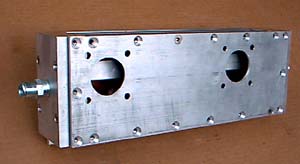 |
| The Intercooler |
Our intercooler is of the water to air type. Like the supercharger it is a patented design, using heat exchanger cores made by Laminova in Sweden. Unlike the typical intercooler that uses air to air cooling, it uses water ( or a water/antifreeze mix ) to cool the air compressed by the supercharger. The higher specific heat value of water gives this type of system a distinct advantage in its ability to absorb heat energy, and also allows for a much more compact installation.
The system essentially consists of two small heat exchanger units. One is a radiator, mounted in front of the vehicle's normal radiator. There water is cooled by outside air moving through the radiator in the same manner as in the vehicle's cooling system.
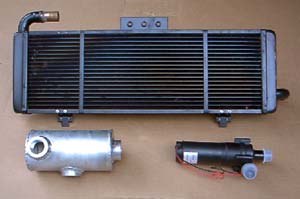 |
| Intercooler radiator, coolant pump and filler tank |
Brackets, hoses, an electrically powered water pump (also made in Sweden), and an aluminum expansion tank are all included in the kit and are easily installed. The pump is designed to be in operation whenever the engine is on; thus no complicated wiring is necessary.
Drive System
The supercharger is driven by a modern, multi-rib drive belt system running off of the engine's crankshaft. The crankshaft pulley has been modified to accept this belt in addition to the normal fan/alternator belt. A high quality idler pulley is part of the system. Not only does this provide for positive location of the belt, but it is also used to provide the necessary tension for the belt system.
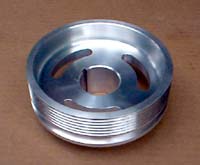 |
| Aluminum crank pulley for the supercharger drive belt |
One of the advantages of this type of drive system is the ease at which boost levels can be changed or adjusted. The boost level of the system is based on the speed ratio between the engine and the compressor. The compressor pulley can be replaced with larger or smaller pulleys in order to vary this ratio and therefore the boost level. This change can be accomplished in a few minutes and requires only that the supercharger pulley and the drive belt be removed and replaced by different size units. This allows the user to change the boost level to accommodate various circumstances such as the use of higher or lower octane fuel, or the need for more power for a weekend autocross or track day.
Performance Testing
Performance testing of the system began in the spring of 2000 with the prototype unit. The test car was a 1968 1800, with completely stock B18 engine and exhaust system. Preliminary tests before installation resulted in 0 - 60 times of 13.5 seconds, essentially the same as the results obtained when the car was new according to contemporary road tests. With the supercharger producing 10 lbs. boost we got consistent 0 - 60 times of 7.5 seconds. After a summer of testing, tuning and minor modifications, further testing was cut short when the parked test car was hit by a drunk driver at 5 AM one Saturday morning. The engine was pulled, opened up and examined. It showed no signs of any problems, even though we had run it with as much as 15 lbs. boost. Although we did not get to complete chassis dyno tests that had been scheduled, we felt we had enough information and test mileage to proceed with the design of a production version.
The process of going from prototype to production resulted in several design changes, and the final product is clearly improved, both from a customer value standpoint and improved performance. The inclusion of an integrated intercooler system was the most significant of these changes, but was only one of a number of refinements.
The delays apparently typical of the introduction of any new product put us behind schedule in going from prototype to a production version of the intercooled system. Rather than test another prototype we delayed further testing until we could test with true production parts. It took until the fall of 2001 before we were ready.
As there was significant interest in adapting the supercharger to injected cars and we wanted to be able to test through a salty northeast winter, I decided to use a recently purchased unrestored 1800ES as the test car. ("I'll sell it to the first person who can pay $750 cash and pick it up before the end of the week" was roughly the way the e-mailed offer read.) The idea was to test the system on a car that is representative of most of those out there, not a "special" with an engine built for this purpose. At times I regretted this choice, as problems not having anything to do with the supercharger system kept cropping up, and more time was spent restoring various parts of the car just to keep it running than were spent on the supercharger system itself.
Installation on the ES was very straightforward, and there was no problem at all simply hooking the Weber carb to the injected fuel system with the simple substitution of a fuel pressure regulator with a wider range than the stock regulator. As we intended to do later tests with a FI system instead of a carb, we initially left the injectors and all of their wiring in place, but later removed them as they slowed down removing and replacing the system for further modifications and testing.
The series of tests on a Superflow chassis dynamometer started with a pre-installation test of the stock 1800ES for a base line. The result of this test was a peak of 111 HP at the flywheel, 90 rear wheel HP, with stock exhaust, air filter, etc. After the supercharger installation dyno tests with the stock D cam and stock exhaust produced increases in the 40 - 50% range, with 150 HP at 6 lbs. boost and 170 HP at 10 lbs. boost being examples. During these tests it became apparent that power was being limited by the restrictions in the exhaust system as further increases in boost produced negligible increases in power.
We then changed to one of our performance heads with modified exhaust ports and larger exhaust valves, short 2.5 inch diameter exhaust, single performance muffler and C cam. The aim for this setup was to exceed 200 flywheel HP - the equivalent of what we get on the vintage race cars on the same dyno. On April 5, 2002 we tested the modified system with the same drive pulley ratio as on the last of the unmodified engine tests. We got 173 HP at the rear wheels, 208 HP at the flywheel, at only 8 lbs. boost. This was an increase of over 30 flywheel HP at 3 lbs. less boost than the test with stock components. Clearly exhaust flow in the stock setup has been a problem. After running for about a month at this boost level the boost was increased to 12 lbs. and our knock sensing timing retard system was hooked up to eliminate detonation problems typically encountered when running at high boost levels. As of the writing of this update, the car had not been dyno tested at this level of boost, but power has increased significantly over the 8 lb. boost level and is estimated to be in the 240 HP range. (If any one would like more details on the dyno tests please e-mail me so that I can send copies of individual tests.)
On the road the test car recorded a best 0 - 60 time of 11.8 seconds before supercharger installation. With the supercharger, modified head and exhaust, we were able to do it in under 7 seconds, but clutch slip with the stock clutch limited the ability to launch the car from a standing start. In order to preserve the stock components, further standing start tests were postponed until drive train modifications were made to accommodate power levels over 200 HP. The supercharged test car has been driven daily for over eight months, and has gone on several trips including a 600 mile, one day blast through portions of New England. Even though the trip included some high speed demo miles and vigorous runs through the mountains, fuel mileage on this trip averaged 18 miles per gallon, with 20 MPG being recorded for the NYS Thruway portions.
Significant conclusions from the testing of different configurations are as follows:
- Power increases of 40 - 50% can be achieved at boosts of 6 - 8 lbs. with an entirely stock engine and exhaust.
- No special ignition timing controls are needed with low compression engines at boosts in the 6 - 8 lb. range, but may be necessary for high compression engines - above 9 - 1 compression ratio, depending on level of boost, static timing, tuning, cam, and weather conditions. 4) For boosts over 8 lbs. a timing retard system is needed even with compression ratios as low as 8.5 - 1.
- The stock exhaust system is a critical element limiting the power that can be produced with approx. 170 HP being the power limit for the stock system at boost levels higher than recommended for an entirely stock engine.
- The stock driveline is adequate for power up to the 200 HP level, but both clutch and overdrive slippage are problems with power above this level.
- The most satisfying configuration includes a free flowing exhaust, modified head, and knock sensing ignition retard system to achieve over 200 HP.
The 200 + HP versions of the system have all of the power I could want on the street. Considering that most early Volvos weigh from 2300 - 2700 lbs., the power to weight ratio of these cars with the supercharger is better than many modern sports cars and sports sedans. In most cases the supercharged Volvo will also have a much broader power band, and this translates not only into ease of driving but better overall acceleration. Coupled to suspension improvements it is probably as close to having my vintage race car on the street as I am going to get, and quite a thrill to drive, especially on the back country roads sports cars were designed for. Hopefully it is a solution for all of those who have said, "I really love my old Volvo, but it just doesn't have enough power."
The results of future tests of the car with modified driveline at even higher boost levels will be posted here as the tests are completed. At this point we are only beginning to explore how much power the system will produce with further modifications.
Gauges and Monitoring
We believe strongly in the importance of monitoring engine performance. The 1800ES that is currently being used as the test bed for development of the supercharger system not only has the 1800's normal full compliment of gauges, but also a boost gauge, charge air temperature gauge, intercooler water temp gauge, exhaust gas temp gauges for each cylinder, and a compliment of LEDs. These LEDs indicate the air/fuel ratio and show not only whether there is any detonation/pinging, but also where it is occurring, the frequency and severity. While this type of instrumentation is only necessary for testing, we do recommend that anyone who plans to "push the system" with hard driving and/or engine modifications have water and oil temperature gauges, a boost pressure gauge, and an air/fuel ratio gauge wired to an oxygen sensor in the exhaust system. Using these gauges will assure that the engine is not put under any undue stress and will greatly simplify tuning after the supercharger installation. We can help you by supplying and/or installing any of these instruments.
Upgrades
The basic supercharger system was designed as a bolt-on system that takes advantage of the rugged nature of the B18/B20 family of engines to produce significant increases in power while keeping engine stress within limits that will not jeopardize the renowned reliability of these engines. At recommended boost levels, no engine or drive-line modifications are required for power increases of as much as 50 - 60 %.
However, we recognize that it is in the nature of performance driving (and human nature) not to be satisfied with the amount of power you have, even though it is a lot more than you used to have. With this in mind, we have built into the supercharger system the ability to upgrade for more power without having to change any of the basic components. A smaller supercharger would have been easier to package, but would not have been upgradeable for higher horsepower applications. An intercooler is a highly recommended performance option on most systems but has been built into ours at no extra cost.
Ignition Systems
Computer controlled ignition systems will allow higher boost pressures to be run by retarding the ignition to prevent detonation. These systems retard the ignition either at a preprogramed rpm, boost pressure, or when detonation (knock) is sensed. We can offer a range of these systems for those want to run higher boost pressures than the standard system.
On our test cars we use a small computer controlled system built by J&S Electronics that senses detonation on an individual cylinder basis and retards the ignition timing to that cylinder only, and then only in the amount necessary to eliminate the detonation in that cylinder. Using this system we have run boost pressures as high as 15 lbs. on a stock engine and expect to go much higher. The system also includes a boost level regulated timing retard, rev limiter, and high output ignition. The current price for this ignition system is $495.
Engines
At some point, the stress that can be produced by high boost pressures is more than can be accommodated by production components. Fortunately, our experience with racing engines puts us in a perfect position to provide the necessary components for ultra high performance applications. Even though our stock test engines have stood up to over 200 HP, we recommend that those who intend to run hard at high boosts do it with an engine rebuilt with forged pistons and other components designed to take considerable abuse. Where appropriate these may include forged pistons, aftermarket connecting rods, etc. See our price list for details on engine options.
Driveline Components
We have been pleasantly surprised that the stock Volvo driveline components have not given us any serious problems with power levels up to 200 HP. However, we are clearly at the point of over stressing these components when we get to the 200 HP level. The problems and solutions are listed below:
• Clutch: At over 200 HP the stock clutch slips in the lower gears. We are currently offering a heavy duty clutch disc that will allow the stock type clutch to work at this power level. We also offer race and rally type aftermarket clutch systems.
• Differential: With an open differential, standing start acceleration as well as cornering under power is limited by the power going to one wheel. A limited slip differential is the obvious cure and we can supply these for most models.
• Transmission: The overdrive slips with sudden applications of power. A transmission swap to a true 5 speed such as a Borg Warner T5 or a Toyota transmission is the answer. Some of these transmissions have an overdrive 5th gear with a lower numerical ratio than the M41 overdrive and should provide for better fuel mileage.
• Gearing: Improvements in fuel mileage as well as acceleration through the gears are limited by the high rear differential gear ratios in the various Volvo models. As these ratios are not needed for low end performance with the supercharger system, a change to a lower numerical ratio is recommended. We can provide different ratio gear sets for most rearends.
Fuel Injection
Research has made it clear that the stock D Jet system will not work with forced air induction systems. However, there are several modern aftermarket, programable fuel injection systems available that can be used to replace the D Jet controller, wiring and sensors, at reasonable prices. Testing on the use of this type of FI system is planned. The supercharger system is designed so that the carb can be replaced by FI at minimal cost and use the stock fuel pump, lines and injectors of the D Jet system. It is expected that both power and fuel efficiency can be improved with a modern FI system.
Over the next year we will do a little playing and see how much performance we can really get out of the system. As we experiment, additional components we be developed and offered to fill your needs.
Suspension
Suspension improvements from VPD
2023 marks the 25th year of our work on Volvo street suspensions. During that time our development and testing produced significant advances in the suspension components available for old Volvos - including a range of custom progressive rate lowering springs and shocks from Bilstein valved to our specifications where required. The only way to "get it right " was to have springs and shocks designed and built to our specifications. Used together, these shocks and springs became the standard options for upgrading the ride and handling of vintage Volvos, with versions designed for use on the street, track, or both.
.jpg) |
After working on race car springs for a while, this was one of the first street cars that we provided a suspension for -in 1998 - based on our progressive rate lowering front springs, which allowed us to provide more control and much better handing, without hurting the ride. |
February 2023 UPDATE - We have some progressive front springs left from prior batches and are looking forward to receiving more with an upgraded specificaiton later in the year. If you need springs, what we have in stock are better than any others currently availalbe. We also have single rate spring sets in stock and rears to go with the front progressives.
The last few years have brought changes in our spring supply and production as he Covid years have to the rest of the inducstry. The company that had been supplying our springs from the begining was reorganized, and then purchased by another company, and no longer able to reliably meet our spring needs. This caused a disruption in supply, and we had to turn to another spring maker to suppliment our supply, and eventually make a new line of springs for us. Unfortunately, rolling out springs with new suppliers has taken much longer than anticipated as it included a period of re- design and pre- production testing of sample springs and then a further disruption caused by Covid. This process is slowly moving forward and we look forward to receiving more of the progressive front springs with an updated specification later in 2023.
While waiting for new springs to become available, we still have plenty of rears and a smaller number ofprogress front springs in stock from previous production runs.
----------------------------------------------------------------------------------------------------------------------------------------------------------------------------------------
Why you should upgrade your springs and the rest of the suspension as a first step restoring your old Volvo.
If you plan to really use your older Volvo changes to the suspension are needed. Volvo was slow to make the transition to modern handling. Reviewers of Volvos 1960's era cars - from Road and Track, Sports Car Graphic, Car and Driver magazines - agreed that they were typically too high off the ground and had excessive roll in corners - and those were contemporary reviews comparing Volvos to other cars of the same era. These were characteristics that were fine for rough winter roads in Sweden, but not the most appropriate for driving conditions in the US. Today, with faster traffic speeds, improving the suspension is an even more important safety issue. Our suspension components are designed to bring modern handling to older Volvos and are a necessary part of any performance package. Progressive rate suspension springs are a significant advancement over other spring sets offered. Combined with appropriate lowering of the vehicle, attention to suspension bushings, shock absorbers, and sway bars where necessary, the handling of an older Volvo can truly be transformed.
Quick recommendation:
To solve your handling and ride problems - Progressive Rate Lowering Spring Sets, Bilstein Shocks (with custom valving where needed) , and Polyurethane Suspension Bushings
Blue was the standard color for our springs in the past. The newer springs are black as in the photo below of a set.
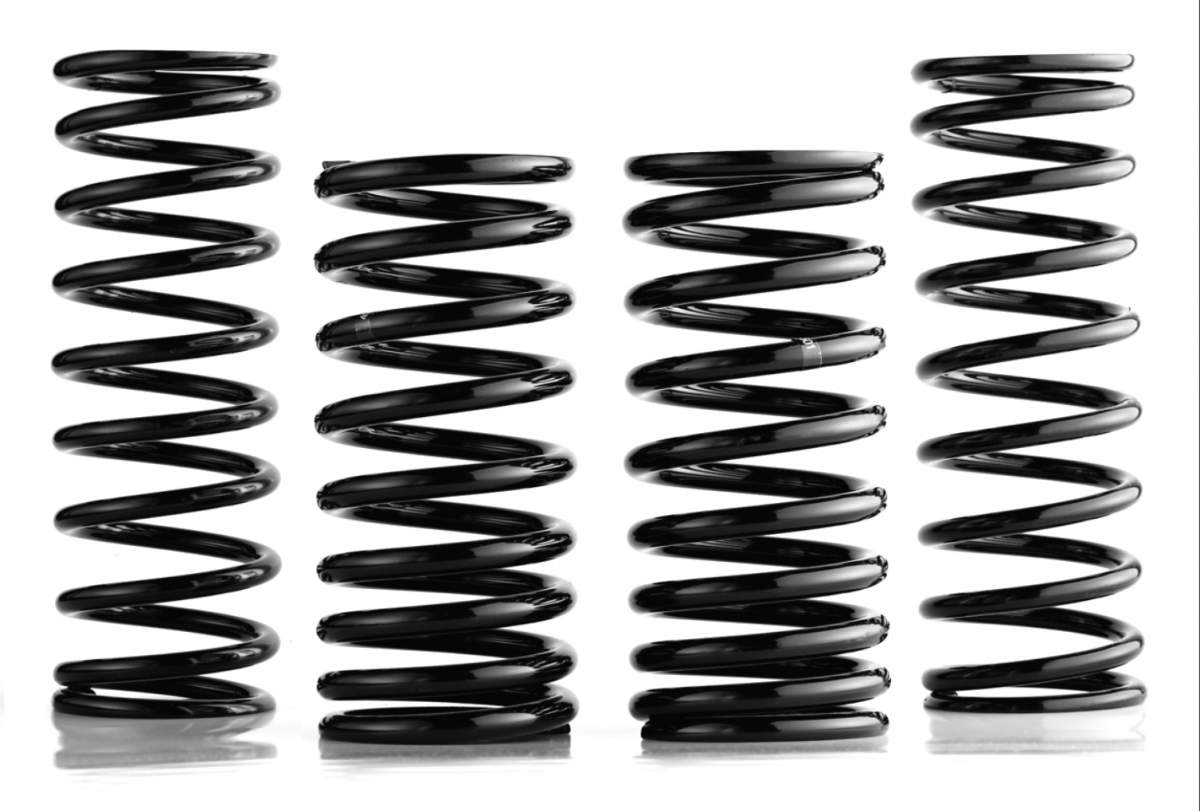 |
The photo shows one of our progressive spring sets, progressive fronts in the middle, single rate rears to the outside. This is one of our taller sets, shown in black. Brian Harris © 2011.
Suspension Springs
- Springs are the heart of any suspension and have to be changed in order to achieve significant improvements.
- Just adding stiffer sway bars only addresses the cornering roll part of the problem and creates others.
- Lowering the car is an important element in improving the handling as once the center of mass is lowered the suspenision does not have to be as stiff in order to control body roll.
- Progressive rate springs offer a combination of handling and ride comfort that cannot be duplicated by single rate springs.
- Our standard spring package for street or sport for the 122/1800/140 is a lowering spring set with progressive rate fronts and single rate rears designed to lower the car 1 - 1.5 inches from original stock. 122/1800 - $315 140 - $330
- Springs offering lowering greater than 1.5 inches usually available.
Traditionallly most aftermarket suppliers of Volvo springs have only offered one replacement sport spring set for the Volvo 1800/122/140, usually 20% - 30% stiffer than stock and designed for a 1 to 1 1/2 inch lower ride height than stock. These same springs have been offered for over 30 years, and they still have the same problem they have had since the beginning. A stiffer single rate spring improves cornering ability by limiting roll, but the ride quality is adversely affected. In order to keep the ride quality at least tolerable they cannot be stiff enough to improve cornering as much as is desired, but are still stiff enough to give a harsh ride on the street. Quoting Volvo's own R-Sport Performance Parts Catalog, "The shorter and more stiff the spring, the worse the ride becomes." Volvo recognized that the problem could be solved with progressive rate springs, recommended them for all applications where stiffer than stock spring rates were desired, and included them in their suspension upgrade kits. We do the same, and now have a wider choice of ride heights.
Following our lead, other companies are now offering progressive spring sets, but due to their lack of development and testing time have missed the mark in terms of actual performance. If they cannot describe to you their testing and development process and do not know the individual spring rates, then the conclusion as to their quality should be obvious. The specs on our progressive springs are set forth below.
In addition to our progressive rate spring line we still offer traditional single rate street and race performance springs, including a range of springs in different heights and rates to fit individual needs. This allows you to tailor the handling to your driving style and intended use of the vehicle. But unless your use is pure track racing, the progressives are the way to go.
See the customer comments at the end of the suspension section.
Progressive Rate Springs
Soft enough for your daily driver - stiff enough to win the Carrera Panamericana Race - 2009 Historic Class A
-
Progressive 4 spring set for 122 sedan or wagon and 1800 ( progressive fronts - matching single rate rears ). Available in a choice of ride heights. $315
-
Progressive 4 spring set for the 140 and 164 models ( progressive fronts - matching single rate rears ) $330
-
Progressive rate front street springs per pair $170
Single rate springs were the only choice for vintage Volvos before we developed our progressive rate spring sets. Progressive rate springs solve the single rate spring ride quality problem. With progressive springs, to quote the Volvo R-Sport Catalog, "...the rate or stiffness of the spring progressively increases as the spring is compressed... This results in a relatively comfortable ride during normal driving but provides the necessary stiffness for large bumps and hard cornering." For this reason most of the springs offered in Volvo's R-Sport Catalog were progressive rate springs.
The following specifications illustrate how progressive springs are different. Most stock front springs for the 122/1800/140 are in a range close to 250 lbs. to 270 lbs. per inch. Most aftermarket single rate "sport springs" that are offered are in the 320 - 350 lbs. per inch range - not stiff enough for great handling, but stiff enough to hurt the ride. Our progressive rate front street springs are generally in the range of 230 - 250 lbs. per inch for the soft coils and 450 - 500 lbs. per inch for the stiff coils, with intermediate coils in between which progress in stiffness from the soft to the stiff coil range. It is this progression from coils softer than stock to coils that are much stiffer, and how abrupt or gradual the progression is, that allows the same spring to provide both a softer ride and better handling than a single rate sport spring.
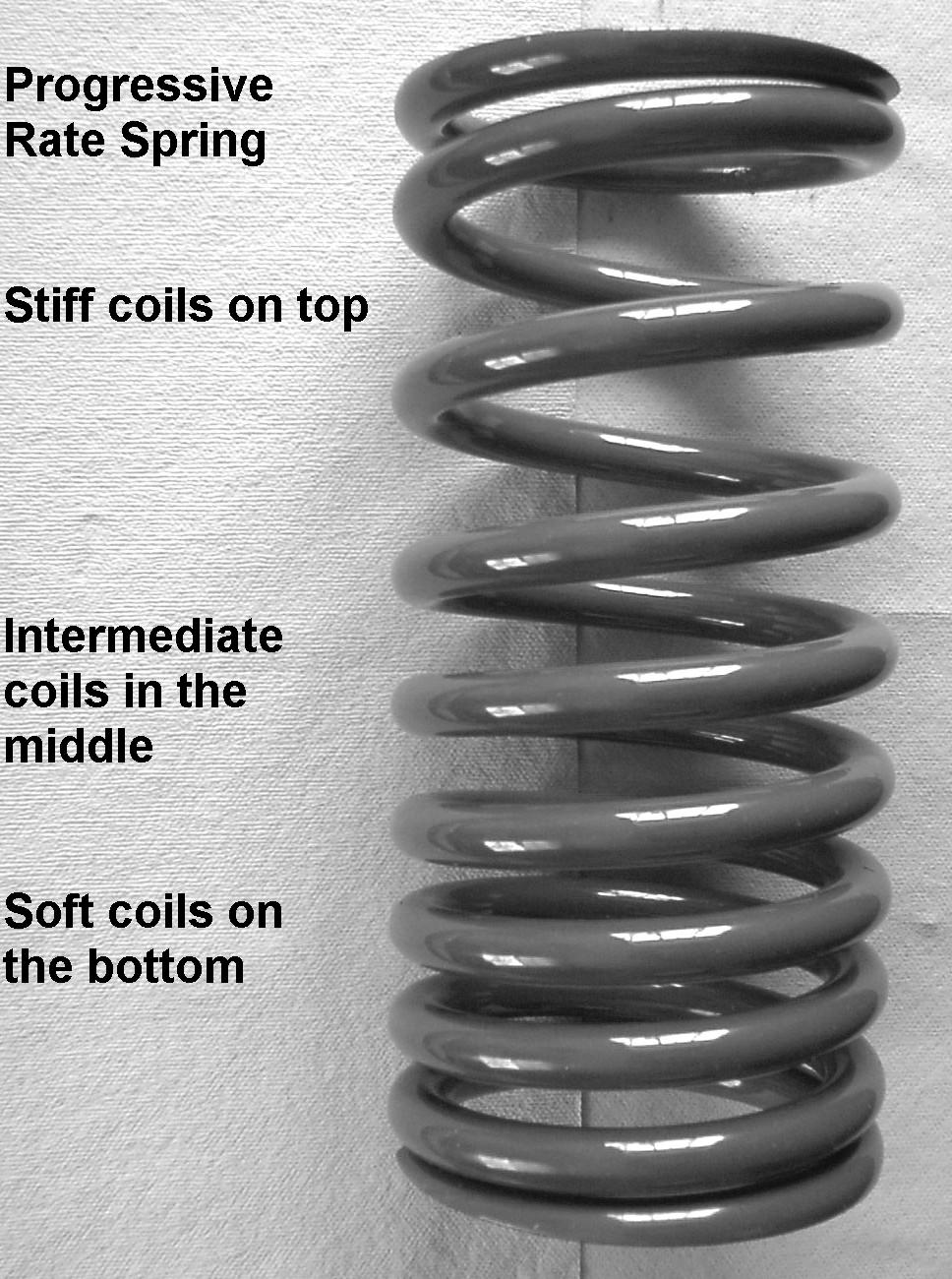
Feedback from the hundreds of customers who have tried our progressive springs has confirmed that they offer great handling with a better than stock ride. Most can't believe the improvement. But don't be fooled, all progressive rate springs are not the same. Due to the success of our springs several other suppliers have offered progressive rate springs in the last few years, with very mixed results. They are progressive in the strict sense, but the spring rates are not even close to ours. ( Ask them for specs on their spring rates. ) One set that we tried was so soft that the handling was worse than stock and the ride height was so low that the car constantly bottomed out on the bump stops. So yes, you can now purchase progressive rate springs for a few dollars less, but what is missing is the time spent in design, development and testing in order to "get it right". Our current springs are a 4th generation evolution of our initial design.
Our testing has shown that progressive rate springs are not necessary in the rear and can create other problems, so our 4-spring sets consist of progressive rate fronts matched with single rate rear springs.
We recommend installing our springs with the stock sway bar, and only going to a stiffer sway bar if additional roll control is needed. Sway bars add to the spring rate, and since their action is not progressive, stiff sway bars negate some of the advantages of progressive rate springs. Get it too stiff and the front wheels will loose road contact and tend to skip over small bumps and slide out in rough corners. Where additional cornering control is needed, we offer several choices in sway bar stiffness rather than the "one size fits all " approach of other suppliers. See the "sway bar section" below for details.
Although most "sport " spring sets will lower the ride height between 1 and 1-1/2 inches, we have developed several different progressive spring set combinations. These will accommodate different models, vehicle weights, and customer preferences as to ride heights and type of use. By the end of 2013 we will have added to our spring line progessive sets for the 1800/122 that are both lower ( 2.5 inches lower than stock ) and taller than our standard lowering sets. Combined with the use of spring spacers (shims), they will allow ride heights to be adjusted to a wider variety of individual tastes.
Our progressive rate spring sets have proved to be widely adaptable with uses ranging from street daily drivers, to weekend drives on back country roads, to autocross, trackday and even the Targa Newfoundland and Carrera Pan America Races. In 2009, Richard Bailey won the Historic A Class of the Carrera Panamericana using our progressive spring setup, exactly the same as we offer for street use, together with Bilstein shocks and our polyurethane suspension bushings.
For even more aggressive driving, whether on the street, in a Targa or Carrera race, or in autocross, we can now offer on a custom basis a line of stiffer progressives, specifically designed to be stiff enough to emphasize cornering control, while still having the minimum in soft coils necessary to be tolerable on the street and maintain road contact on corners that are not all racetrack smooth. These springs are for situations where improved cornering performance is more important than a soft ride.
Progressive rate springs are slightly more expensive than single rate springs, approx. $20 more per pair, but are well worth the difference. Most of ourr springs are blue powder coated. Full sets for the 140 and 164 are now available (pictured above). Call, write, or e-mail for details on the appropriate spring set for your application.
Single Rate Street Springs
Where our progressive rate spring sets will not meet a particular need we offer single rate springs that are stiffer and shorter than stock for the front and rear. Street performance sport springs are usually selected to lower the car from one to two inches. (How much the car can or should be lowered is dependent on the wheel and tire combination used, the ground clearance necessary, and the need for sufficient suspension travel.) They significantly reduce body roll and give a stiffer ride. Some spring combinations may require modified mounts. A selection of heights and rates may be available for your model. Contact us for additional details.
-
Single rate street springs per pair 122 and 1800 $150
-
Rear spring pairs for 140, 164, and 240 models $165
-
Rear spring pairs for 122 wagon - several spring rates available - $150
Competition and Race Springs
- Race Springs for Volvo 122 - 1800 & 140 front - $150 per pair for single rate springs
- New front progressive competition springs $160 per pair
- Call or email for prices on other race spring aplications
Offered in custom heights, rates for competition use normally start at 700 lb front, 180 lb rear and go up from there. Most road racers use 800-1000 lb front and 175-225 lb rear in the 1800. Call or email for heights and rates available.
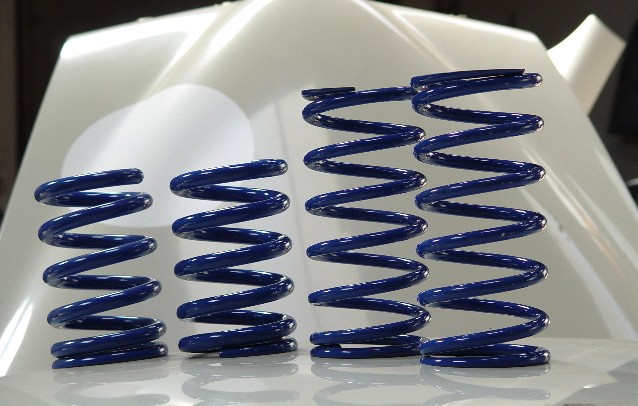
The above photo shows a set of typical Volvo 122/1800 vintage race springs.
The most important thing to note here is that the minimum front spring rate for track use is 3 times the stiffness of a stock front spring, while the rear rate is almost double stock. Race springs also produce a ride height that is usually at least an inch lower than the minimum needed for street use. This means that you really cannot use a competition track spring on the street, or a street spring on the track and expect to be competitive. Several competitors in the Targa Newoundland and Carrera Pan America have used our progressive rate street springs and found that they offer a good compromise where good handling is required but rough roads would rule out the use of a high rate single rate spring. We now offer progressive rate competition front springs.
Some rear springs require modified spring perches or spacers. Adjustable height spring perches are also available. E-mail your individual requirements and I will try to make a recommendation as to which springs would be best for your car.
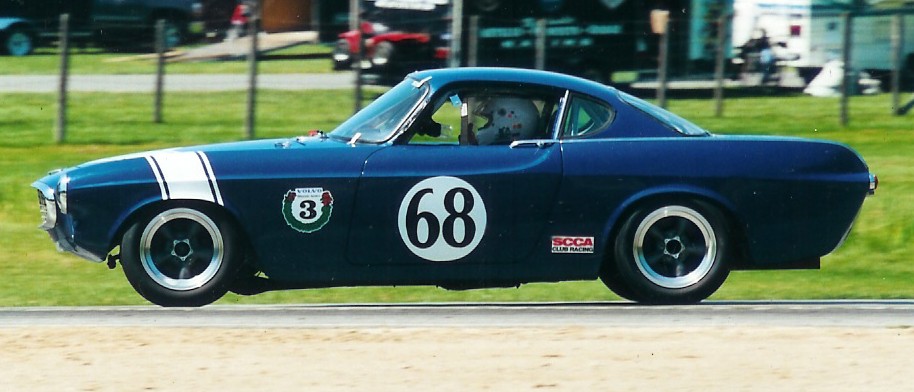
Typical race car ride hieght is shown above. The ground clearance is less than 4 inches.
Ride Height
How much will our springs lower your car? The answer depends on several factors.
All of our springs are tested with a load. This allows us to create matching pairs and determine which will be a little taller or shorter within a certain range. Determining the affect that new springs will have on your car's ride height is complicated by the fact that on a street car you will most likely be replacing 30 - 40 year old springs that have sagged or settled over the years, depending on the car's use, or lack of use. There were also some variations in spring rates based on model years, and some custom fitting and shimming when the cars were built. Some customers think they have original springs when they were actually replaced by a previous owner at some point. So when we say that our springs are designed to lower a car 1" to 1 1/2", that's an estimate based the original stock ride height and comparing our springs specifications to those of the original springs.
Most important is that the springs are designed to give your car a ride height that will improve its looks and handling while still providing sufficient ground clearance for normal use. For special circumstances we can provide various types of spring spacers in order to customize the ride height.
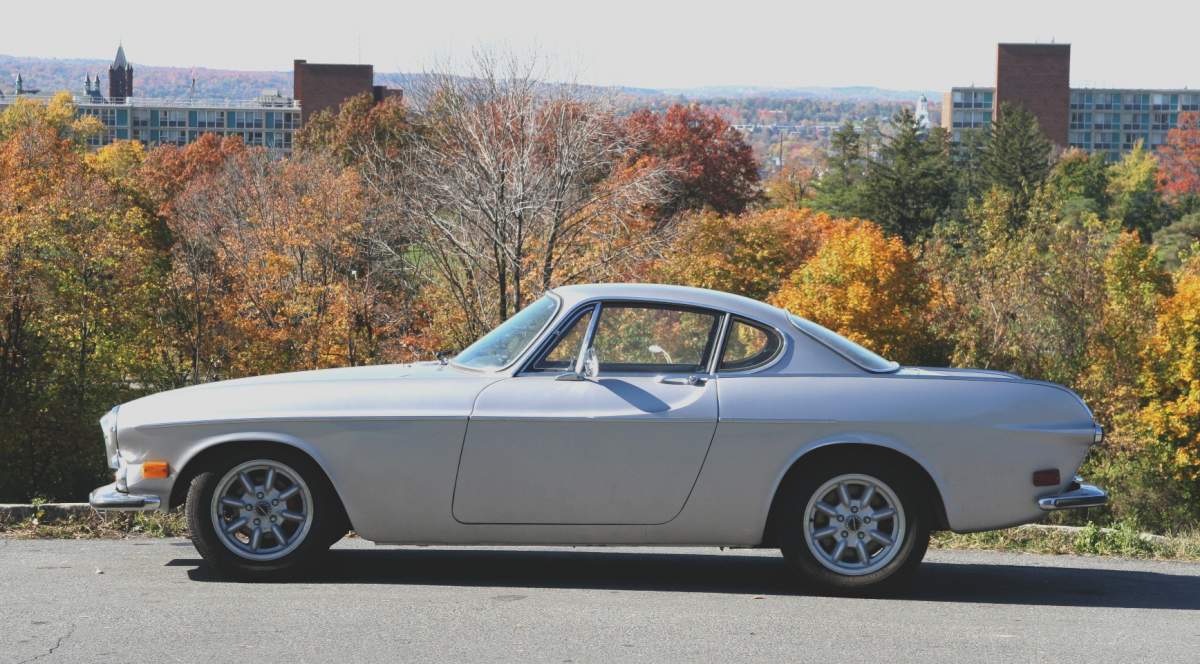
The photo above shows the ride height with a typical progressive sport spring installation. The ride height is lower in the front than in the rear with the car unloaded, but evens out when loaded. We also offer taller front springsthan on this 1800. Note that the ride height is over an inch taller than on the 1800 race car in the photo above this one.
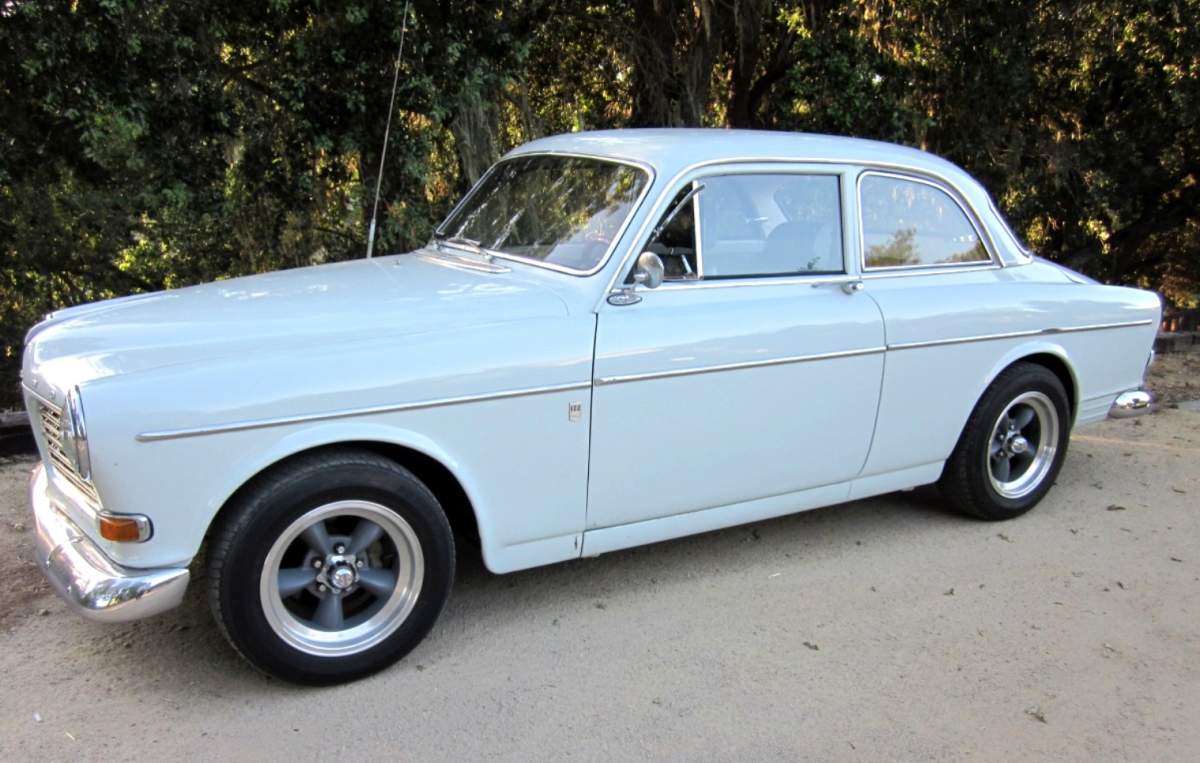 |
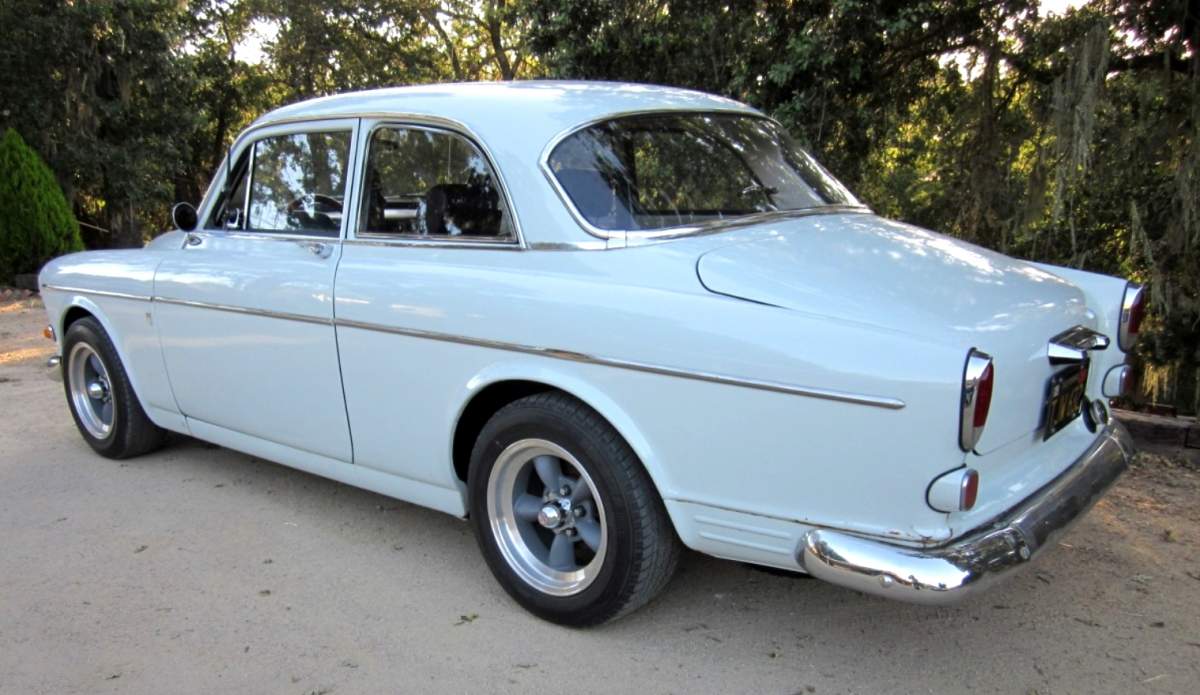 |
Greg Pederson's 122 has taller front progressive springs than the 1800 above, 15 x7 Torque Thrust wheels, and 205/60 tires.
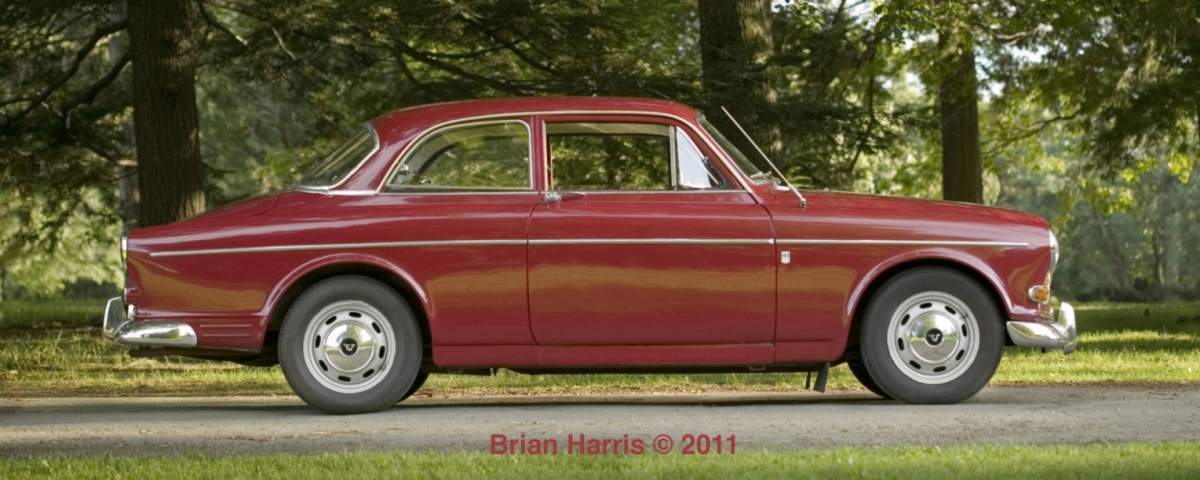 Brian Harris's car shows the ride height of our standard lowering springs with stock size wheels and tires. Brian Harris's car shows the ride height of our standard lowering springs with stock size wheels and tires. |
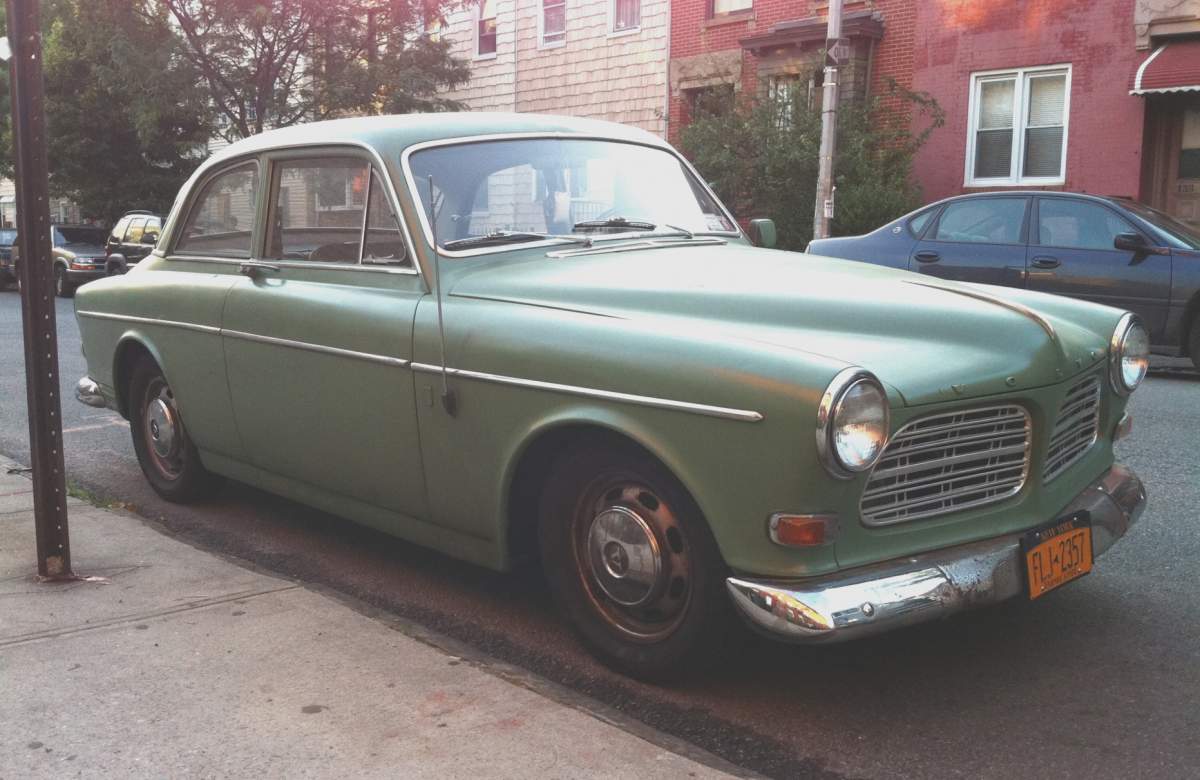 |
And for those who have questions about whether our lowering springs are appropriate for a car used on city streets, here's a 122 in the Bronx. The owner says:
I purchased your progressive springs and poly bushings last summer and the car has handled amazingly. I've put about 20k miles on it from long highway trips to the terrible NYC roads locally. I've attached a picture of how the amazon is sitting with the new suspension.
Thanks, Julio
|
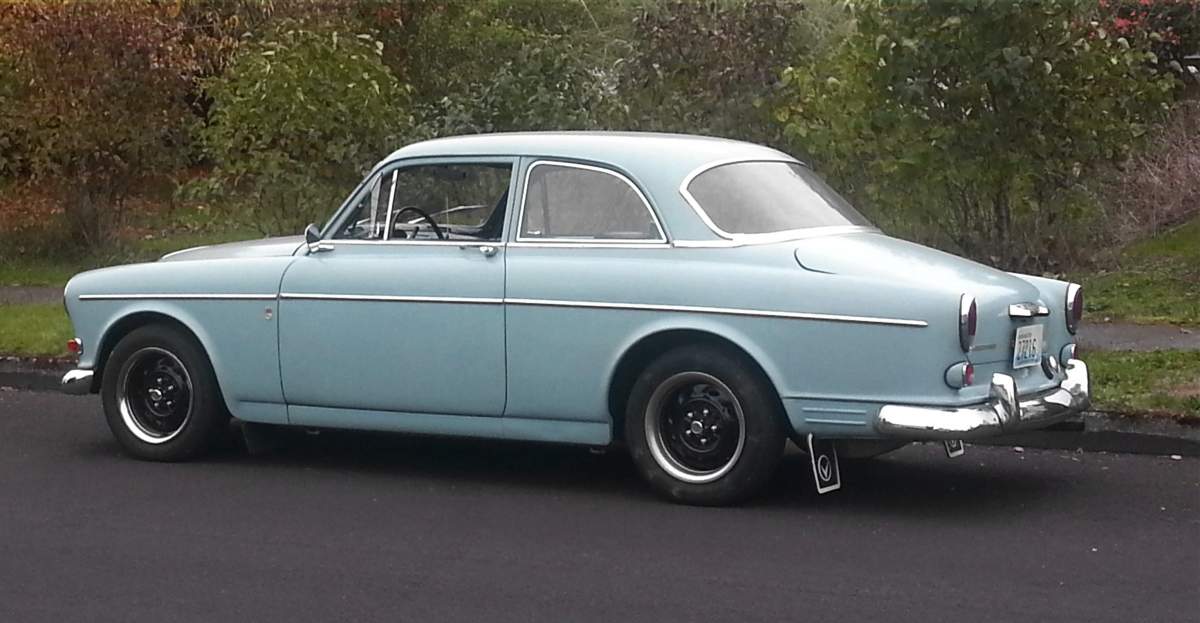 |
Matt Heckinger wanted to go lower than our standard lowering spring sets, so we provided a set with progressive fronts that gives a ride height approximately 2.5 inches lower than original stock height. His response was: " That's exactly what I was hoping for. Thanks! " We will have a small number of these spring sets by the end of 2013. Get your orders in now.
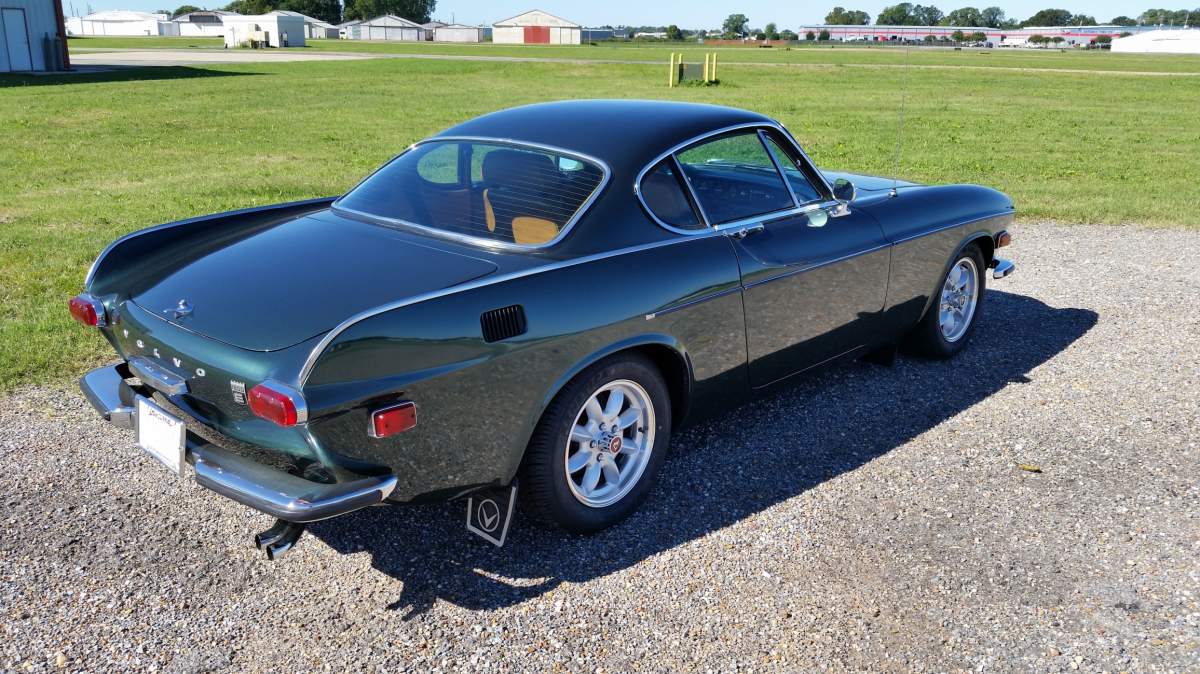 |
Hi John, here's a photo of my p1800 with your lowered springs and 195mm tires, wow what a better driving car! I got just a little over 1" lowering, looks perfect to me. I was concerned mostly about tire size and fender clearance but with 195mm tires there is no issue and the combination looks great. - Rick Volden
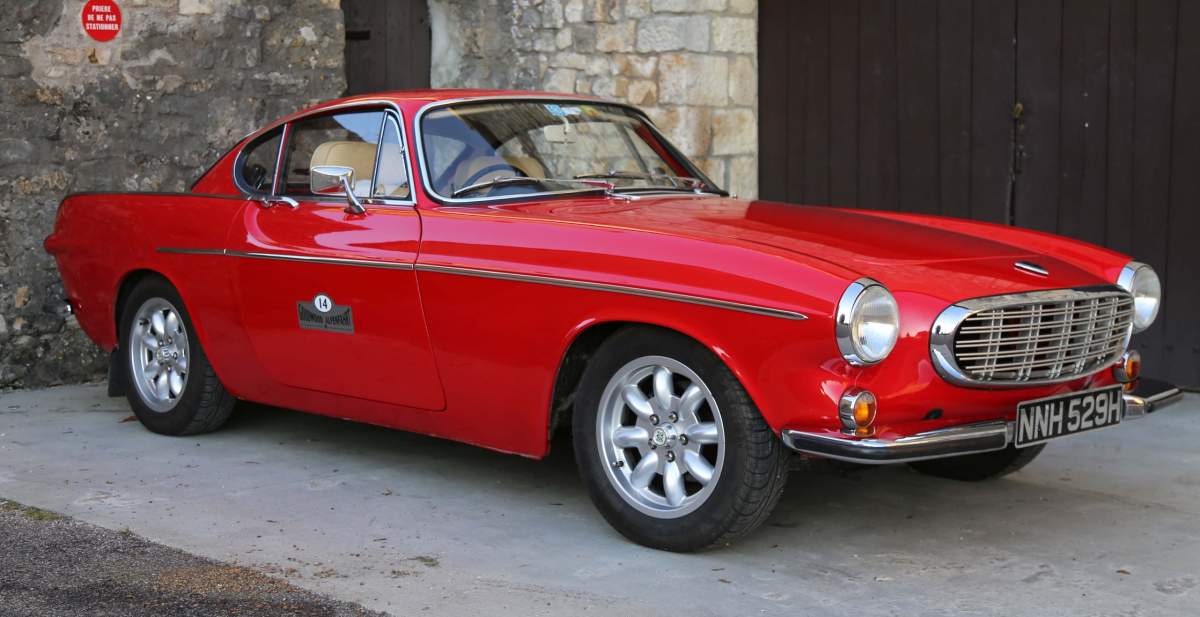
On 9/29/2015 10:36 AM, Rob Barker wrote - Just wanted to write and say thanks for my shocks and springs.
I’ve just completed a tour of Europe and driven 3000 miles in 10 days and the car was an absolute joy to drive. Your springs and shocks are truly amazing and my P1800’s handling is transformed, but yet the ride is still so comfortable and the unbelievable handing is not at the expense of a harsh ride.
Spring Spacers
We offer disc type steel or aluminum spacers ( shims ) for the front of the 1800, 122, and 140, and the rear of the 140, in stock 1/2 and 1/4 inch sizes. Using spacers allow small adjustments in ride height to be made to suit your individual preference or to provide clearance for different tire and wheel combinations. In the front the ride height change will be double the spacer thickness. In the rear the change is the same as the thickness of the spacer. Additional spacers are available in custom sizes.
- New - Aluminum spacers which center on the inside of the springs, front and rear - $22.50 each
- Disc type steel spring spacers/shims - per pair - $ 20
- Disc spacers available for 122, 1800, and 140 front and 140 rear
- Replacement rubber spring spacer cups- front $24.50 each
The Photo below shows one of our disc type spring spacers on the rear of a 142.
Adjustable Spring Height Adjusters
To meet advanced needs we have developed both front and rear spring height adjusters. Some simply slip in with the springs, others must be welded to the chassis. As there are a number of different types depending on the application, please e-mail for details.
Customer Comments on our Suspensions
John,One last thing, you are spot on when you say wait to buy a thicker anti sway bar. I just put Bilstein HD shocks up front and with the new sway bar bushings the stock bar is just fine. No more excessive lean.Your springs coupled with Bilstein HD's make a great suspension package.Edward.
They ride great. Here's an after picture.
Thanks.
Edward.On 4/21/2017 10:46 PM, Douglas Milton wrote:
I put the front progressive lowering springs in and all new bushings and ball joints . I left the heavy sway bar in . The car handles great !! Better than I thought it could. With the bilstiens front and re- valved rears Thanks John I realy enjoy driving that 69 Volvo 1800S.
"On 11/24/2015 4:38 AM, Warren wrote:
I'm very pleased with the new ride height - no longer bottoming out on the exhaust, and the ride and cornering is an amazing difference from the previous progressives that were fitted.
I have just completed my first long drive with the new setup - 900 Km from Melbourne to Sydney (560 miles) in a day, and the 1800 ran like a dream. The ride was secure and wonderfully comfortable.
Thanks again for the great springs, and for selecting a slightly taller set to suit.
Great work. Warren"
On 9/29/2015 10:36 AM, Rob Barker wrote:
Hi John,
Just wanted to write and say thanks for my shocks and springs.
I’ve just completed a tour of Europe and driven 3000 miles in 10 days and the car was an absolute joy to drive. Your springs and shocks are truly amazing and my P1800’s handling is transformed, but yet the ride is still so comfortable and the unbelievable handing is not at the expense of a harsh ride.
On my holiday I was with a group of friends, one of which had a new 911 Turbo and two others who had new Ferrari’s, a 456 Special and an FF. All three drivers couldn’t believe how my little P1800 handled.
Thanks for selling just a great product and for pulling all the stops out to get them to me quickly.
Kind regards,
Rob
( The above was from the UK after participating in the Alpenfahrt Rally )
Hi John, I've been wanting to tell you how pleased I am with your set of springs and how they have improved the looks and handling of my p1800e. In addition, custom wheels and wider tires seemed to put the whole car into better proportion; now I can't stay off the interstate cloverleaf, ha. Thanks, Rick V
1/24/13 8:42 PM
The springs you sold me work great. Much better ride. Rgds. Wilhelm ------------------------------------------------------------------------------------------------------
Sunday, August 19, 2012 11:45 PM
Hi John,
-----------------------------------------------------------------------------------------------------------------------------------------------------------------------------------
Wed 6/27 Re: '65 122s progressive rate springs
Thanks for checking up on me. They went in super easy. The directions that you sent were extremely helpful. So far I've got about an hour on them and I can definitely tell a huge difference (It doesn't feel like I'm riding on top of a bobble head any more). I'll give them a few more weeks to settle, but right now it looks like they are about a 1 1/4" lower than it was before. I can see why everywhere I checked said to go with your springs. I'm very happy with them and I know that I will check with you for all my future upgrades/repairs.
Saturday, June 25, 2011 10:44 PM
Subject: Installed my Volvo 122 progressive springs!
John,
The installation was straight forward. Yes, I remembered to remove the
upper cups. I had new upper rubber cushions that I installed.
The new springs sat the car level and about an inch lower. The
progressive springs on the front gives a more compliant ride, especially
with the 1" swaybar. I like them a lot! The lower A-arm is now level
with the ground. Very well engineered.
One suggestion for the front installation instructions... With original
rubber lower A-arm bushings, I loosened the inner bolt to allow the
A-arm to fall freely. Then, with the the new spring in place, I jacked
up the A-arm untill the car was just coming off the jack and tightened
the lower bolt.
http://www.youtube.com/watch?v=OVGZWQ5pBqI&feature=youtu.be
Thanks again,
Gregg
-------------------------------------------------------------------------------------------------------------------------------------------------------------------------------------
Wednesday, May 04, 2011 9:00 PM
The 122S handled the Snowball Rally with aplomb. I cannot say enough how pleased I am with the suspension set-up I received from you. Car definitely ran out of power well before it ran of “stick.” You may be getting calls from 1800, 1800ES and 142 drivers who commented on how well the 122 handled and “looked” doing it (very level, with little body roll whether in sweepers or tight corners – which the Sierra Nevada mountains have their share of both). Also there was a very rutted and rocky unpaved portion and the progressive springs worked very well and did not rattle out my fillings.
Thank you. Brad Sullivan
------------------------------------------------------------------------------------------------------------------------------------------------
Hi John, The springs are great! you're right about not needing bigger swaybars; it holds it's own around curves. I'm still trying plan for a supercharger/header combo... I'll just have to see over the next month or so. Mark Mark B. Johnson, Ph.D.
--------------------------------------------------------------------------------------------------------------------------------------------------------------------------------------
July 20, 2009
the progressive rate springs and poly bushings ROCK! I chased a 356
> all through the backroads of Norcal once i got them in... much to his
> surprise..!?! Morgan
-------------------------------------------------------------------------------------------------------------------------------------------------------------------------------------
From: sberry <growler@u...>
Date: Mon Nov 22, 2004 11:36 am
Subject: Re: [1800list] Re: go fast goodies was ipd engine stabilizer brace.
-VPD suspension makeover (progressive springs, bilsteins etc.). You can
make the car a very competitive handler for not much money. This recipe
is the best bang-for-your-buck in vintage volvoland IMHO. My 1800 now
handles better than any car I've ever owned.
----------------------------------------------------------------------------------------------------------------------------------------------------------------------------------------
The adjustments are made, the car rides and handles like a million bucks.
Thanks for everything. Your product and directions were fantastic.
Dick Sampson
Tucson, AZ
-------------------------------------------------------------------------------------------------------------------------------------------------------------------------------------------
To: 'John Parker'
Sent: Monday, December 07, 2009 12:28 PM
Subject: RE: springs
John
They were just perfect.
Happy Holidays
R/jonathan
------------------------------------------------------------------------------------------------------------------------------------------------------------------------------------------
I installed John Parker's progressive front springs, and the rear springs he
sells which are not progressive. I have Bilsteins, and stock sway bars, and
am very happy with the setup. Nice ride, and when pushed the progressive
fronts come into play. Highly recommended, but check John's site - I don't
think he recommends stiffer swaybars with his spring sets, and I don't know
how the stiffer swaybars would affect the setup.
Installing the springs was easy, takes an afternoon and some creaking for
the first 100 miles as they seat.
David Olson
Œ66 1800s
Œ63 p1800
-------------------------------------------------------------------------------------------------------------------------------------------------------------------------------------------
posted by RallyVolvo on Tue Jun 14 12:25 EST 2005
I highly recommend the springs you can get from Parker at V-performance. I've had them on my 71 142E for over a year now, and really like them. Plus they work great for my rallycross habit. :) I also have a 142 built for road racing that is VERY lowerd (as in the 3-4 inches you were talking about) and the front and rear tires are actually up inside the fender openings... And yeah, you would never want to drive that car on the street. Far too low, not to mention a very harsh ride. But it works good as a race car though!
---------------------------------------------------------------------------------------------------------------------------------------------------------------------------------------------posted by mike t on Tue Jan 30 02:29 UTC 2007
I am VERY happy with them! Actually we settled on the 175 lb/in. straight rates for the rear. they ride well, but are not a Cadillac ride. They are pretty sporty, but are very well behaved even on broken pvement. Combined with the progressive fronts It is a very nice balance. I can run it ( my 122 wagon ) much harder into corners than in my Skandix progressive equipped 122 coupe.
As you pointed out, the Skandix progressives don't have anywhere near enough spring rate. As soon as the road gets a bit rough, I am into the (already trimmed) front bump stops, which you will agree is a very dangerous business. Good "poser" springs... but not up to spirited driving, especially on "real" roads.
Shock Absorbers
We offer several different types of performance shock absorbers for street and racing use. Whatever brand of shock you choose, it is crucial that the shocks be compatible with the rest of your suspension. In general, a shock with stiffer valving is needed with stiffer springs.
Bilsteins
Bilsteins have been the shock of choice for vintage Volvos for many years and still deserve their excellent reputation. A sophisticated design allows them to provide outstanding handling performance and an exceptional ride. They seem to last forever. Not all shocks can be used on lowered cars, but this is no problem for Bilsteins. They are a good shock for use with a range of springs, and are the recommended shock for our progressive spring sets described above. They last virtually forever and will be last set of shocks you will ever need.
We have found and solved only one problem with the Bilsteins, and this is limited to their current shocks for the rear of the 1800 and 122 where the rebound valving and gas pressure rates are way too stiff - solved by having them revalved by Bilstein to our specs. Its more noticeable in the 1800 which is lighter in the rear than the 122, but still a real issue in either car. The result is a more expensive shock, but well worth the additional cost "to get it right" in a shock that you should have for a lifetime. ( I have over 250,000 miles on a set.) With the custom re-valved rears, there is no question that these are definitely the best shock choice.
We usually stock Bilsteins for 122s and 1800s, and can order them for 544s, 140s and 164s.
-
Stock Bilsteins for most street applications - $425 - $445 depending on application.
-
Bilsteins Custom Revalved to our Specifications for the 122/1800 - Highly Recommended - The rear shocks for these models currently come from Bilstein with valving ( especially the rebound valving ) and gas pressure that is much too stiff for a decent ride and also compromises the handling in all but the smoothest of corners, causing the rearend to skitter over bumps. This has been confirmed by shock dyno tests and comparative data from Bilstein. To solve this problem we went through a series of tests and worked with Bilstein's US Service Dept. to develop optimum valving. As a result, we now have the rear shocks rebuilt by Bilstein to our exclusive specifications. Expensive but worth the extra cost and the only way to “get it right” and have the best handling. They will easily last the life of your car and are the key to having both excellent handling and ride qualities. - $ 650 for a set of four shocks with re-valved rears. $ 430 per pair of re-valved rears.
Please order in advance if you want a set of these custom re-valved shocks. They are re-valved in small batches on a special order basis by Bilstein's US Service Dept. and are often not in stock.
Features of Bilstein HD monotube shocks:
The piston head design allows independent tuning of the compression and rebound damping forces to provide optimum ride comfort and performance without compromise. It features fewer parts than most conventional twin tube and so call "adjustable" shock designs. This simple, yet exceptional functional digressive design contributes to the extreme durability and long life of Bilstein Shock Absorbers.
![]()
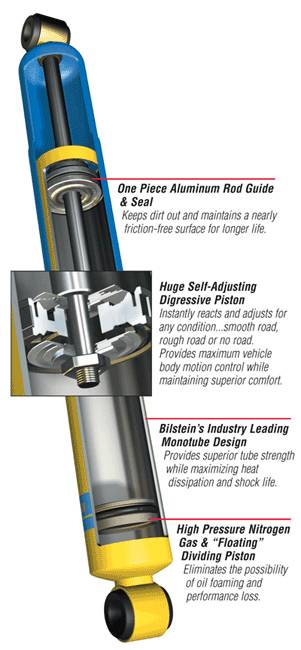 |
|
Konis
Back in the 60's and 70's Koni hydraulic shocks were the standard. Several years ago Koni reintroduced these adjutstable hydraulic shocks as their classic shock line. Not as technically advanced as the Bilstein ( hydrualic vs. monotube gas shock with digressive valving), the idea was to bring back the original classic Koni for vintage cars, not update it. They have an advantage over most other shocks in being adjustable to meet your individual needs or compensate for eventual wear. They are long lasting and are an item that you keep and transfer from car to car as I have done on a couple of my street 1800s. ( The Bilsteins are technically superior, but the Konis are a good second choice. )
-
Koni adjustable shocks - Due to recent price increases we no longer stock these shocks - email for availability info.
Race Shocks
-
Race shocks - New shocks are being developed - Email for details
Polyurethane Suspension Bushings
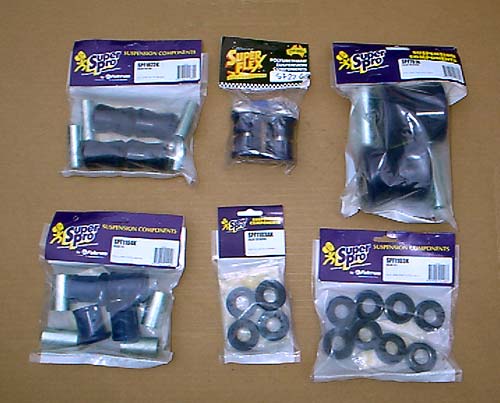 Our testing has shown that polyurethane bushings improve steering response, give a crisp feel to the handling, and reduce the feeling of wandering or floating encountered in high speed cornering with stock bushings. Polyurethane bushings are also not affected by the same causes of deterioration that affect rubber bushings. They are appropriate for both street and race applications.
Our testing has shown that polyurethane bushings improve steering response, give a crisp feel to the handling, and reduce the feeling of wandering or floating encountered in high speed cornering with stock bushings. Polyurethane bushings are also not affected by the same causes of deterioration that affect rubber bushings. They are appropriate for both street and race applications.
Full sets are available for most Volvo models and are usually in stock for 1800s, 122s, 140s and 164s. Email for information on the availability for other models.
Pictured on the right is a set of bushings for 68 - 73 1800s and 122s.
-
Complete sets for all 1800s, 122s & 140s - All bushings in our sets are poly!
-
Note - Other supplier’s sets are not all polyurethane, are not the same grade of polyurethane & do not include panhard & sway bar bushings
-
early 1800 ( thru '63 ) and early 122 - $ 255 ( same front upper and lower - incl. panhard bar - add $35 for sway bar bushings ) See the diagrams below to confirm which type you have.
-
mid 1800 and 122 - $ 265 ( later type front lower bushhings - early type rear suspension - includes PB add $35 for Sway Bar bushings )
-
122 wagon - later style front lower bushings, all rear in poly, but does not include the square rear trailing arm bush and one end of the panhard bar which are not available in Poly - $195 ( Add $35 for sway bar bushings )
-
67 1800 and 122 - $ 295 square rear bushings ( includes panhard bushings - add $35 for sway bar bushings )
-
68-73 1800 and 122 - complete set $ 295 ( includes panhard bar - add $35 for sway bar bushings ). If ordered separately: Front sway bar bushings - $35. Front upper and lower A arm bushings $97.50. Rear bushings including panhard - $ 205.
-
67-69 140 $ 365 ( includes panhard bar - add $35 for sway bar bushings)
-
70-74 140 $ 465 ( includes panhard bar - add $35 for sway bar bushings )
-
Complete and partial sets available for other models, including the 544, 200, 700, 900 - email for a detailed bushing price and availability information.
See the diagrams and photos below to determine which types of 122/1800 you should order.
.gif) |
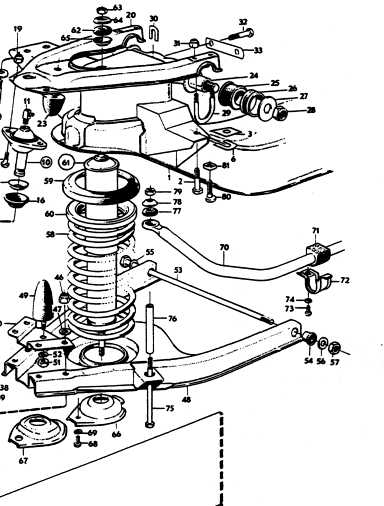 |
In the diagrams below the early type 122/1800 rear suspension is on the left, the later type is on the right. The lower photos illustrate the difference in the later type bushing shape - square type 67 bushings on the left - 68 and later "butterfly" shape bushings on the right.
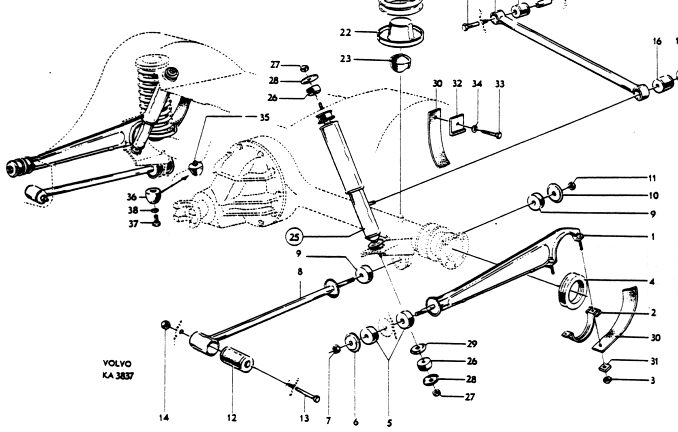 |
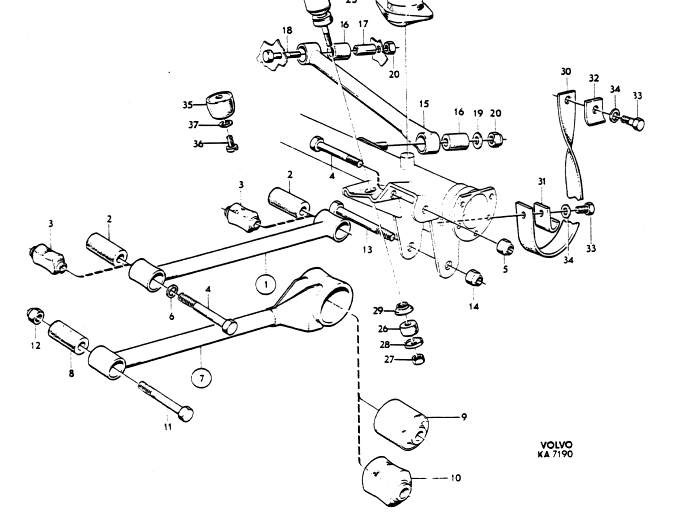 |
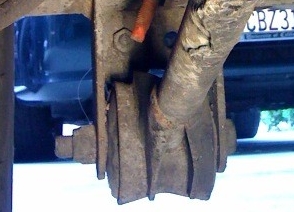 |
SwayBars
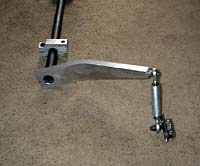 We offer sway bar kits, including IPD front and rear bars, as well as our own adjustable bars in several versions. Different diameters are available in the adjustable bars to be sure that one will be right for your use. Some bars are tubular for light weight and some come with separate bolt-on arms. Adjustable bars are highly recommended for competition use where being able to tune the suspension is necessary. For the discriminating street driver the ability to tune the suspension with sway bar adjustments can be just as important.
We offer sway bar kits, including IPD front and rear bars, as well as our own adjustable bars in several versions. Different diameters are available in the adjustable bars to be sure that one will be right for your use. Some bars are tubular for light weight and some come with separate bolt-on arms. Adjustable bars are highly recommended for competition use where being able to tune the suspension is necessary. For the discriminating street driver the ability to tune the suspension with sway bar adjustments can be just as important.
-
Front / Rear IPD Kit $350 - $375 depending on model
-
Front 1" bar, recommended for the 122/1800 for more aggressive cornering - $165
-
Custom made adjustable tubular bar kits with aluminum arms for race or street. For road race, autocross, or track day use adjustable bars are needed for suspension tuning. Call or email for details and prices.
Engines
Engine Building
Our current Volvo B18/B20 engine designs are the result of over 30 years of dyno, track and road testing.
Unfortunately, we have had to increase prices for 2022 due to increased costs and these increases - mostly about 10% - are not yetreflected in the prices listed below
If you would like to order an engine, fall is usually the best time, but we are still taking orders this spring for summer or fall delivery dependin on the type of engine ordered. And can only hope that supply chain problems will not hold us up waiting for parts as has happened off and on over the last two years. So let us know ASAP if you would a street or racing engine for this year - before we have too many orders and too little time left.
Shown below are some of our chassis dyno - rolling road - test sessions.
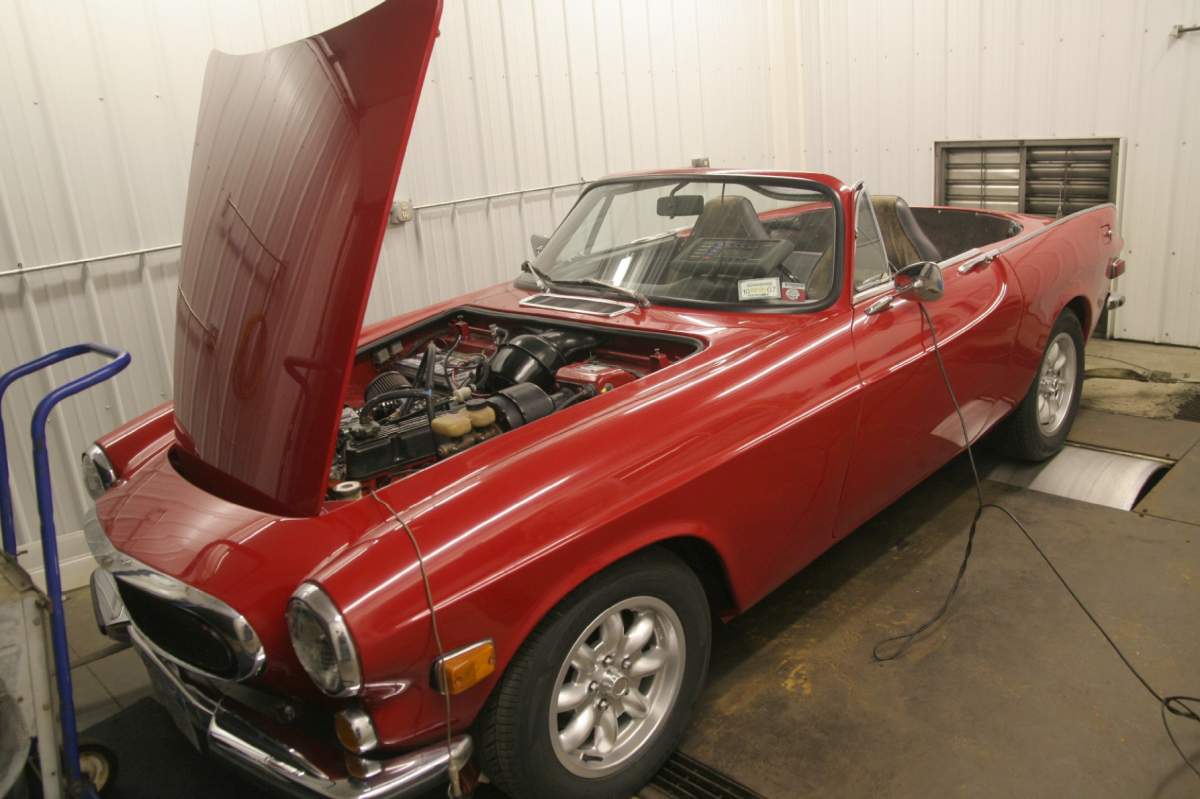 |
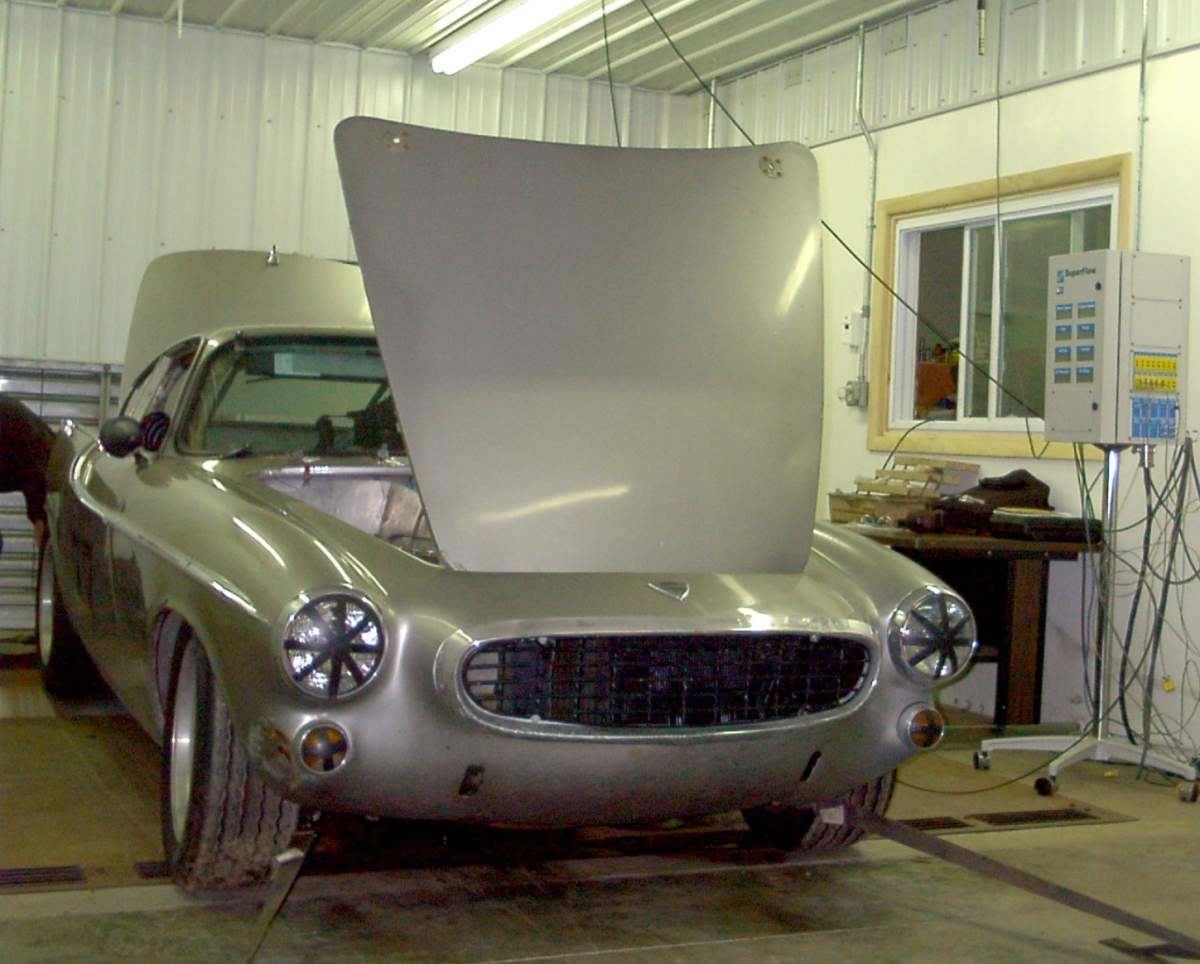 |
.jpg) |
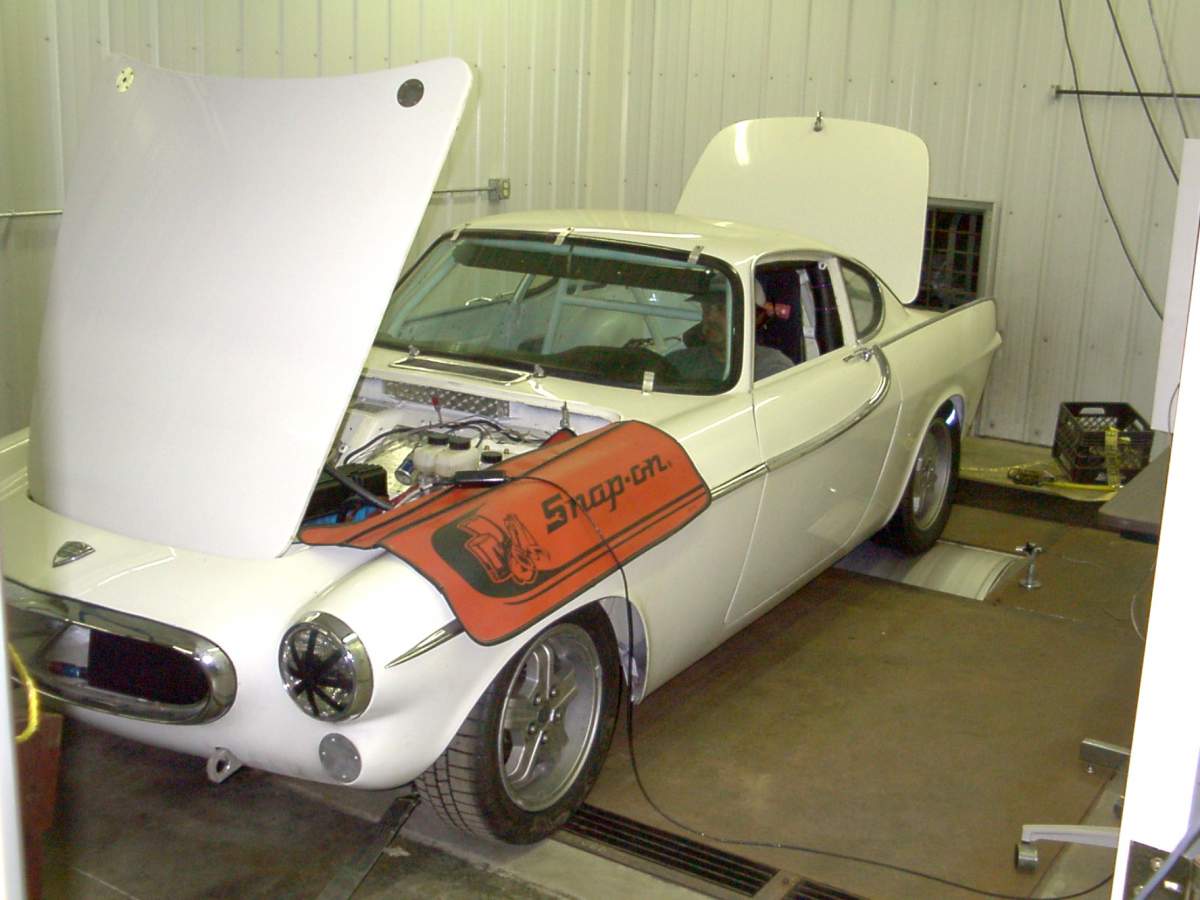 |
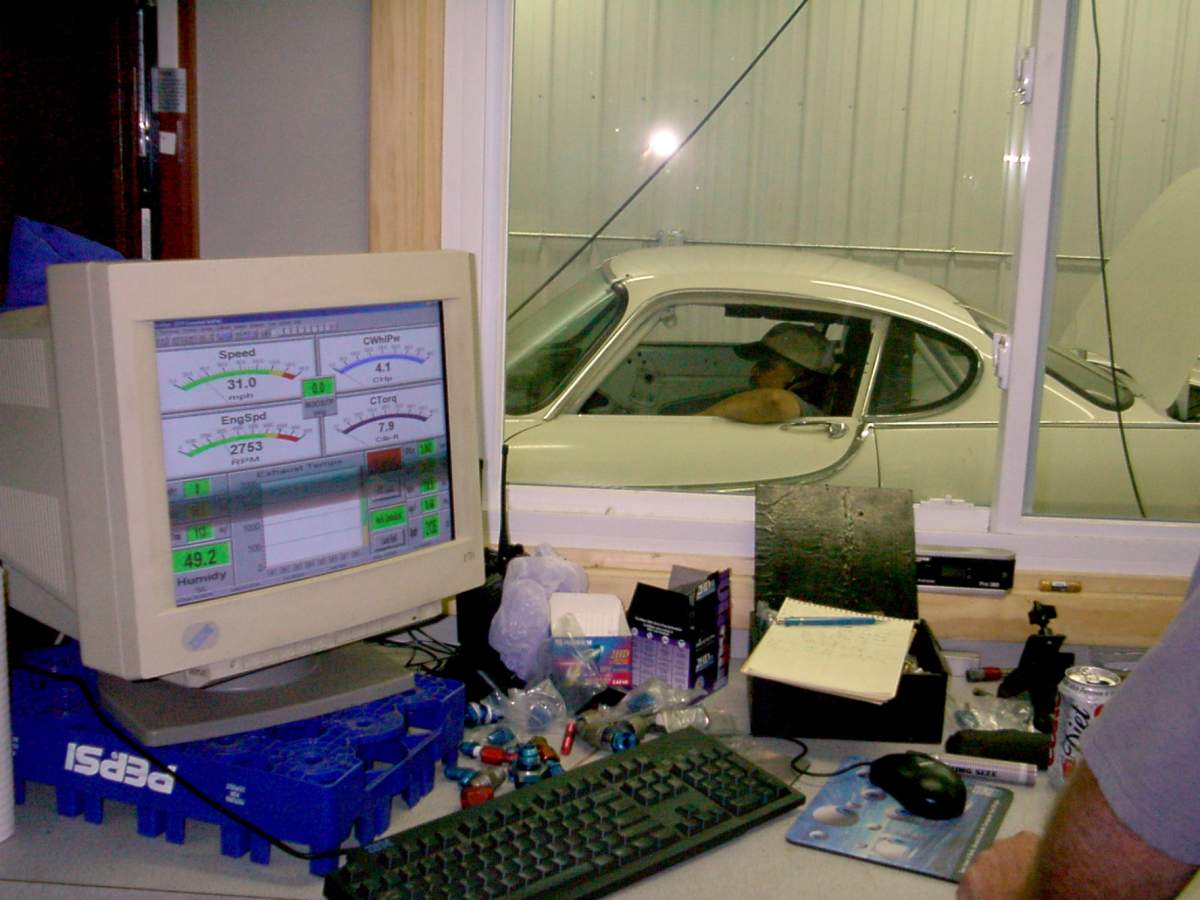 |
In the last 10 years one of the biggest changes here at VPD has been the increased power available from our normally aspirated engines. When we started 140 - 150 HP was typical for a modified Volvo B20 street engine and the only way to get close to 200 HP was in a high compression, high rpm race engine. Then our supercharger kit made it possible to have over 150 HP on an otherwised stock engine and well over 200 HP on the street with a modified B20. This allowed us to offer a street car package for an 1800, 122, 544 or 140 that would give them performance similar to our vintage racecars.
Now, after years of development, we have normally aspirated, large displacement B20 street engines with similar HP and torque as compared to the race and supercharged engines we started with. This gives you the option of having a street engine that looks stock with 170 - 200 HP, more than we used to get supercharging stock engines. On race engines, the larger displacement will produce well over 200 HP, though, as I continually emphasize, a broad power band is more important in any application than peak HP.
As in the past, we continue to provide an engine building service to meet your street, rally and race needs based on over 25 years of experience in these areas. We can rebuild your engine to your custom specifications or supply one based on one of the engine packages outlined below. Engines are available from stock rebuilds to full-out , 8,000 RPM race engines. Check the price list for most recent prices and options. E-mail for additional details. Engines can usually be shipped throughout the US for less than $300 and for less than $600 - $800 to many other countries. Recent engine orders have been from Australia, Germany, Greece, Norway and the UK.
Individual parts can be supplied to assist you in building your own engine, but we are not a parts house and prefer to supply complete systems for best results. We believe in a matched systems approach where the selection of each part in the system depends on the others, and a good match is the key to satisfying performance. This approach is reflected in all of our engines, component kits and our Street Performance Tuning Kit - systems of components designed and matched in such a way that the individual results far exceed what could be achieved throug a seemingly similar combination of individual parts selected by a car owner without the benefit of extensive systematic testing.
Be sure to read " How our engines are different " at the end of the engine section.
Quick Recommendation:
For normal street driving in a Volvo 1800, 122, 544, or 140, our Streeet Performance Engine will meet most needs. For those who want something more, the 2.3 L is the most popular option. It incorporates a significant increase in displacement with a race quality bottom end, tuned as a street engine for torque and a broad power band. See details on all of our engines below.
Volvo B18 - B20 Street Engines
The main design criteria for our Street Performance Engines is to increase power without any sacrifice in the areas of driveability, reliability and fuel economy. The goal is to supply engines that meet the requirements of both those who drive their Volvos on a daily basis and just for fun on the weekends. Engines that will meet the requirements of a daily trip to work, but which also have enough power for modern performance on the highway, fun on a twisty country road, or a weekend autocross or track day. Our SP engines are not "racy" engines, unless you want them to be. Power bands are similar to stock engines in terms of where the power is in the RPM range. There is just a lot more of it. Good low and midrange power and torque, with immediate throttle response, are our primary goals in a street engine, not high RPM power. For street driving a broad power band and good throttle response are much more important than peak power. In any type of normal use, including on a road course, an engine with a higher HP average over a 3,000 - 4,000 rpm range will beat one with a higher peak HP number but lower average every time.
Power increases of as much as 40 - 80% with normally aspirated B20 engines of various displacements with no loss of low end power and torque are a result of good design. Customers are always suprised that we can do this while at the same time improving fuel economy. With proper tuning and exhaust modifications, at least 150 HP at the crank, 120 HP at the wheels, can be expected from our typical 2 liter street performance engines. See the dyno test section of this website for dyno charts covering some of our engines. ( click on "More Info" at the top of any page and then "Technical Ariticles" to find it .) With our stroked, large displacement B20 engines power in the 180 to 210 HP range can be expected. Some engines are now available as component kits for assembly at your location, though we recommend extreme care in selecting local shops as many are simply not up to our standard of care and precision.
Unique Components
While others are still building Volvo engines using the same stock components that have been used for over 40 years, many of our engines are completely redesigned internally. The cranks are either replaced or custom ground to our specifications with modified rod bearing sizes. Longer, lighter, stronger rods with smaller, lighter pins are used. We use custom made forged pistons in many or our engines, lighter and stronger than the stock pistons. Lighter components reduce rotating mass and reduce engine vibrations, resulting in quicker acceleration, smoother operation and more power. Stock B20 engines are oversquare with an 89 mm bore and 80 mm stroke. Many of our redesigned engines use a longer stroke and a closer to square bore to stroke ratio, which helps to produce more low end torque and broader power bands. Add these changes to our ported heads and custom cams and you basically have an engine of completely new design.
Engine prices will be adjusted as our parts costs increase. The most recent adjustments may not be posted below.
The Stock Rebuild
A completely rebuilt street engine, built to basically stock specifications with some upgrades, C or D cam, starting at $4000* ( $3250 for the bottom end - $750 for a rebuilt head with hardened ext.seats and other enhancements ) The addition of upgrades such as balancing and block decking are recommended. The stock rebuild is our least popular engine ( I can't recall doing one ) as most customers who are going to go through the effort of a complete rebuild choose one of the enhanced rebuild levels represented by the engines described below.
The Street Performance Engine
Balanced, with our Type II performance ported head, our Street Performance cam, stock type cast pistons ( .030 - or .040 over ) and reconditioned rods. This is our standard B20 2 liter performance engine, designed to replace stock engines in all applications where more power, reliability and efficiency are desired. It retains the long term reliability and broad power band you are used to, but with approx. 50% more power. As compared to the stock rebuild, this engine adds a Street Performance Head and Cam, align bored mains, ARP rod bolts and head studs as well as block decking to assure the proper deck height and optimal piston to head squish area distance. With proper exhaust and intake, expect power in the 150 - 160 HP range.
- With the Type II head - $4950*
- With the Type I head - $4700*
The Severe Duty Street Performance Engines
An upgrade from the Street Performance Engine described above, this is our recommended high performance engine designed to take the higher stresses of supercharged, turbocharged, track day, or high RPM applications - with forged pistons specific to each application, ARP rod bolts and head studs, align bored, decked, balanced, custom ground Street Performance, Supercharger or Targa cam. Available in an enhanced version with custom sized Crower rods that makes it into a true high performance engine, perfect for rally use. In addition to providing a stronger rod capable of higher sustained rpm use, using a custom rod gives us the advantage of being able to set our own rod and piston dimensions. Utilizing this option the Crower rod based assembly has longer rods, shorter ligther pistons, smaller rod journal and pin sizes for a ligther rotating assembly. The result is a more efficient, race strength engine designed for street use. Bore sizes of .030, .040 and .060 over are available.
- With Stock Rods and Type II performance head, - $5275*
- With Stock Rods and Type III head - $5675*
- Add $1125 to either of the above prices for the Crower Rod based, race quality, rotating assembly and crank machining.
2130 cc Severe Duty Street Performance Engine
Basically the same as the Severe Duty engine above but with 92 mm bore for a larger displacement and more power. Blocks used in this, and all of our 92 mm bore engines are selected for their thicker walls to assure sufficient strength after the overbore. Available in an enhanced version with custom sized Crower rods that makes it into a true high performance engine, perfect for rally use. In addition to providing a stronger rod capable of higher sustained rpm use, using a custom rod gives us the advantage of being able to set our own rod and piston dimensions. Utilizing this option the Crower rod based assembly has longer rods, shorter ligther pistons, smaller rod journal and pin sizes for a ligther rotating assembly. The result is a more efficient, race strength engine designed for street use.
- With Stock Rods and Type II head - $5495*.
- With Stock Rods and Type III head - $5850*
- Add $1125 to either of the above prices for the Crower Rod based, race quality, rotating assembly and crank machining.
The 2.3 Liter Stroked Engine
92 mm bore x 86 mm stroke. My personal favorite as an engine that can do it all. Similar to the 2.5 in concept, but using an offset ground stock crank with forged pistons and rods. This engine fills the gap between our 2 liter and 2.5 liter engines both in terms of price and performance with a very significant in increase in power and torque over the 2 L based on the increase in displacement and stroke. The amount of increase will depend on the compression ratio, induction system, cam and head choices which are available for this engine. The longer stroke adds considerable low end torque. One of our best all around engines, with a race quality bottom end, and is one of the best values for your performance dollar. Perfect for a daily driver or for street/track applications including rally, targa and Carrera Panamerica events. Can be used with the stock clutch and M40/41 transmission or with our T5 and T9 5 speed conversions. The engine can be matched to your application with different cam and head choices. As the race version is very similar except for the cam, head, compression ratio and designed rpm range, it can be easity converted into a race or rally engine.
- With Type II head - $6950 *
- With Type III head - $7350 *
See a few customer comments on this engine below:
"The engine works beautifully. Pulls strongly from low rpm. Clearly better than standard engine right from idle speed, very good from 1500-2000 rpm and all the way up 6000 rpm. So far the engine clearly is up to my expectations and I am very satisfied. My 122S is now a perfect street car, especially with the new engine combined with the electric powersteering I installed in connection with the engine swap." - Andreas - Norway.
"Happy Christmas, a happy new year and all that! I have such exciting news that I haven't yet shared.
I took the car back to Brands Hatch. Quite a shocking transformation ........I know the engine you have made for me is absolutely wonderful and still has much more to give. Amazing, well done." - Ben - UK
And what a kid in a Subaru WRX said to our New Mexico customer Mark Seredowych after a run in with his stock looking 122 - " Is that thing naturally aspirated?"
The 2.5 Liter Monster B20 Street Engine - based on a custom made billet stroker crank - this engine has been discontinued as a regular production product - one offs are still possible.
92mm bore x 92mm stroke. This is the answer for those who want great power with a stock look and without the complications of supercharging. All the best components - sonic tested blocks, steel billet custom made stroker cranks, H beam forged rods, forged pistons, type III head. Expensive, but well worth it for the performance. Street versions produce from 190 - 210 HP with side draft carbs ( Weber DCOE or Mikuni HSR), our Quad Mikuni Kit, or programable FI, with the exact HP and power curve depending on several choices including cam and compression ratio. Capable of 300 + HP in supercharged configuration. The torque of these engines makes transmission upgrades advisable and clutch upgrades necessary. Orders are usually placed 6 months in advance to allow time for the custom crank to be produced. - $7950 - $8400 depending on rod choice
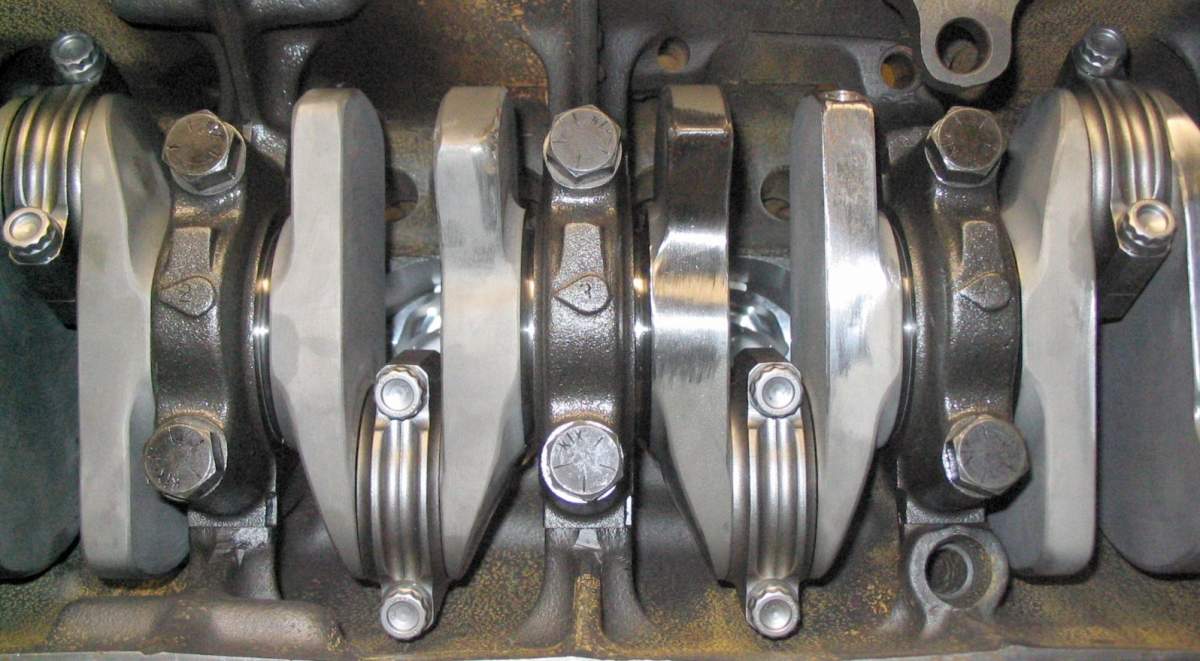
The heart of the 2.5 - the custom made stroker crank
All of our engines, unless otherwise specified, come with new water and oil pumps, late style neoprene front and rear seals, new pistons, rings and bearings. In engines using stock cranks and rods, these parts are magnafluxed and reconditioned. All blocks are sonic tested to ensure sufficient cylinder wall thickness. All engines are bored and honed with a deck plate. All performance engines are decked to assure the proper deck to piston height and piston to head clearance.
The engine prices listed above do not include intake or exhaust manifolds, carbs, fuel injection systems, superchargers, flywheels, clutches or distributors. These items can be added to any engine order at additional cost. Rocker assemblies are checked and reconditioned. Rocker assemblies modified for proper ratios are highly recommended and are available at additional cost. (See the rocker arm section for details ) Aluminum crank pulleys are highly recommended for any performance engine. Engines are pre-oiled then drained prior to shipping. Valve lash is set cold. Engine prices, unless otherwise specified, are for engines of stock displacement with overbores of .050" or less.. Add $125 to any engine price to add a baffled oil pan.
Be sure to read the details at the end of the " Engine " section on how our engines are different from those made by anyone else.
* Engine prices are based on a core exchange. Where an equivalent, useable core engine with head is not provided a core charge of $ 450 is normally added. For large bore engines up to 92 mm the core charge is $550. For cores which will accept boring to 93 or 94 mm the core charge is $650 when available. ( All of our blocks are sonic checked for cylinder wall thickness so we know how hard it is to find blocks that will reliably take various overbores. ) The above core prices are for orders placed on or after October 1, 2012.
* Engine prices normally do not include aluminum valve covers, aluminum crank pulleys, roller rockers, or modified stock rockers. See the appropriate engine parts sections for prices. These parts will be provided at additional cost on request.
* Engine prices are based on our most up to date information on parts costs at the time prices are posted. If our cost for parts not in stock increases significantly, even after the order date, these increases may have to be passed on to the customer.
Engine payments are normally based on the following schedule - One third of the total, + the core charge if a suitable engine core is not being provided, at the time of order as a deposit. One third of the total when the major parts are in stock and major machinig of the block has been completed. One third of the total, plus any shipping preparation and shipping or delivery charges when the engine has been finished and is ready for shipping.
Our Engines can be shipped anywhere in the US and the world. Recent international shipments have been to the UK, Norway, Germany, and Poland. Typical terminal to terminal truck shipping in the US is less that $300. Air shipping for airport pickup at major european airports is usually in the $500 - $600 range. Recent air shipment quotes - for pickup at Sydney Airport, Australia - $850. Door delivery to Manchester, UK, $750.
Please review the break-in procedures and oil recommendations in the articles on Oil and Break-in Procedures in our Tech Articles section.
Stroker Kits
Stroker component kits for assembly at your location.
-
The 2.5 liter engine components are available as a special order kit consisting of stroker crank, forged H - beam rods, rod bearings, and forged pistons - $3995.
-
The 2.3 liter component kit - forged pistons, Crower rods, rod bearings, offset ground crank - $2450.
-
The 2.3 liter component kit as above, but supplied without the offset ground crank - $1825.
- Add $160 for precision balancing the crank, rods and pistons.
- Add $85 for main bearings.
- Add $100 crank core charge on the 2.3 Kit if we supply the crank core.
-
The above components are special order, custom made items and may take from 3 - 6 months for delivery if not in stock at time of order. Unless specified, balancing of individual components is not included but can be added.
Race Engines
Our standard Volvo B18/20 vintage race engines produce from 200 to 220 HP at 2 liters ( depending on exact specifications ) , with a broad power band - normally run on the track between 4,500 and 8,000 RPM. The design is one that we have developed based on 25 years of vintage racing and dyno testing experience, and is basically an evolution of the engine that I have used in my own vintage racecar since 1992. It features our race head with dual valve springs plus damper and a custom designed race cam. Since it is designed for vintage racing, reliability and flexibility are key objectives in its design, but it is a race engine designed for track use only. Though we can do custom versions with modified characteristics, our standard vintage race engine is a high compression engine ( 13 - 1 or higher CR ) designed to be used with high octane leaded race fuel only. Customers have been using and winning with these engines in vintage racing and in SCCA's Historic Series for many years. ( After 15 years my 1800 still holds an SCCA Historic Series track record at Watkins Glen.) We have also built similar engines for other types of racing and rallying which are now in use in the US and several other countries, including the UK, Germany, and Australia and can build engines to FIA specs upon request.
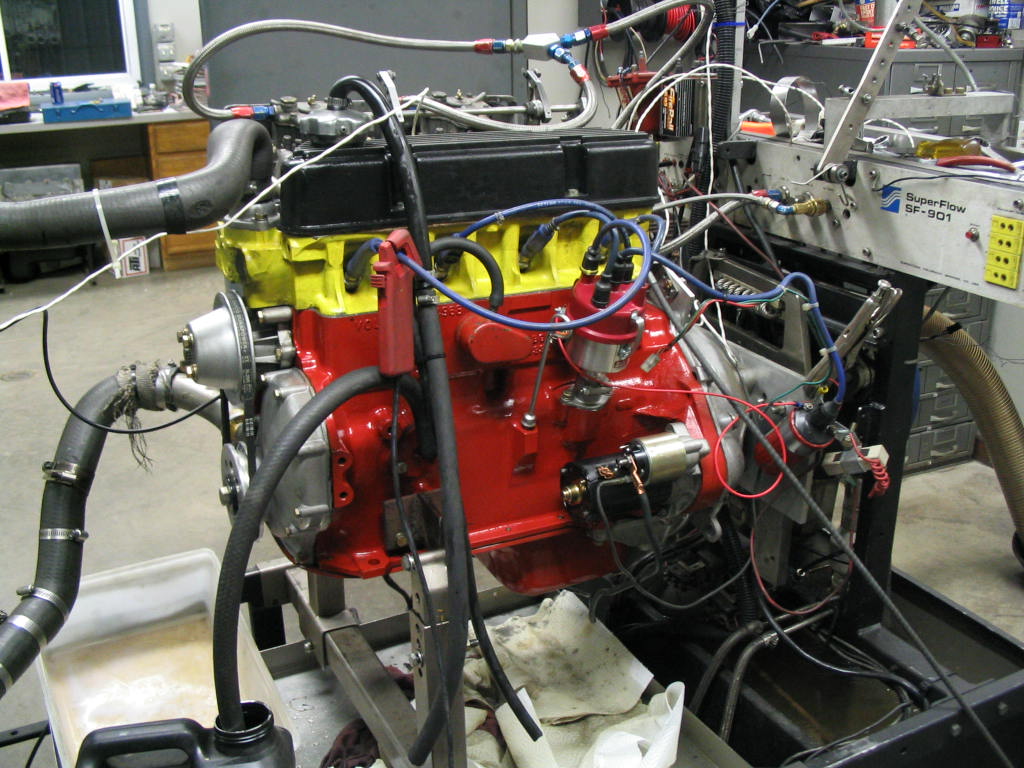 |
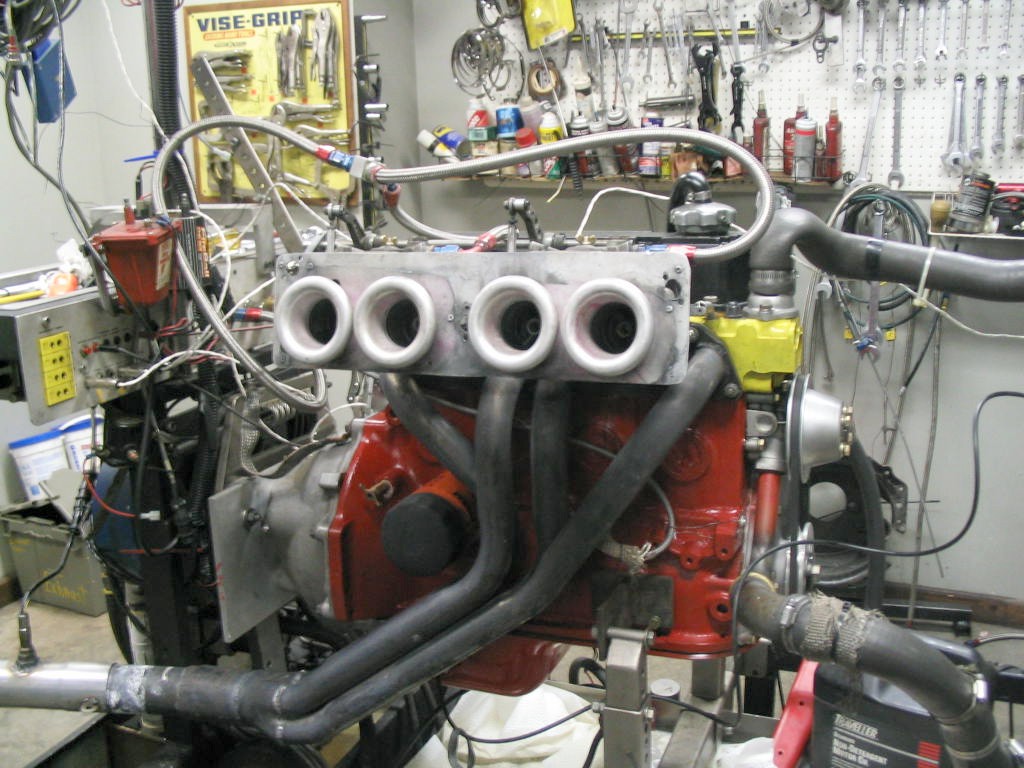 |
One of our race engines during dyno testing.
Due to customer demand we are now producing larger displacement race engines, in various bores and strokes, including a top of the line, 2.5 liter, bored and stroked maximum performance race engine. With these stroked engines power in the 230 - 250 HP range is possible , but the greater benefit is a broader power band and more torque. All of our race engines use components custom made to our specifications. Piston sizes, pin heights, pin size, rod lengths, and rod journal diameters are changed to maximize performance. Choices in specifications, parts brand, or parts price increases may affect the prices listed below. All race engine prices include a baffled oil pan. Dyno test results available on request.
-
B20, 2 liter vintage race engines with ported race head, custom race cam, forged pistons, Carillo or Crower rods, balanced and blueprinted, approx. $6895*, depending on exact configuration and parts included.
-
B20, 2130 cc race engine, stock stroke x 92 mm bore, $6995*, depending on exact configuration and parts included.
-
B20, 2.3 liter race engine, 92 mm bore x 86 mm stroke with offset ground crank - $ 7395*, depending on exact configuration and parts included.
-
2.5 liter B20 monster engine, 92mm bore - 92mm stroke with billet steel stroker crank, all the best components, the most powerful B20 Volvo race engine you can buy. Designed for higher rpm than the street version listed above, this pure race version uses lighter, longer rods, lighter pistons, and has a head and cam designed to facilitate high rpm - high compression use. - $ 8400 - $8800 + depending on rod and head choices.
-
ITB short block - blueprinted cam, align bored, balanced, rods resized and reconditioned with ARP rod bolts, custom deck height, bored and honed with a deck plate, with baffled oil pan - $ 3295 *
* Race engine prices are subject to change based on increases in our parts costs.
*The race engines above ( excluding the ITB short block ) come with aluminum crank pulleys, and now include modified stock rocker arms, and new aluminum valve covers needed to clear the large race valve springs. Prices have increased in order to include these additions.
*Additional core charges or exchange requirements may apply to all engine rebuilds. The typical B20 core charge for engine and head is $ 400. For large bore engines .060 over and up to 92 mm the core charge is $500. For cores which will accept boring to 93 or 94 mm the core charge is $650 when available. ( All of our blocks are sonic checked for cylinder wall thickness so we know how hard it is to find blocks that will reliably take various overbores. ) . For engines to be shipped there may be additional packing and handling charges for preparing the engine for shipping - usually $150 for shipping on a pallet.
Street Performance Tuning Kit
.jpg) |
In 1966 Volvo offered a tuning kit for B18 engines designed to increase HP by close to 50% based on the same engine components they used to win the 1965 World Rally Championship. Now we have a tuning kit similar in general concept, but using components of modern design engineered for street rather than race performance |
Our Street Performance Engine Tuning Kit will increase power in a properly built B20 by 50% to the 150 - 170 HP ( at the crank ) range while remaining perfectly tractable for normal street driving. In part throttle operation it feels like a stock engine, only smoother. Larger displacement engines will benefit from additional increases in power based on the percentage of displacement increase. For those building their own engines, or seeking to add performance modifications to an engine that is still in basically good shape, this is the perfect package. The components are the same as those used in the engines we build in our shop but in a bolt on package that will take most of the guess work out of performance upgrades for the do-it-yourself enthusiast. The kit consists of our Type II Street Performance head, head gasket, custom ground SP cam, ARP head stud set, aluminum timing gear, performance lifters and pushrods, and ceramic coated exhaust header. Recommended for use with suitably tuned Mikuni, SU or Weber carbs, or programable fuel injection ( SDS, Megasquirt, etc.) replacing the stock D Jet control unit. SP kits for supercharged engines have a different cam and lower compression head. Free flowing exhaust required for appropriate results.
Kit Components:
Type II Street Performance Head
Street Performance Cam
ARP Head Stud Set
Head Gasket - (Specify engine bore - Add $60 if for 92 mm bore)
Aluminum Timing Gear
Performance Lifters and Pushrods
Ceramic Coated Exhaust Header
Street Performance Tuning Kit with above stated components - $2500. ( price changing due to increases in the cost of parts includeded - email for new price )
Street Performance Tuning Kit with Type III head - $2950 ( price changing - due to the cost of parts included - email for new price )
If not supplying a suitable head core add $150.
Add pistons, reconditioned rods, main and rod bearings, water and oil pumps, bottom end gasket set, and modified front and rear crank seal housings for a complete engine kit.
Add an aluminum or lighened stock flywheel, new OEM type clutch pressure plate, performance clutch disc, and performance exhaust with mandrel bent tubing and high capacity mufflers, and finish it off with Mikuni Carbs and a 123 Distributor to complete the system.
How Our Engines Are Different
Our engines are designed and built based on over 20 years of experience. building and modifying these engines. During that time we have been doing dyno, street and track testing to validate the results. This process has produced design changes that are unique to our engines and has dispelled a lot of old theories on how these engines should be built. On many engines crank throws, rod lengths, component weights and bearing sizes are different from stock and these improvements have evolved over the last 20 years.
You can have engines rebuilt for less money, but you can't have engines built for less that are built wth the same care, attention to detail and experience that we use in building them. We spend more time cleaning and preparing our blocks both before and after machining than a lot of shops spend doing an entire rebuild. Although some components and specifications may differ, the same basic steps and care go into building our street engines as go into our race engines. When you spend less on an engine its cheaper because less time was spent on it due to the steps that were left out - including design and testing time. If our engines are more expensive its because of the extra time, additional care, and a long list of additional steps that go into building them. Its also why our engines produce more power on the dyno and on the road, are more economical, and are more reliable.
12 engine rebuild procedures that you don't usually see in engine rebuilds done by others:
1) all blocks go through a several step cleaning process both before and after machining
2) all block soft plugs and oil gallery plugs are removed and replaced
3) blocks are sonic tested for sufficient wall thickness;
4) the cylinders are honed with a deck plate; do not trust a shop to do machine work that does not use one - see this video to learn how important this is - http://www.youtube.com/watch?v=6cLjdr2GSwU
5) the mains are align honed ,
6) blocks are decked for proper deck to piston height and piston to cylinder head clearance;
7) stock rods are magnafuxed, checked for straightness, resized, bead blasted, reconditioned, and usually supplied with high performance rod bolts, new pin end bushings, and balanced;
8) cranks are checked for proper indexing and straightness, magnafluxed to check for cracks, the journals are polished and/or ground, and finally the crank is balanced;
9) oil pans are completely cleaned and repainted;
10) Engines are pre-oiled and then drained prior to shipping.
11) Rocker arms and shafts are checked and reconditioned.
12) Valve lash is set cold, then reset hot after the head bolts are re-torqued on engines we install.
The list could go on..
Some design differences:
1) 20 years of building and racing these engines has allowed us to do a lot destructive testing, some of it unintentional, but every failure has had its benefits as they have given us an opportunity to learn what works, what needs to be changed and what does not. In the begining we went through a couple of engines a season, but my last race engine lasted 12 years until I pushed it too hard in a 4 hour enduro running against modern racecars.
2) "If it ain't broke don't fix it." " KISS - Keep it simple, stupid." Two of the most important design philosophies that we follow. Especially important when dealing with old engines where it is really easy change too much based on what is now available.
3) With similar cars on both the street and the track, we have been able to go through an evolution of trying design elements on the track and then adapting them to street applications. Take our current line of street heads for example. They are a direct evolution of a small port race head design that I introduced in 1998 on my racecar. It did not result in the most peak horsepower, but had a broader power band and better throttle response, elements that made it easier to drive hard - good enough to win the Volvo Grand Prix that year against Volvos from all over the US and Canada, and set a track record at Watkins Glen for the SCCA Historic Series that still stands. With recent modifications for a significant increase in power, that head is still in use.
4) We have not felt restrained to do " it " a certain way just because Volvo did it that way. It would just not make sense to ignore the advantages of modern materials and techniques in building our engines. If Volvo had known of better ways to build engines 40 years ago, they might have done it. On the other hand, when they did eventually make changes, to the OHC engines for example, the main criteria was an increase in manufacturing efficiency and decrease in cost rather than improved performance. With modern materials we can implement improvements that were not originally available. We can use smaller bearings which have less resistance, longer rods and lighter pistons for more power and efficiency.
5) With years of design changes behind us, some of our engines have about as much VPD design in them as they do Volvo - our bore, our stroke, our rod length, our bearing sizes, our piston pin diameter and height, our lifters, our pushrods, our cam designs, our head port shapes, our valves, our crank pulleys, our flywheels, our clutches, etc.
6) In the "articles" section of this website there are 2 articles on the original effort to put a small Ford V8 into an 1800 and convince Volvo to produce it. Our current 2.5 liter B20 now produces more power than that V8.
Some test differences:
I have a strong belief in the importance of scientific testing, and a background that allows me to know how it should be conducted. We test everything we make. When doing head porting, even though I have ported well over 100 Volvo heads, I still flow test each head during and after porting. Even though it " looks right " I frequently have to go back and touch up a port to make sure it is right.
When replacing or modifying an engine in a customer's car, whether its a race car or street car, we go to the extra trouble of dynoing it before we make any changes. This gives us a baseline and allows us to document exactly what was accomplished.
At this point we have records that go back for more than 20 years - flow tests, dyno tests, track times - that allow us to make comparisons when we make changes. A lot of these tests were done on the same machines and tracks that we run on now so that we can still make direct comparisons. There are even certain lightly traveled public roads, with convenient markers, where we have been doing testing for many years. Any opportunity to test is used, rather than just going by the seat of our pants.
We have also learned the hard way, that just getting a better test number on a machine does not mean that you will get the same performance on the road. One of my head experiments that produced really nice flow numbers was a real bust in terms of the power that it produced in the real world. So engine testing progresses from the bench, to the dyno ( and sometimes both engine and chassis dynos ) and then to the road and/or track.
Engine Shipping
We regularly ship engines all over the US and Europe, and can ship to most places in the world. Our shipping schedule for the first few months of 2011 has engines going to the UK, Norway, Germany, Poland and Greece.
Shipping in North America is normally by truck, takes 2 - 3 days to the Midwest and 4 - 5 days to the West Coast. Cost is normally in the $ 200 - $300 range for terminal to terminal shipping or to a business address with loading dock or fork lift. Additional fees normally apply to home delivery.
Shipping by air to Europe is surprisingly reasonable - $400 - $500 for 3 day air shipping for pickup at major airports.
Our Volvo B20 engines are normally shipped on a shipping pallet with an all up weight of 300 lbs. A charge of $150 is added for shipping preparation and delivery to a shipping terminal.
Heads & Porting
Head Porting - Flow testing
One of the last items most people think about in an engine upgrade is really the most important - the cylinder head. Companies focus on selling camshafts, carburetors, exhaust systems, etc.- easy stuff to sell and all designed to improve air and fuel flow into and out of the engine. But in the air flow equation, the limiting factor is still the smallest or most restrictive part. No matter what is bolted on to it, if that most restrictive part is in the cylinder head, than that is what is going to limit the total amount of air that can flow into and out of the engine and the amount of power that engine can make.
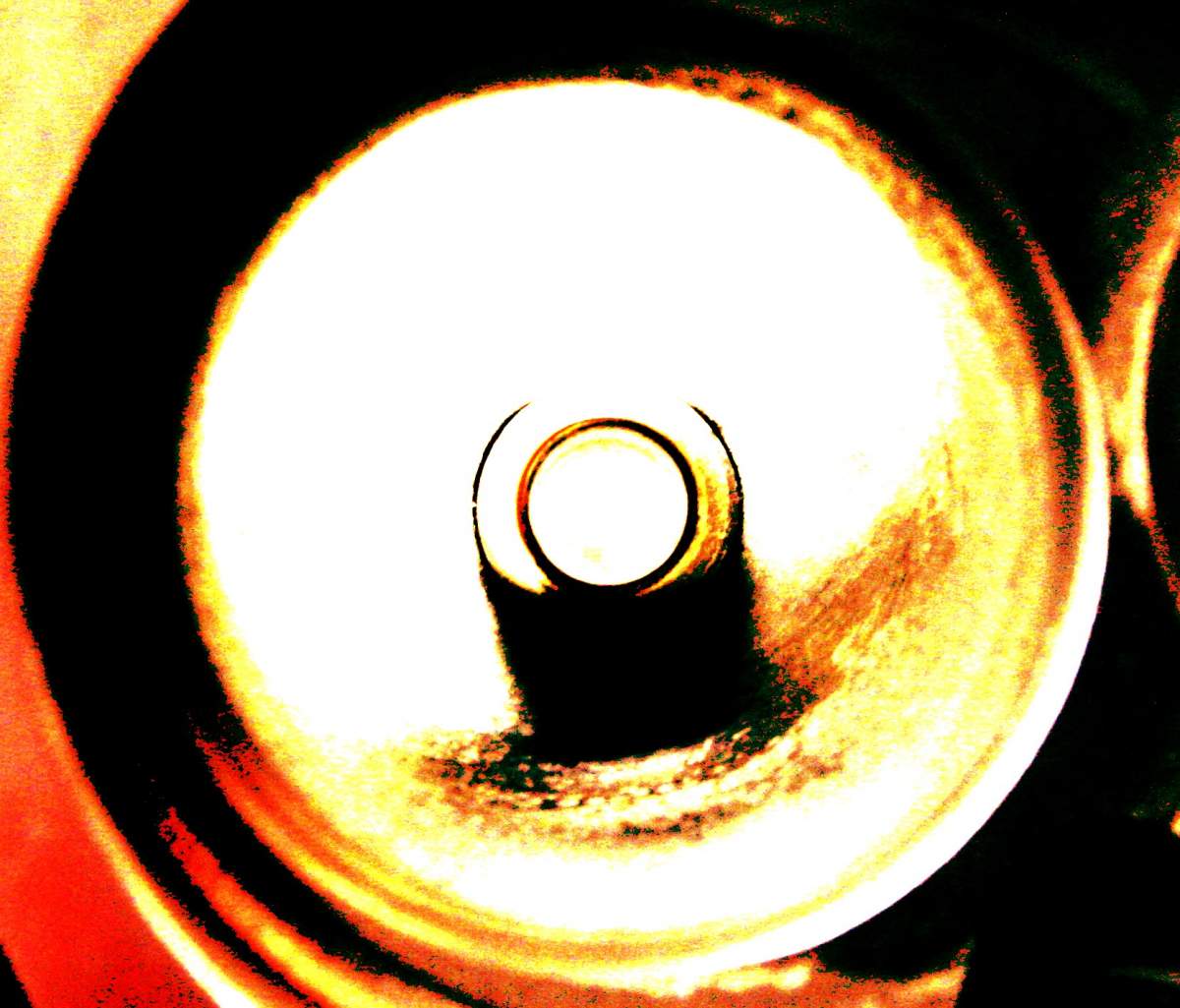 |
Once we accept the concept that you have to improve the capacity of the intake and exhaust ports to flow more air and fuel in order to make significant increases in power, then head modifications have to be considered the key to enhancing engine performance and a prerequisite for all further modifications. Efforts to increase power without following this principle usually do not end well. Fortunately, the areas of greatest potential for increased power and efficiency in most vintage cars are also in the head.
Modifications to the ports, as well as the combustion chambers, valves and valve seats, address the most serious performance restriction in the Volvo B18/B20 engines - head flow limitations based on the stock port designs. Without improvements in head flow, changing cams and increasing displacement will not produce satisfactory results. Our engines produce very significant improvements in power and torque ( as much as double the stock outputs ) , not only in terms of peak numbers but throughout the normal operating range, because of radical improvements in flow produced by modifications to the ports, valves and combustion chamber shape. These modifications make it unnecessary to resort to long duration cams, needed to make up for poor port flow, and which typically produce increases in top end power while losing it at the low end.
When our heads are matched with our cams and exhaust systems, the result is a well tested combination of power, driveability and fuel economy - improved performance without any drawbacks.

On a custom basis, various degrees of head work are offered from street performance to full race applications. Extensive work on the flow bench, followed by dyno, street and race testing, allows us to be sure of the results that will be obtained. These are not educated guesses based on what works on other engines or what someone else did, but are well-tested configurations on our engines. The port design and degree of port enlargement is tailored to the specific application. We do not put heads with large race type ports on street engines. Even our race heads are normally designed to produce maximum rates of acceleration rather than maximum peak power numbers.
All of our head work is backed up by flow bench testing, both before, during and at the end of the porting process. Over 20 years of experience porting, testing, racing and building Volvo engines for all types of uses with these heads gives us the experience to "do it right". The more heads we do, the more we learn. Our heads are constantly improving - recent comparison tests have confirmed that today's street heads are better in many aspects than the race heads we did several years ago - and those heads were still winning races last year.
.jpg) |
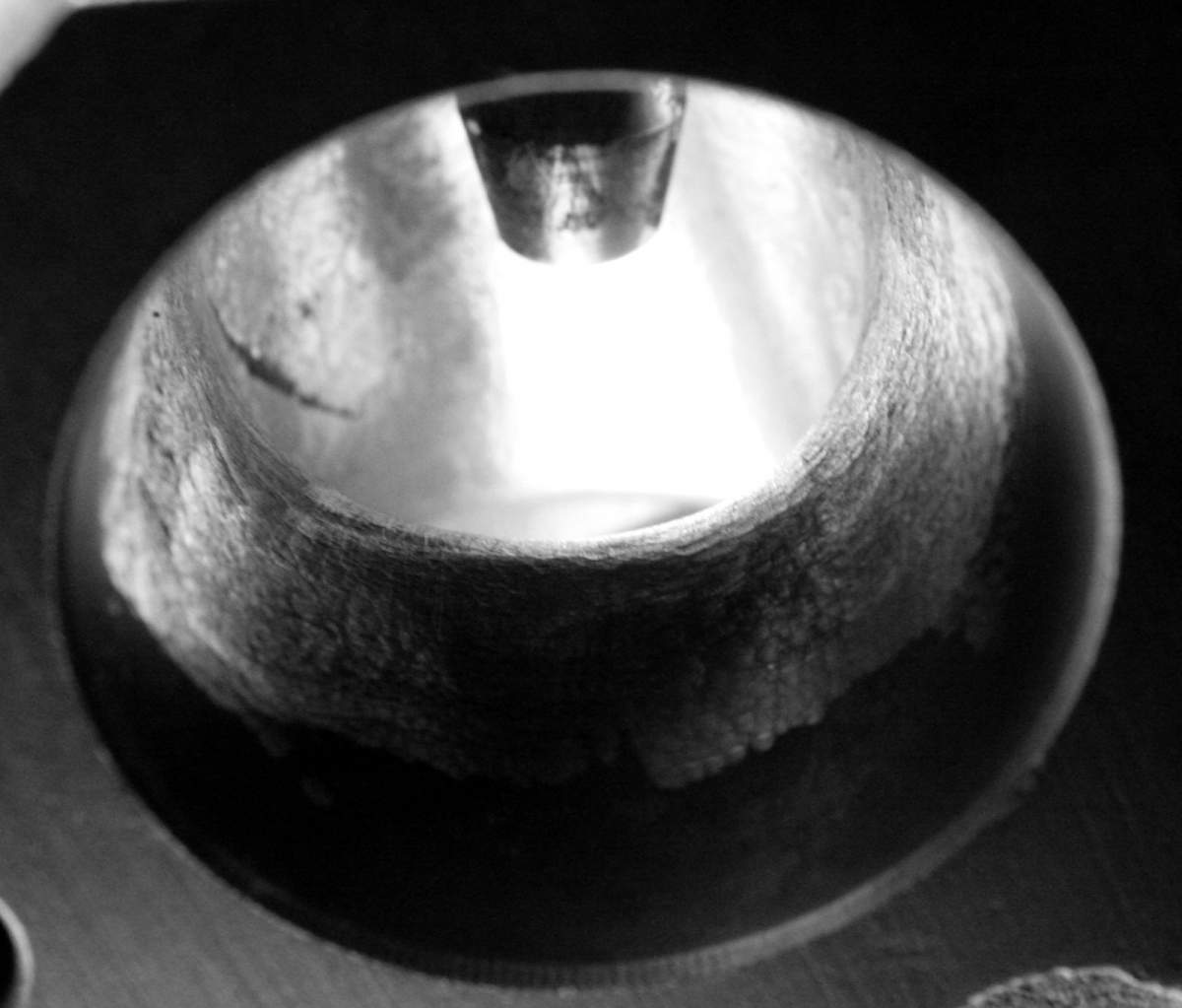 |
Only a comparatively small portion of the time that it takes to produce one of our performance heads is spent doing actual head porting, though that time is crucial to a successful result. The rest of it, after the head is cleaned, checked and prepped, goes into installing hardened exhaust seats; enlarging the valve spring pockets to accommodate larger springs;milling the combustion chambers to unshroud the valves; cutting the angles on the valves; cutting seats in the head; removing and installing valve guides; reaming the guides to the proper size for each valve stem; removing the soft plugs, removing checking and reinstalling the brass coolant tube that runs the length of the head; reinstalling the soft plugs; vacuum checking the ports to make sure that there is a good valve to seat seal; flow testing the ports to make sure that they flow up to spec for the specific head type; measuring the size of the combustion chambers; calculating the size of the combustion chamber that will give the desired compression ratio for the particular engine the head is going on; milling the head to produce the desired combustion chamber size for the desired compression ratio; checking and installing the valves, sprngs, seals, ratainers and locks; and a few other things that I have left out.
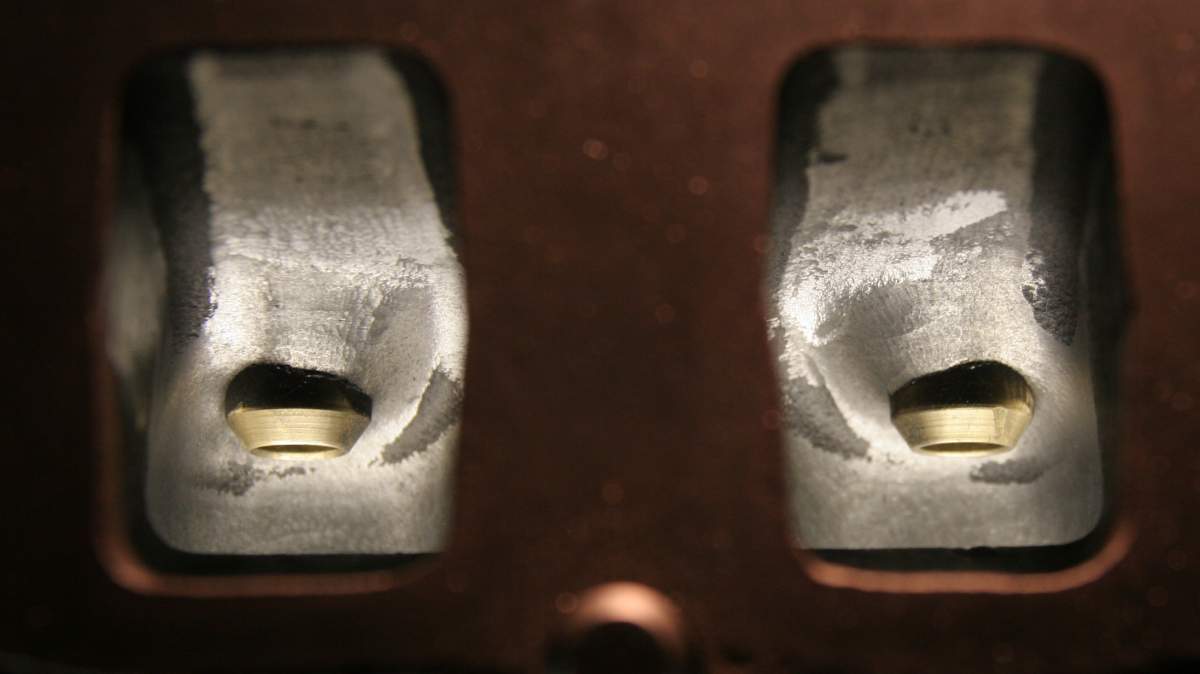 |
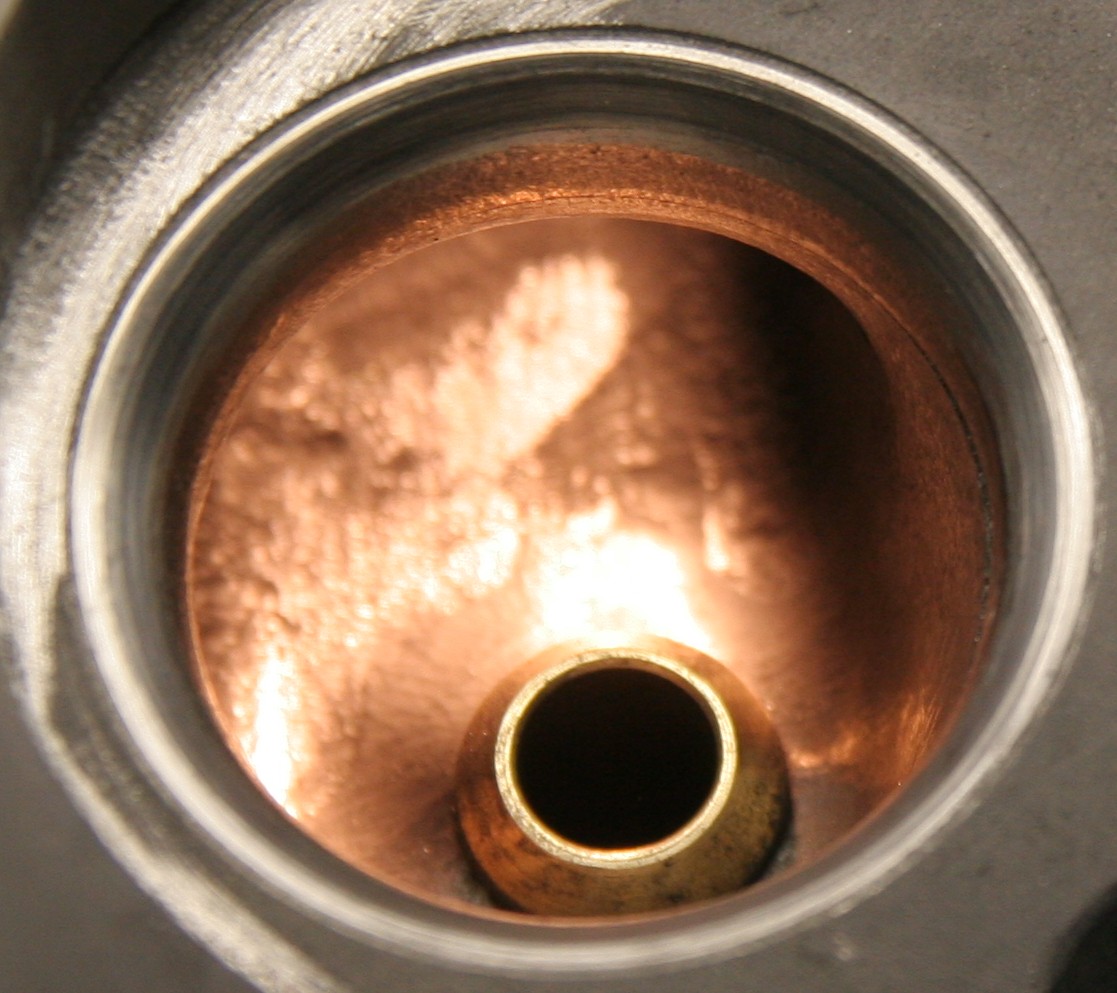 |
Custom port work is done on an hourly basis. Depending on the work specified $400 - $800 would be the typical cost range for custom porting a B20 street head where valve, guide and extensive seat work is not required. Call or Email for details.
Free flow testing - we've had a standing offer to flow test one intake and one exhaust port of any B18/B20 head, without charge, other than return shipping. We make this offer in order to give the customer a starting point or baseline for decisions on whether further work is needed. Results are compared to those from stock and ported heads.
See the end of this section for a more detailed description of our head porting efforts.
Economy Performance Heads
For those who need to limit their expenditure and have a head that has basically good components - good valves and guides - we offer an economy head rebuild that includes basic porting. Hardened seats are installed. The valves and seats are given 3 angle valve jobs. Critical areas of the exhaust port are ported for a 15% ( early & E heads) - 25% (F heads) improvement in exhaust flow. Not in the same class as one of our Street Performance Heads, mainly because porting is limited to the exhaust, but a lot better than stock - a great way to add some performance when you need a valve job.
Economy performance head with your stock valve springs $585
Economy performance head with new retainers and 1.25" dual valve springs for use with performance camshafts $ 765
Add $125 to either of the above to include the installation of bronze valve guides.
Specifications and prices on these heads have changed. Please email or call for details.
Street Performance Heads
Head flow, particulary exhaust port flow, is the main factor limiting power in the B20 engine. Our street performance head was designed to solve this problem. It will meet most street performance requirements including use with superchargers and turbo chargers. The design includes modified combustion chambers to improve combustion efficiency and unshroud the valves, hardened seats, bronze guides, high flow stainless steel valves including an oversize 36mm exhaust valve, three angle valve job, and dual valve springs. The head is milled to achieve the desired compression ratio.
Our Street Performance Head is usually based on the B20F casting, or the similar late B20 carb head, in order to take advantage of differences in these casting that allow the best exhaust port shape to be produced. The chief restriction on these heads is in the exhaust port, so that is where improvements are emphasized, typically improving exhaust flow by over 30%. The superior intake port and larger intake valve of the fuel injected heads, allows modification time to be concentrated where it is most cost effective.
The SP head will work with a variety of carbed and fuel injected induction systems, but requires tuning of these systems to support significant increases in fuel/air flow. Although designed to work best with our cams and exhaust systems, significant increases are possible with other components. Using the SP head on a properly rebuilt 2-liter B20 engine with our street performance cam and exhaust, will result in a very broad power band with HP in the 120 range at the wheels and150 at the crank, with variations depending a number of factors including how the testing is conducted. Power and torque increases start at very low engine speeds and continue throughout the useable RPM range. Detailed dynamometer results are available on request.
Type I
Includes more extensive intake porting than past versions, new high flow valves with larger 36 mm exhaust valves, 3 angle valve job, hardened exhaust seats, dual valve springs, bronze guides, milled to specified compression ratio. Similar to our traditional Street Performance Head (now called the type II head) but at a lower cost due to its stock combustion chamber and less extensive porting - $ 1150 ( Core charge $175 )
Type II
Our standard Street Performance Head, a significant step up from the Type I. Includes new high flow valves with larger 36 mm exhaust valves, 3 angle valve job, hardened exhaust seats, dual valve springs, bronze guides, milled to specified compression ratio. Adds more extensive porting, especially in the intake ports, and modified combustion chambers to un-shroud the valves and support higher flow rates as compared to the Type I. On our supercharger system the use of the Type II head with an appropriate exhaust system has produced increases of over 50 HP compared with stock heads at similar boost levels. On normally aspirated engines this head is the basis for our street performance engines producing from 150 - 160 HP at 2 liters and more with larger displacements. $1375 (Core charge $175)
Type III
A step up from the Type II head due to its larger ports and more extensive porting - similar to our pure race heads but with slightly smaller ports, valves and valve springs. Designed for high performance street use, track day, rally, Targa and Carerra Panamerica race cars. Recommended for larger displacement performance engines, especially our 2.3 and 2.5 liter stroked engines where 180 - 240 HP or more is the goal. $1850 (Core charge $175) This head is now availalbe with larger valve sizes - 46 mm intake and 38 mm ext - email for details.
Type IV
The Type IV is an ultra high performance street/race head based on recent developments from our racing test program. It has some special features to distinguish it and is custom designed for each application. Email for details and options.
B18 Performance Head
For a stock bore size B18 engine you need to use a B18 head which has a smaller combustion chamber than the B20 head. It also has smaller intake valves, larger valve stems, umbrella type valve seals, and smaller ports as compared to the B20 heads. Normal modifications to this head differ some from the work done on B20 heads and consists of the following:
Performance B18 head - modifications include hardened exhaust seats, conversion to B20 valves ( smaller stems than B18 valves ), B20 seals and conversion guides ( custom machined ), ported exhaust and intake ports, larger than stock exhaust valve, larger than stock dual valve springs with retainers - $1450 + $150 core charge if we provide the head. Additional modifications are possible, including a modified combustion chamber to reduce valve shrouding and lower the compression ratio. Email for details as these heads can be done to the customer's specifications.
-------------------------------------------------------------------------------------------------------------------------------------------------------------------------------------
- All prices and performance information above for B20 heads are based on heads built up from B20 F cores.
- Prices and performance of heads based on B18, B20B and B20E cores will vary.
Race Heads
Our Volvo race heads are a significant step up from our street performance heads and our designed for on track competition on engines designed for high RPM and high compression. The vintage/historic race head includes features similar to the Type III Street Performance Head, but than adds larger ports, 1.4 inch triple valve springs good for 8,000 rpm, titanium retainers, 38 mm exhaust valves, with the head milled to provide a 13 - 1 CR. These are serious race heads not designed for street use. More than double the porting and flow test time goes into this head as compared to our Type II SP head. As with our street performance heads, B20F heads are the usual basis for our race heads. With our modifications they flow significantly better than any of the original Volvo R Sport performance and race heads. These heads are designed to work with our race cams and headers to produce reliable road race engines. Dyno results show well over 200 HP at the crank for a 2 liter engine and up to 250 HP for larger displacements.
Techniques for significant head flow improvements were identified during the testing and development phase of our 2009 race program. These improvements have now been incorporated into the design of our current generation of B20 race heads. The result has been dyno tested power increases of from 20 to 30 HP, without other engine changes, as compared to our previous generation of race heads. On the track the degree of improvement becomes clear as soon as you open the throttle. Further improvements are continuously evaluated.
Although our race heads include features similar to those in our street performance heads, there are significant differences as outlined below:
- Intake and exhaust ports are larger with higher flow rates verified on the flow bench.
- Larger 1.4 " diameter dual valve springs are installed with an additional damper spring. As compared to the 1.25" dual springs on the street heads, the larger stiffer springs allow for higher, 8,000 rpm + engine speeds without valve float. *
- Titanium retainers are used to reduce weight.
- The valves are lighter, high performance, swirl polished, with mulitiple valve angles.
- Our standard race head valve sizes are 44 mm intake and 38 mm exhaust, 46 mm intake valves are optional.
- The heads are milled to increase the compression ratio to your specification, usually over 13 - 1.
- These heads will typically support well over 200 HP from one of our 2-liter B20 race engines.
- Upgrades in head design applied in 2009 have added over 20 HP as compared to our earlier race heads. See our dyno charts for more details.
Prices for complete race heads based on B20F cores with the above features start at $2195 , plus a $175 core charge when we supply the head core. Prices for race heads based on B18 or B20B cores will vary depending on requested features.
Although our typical race heads are designed for vintage/historic racing in the US where larger than stock valve sizes are allowed, we also do heads to more restrictive specifications such as the FIA regulations for historic racing in Europe. Special versions are available for various applications. Call or email for additional details.
In many cases previously modified heads can be upgraded to meet our current race head standards. So if you have a race head, done by us or by another shop, fall and early winter is the time to send it in for a rebuild and upgrade in time for the start of the nest race season.
* Race heads with 1.4 " valve springs require aluminum valve covers ( which may need to be modified for additional clearance depending on the type) and modified rocker arms to clear the springs and retainers. It is crucial that these clearnaces be checked and maintained.
Engine Parts
Engine Parts
In addition to our engines and heads we now supply most of the basic engine components needed for an engine rebuild. And where other companies are having trouble supplying basic engine rebuild parts, our inventory is expanding. For 2017 we will continue to increase our parts options for Volvo B18/B20 engines, and will try to bring back some of the custom parts that have not been available, including aluminum crank pulleys and roller rocker kits.
Unless stated otherwise, all parts listed below are for Volvo B18/B20 engines. See the engine section for our bottom end component kits and the Street Performance Tuning Kit which combine many of the parts into cost saving packages.
Pistons - Volvo
We have increased our stock of OEM type cast pistons in order to provide customers with a source for pistons that are becoming hard to find as many traditional sources in the US no longer offer them or have them in limited sizes. We will try to have a variety of sizes of OEM type cast and forged pistons available. If they are not instock we can usually get them. If you need a piston not listed let us know and we may be able to get it for you.
- Custom built forged pistons for NA and forced induction applications from street to race. These are the pistons to use for high rpm or other high stress, high heat applications. Some sizes normally in stock. Other sizes available on custom order in 4 weeks. $650 incl. pins, rings and design time.
- B20 OEM type cast pistons with pins and rings - available in several overbores - .015, .020, .030, .040, .060 - for engines with 6 bolt cranks & 22mm pins - In order to assure availability we often have had to import these directly from Sweden resulting in an increase in price to $385 a set. Several sizes currently available. As piston prices are rising rapidly, prices quoted here are only for those piston sets that we have in stock. New orders will reflect the rising costs.
- B18 OEM type cast pistons with pins and rings - available in several overbores - .020, .030, .040, .060 - In order to assure availability and quality we have to import these directly from Sweden. Based on the current value of the US dollar and increases in piston prices these are currently in the $500 range per set. Several sizes currently available on a special order basis.Email for price and available based on size.
- Cast 92mm pistons with pins and rings - These are B21 flat top pistons also used in B20 big bore kits with 8 bolt cranks and rods - available in several overbores - $495
All piston prices above are subject to change - email for current prices based on size needed. ( 4/12/19 )
Rods - Volvo B18/B20
We use several different rods in our Volvo B18/B20 engines. Most of our Street Performance engines use stock rods that have been reconditioned and upgraded with ARP rod bolts. For race or rally engines that will be run at over 7,000 RPM we use various brands of aftermarket forged rods depending on the application. When using custom made rods we take advantage of the opportunity to have them made to the most advantageous dimensions - longer, lighter and with smaller journals than stock. The results are more efficient engines with lighter components.
Reconditioned rods for 6 bolt crank engine ( All B18s and B20s thru '73 ), the same as we use in our stock rod engines. These rods are cleaned, glass beaded, mag tested, big ends resized if needed, small end bushings checked and replaced if needed, stock rod bolts replaced with ARP rod bolts, then balanced - $290
High performance rods - these are the rods we use in our high performance 2.3 L engines and our 2 L and 2.3 L race and rally engines. Based on and built to our own design they feature longer than stock length and smaller than stock big end bearings. Machining of the crank and custom pin height pistons required. $935
Forged rod and piston kit for 2010, including pins, rings and rod bearings - $1725.
Add an offset ground B20 crank with main bearings for a complete 2.3 liter stroker kit for - $2350.
Engine Bearings - Volvo B18 - B20
- Main bearings - Volvo B18/B20 - standard and .010 under - will also fit B21/23 engines - $85 - $100 per set depending on size needed and availabily.
- Rod Bearings - Volvo B18/B20 thru 1973 for engines with 6 bolt crankshaft - standard and .010 under - $ 65 per set
- Rod Bearings - Volvo B20 1974/75 for engines with 8 bolt crankshaft - standard, .010, .020, .030 under - will also fit B21/B23 engines - $50 per set
- Camshaft Bearings - All Volvo B18/B20 engines - $55 per set
Valves and Guides
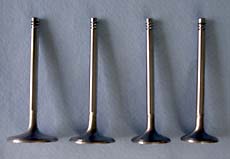 All of our Volvo B18/B20 engines, whether for street, supercharger, or race, use very high quality, severe duty, high flow, stainless steel valves. For street engines these are normally 44mm intakes and 36mm exhaust. For the typical race engine the exhaust valve size is increased to 38mm. The shape of these valves gives a significant flow improvement. Stock type replacement valves are also available, but why use them.
All of our Volvo B18/B20 engines, whether for street, supercharger, or race, use very high quality, severe duty, high flow, stainless steel valves. For street engines these are normally 44mm intakes and 36mm exhaust. For the typical race engine the exhaust valve size is increased to 38mm. The shape of these valves gives a significant flow improvement. Stock type replacement valves are also available, but why use them.
For B18 engines we have guides that allow B18 heads that come with 11/32 stem valves to be converted to the 5/16 stem valves and seals used in the B20 engines.
For optimum fit and performance some custom machining of all guides is usually necessary.
-
SS high flow street and race valves, 5/16" stem, necked down for improved flow. Available sized - 42, 44, 46, & 48 mm intakes - 36 & 38 mm exhausts, $26 each. - With custom ground seat and backcut - $32 each.
-
Bronze valve guides, Volvo B20 ( $56 ) - per set of 8
-
Bronze valve guide blanks used to convert B18 heads to use B20 5/16 stem valves ( $64) - per set of 8 - machined to proper length, shape, and to fit B20 seals - $112
-
Valve seals, B20 ( $18 per set of 8 )
-
Valve locks B20 ( $18 per set of 8 )
Email for additional prices for your specific application.
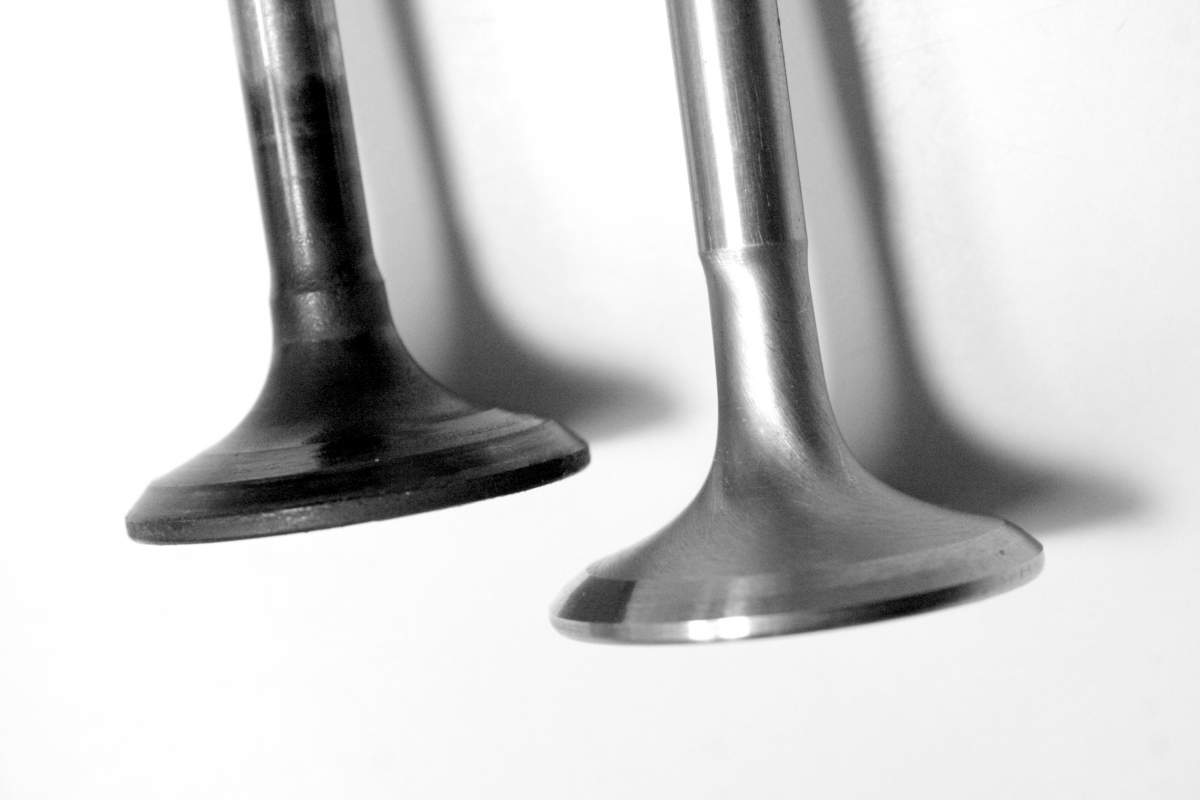 |
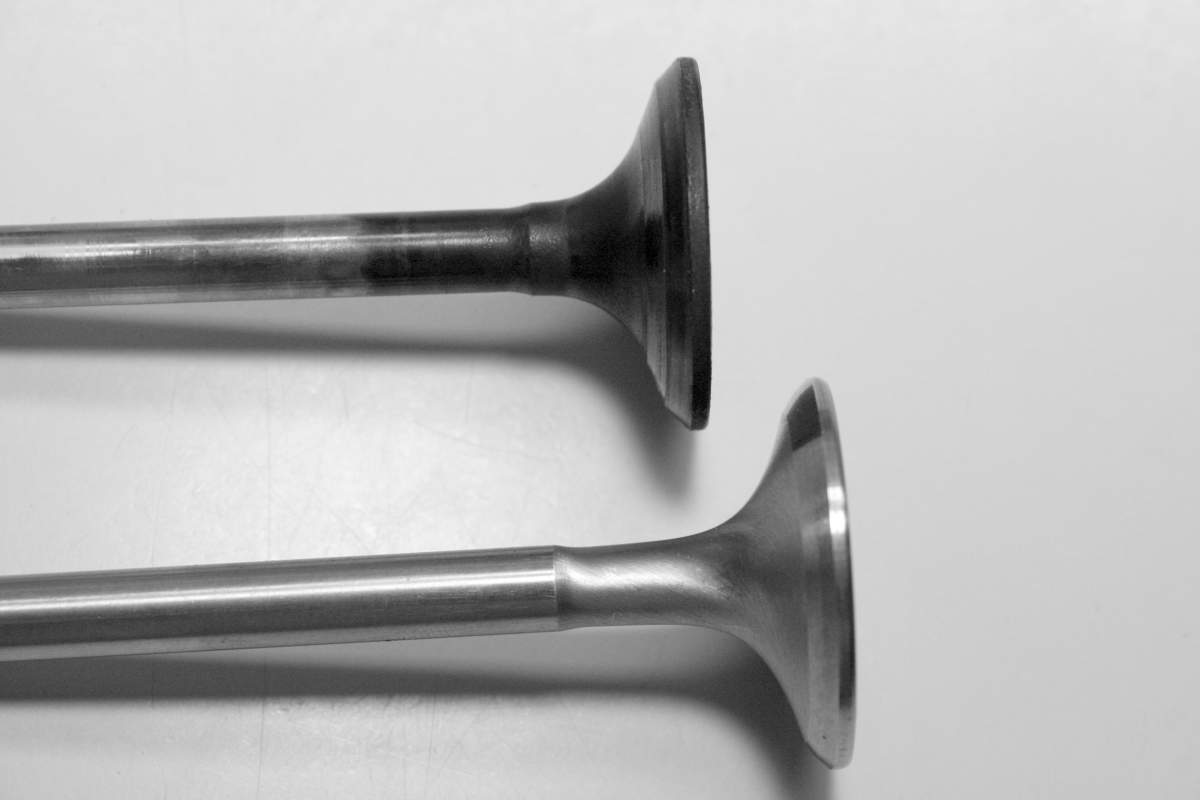 |
Our B20 exhaust valve compared to a stock valve.
Valve Springs and Retainers
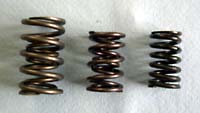
From right to left - a stock spring, a 1.25" dual street performance spring and a 1.44" diameter dual with damper race spring.
For Volvo B18/B20 street, rally and race engines we offer a selection of dual and single valve springs matched to your cam and performance needs in various diameters, heights and rates. This includes valve, valve spring and retainer combinations designed for the use of taller, larger diameter springs (up to 1.44 diameter for race applications) needed to provide higher spring pressures, accommodate higher valve lifts, and reduce spring fade and valve float under high performance and racing conditions.
Order based upon exact requirements. E-mail for recommendations. Other spring and retainer combinations are available.
Street Perfomance - Volvo B18/B20
Our street performance and supercharged engines use dual valve springs 1.25 in diameter. These springs are highly recommended for any engine with a non stock cam. Installation requires a simple procedure to enlarge the spring pockets on a stock head. Since it has to be done while the head is off, it should be done as a routine procedure when changing to a non- stock cam. Matching steel and aluminum retainers are available.
- Dual 1.25" valve springs for street use - $ 125.00 - per set of 8
- Dual 1.25" valve springs for high performance, rally, Targa & Carrera engines - $ 125.00 per set of 8
- Retainers for dual 1.25" valve springs -- steel - B20 $ 79.50 - per set of 8 -
- Retainers for dual 1.25" valve springs - steel - Modified for B18 valves - $129.50 - per set
- Retainers for dual 1.25" valve springs -- aluminum $ 105 - per set of 8 - not recommended for street use
Race - Volvo B18/B20
Due to more radical cam designs and higher RPM use, our race engines are set up with 1.44 diameter dual springs with damper, chosen for long life in high RPM applications. Modifications required in order to use these springs include - enlarging the stock spring pockets in the head, using an aluminum valve cover with reliefs milled for the springs, and modifying the rockers for additional clearance. Titanium spring retainers are used with these springs.
-
Dual 1.44" valve springs with damper for race use $115 - per set of 8
-
Titanium dual spring retainers - $135 - per set of 8
Pushrods & Lifters
Problems with the stock Volvo B18/B20 pushrod and lifter combination caused us to change these components in our race engines many years ago. Since making the changes we have not had any problems, so we use these new components in all of our engines.
Pushrods
The stock pushrods flex, especially in high performance applications using cams with higher than stock valve lift rates, reducing lift and contributing to valve train vibration and instability. To solve this problem we offer high quality performance pushrods to fit various lifter and rocker arms combinations. Available in various lengths, 5/16 is the standard diameter as in the photo below.
.jpg)
Stock B20 Pushrod above - our standard Performance Pushrod below.
- Performance Pushrods for stock B18/B20 lifters - $ 160.00 per set.
- Performance Pushrods for use with our B18/B20 Performance Lifters described below - $ 160.00 per set.
Lifters
Based on over 30 years of experience in race and street engines and elimination of premature wear issues, we do not use stock Volvo type lifters. Instead we use competition style, US made solid lifters in all of our engines, street or race. Our performance pushrods are required with these lifters. Used with our cams, valve springs, spring retainers and valves, the result is a well tested, reliable combination.
New lifters have to be used when installing a new camshafts.
- Performance Lifters - $ 10.50 each - $ 84 per set of
- Performance LIfters and Performance Pushrods - $235 per set of 8 each
Rocker Arms
Improved Stock-type Rockers
Stock Volvo rockers are specified as having a lift ratio of 1.52 to 1, but usually have actual ratios of between 1.43 and 1.47 to 1. This results in less valve lift than expected and less than what is specified for the cam you are using. Most used rockers have considerable tip wear. To cure these problems, we re-work the stock rockers to improve and equalize the ratios.
Stock Type Rockers - While waiting for our new Roller Rockers Kits to become available - see below - time was spent improving results with the stock rockers. They are actually lighter than aluminum roller rockers, and have proven to be stronger and more reliable than most aftermarket rocker arms. The problem with the stock rockers is that the actual ratios vary widely from rocker to rocker, are usually much less than the 1.52 ratio specified, sometimes as low as 1.35 to 1, and produce widely different valve lifts in each cylinder and from engine to engine based on individual variations in rocker geometry. We have seen as much as a 12 HP difference based solely on which stock rockers were on an engine. To solve this problem we now test each and "bluprint" each rocker we use in our engines and can provide to customers both matched stock sets and sets modified for higher lift.
-
Equalized Stock Rockers - we no longer offer unmodified rockers as almost all rockers we receive need work to clean up tip wear. Once they are in the jig they are modified both to clean up the tips and improve lift and then are classified based on the resulting lift ratio. See below.
-
Modified Stock Rockers - modified to improve and eqaulize the lift ratio. Matched sets of stock rockers selected and modified to provide sets with equally improved lift ratios. From $200 - $350 per set depending on lift ratio, from "good" to "race" - on exchange or add $80 core charge.
Good - $200 - standard on our modified street engines - equalized and brought up to 1.5 ratio.
Higher lift - $275 - for maximum street performance with higher ratios - may require additional core rockers
Race - $350 - for maximum lift and duration - not always available and may require additional core rockers.
Add $56 for rockers modified for additional clearance for valve springs larger in diameter than 1.25"
-
Switching to higher ratio rocker arms is like installing a performance cam, higher valve lift and longer effective duration.
-
A tip for maximizing performance when doing dyno tuning is that we can swap ratios to see what setup produces the best performance. Very often different ratios on the intake and exhaust will produce the best results.
Roller Rocker Arms for Volvo B18/B20 engines - Not currently available for 2022 but may be back soon.
Since the decision to discontinue our old roller rocker kit we have been working on a new one. And now it is expected to be in stock soon. It uses the stock rocker shaft, shaft pedestals, adjusters and pushrods and will eventually be available in several ratios. Kits will initially be 1.54 ratio, with rockers in 1.60 and 1.65 ratios projected to be available at a later date . Installation is simple. Just unbolt the stock shaft, slide off the old rockers, remove the adusters and install them in the roller rockers, then install the roller rockers on the shaft. The only other modification necessary is to change to an aluminum valve cover to provide enough clearance for the end rockers. Price for 2014 - $385. With new polished aluminum valve cover and gasket - $595.

|
Advantages of our Roller Rocker Kits for Volvo B18/B20 Engines include:
|
 |
Similar kits also will be available for MGs and Triumphs.
Below is the description of the previously offered kit.
- Increases valve lift and effective duration.
- Increases horsepower and torque.
- Allows higher RPM operation.
- Reduces valve train wear and increases the life of valve guides and seats.
- Reduces heat by reducing friction.
- Change back to the original in minutes.

Most modern pushrod racing and performance engines use roller rocker arms due to their many advantages. In England they have been used on vintage racing and rally cars for many years. We have made these available in the U.S. for use on Volvo pushrod engines.
These high ratio (1.6 - 1) alloy roller rocker arms for Volvo B18 and B20 engines are available individually or as a kit. The kit is complete and ready to install. It includes 8 roller rockers, modified shaft stanchions, pushrods, shims, and miscellaneous parts. The only modification necessary to the engine before bolting it on is a slight enlargement of the pushrod holes in the head. This modification must be done with the head off the block. A cast alloy valve cover must be used in order to provide sufficient rocker clearance.
Rocker Shaft Stabilization
Flexing of the stock rocker shaft causes harmful harmonic vibrations and can reduce valve lift significantly under operating conditions. Modifications tested in our racing program have provided solutions and are offered on a custom basis. E-mail for further details.
Camshafts
The camshaft determines the engine's characteristics more than any component other than the head. For the engine to perform correctly the cam has to be matched to the other parts of the engine. Changes in displacement, compression ratio, valve size, exhaust configuration, the induction system, the flow characteristics of the head, and how the car is going to be used have to be considered in determining optimum camshaft specifications. Our cams are custom ground to match these specifications based on modern camshaft design concepts.
You can save money by purchasing an older cam design that is less expensive because it has been made in large numbers and is sold as a "one size fits all" performance solution, but it will not give the same results. Most of these older design performance cams have long durations in order to increase high end power, necessary to make up for poor head flow, and the result is a loss of low and midrange power. The most common of these are made by ISKY and have not changed since the early 70's. Incredibly, one of our competitors still advertises their street performance cam ( made by ISKY ) using a 1974 review by Road and Track magazine. Does anyone really believe that there have not been significant advances in cam design in the last 35 years? Really? Have they not done any comparative cam testing and development for these engines in the last 35 years? Really? They also offer a street torque cam ( also made by ISKY ) for customers who want low end power, thereby acknowledging that they don't have one cam that offers increases in power across the full, street use rpm range.
So before we got into the street cam business for B18/B20 engines the choice in the US market was one cam if you wanted an increase in high rpm power or another cam if you wanted an increase in low end power. Clearly there was a better way, and we have it - cams developed using modern cam design technology, designed by current cam design experts, with continuous evolutionary development based on current street, track and dyno testing. Computer designed lobe shapes with lifts and duration that are different for the exhaust and intake are just some of the features or our cams that are different from the earlier cam designs.
We prefer not to quote cam specs and instead recommend cams by application, as the normally published specs are often misleading. The cam that we normally use in our street performance engines has 264 deg of intake duration and 268 deg of exhaust at .020 lift, with .285" lift at the cam and 110 deg lobe centers. But this tells you nothing about the most important design element of the cam - the shape of the lobes. More important than the duration at .020 or .050 lift, is the duration at .100, .200, .300, etc., so just comparing duration specs at .020 or .050 does not tell you anything usefull in terms of being able to compare the performance of cams based on these specifications. Our cams, especially the street cams, are designed to have as little overall duration as possible in order to assure that power and torque increases are produced throughout the RPM range with no loss of low and midrange power. With lobe shapes that open the valves more quickly than other cams with similar low lift durations, they have more duration at mid to higher valve openings, and produce more power than cams listed as having longer durations at low lifts. As the optimum requirements for the intake and exhaust are different, our cams typically have durations and lobe shapes designed to meet the separate requirements of the intake and exhaust. Cheaper cams use one profile for both. The result is that our cams produce power increases over a broader RPM range without sacrificing low and midrange power and torque.
We normally stock several versions of our Street Performance (SP) Cam, the Targo Cam, 2 different Street Stroker Cams for large displacement B20 engine, the Supercharger Cam for high boost supercharger applications, and 2 different vintage race cams designed for both low and high compression race engines. Other cam grinds are available on a custom basis to match your engine requirements. With modern computer-controlled production technology it is a comparatively simple process to optimize the cam design to match the specs of the engine it is to be used in. Cams made in small volume, based on modern cam design concepts and tailored to the specifics of a particular engine are more expensive but well worth the price. It takes a little more than a month for a custom cam, ground on a new core.
Our cams are Custom Ground in small batches, Computer Designed and Matched to your Engine Specs.
Lobe shapes are based on the most modern computer design criteria.
We sell cams based on a recommendation for your application, not by listing cam specs for you to browse through as advertised duration specifications are virtually meaningless without knowing the differences in lobe shapes.
Due to an increase in the cost of new cam cores we have had to increase the prices for our cams by a similar amount. If the costs continue to go up the cam prices listed below are subject to change.
Street Performance
Improves power throughout the RPM range unlike other performance cams which trade off low rpm power and torque for higher rpm increases. Mild mannered at low speeds while supporting up to 50% increases in power with appropriate head porting and other modifications.- $375.00
Street Performance - Stroker
A modification of the basic Street Performance cam designed to meet the needs of our larger bore, and 2.3 L stroked engines - $395.00
Street Performance - Stroker 2.5
A new cam based on a modification of the Street Performance Stroker cam to make it more appropriate for high performance in the 2.5 L engine - $395.00
Targa - Rally Cam
Developed for use in events like the Targa Newfoundland and Carrera Pan America where an engine must meet the requirements of both normal street driving and high speed race sections. It's designed to provide more high end power than our Street Performance cam, and to be more appropriate for our large displacement engines in sporting applications. It is our standard rally cam and is also recommended for race cars that are driven to the track, track day cars, etc. - $395.00
Supercharger Cam
Designed specifically for use in our supercharged engines. Testing has shown 50 more HP at similar boost as compared to the stock C cam originally used in our supercharged engines. $335
The Vintage Race Cam
The heart of our 2 liter vintage race engines - both low ( 11 - 12 to 1 CR range ) and high ( 13 - 14 to 1 CR range ) compression ratio versions available - $415. Nitrided for extra hardness $ 515 - allow 12 weeks for nitrided cams not in stock.
Race cams
Computer designed as needed for your application - from $450.00 Nitrided for extra hardness and durability. $550 - allow 12 weeks for nitrided cams not in stock.
Other grinds
Including stock C and D grinds, available from $165 and up.
Accessories
Camshaft retainer plates - $20. Spacer rings - $ 15. Keys - $5
Timing Gears
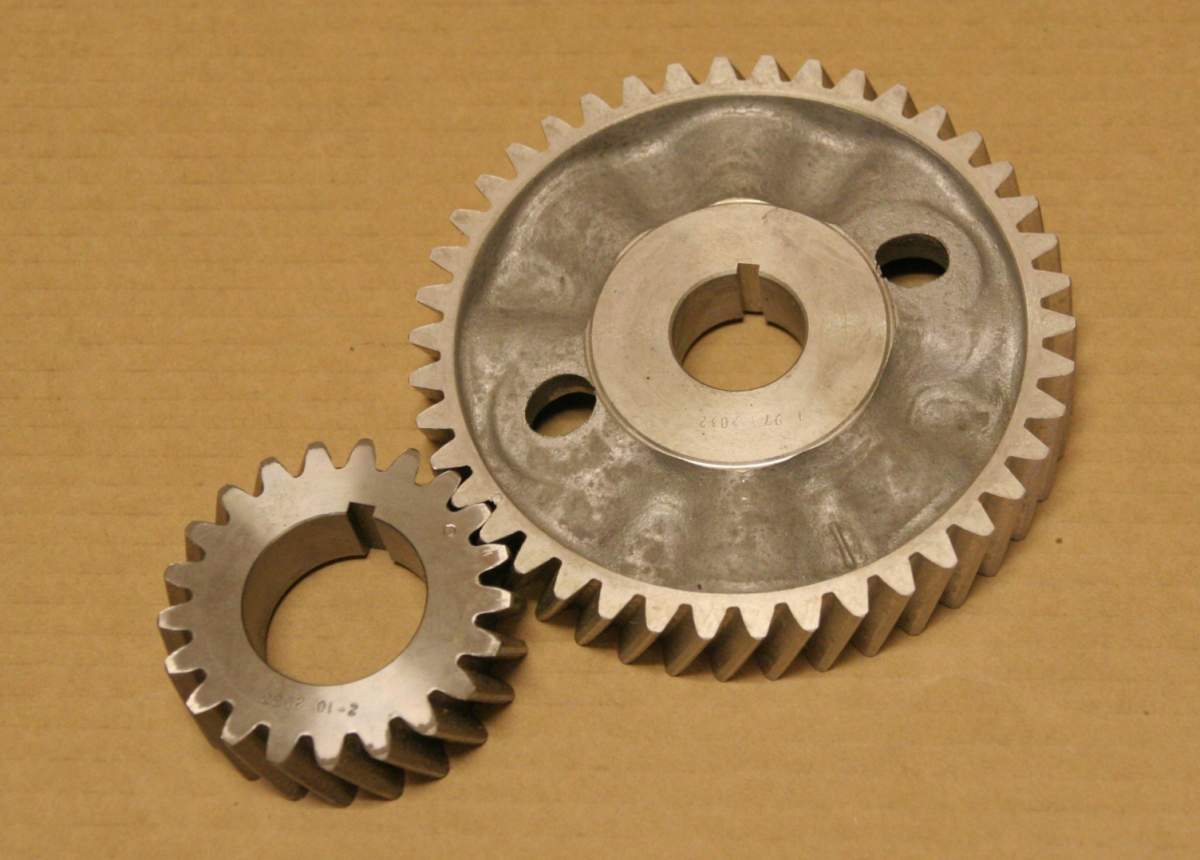 |
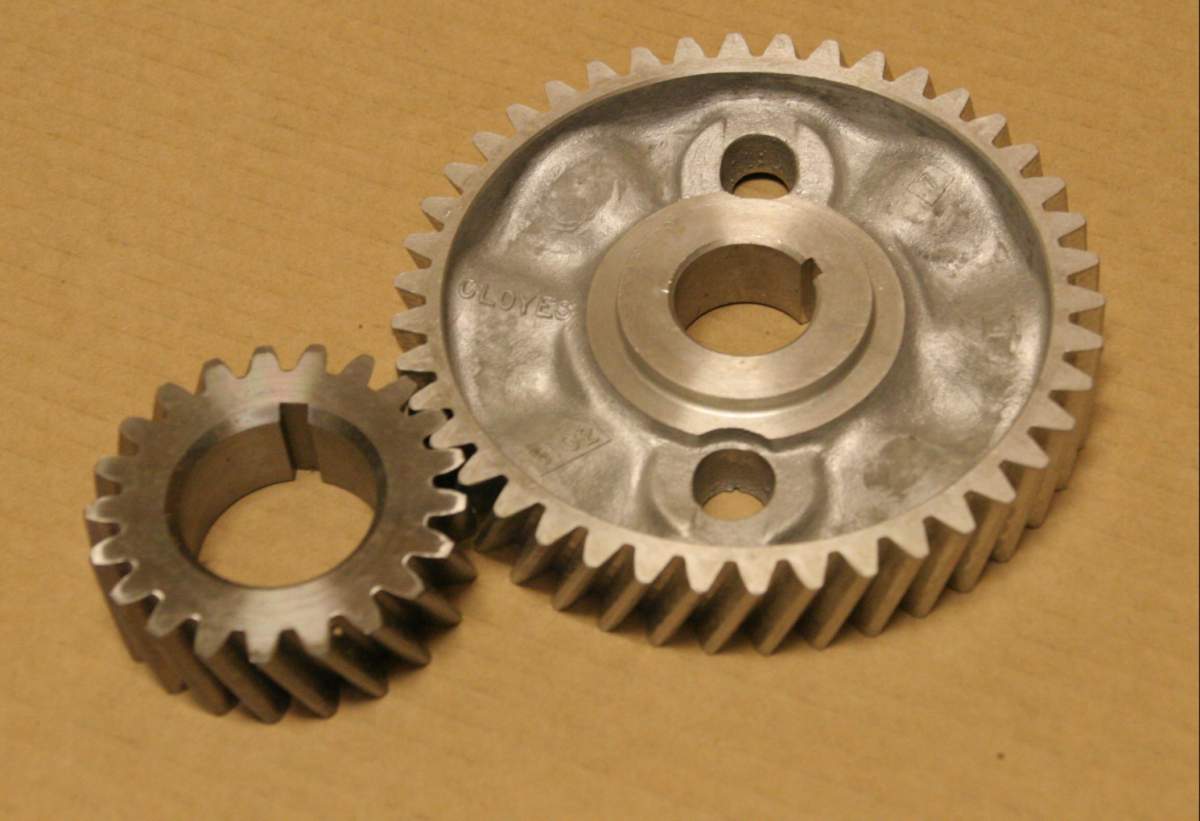 |
If your Volvo B18/B20 engine has a fiber-type cam timing gear it must be replaced when doing a cam change. Pulling the fiber cam gear weakens them and leads to premature failures when reinstalled. Based on years of race and street use we recommond replacement with an aluminum cam gear steel crank gear set - much stronger that the fiber gears, lighter and quieter than the steel cam gears. Cam and crank gears must be replaced in matched sets and are only sold as sets. Aluminum and steel cam gears can normally be re-used - $155
Pulleys
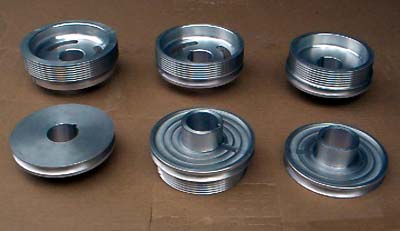
Aluminum Volvo B18/B20 Crank Pulleys
We now offer a selection of aluminum crank pulleys for both supercharged and normally aspirated applications. These are CNC machined from 6061 T6 aluminum. Changing to an aluminum pulley is highly recommended for any racing or high performance application as the stock sheet metal pulleys tend to come apart at high rpms.
- 4 sizes of SC crank pulleys - $150,
- single groove 5.20" diameter pulleys - $105 ( $75 upgrade if purchased with an engine )
- twin groove pulleys for AC or PS - $140. ($100 upgrade if purchased with an engine)
All are designed to slightly under-drive the alternator and waterpump for power savings. They can be modified for use with crank triggered ignitions. The photo shows the four sizes of pulleys for our supercharger system plus 2 single groove pulleys on the lower left and right of the photo.
ARP Bolts
ARP head stud kit
Comes with nuts and hardened washers, highly recommended for all engines as the original head bolts are showing fatigue and often do not give an accurate torque reading. Switching to these studs is the cure for most head gasket problems. Considered mandatory for street performance and race use. — $112.50
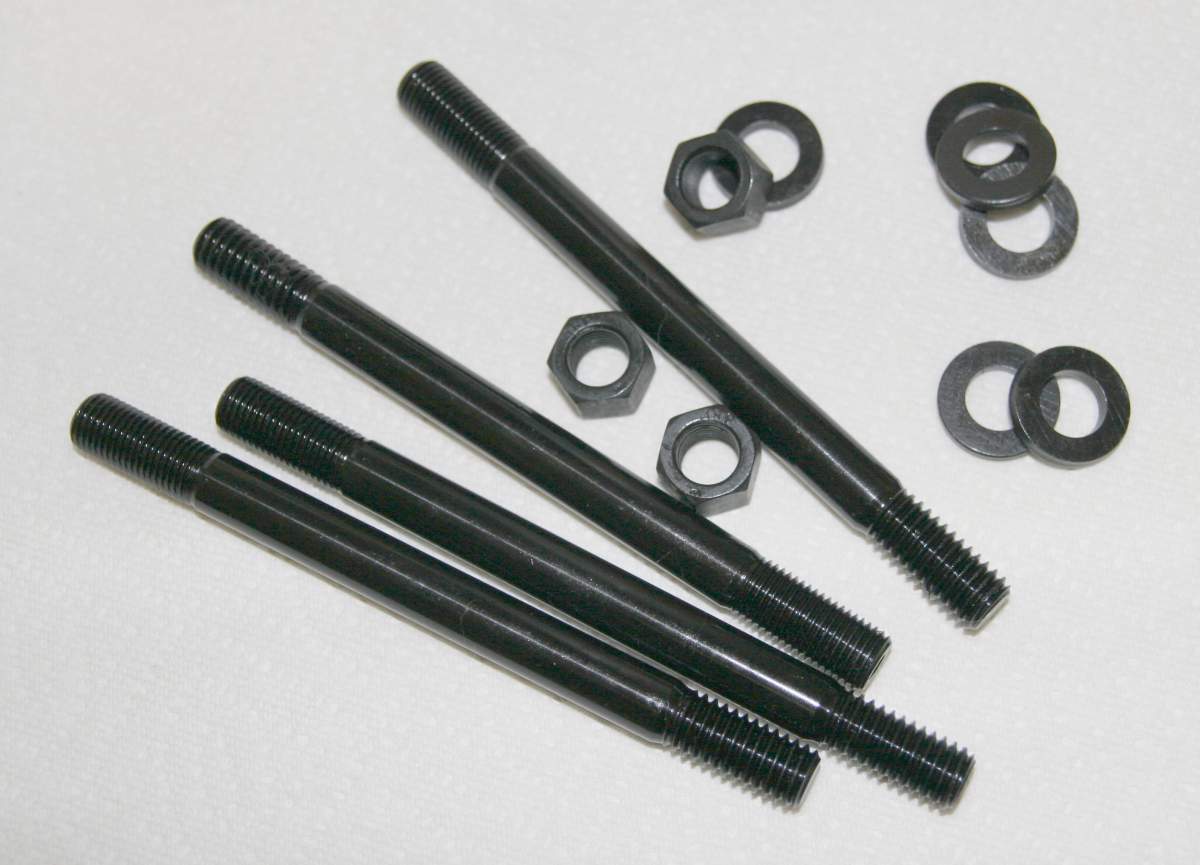
Rod bolts
Custom made by ARP. Needed to prevent rod failure in high RPM street or basic race use. All of our Street Performance Engines with stock rods use these bolts. Well worth the price when you consider the cost of replacing an entire engine if there is a failure. Will not fit engines with 8 bolt cranks. - $135 per set
Gaskets and Seals
Head Gaskets - High Performance and Racing
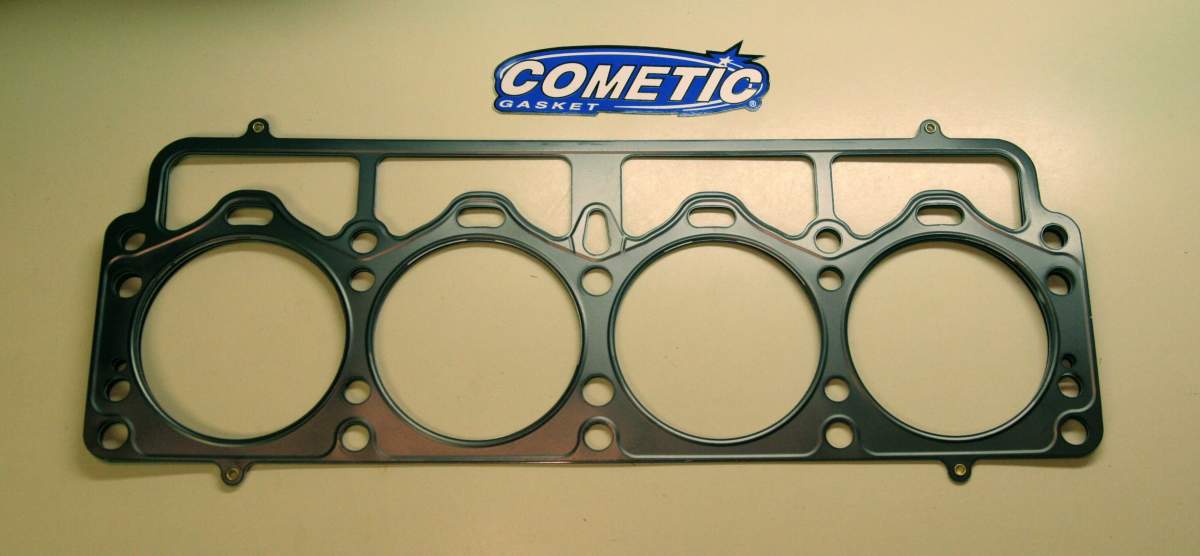
-
Cometic head gaskets in stock and custom bore and thickness sizes for Volvo B18/B20 high performance and racing applications . Used in all of our large bore B20 engines. Now available in .027 and .030 compressed thickness sizes. Most stock sizes - $110 - Slightly higher for custom sizes. Gaskets for other Volvo and non Volvo engines also available on a special order basis.
-
Volvo B20 - 90 mm and 92 mm x .027, .030, .036" or .045" - $116.50
-
Volvo B20 - 93 mm and 94 mm x .027, .030, .036" or .045" - $125
-
Volvo B20 - 92 mm, 93 mm and 94 mm x .060" - $137.50
-
Volvo B20 - Available in other custom sizes
-
Elring Head Gaskets - The standard Volvo gasket - used in all of our engines - including race engines - when a special size is not needed. Common sizes usually in stock - $44.50
Manifold gaskets - Volvo B18/B20
Intake/ Exhaust manifold gasket for Volvo B18/B20 - specify engine and whether fuel injected when ordering - $15.50
Valve Cover Gaskets - Volvo B18/B20 - $9.50
Front and Rear Crank Seal Housings with Modern Seals
Convert your B18/B20 from leaky felt seals to modern silicone rubber seals. We use these seals in all of our engines.
- Machined front timing cover with seal - $60 plus refundable $45 core charge - Total $105
- Machined rear seal housing with seal - $50 plus refundable $30 core charge - Total $80
- Front seal - $8.50
- Rear seal - $12.50
4/11/19 - The above prices are changing due to a significant increase in the cost of the seals - email for details.
Block Gaskets -
- Bottom end gasket sets - $ 72.50
Oil Cooler Adapter
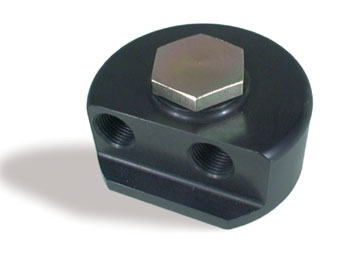
For those of you who have had problems getting the oil lines to clear the header or just want a better quality adapter than those previously offered, I now have a solution which has eliminated all problems. It is a high quality billet aluminum adapter with the threaded holes for the oil line fittings on the side, not coming straight out from the block. In addition, the adapter can be rotated 360 degrees and tightened in any position. This is a great unit compared to the cheap, cast metal units previously available and has eliminated the oil line clearance problems on my race car and street cars using headers and remotely mounted oil coolers. Comparatively expensive at $110.50, but well worth the price. Problems with the old type units cost me a race weekend and a set of engine bearings in '98, plus countless extra hours during every engine change. I will never use that type again. 3/ 4-16 in. Filter Thread, 1/ 2 in. NPT Inlet/ Outlet
Machined billet aluminum, not the cheap cast ones. These can be rotated to any angle to facilitate hose to header clearance. - $110.50
Baffled Racing Oil Pans
To provide for continuous oil flow during racing conditions it is necessary to modify the oil pan to prevent the oil from being forced away for the oil pump pickup by G forces during cornering. We have tested out a simple system of baffles, without moving parts, which has given excellent results over twelve years of racing use. A requirement to ensure a continuous oil supply on the race track or in hard cornering.
- Baffled pan based on your pan or exchange $125.
- Where we provide the pan there is a core charge of $75.
- For a pan with an oil temp fitting the core charge is $100
B18/B20 Oil Pumps
The truth about oil pumps. Volvo has changed the source for their OEM replacement B18/B20 oil pumps. The country of origin is not specified on the pumps, though the boxes still state " made in Sweden ". They appear to be the same as pumps not made in Europe. Given current choices, we source the best pumps that we can find ( some tend to be better than others ) and do a general check of the pump before sale. However, per instructions in the box, each pump should be taken apart, cleaned and checked before use.
- B18/B20 oil pumps $160
- With shaft reinforcing ring $ 168
- Shimmed for higher oil pressure ( more reliable than replacing the stock relief spring ) add $7.00
- Heavy Duty ( heavy weight ) forged pumps - available on special order, email for pricing.
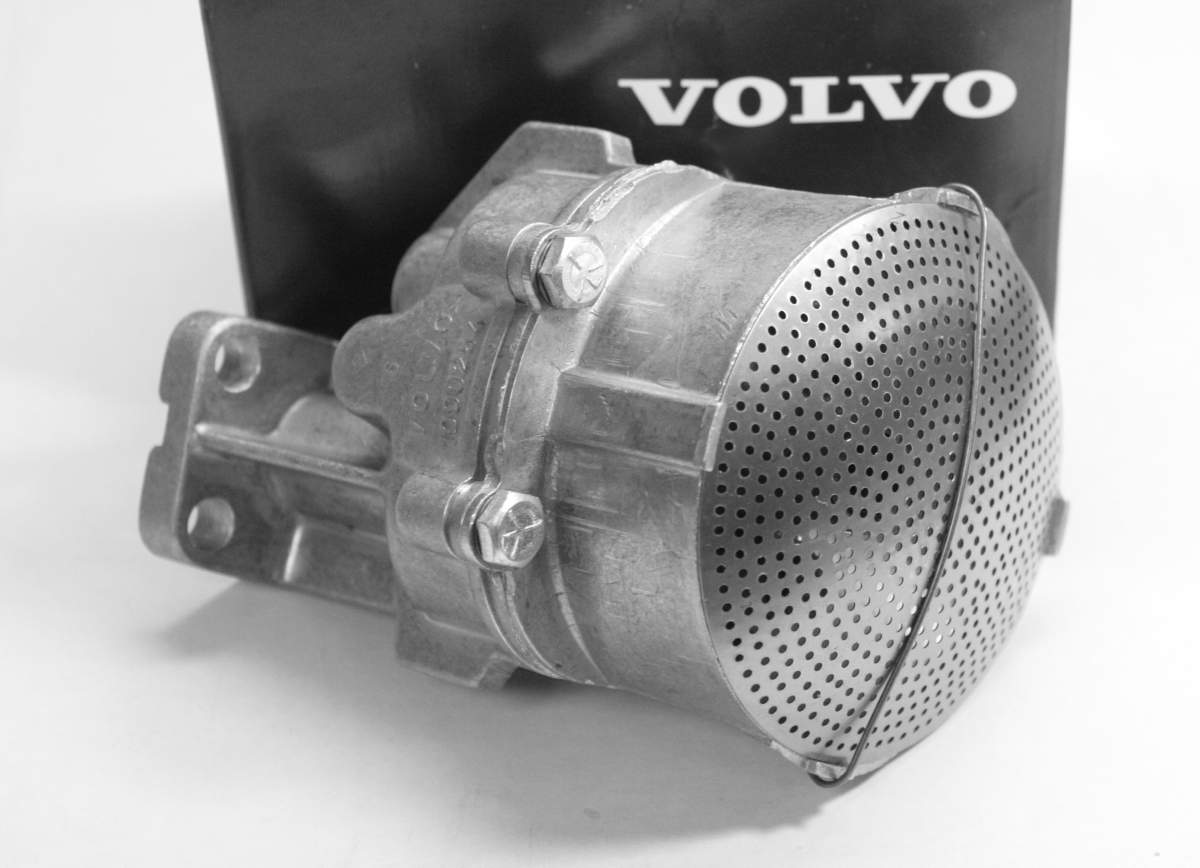
B18/B20 Water Pumps
B18/B20 Water Pumps - $45
Valve Covers - Aluminum - Volvo B18/B20
Aluminum valve covers can be both a dressup and a necessary performace addition. In most applications they are used to improve the appearance of the engine and make it look special. In certain applications they are needed to provide clearance for larger valve springs and/or roller rockers. The polished valve covers provide more room for large race springs as compared to the black covers which may require further machining for valve springs larger than 1.25 inches.
Cast black valve covers - These covers are now back in production and available - $150 ( gasket not included )
Polished aluminum valve covers, gasket included - $225
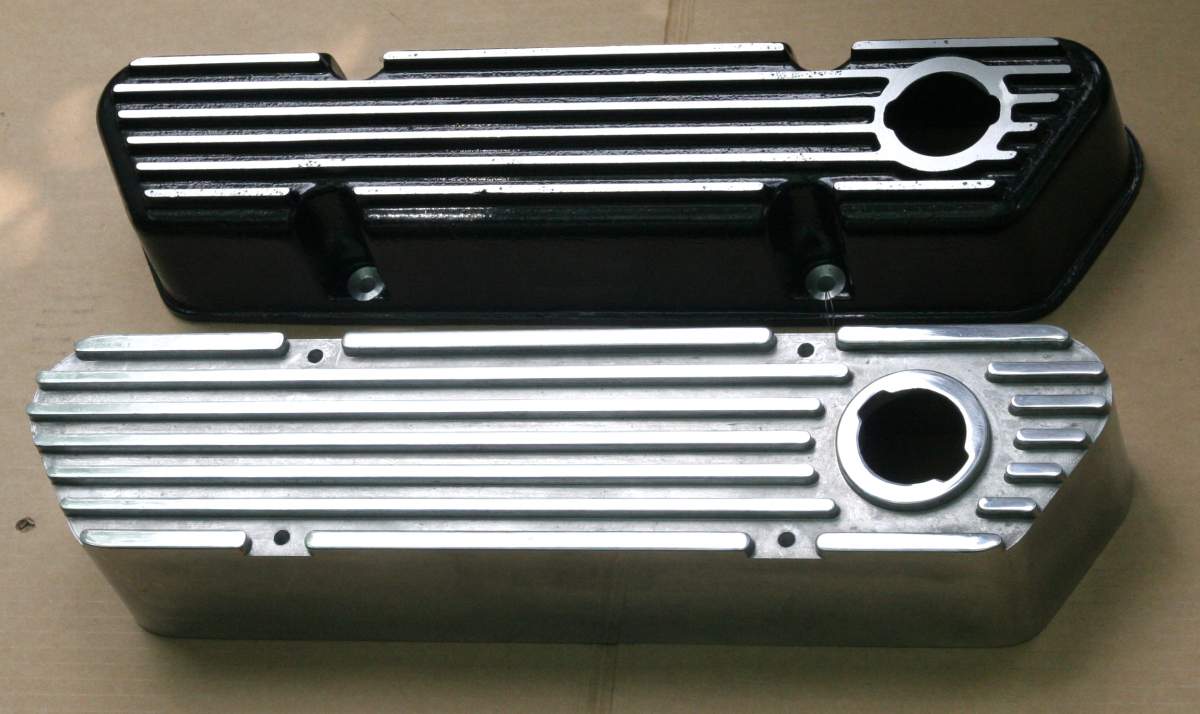
Carburetion
Mikuni and Weber Carbs, Manifolds, Air Filters
Forget what you thought you knew about the best carbs for vintage cars.
Our Mikuni Carb Kits have changed Everything!!
.jpg) |
We still use DCOE Webers for vintage and historic racing, but any car that came with SU or Z. Stromberg carbs will show significant improvements in all aspects of performance by simply changing to the Mikuni HSR carbs.
" yee gods what a difference ...to say it goes better would be something of an understatement." that's the comment from a customer in Scotland who recently installed our dual Mikuni carb kit to replace SU carbs on a Volvo Amazon. And from a US TR6 customer, " Just finished the install on the mikuni’s and damn, what a difference. This car runs like it just grew another cylinder. " And after a recent installation by a UK TR3 owner - "The car runs like a dream , it accelerates like a scolded cat and has bags of low end torque ..."
See the new photos and more customer comments at the end of the Mikuni Carb Section below and the photo article on installing the Dual Kit in an MGB. http://www.v-performance.com/articles/mgb_-_dual_mikuni_installation_.html
In 2003 we needed improvements to the typical SU and Weber carb setups for use on our Volvo performance and supercharged engines. The result was a year of searching and testing that lead to the conclusion that the Mikuni HSR carbs were clearly the best option.
During that year of testing numerous carbs were evaluated both on the street and the dyno. The carbs tested included various versions and sizes of the traditional SU, ZS, Weber sidedraft, Weber downdraft, and a few less commonly used carbs like the Weber 45 MCHH which was offered as an SU replacement. The testing included both stock and modified versions of the carbs. Test criteria included cost, power, throttle response, fuel economy, ease of installation and tuning. After over a year of work, the carb that came out best in all categories for a wide variety of applications was clearly the Mikuni HSR series of carbs. Other carbs still have their place - where an original equipment look is required for shows or to meet competiton rules. But for street driving with a stock or modified engine, or racing where the rules allow a modern replacement carb, these are the carbs to use - especially if your car was originally equiped with one or more of the SU or Zenith Stromberg carbs the HSR Mikunis were specifically designed to replace.
Over the winter of 2010/11 we did a comparison of our Quad 45mm Mikuni HSR carbs vs sidedraft Webers. After running the Mikunis on one of our 2.5 L B20 engines, we installed the 45 DCOE carbs that are usually on my racecar. After finding the engine significantly down on power compared to dyno runs with the Mikunis, we stepped up to a pair of Weber 50 DCO race carbs, first with 42 mm chokes and then with 46 mm chokes. Even with the 46 mm chokes, the power output was lower than with the Mikunis, with higher brake specific fuel consumption, while loosing power at lower rpm. The result - the Mikunis were the clear winner.
.jpg) |
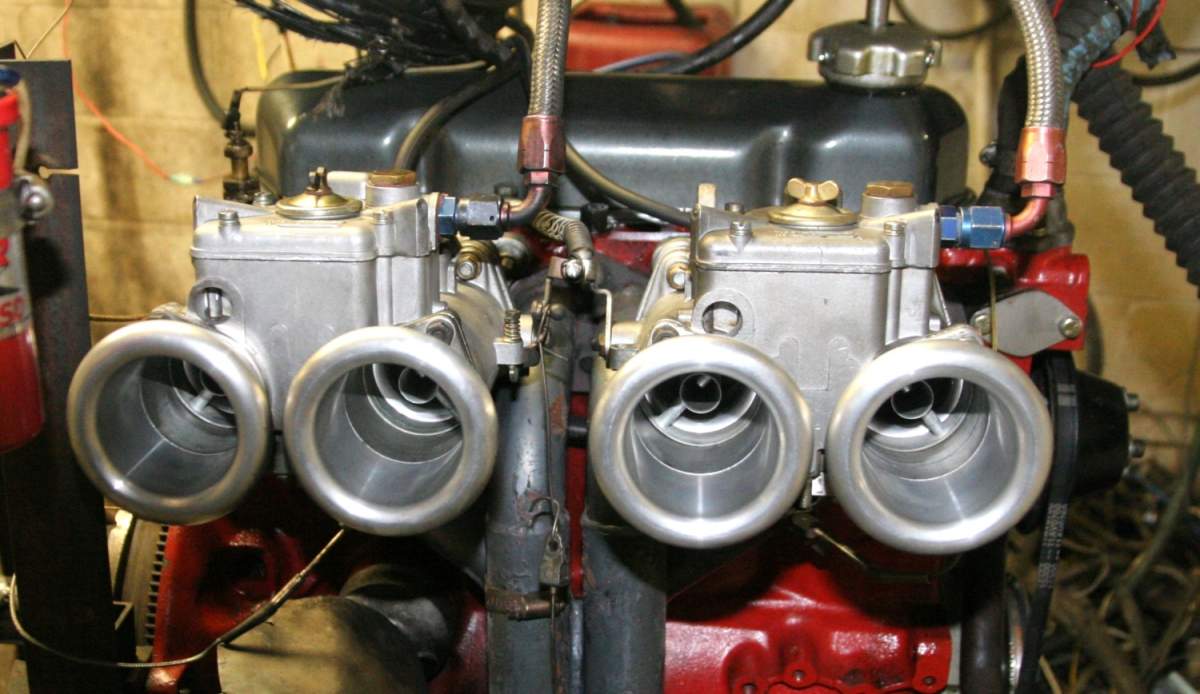 |
Quad 45 Mikunis on the left vs Weber 50 DCO race carbs on a 2.5 L Volvo B20. The Mikunis were the clear winner in power, throttle response and fuel economy. While doing the testing, we developed a new emulsion tube system for the Mikunis.
In 2012 we dyno tested a stock MGB with SU carbs. We then removed the SUs, and installed a pair of 42 mm HSR Mikunis. With no other changes to the MGB, we were surprised to get a 20% increase in power, along with a degree of increased throttle reponse that had to be felt to be believed. Overall it completely transformed the driving experience.
The chassis dyno charts below show the comparison between the stock MGB with SU carbs and the same car with our Mikuni HSR carbs. The horsepower scale is on the left, recorded as corrected horsepower at the wheels. Vehicle speed is on the bottom. The tests were conducted in 4th gear. 50 mph is 3000 rpm. The red line is corrected wheel horsepower of the stock MGB with stock SU carbs.
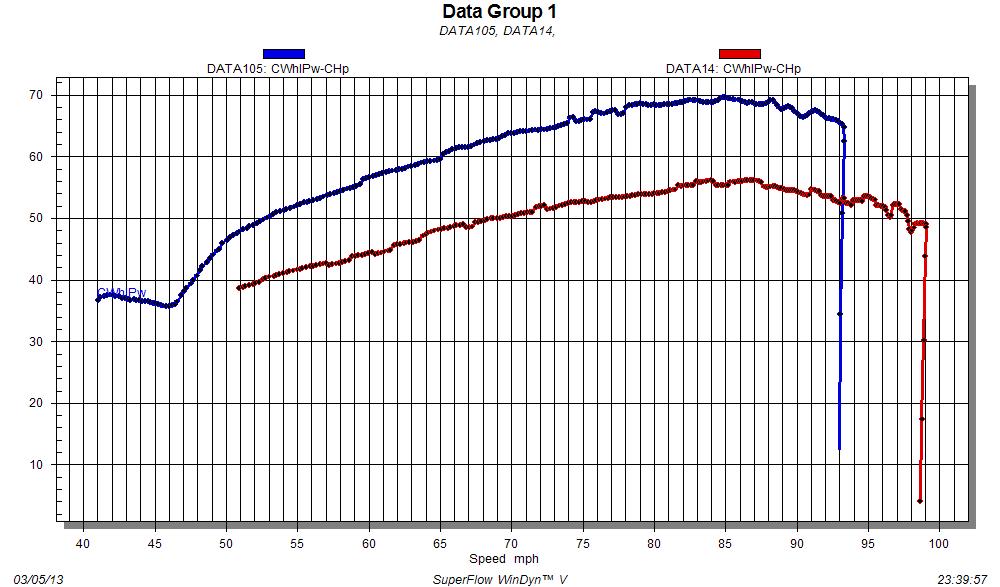 |
After testing with the stock setup, we installed our Dual Mikuni Carb Kit with 42 mm HSR carbs. The black spacers, heat shield openings, and intake manifold openings were slightly enlarged to match the size of the 42 mm carbs, tapering from larger to smaller toward the engine. No other changes to the carb or engine were made. We were surprised by an increase of 13 HP, approx 22 %. What can't be shown is how much more fun to drive the car was, with instant throttle response that kicked the car forward when you hit the gas. Note that there is no loss of low end power.
The dyno chart below shows the same comparison as above with another test added. On this chart the green line is the stock engine with stock SU carbs. The red line is the same stock engine with dual Mikuni 42mm HSR carbs. The top blue line is from another test session. This was a dyno test , on the same chassis dyno under similar conditions, of a 1979 MGB with modified engine, header and high flow exhaust, ported head and "fast road cam", along with the same 42 mm Mikuni HSR carbs, showing the true potential of this setup. All figures are in corrected horsepower at the wheels.
Mikuni HSR Series Carbs
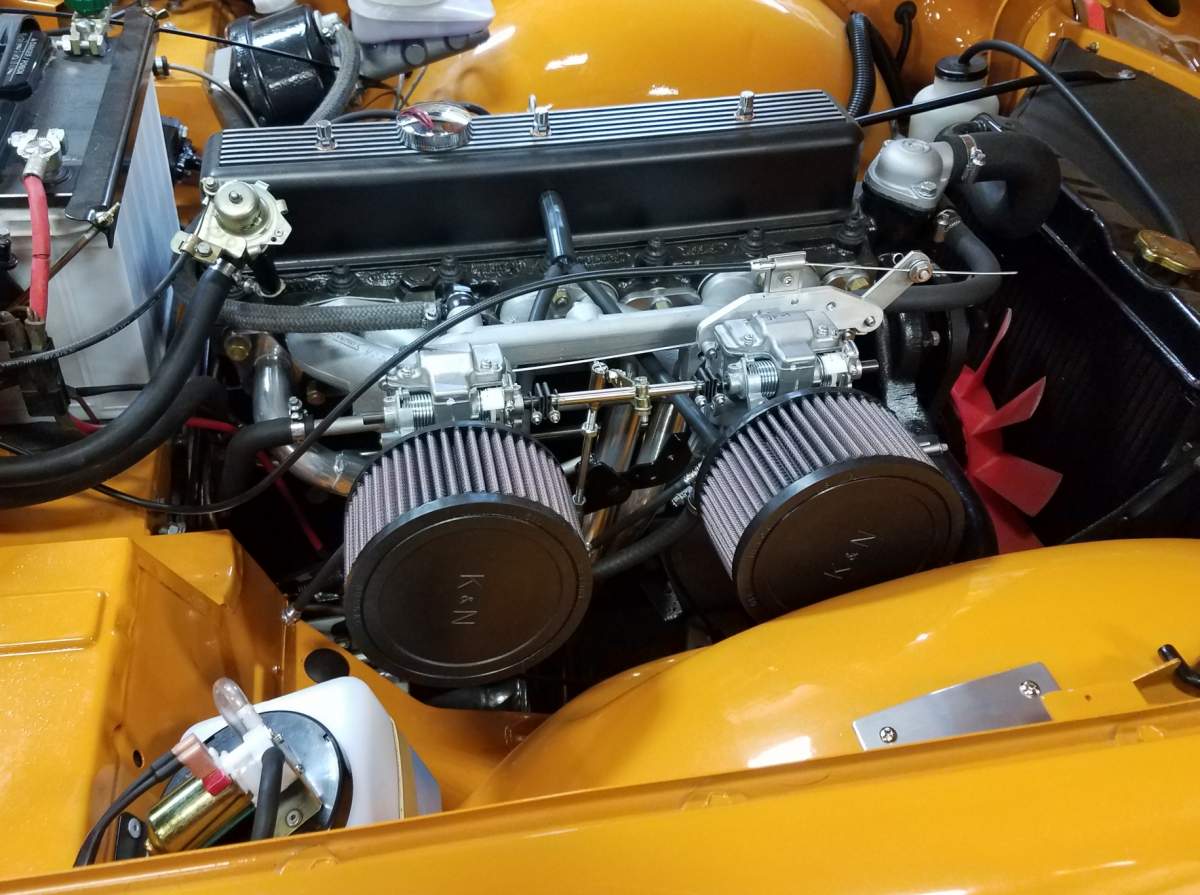 |
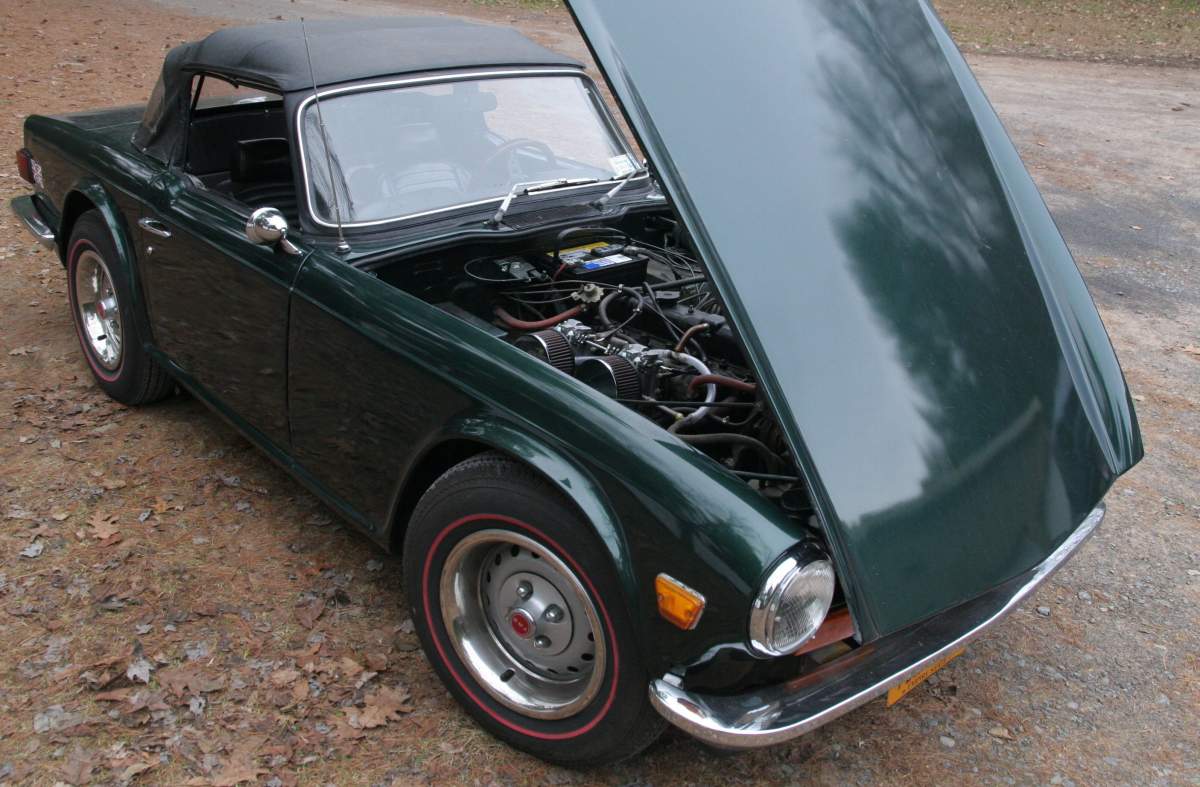 |
.jpg) |
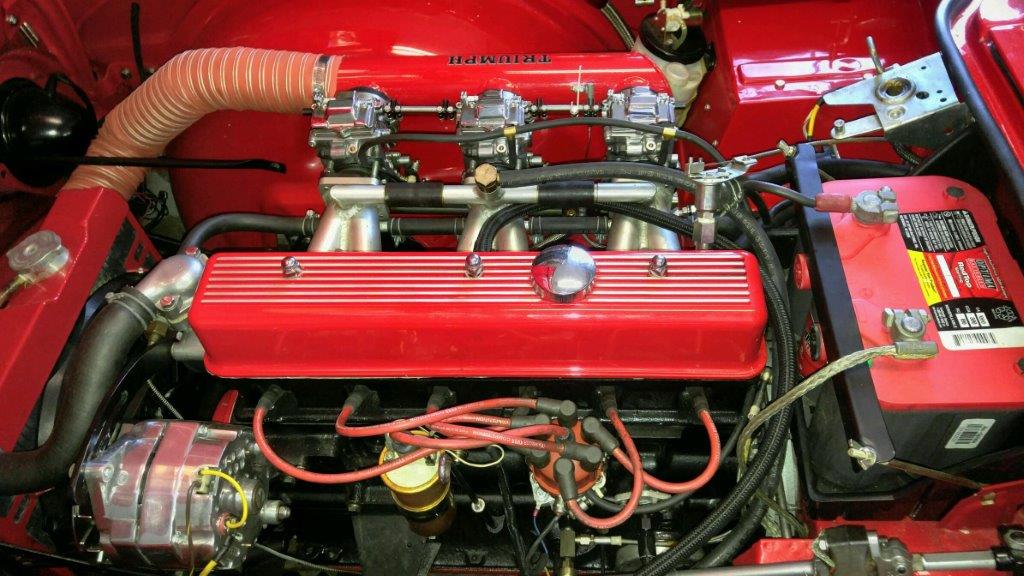 |
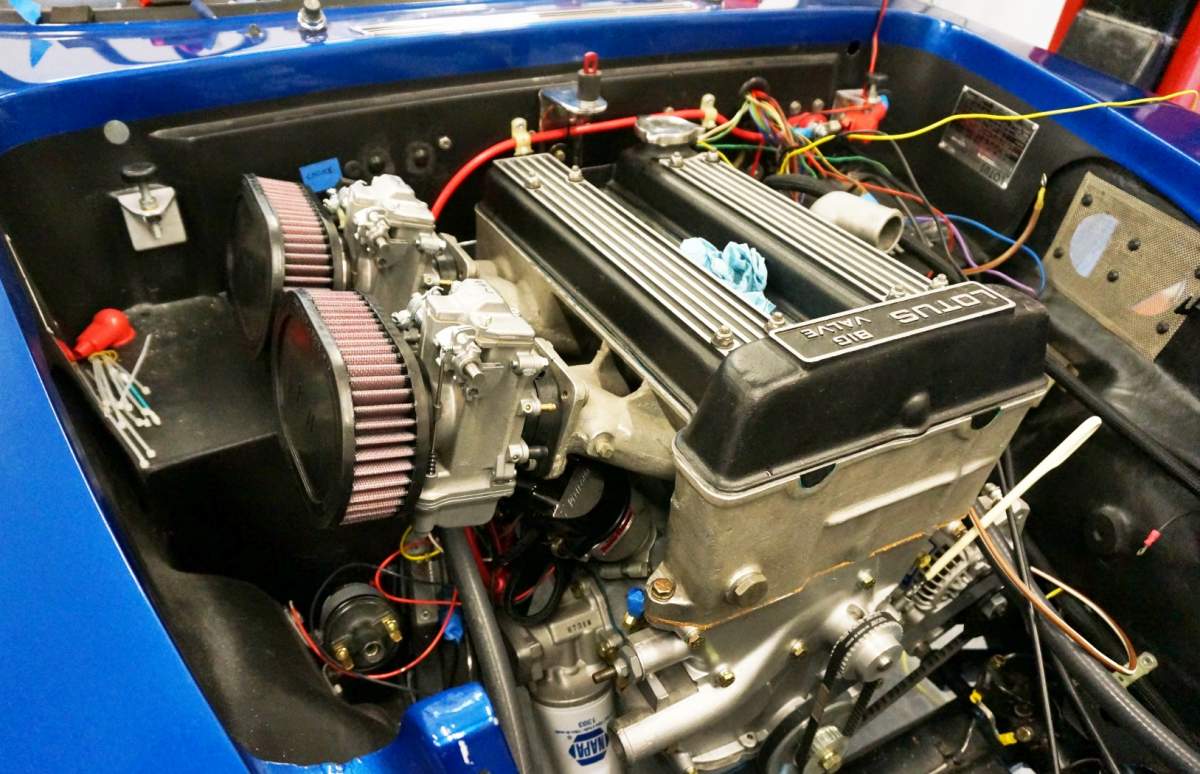 |
.jpg) |
MGB, Sunbeam Alpine,Triumph TR6, and Lotus Elan Mikuni installations are shown in the photos above, as a few examples of the many types of different installations. More photos of MGB, TR6 and other installations can be found below and in the Tech Articles in the "More Info" section of this website. Lotus Elans and Europas and Corvair turbos are so far some of the most popular conversions in 2022, followed by a number of Datsun 240Z orders. A specific kit for the Corvair turbo is new this year.
After 20 years of testing and use, and hundreds of kits sold and installed in various cars all over the world, our Mikuni HSR carb kits have been a great success - proven with each installation to be superior in power, throttle response, fuel economy and reliability. Designed to replace SU and ZS carbs they are a simple replacement for those carbs and are one of the few easily bolted on upgrades that produce a signficant, surprising and easily documented, increase in performance with no other modifications.
Our customers praise and recommend them. A 2015 comment from Scotland after a Volvo installation perhaps says it best: " yee gods what a difference ...to say it goes better would be something of an understatement." (see the full text of this email and other customer comments on their personal experiences with our Mikuni carb kits at the bottom of this section)
I strongly recommend them for a wide variety of applications including:
1) as a stock replacement or upgrade from SU, Zenith Stromberg, or Weber carbs.
2) for Volvo 544, 122, 1800, 140 ( and carbed 240s), MGA, MGB, MGC, Triumph TR3, TR4, TR6, TR7, Spitfire, GT6, Datsun 510, 1600, 2000, 240Z, Mini, Jaguar, Lotus, SAAB, Sunbeam Alpine, Austen Healey, TVR, Daimler, Rover, Holden, etc.
3) in one, two, three, four, six or 8 carb applications.
4) for stock, street, modiified, supercharged, turbo, rally and racing engines.
5) shipped around the world including: Australia, New Zealand, South Africa, Canada, Great Britain, South America, Norway, Sweden, Poland, Germany, France, Belgium, The Netherlands, Spain, Finland, etc.
Technologically superior in design to the typical SU, Zenith Stromberg or Weber carbs that were originally designed more than 60 years ago, the Mikuni HSR flat slide is a modern carb, designed specifically as a bolt-on SU or ZS replacement that will do it all - more power, better fuel mileage and easy tuning in one package. These advances are made possible by several innovations, including the use of a flat throttle plate or "Flat Slide" derived fom racing fuel injection systems which allows for increased air flow and produces extremely high manifold vacuum, aiding in fuel atomization while increasing port velocity.
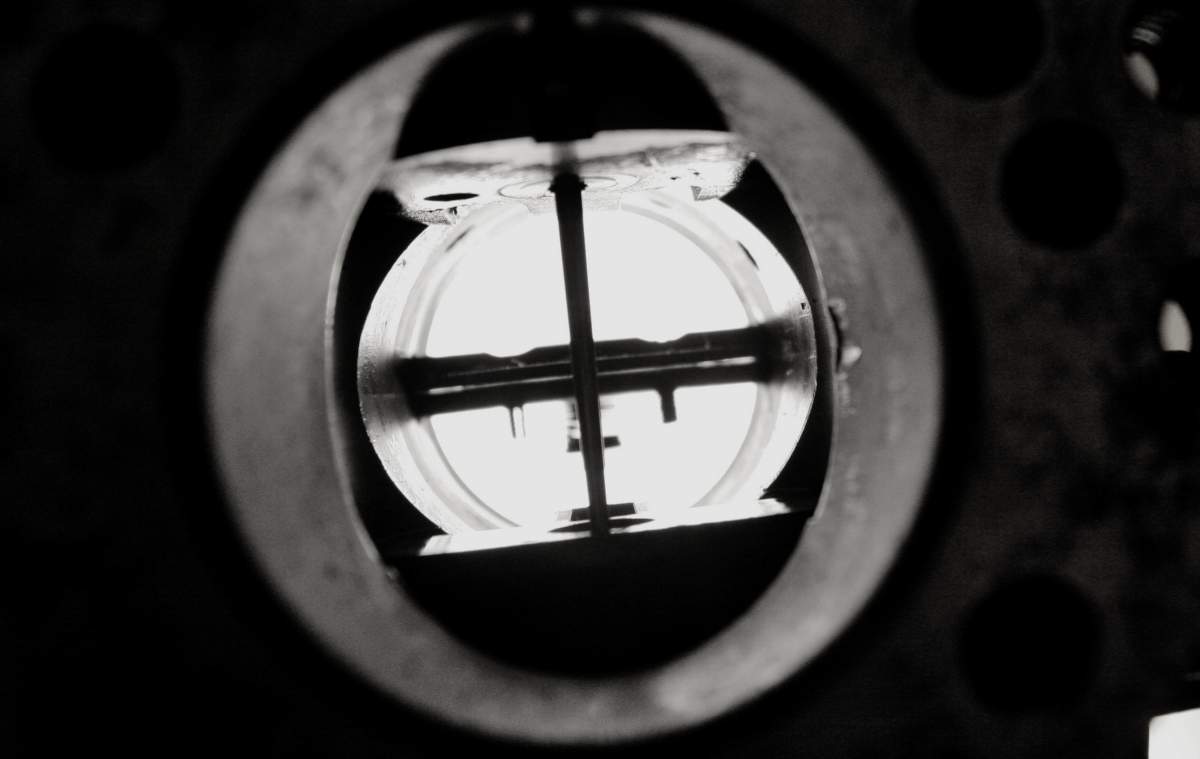 |
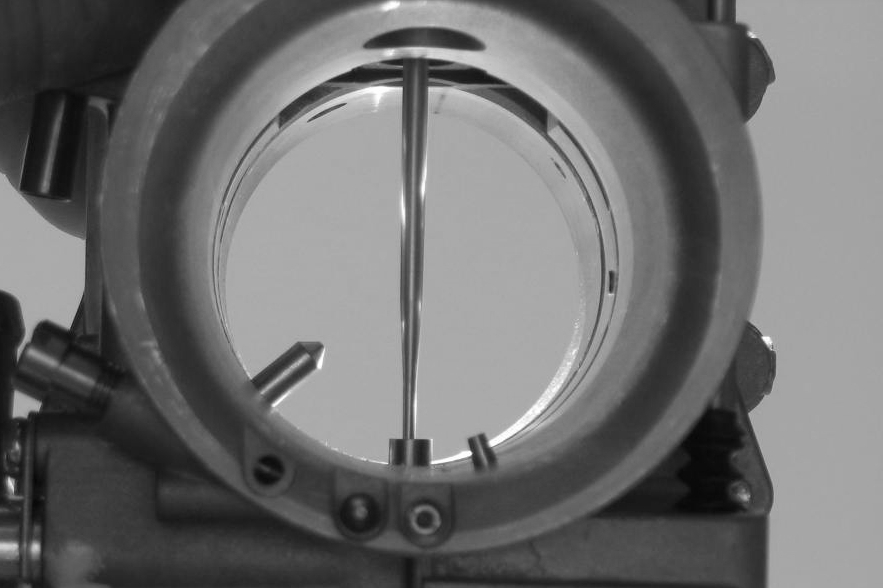 |
Above is an SU HIF 44 on the left compared to a Mikuni 45 HSR on the right. Note the size of the Mikuni's unabstructed flow area- the key to its higher flow capacity. The Mikuni is 45 mm all the way through without a smaller venturi area or throttle plate to restrict air flow.
Compared to SU carbs, a similarly sized Mikuni HSR will flow 30 - 40% more air. They will provide better throttle response, support more power - especially at higher rpms, and will equal or exceed the SU in fuel economy. In road and dyno testing dual Mikunis have equaled or exceeded Weber sidedrafts in power while getting 50% better fuel mileage - at less than 2/3 the cost, using the stock SU or ZS intake manifold. Customers are amazed by the degree of performance improvement as well as the ease of installation and tuning. If you are interested in improving your vintgage car's performance, including its reliability, there is no reason to stick with obsolete, leaky, hard to tune SU or ZS carbs or having to chose between a sidedraft Weber for power or a downdraft Weber for economy. The solution is an upgrade to the Mikuni HSR carbs.
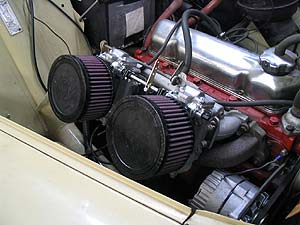 |
|
All carbs in these kits have been modified for automotive use. Since the original SU and ZS carbs that they are replacing are the same, regardless of the car make, the same basic kits can be used for installations on a variety of different cars with some changes in jetting and throttle linkage.
Prices include the cost of parts and labor needed for the modifications and manifold adapters. Prices are finally going up after several years of relatively stable costs. Air filters reflect the biggest changes with many of the filters that we have been using having been discontinued - so we are now offering a new range of filter options. Email for new filter details. Price increases are affective June 1, 2022 though all changes may not yet have been made below.
Price summary:
Single Carb Kits:
- Single 42 or 45 mm Carb Kit, modified for automotive use, with smaller 2.3 float needle and seat and larger main jet installed, for cable throttle with manifold adapter, without an air filter - $395
- Single 42 or 45 mm Carb Kit - Modified for Supercharger Applications - for cable throttle , without an air filter - $475
- Add $75 for a carb modified with extended throttle shaft for lever type throttle linkage
- Add air filter options.
Dual Carb Kits:
Replaces 2 SU or Zenith Stromberg carbs on a 4 or 6 cylinder motor - $995 without air filters. Add air filter options including adapter collars which may allow for the use of stock air filters or air boxes.
Weber DCOE Sidedraft Replacement - two HSR carbs mounted as one dual barrel carb -$1095 without air filters.
Triple Carb Kits:
Replaces 3 SU or ZS Carbs on a 6 cylinder motor - $1495 without air filters. Add air filter options including adapter collars which may allow for the use of stock air filters or air boxes.
Quad Carb Kits:
Four carbs modified to mount in pairs on weber sidedraft type manifolds - includes manifold mounts and linkage adapters $2195
Six Carb Kits:
Six Carbs modified to mount in pairs on Weber sidedraft type manifolds - with manifold mounts and linkage adapters - $ 3330
Air Filter Options;
These include the traditional K& N air filters shown in most of our installed carb photos. However most of these filters have been discontinued by K & N, and the prices on some of those that are still available have gone up considerably. Our new standard filter for most applications is also from K & N, under the Spectre brand name. Filtration and air flow specifications are equal to or better than the previously used filters. They require a modification to the filters for use with our custom made adpater collars - sold as a set with the modified filters and collars - Email for photos and details. For most applications $75 each with adapter collars - add $7.50 for each vent line fitting needed.
MORE DETAILS
See a more detailed description of the Mikuni HSR Carbs, each kit, and installation and tuning parts below:
Originally designed and marketed as a performance replacement for SU carbs on Harley Davidson motorcycles, the size of the 45 mm Mikuni, the same as the nominal 1 3/4 inch size of an HS6 SU ( though the venturi is actually much larger ), and incorporation of an accelerator pump jet, makes it perfect for automotive applications. Carburetor development for automobiles stagnated more than 30 years ago when automotive manufacturers turned to fuel injection to meet emissions and fuel economy requirements, while at the same time, the evolution of carburetor design for motorcycles, snowmobiles and jet skis continued at a rapid pace. The Mikuni flat slide is the most advanced product of those years of continuing development which began with the traditional SU carb of the 1950s.The result is a carburetor that is superior both in power and fuel economy as well as being reliable and easy to tune and maintain. Parts are less expensive and fewer in number than in most automotive style carburetors.
For a flow rate comparison, measured at a pressure difference of 12 inches of water, Mikuni rates the carb flow as follows:
Mikuni HSR42: 213 CFM
Mikuni HSR45: 237 CFM
Mikuni HSR48: 270 CFM
Our Mikuni carb kits are designed to make the Mikunis an easy, bolt-on replacement for SU or ZS carbs, right on the stock SU or ZS manifold. They will fit in the same space as the original carbs, are 6.75" from top to bottom, 3.5 " tall from the center of the carb opening, and are approximately the same length front to back with manifold adpater as an HS6 SU - 4.1". To determine clearance with the 3" element K &N air filter, the measurement is 7.5 " from the manifold mount surface to the outer end of the filter, 6.5" with a 2" filter. With our new Spectre Filter setup the measurement is 8" from the manifold mounting face. In most applications they will attach directly to the stock linkage pieces provided. The dual kit includes two carbs, two carb to manifold adapters, a throttle shaft, linkage to adapt to the SU or ZS linkage, with the option of adding air filters. Similar kits are available for single and triple carb applications. As with any carb swap, expect to do some tuning to match these carbs to your engine and get maximum performance and fuel economy. Tuning recommendations and jet kits are available.
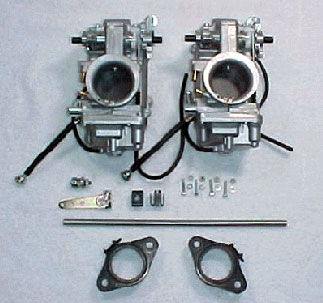 In the Mikuni specific jets meter fuel for various throttle openings. Compared to a sidedraft weber, tuning is much simpler, cheaper and more direct since there are no emulsion tubes, replaceable venturies or the need to guess as to what the result of a change will be. It is hard to describe how much of a pleasure tuning these carbs can be, as compared to SUs or Webers. You really have to experience it to fully comprehend the difference.
In the Mikuni specific jets meter fuel for various throttle openings. Compared to a sidedraft weber, tuning is much simpler, cheaper and more direct since there are no emulsion tubes, replaceable venturies or the need to guess as to what the result of a change will be. It is hard to describe how much of a pleasure tuning these carbs can be, as compared to SUs or Webers. You really have to experience it to fully comprehend the difference.
For additional details on these carbs, a complete tuning and parts manual is available online from Mikuni. Go to www.mikuni.com/fs-manuals.html and click on "HSR tuning manual." Tuning videos for the carbs as used on motorcycles can be found on Youtube.
Our installation and Tuning Instructions are in the "More Info / Tech Articles" section of this Website. Take a look at it even if you are just considering a purchase as it has much more detail on the carbs and their installation. There is also a photo spread detailing the installation on an MGB and another underway on the TR6 dual carb installation.
All of our carbs sold for automotive use are modified to accommodate the higher fuel pressures of automotive fuel systems as compared to the gravity feed systems used in motorcycles. They have also had the main jets that come with the carbs replaced with main jets more suited to the individual application. In multi-carb kits the stock throttle shafts have been replaced with longer, custom made throttle shafts which allow the shafts to be connected and the carbs easily synchronized. These modifications are built into the price of each kit. Additional jets to fine tune the carbs to your application are extra. See the recommended jet tuning kits which allow us to custom jet your carbs and include sets of jets richer and leaner than those installed. Add $25 per carb to the below prices for 48 mm carbs.
Order note - The carbs for the kits listed below are modified on a custom basis per application based on information that you give us about your car, engine. linkage, etc. This means that there is usually a delay between the time of order and date of shipping that could range from a couple of days to a couple of weeks depending on the degree of modification needed for the particular kit ordered, availability of the specific carbs and air filters ordered and the parts required to modify the carbs to match your application. Please ask about estimated shipping time before or at the time that you place your order.
Detailed Carb KIt Descriptions:
The Dual Mikuni Kit
Our most popular kit. The Dual Kit for SU or ZS type manifolds consists of 2 HSR 42mm or 45mm carbs modified with extended throttle shafts, smaller float bowl needle and seat, and larger main jets. The kit includes manifold adapters and linkage designed to connect to the stock rod or cable type throttle linkage- $ 995. Add $ 50 to the above prices for the kit with HSR 48 mm carbs. Several sizes and types of air filters are available. Email for air filter details.
The included manifold adapters allow the carbs to fit on any manifold designed for similarly sized SU or Zenith Stromberg carbs. Minor differences in linkage are usually easy to adapt. Since it is replacing the same carbs whether on a Volvo, MG, Triumph, etc., the kit is the same for each of these applications except for differences in jetting.
Choke cables and/or choke cable adapters are not included as the car's original choke cables can often be used with minor modifications. We have a selection of cable extenders, spitters and choke cable bracket systems in the parts section below. Most commonly used is the choke bracket system, usually for cars with the carbs on the right hand side - used with your original choke cable.
The Dual Kit includes one pair of larger main jets installed. Extra main jets - $ 8.00 a pair - are recommended . Smaller pilot jets and larger needle jets are also often needed depending on the applications. A tuning kit with jets selected for each application is recommended, which allows us to jet the carbs for your application and include a selection of richer and leanger jets for fine tuning. See our tuning kits in the parts section below for details.
Other parts frequently ordered along with the kit above include: Volvo SU aluminum intake manifold. Used, uncoated bead blasted $ 125.00.New manifolds also available ( $125 ) but the casting is not as good as the originals. Extra main jets $ 8.00 per pair. Needle jets $14 each. Jet Tuning Kit recommended - $32 or $60 with one pair of richer needled jets for the 42mm carbs or $88 for the 45mm carbs with 2 pairs needled jets included. Accelerator pump jets $12 per pair. Short idle adjust screws - $16.50 each.
Conversion from single carb to dual carbs - If you have a Volvo, MGB, Triumph Spitfire or other car model that came in both single and dual carb configurations we may be able to help you convert to two carbs ( with significant performance increases ) by providing a dual carb manifold. Email for details.
Dual Mikuni - Single Weber DCOE Replacement Kit
This kit is essentially half of the Quad Kit described below. Two Mikuni HSR carbs are modified and ganged together to replace a single Weber Sidedraft carb on a single carb manifold. $1095 without air filters. Weber style filters can be used with adapters.
The Mikuni Triple Kit
Similar to the dual kit, but designed to replace SU or ZS carbs on a six cylinder engine. The kit consists of 3 HSR 42mm or 45mm carbs modified with extended throttle shafts, smaller float bowl needle and seat, and larger main jets. Includes manifold adapters and linkage designed to connect to the stock throttle linkage. Aftermarket manifolds, not included in the kit, allow two carb setups like the Triumph TR6 to be converted to 3 carbs. $ 1495 for the kit without air filters. Several sizes and types of air filters are available. Email for air filter details. Add $420 for polished carbs.
The Mikuni Single Mount Kit
The Mikuni Single Mount Kit is a perfect replacement for cars with a single SU or Zenith Stromberg carb. Available with a choice of HSR 42mm, 45mm or 48 mm carb, the basic kit includes one carb modified with a smaller needle and seat for higher fuel pressure, larger main jets, with a mounting flange adapter to adapt to your manifold. A throttle cable mounting bracket is also included. Throttle and choke cables are not included but can be provided on a custom basis.
- Single 42 or 45 mm Carb Kit, modified for automotive use, for cable throttle with manifold adapter, without an air filter - $395
- Single 42 or 45 mm SC Carb Kit for supercharger applications - for cable throttle with modified float bowl, accelerator pump and jetting modifications to meet the demands of supercharged operation, with manifold adapter, without an air filter - $475
- Add $25 to change either of the above to a 48 mm carb
- Add $75 for a carb modified with extended throttle shaft for lever type throttle linkage
- Add $65 for standard chrome or black top K& N air filter
- New for 2022 - a dedicated kit for the Corvair Turbo with modified 45mm carb and adapters for both the B and F turbos. $595
.jpg) |
For a more formal look, polished versions of each carb are available. To substitute polished carbs in any of the kits, add $140 to the listed price for each polished carb added. |
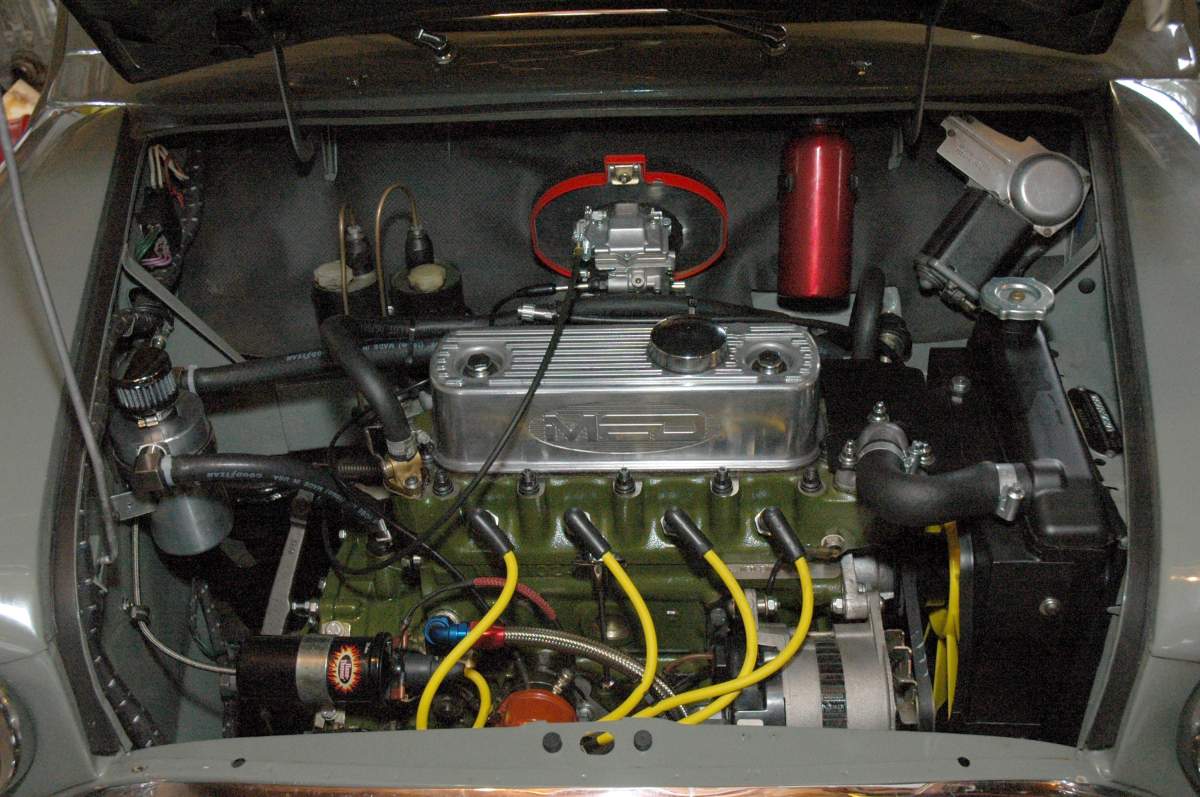 |
|
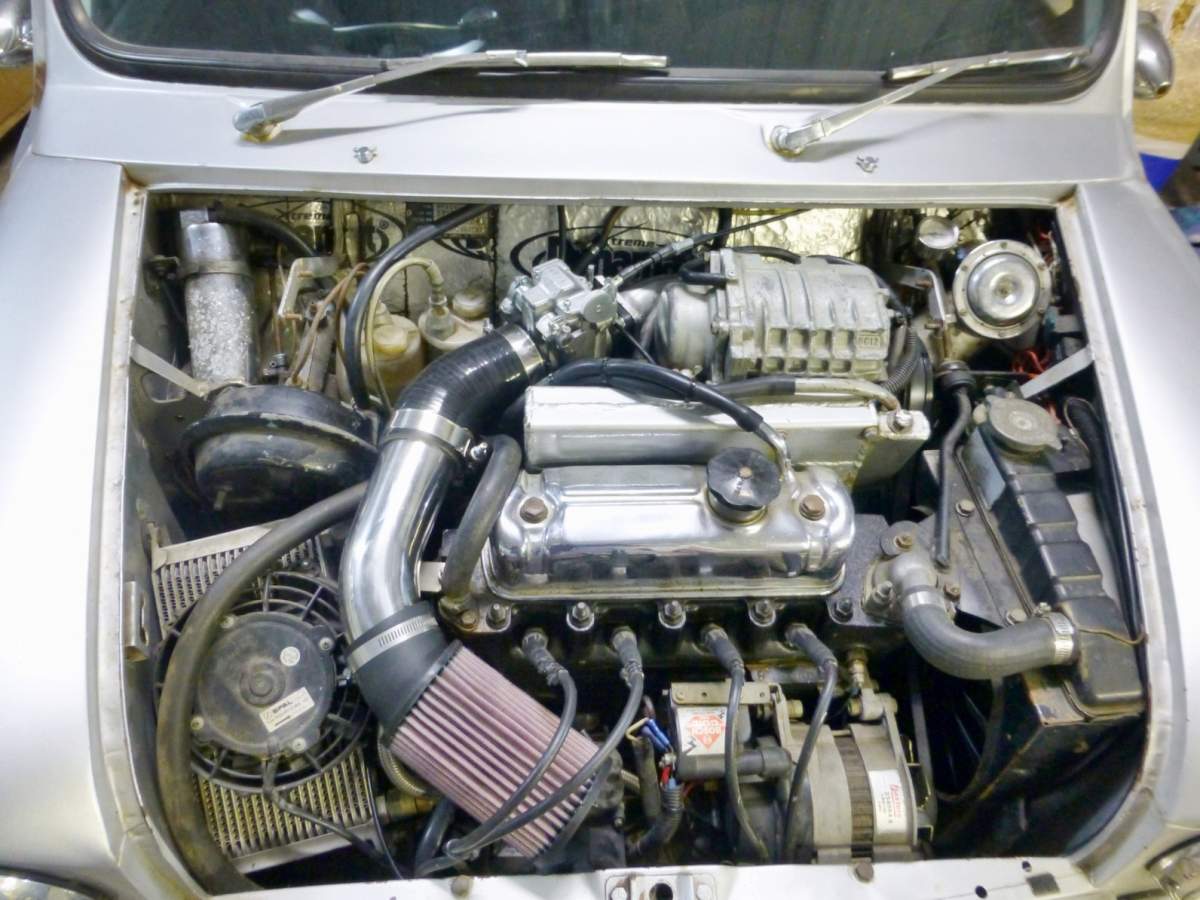 |
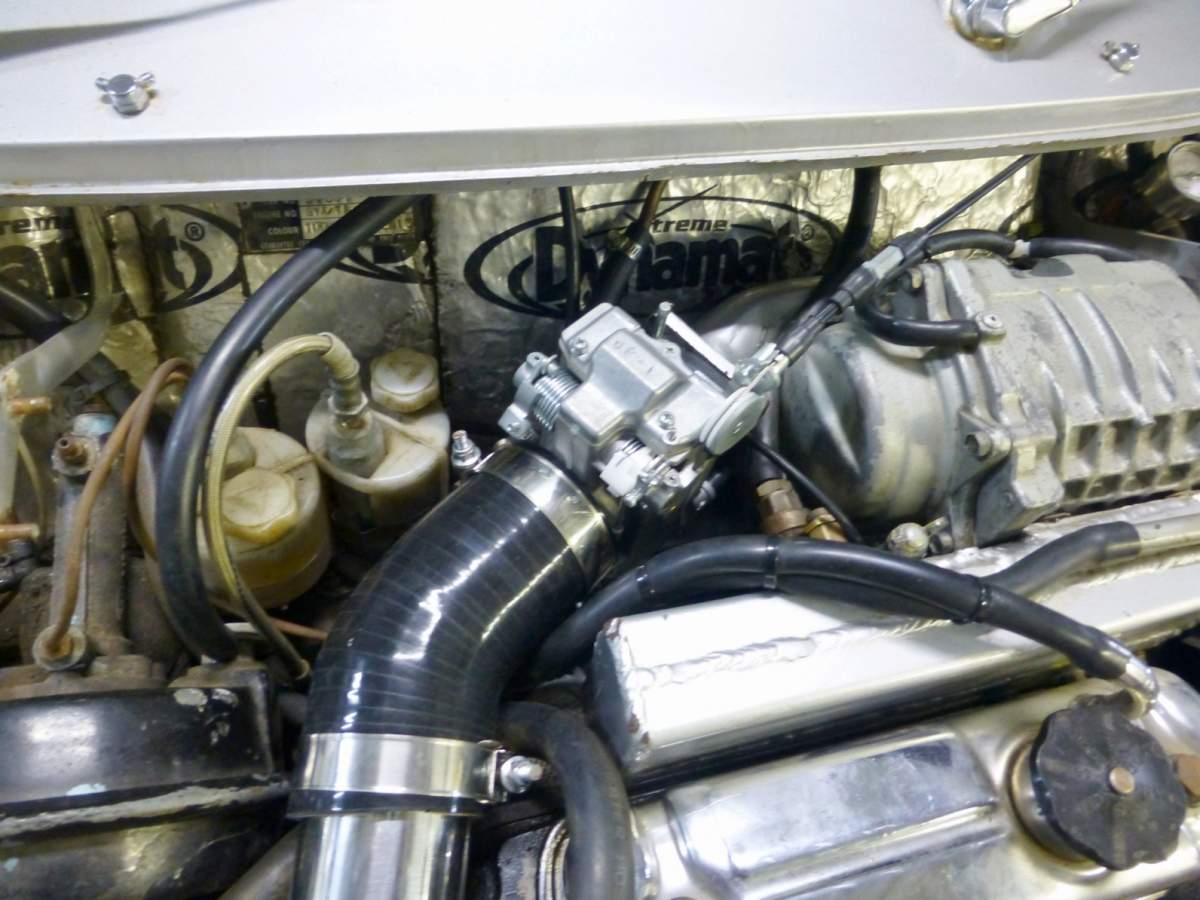 |
Our Single Mikuni SC Kit on a Moss Motors Supercharger in an MGB
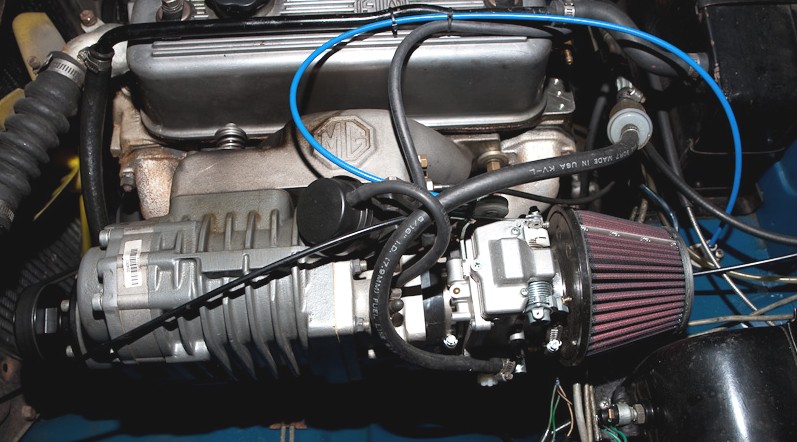
Upgrade your Supercharger Kit with a Mikuni.
The photos above and to the right show one of our modified HSR 45 Mikuni carbs replacing the SU carb that originally came on this Moss Motors MGB supercharger kit. When we first saw the Moss kit we questioned why they would take a modern supercharger and put an ancient carb on it. We later found out that Moss had in fact experimented with using a stock Mikuni HSR carb, but had experienced problems with hesitation that they could not solve. Since we had learned how to eliminate this problem as part of the testing and development process with the Mikuni HSR Carb on our Volvo supercharger systems, we knew how to make it work on the MG. The big change is that the carb float bowl has been modified to increase the capacity of the accelerator pump by approximately 50%. With this modification and proper tuning we can provide a Mikuni carb that is a tremendous upgrade for the Moss Motors kit or any other supercharger kit or turbo application that uses an SU or ZS carb.
The basic kit includes the carb with our standard modifications for automotive applications, with a modified float bowl and larger accelerator pump added, with a larger main jet, and a mounting adapter that allows it to be bolted on in place of an SU or ZS carb - $ 475. Air filters ( $60 - $80 for most styles ), additional jets and other parts can also be supplied. The SC jet tuning kit ( $58 ), listed under Mikuni Parts ( below ), is highly recommended for tuning and will allow us to jet the carb for your application before shipping.
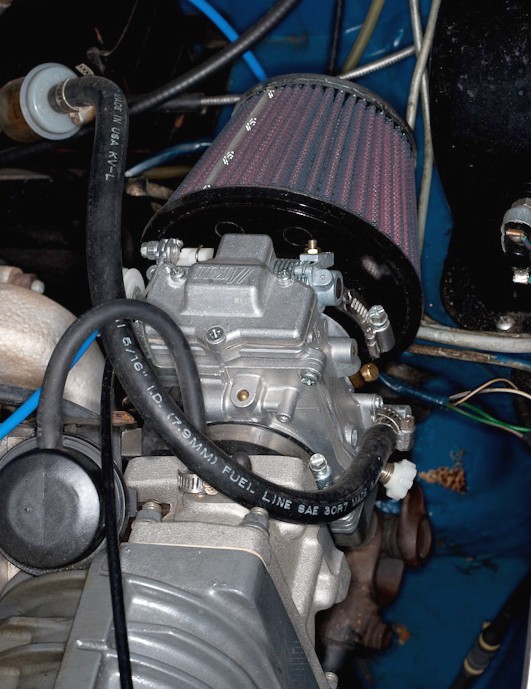
New for 2022 - a Mikuni kit for the Corvair Turbo including a modified 45mm carb with adapters for both the B and F turbos. $595. Email for photos and details.
The Quad Mikuni Kit -- The Ultimate Performance Carb Kit -
(6 carb version also available)
A unique and totally cool setup! 4 HSR Mikuni carbs, modified to mount in pairs on Weber DCOE or DCO type manifolds, using similar linkage, for large displacement and high HP racing and street 4 cyl. engines. It will easily outflow and produce more power than Weber carbs of similar sizes due to the much cleaner air flow path and better fuel atomization. Comparison dyno testing has shown that a set of 45 Mikunis will easily out perform a set of 50 DCO Webers with higher HP and torque from low to high RPM, while using less fuel. These sets are produced in our shop on a custom basis so allow time for machining and assembly. For air filters see the ITG filters in the filter section below.
- Four carbs modified to mount in pairs on weber sidedraft type manifolds - includes manifold mounts and linkage adapters $2195
- Four carbs modified to mount in pairs on weber sidedraft type manifolds - includes manifolds, manifold mounts & linkage adapters, for Volvo B20/21/23/230 including a Weber DCOE style intake manifold, and air filter adapters - $2675 -- Several type of air filters available. Call or email to confirm prices for each application.
- Email for kit prices which include manifolds and air filters for non - Volvo applications
- Six Carbs modified to mount in pairs on Weber sidedraft type manifolds - with manifold mounts and linkage adapters - $ 3330 Email for details.
.jpg) |
.jpg) |
|
New Choke Cable Bracket System Introduded in March 2017, our new choke cable system has been so well received it has been difficult to keep up with orders. Based on a custom system made for one of our TR6 customers, a bracket is attached to one carb and attached to the original choke cable and allows 1 or 2 additional carbs to be choked with short lengths of cable from the bracket to each carb. A much cleaner setup than running multiple cables fom the dash or a cable splitter. For 2022 we have a modified low provile version for cars with hood clearance issues. This system is recommmended for cars such as Triumphs, Jaguars and Volvos which have the carbs on the right side of the engine with the port for the choke cable facing the front of the car where the choke cables normally having to be looped around the engine compartment to enter from the front, creating a messy look eliminated by this system. Current pricing for 2019 is $108.50 for two carbs and $117.50 for three. The kit includes the custom made aluminum and stainless steel bracket assembly complete with accessory cables and ready to mount on your carb and attach to your choke cable. |
|
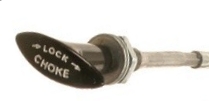
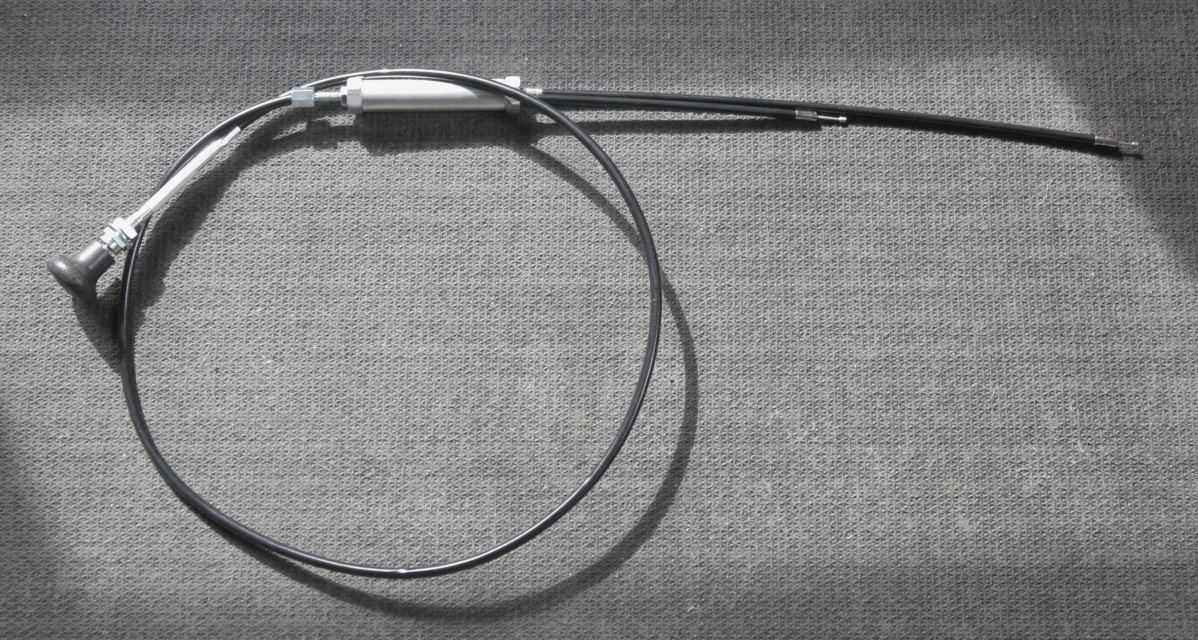 |
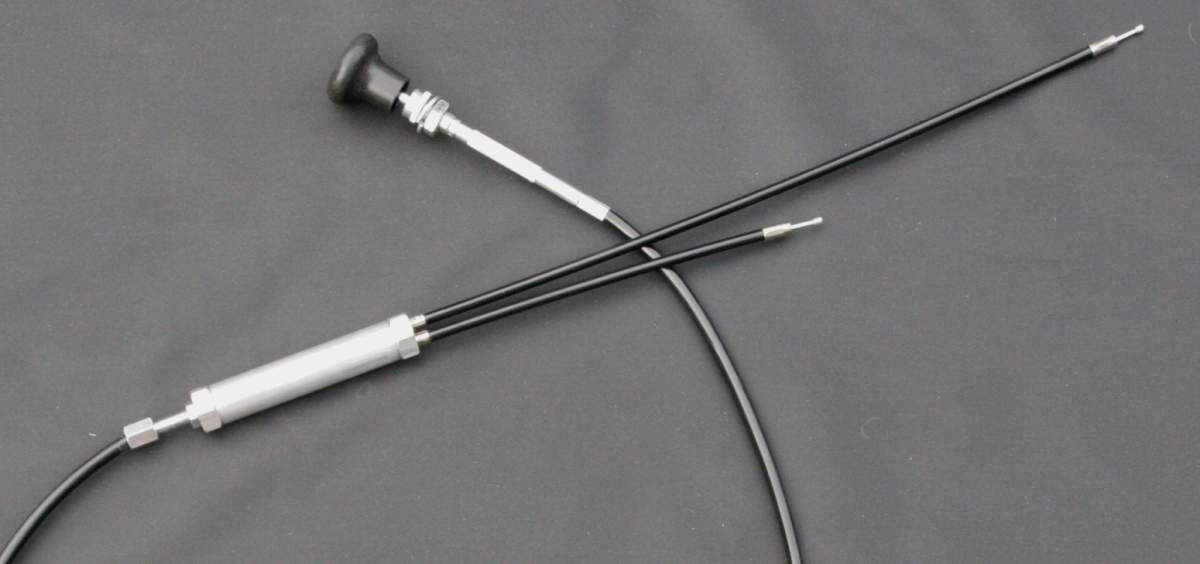 |
.jpg) |
Closeup showing the choke cable attachment in the splitter |
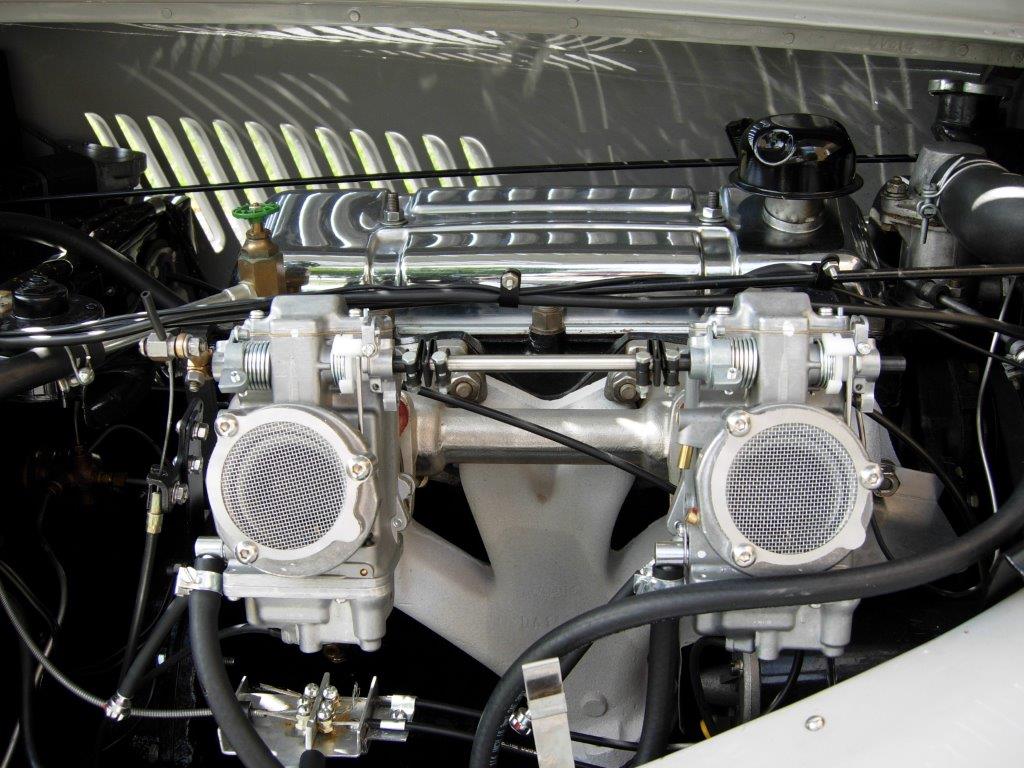 |
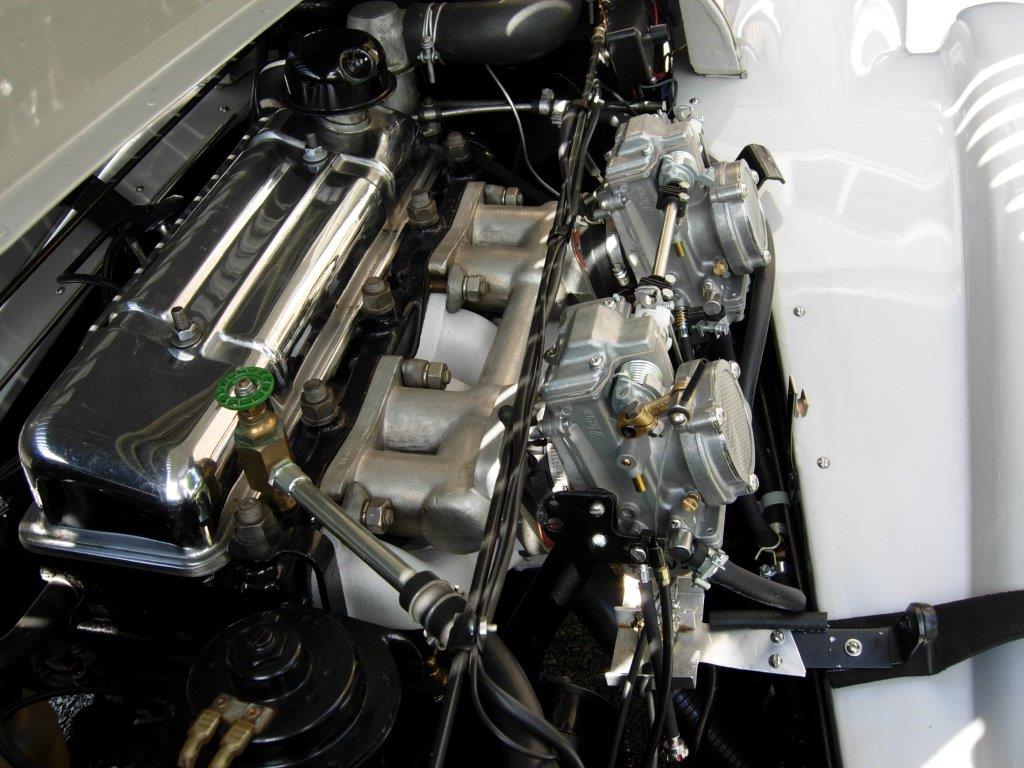 |
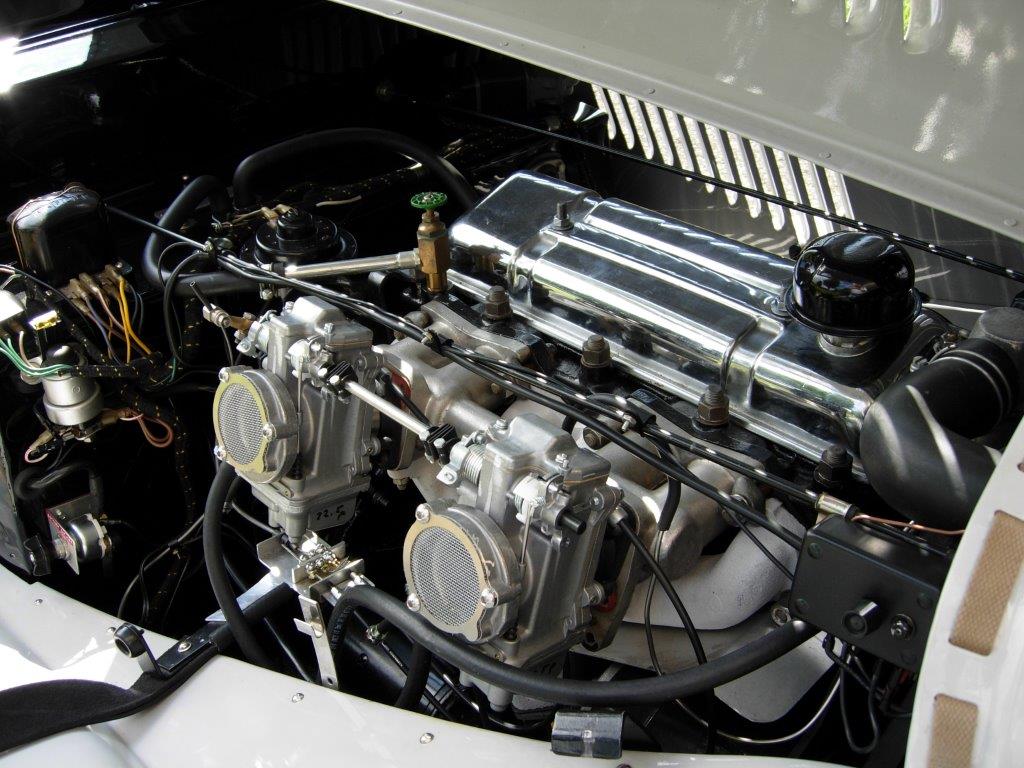 |
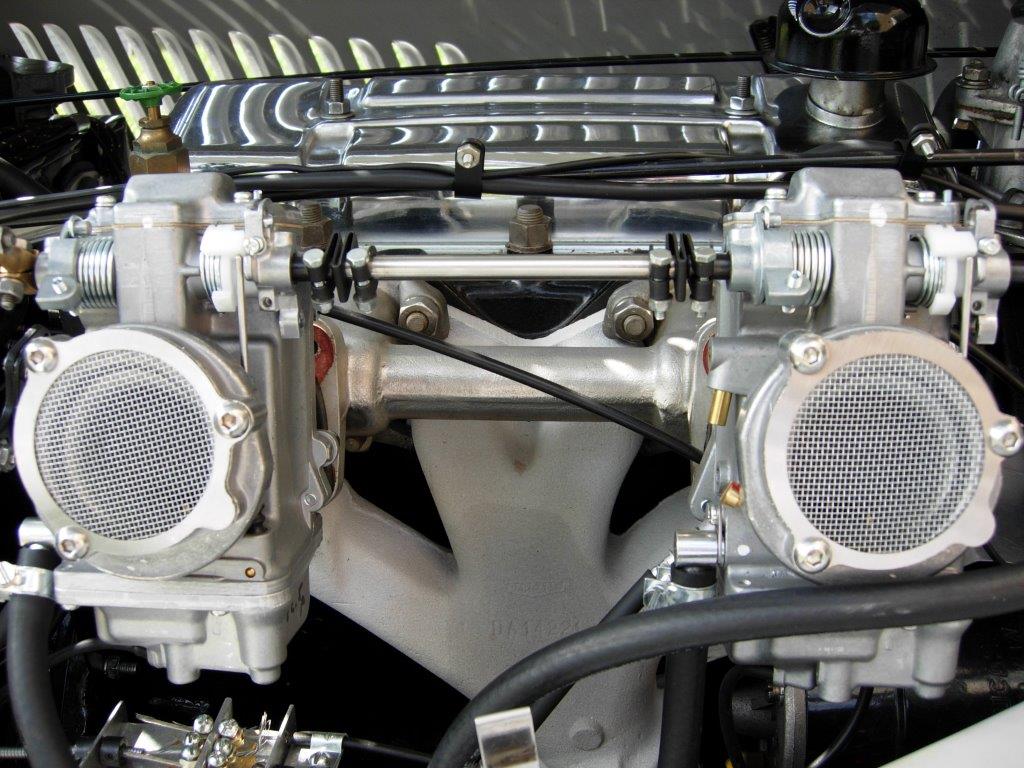 |
|
See an article on the Morgan Mikuni installation here: |
|
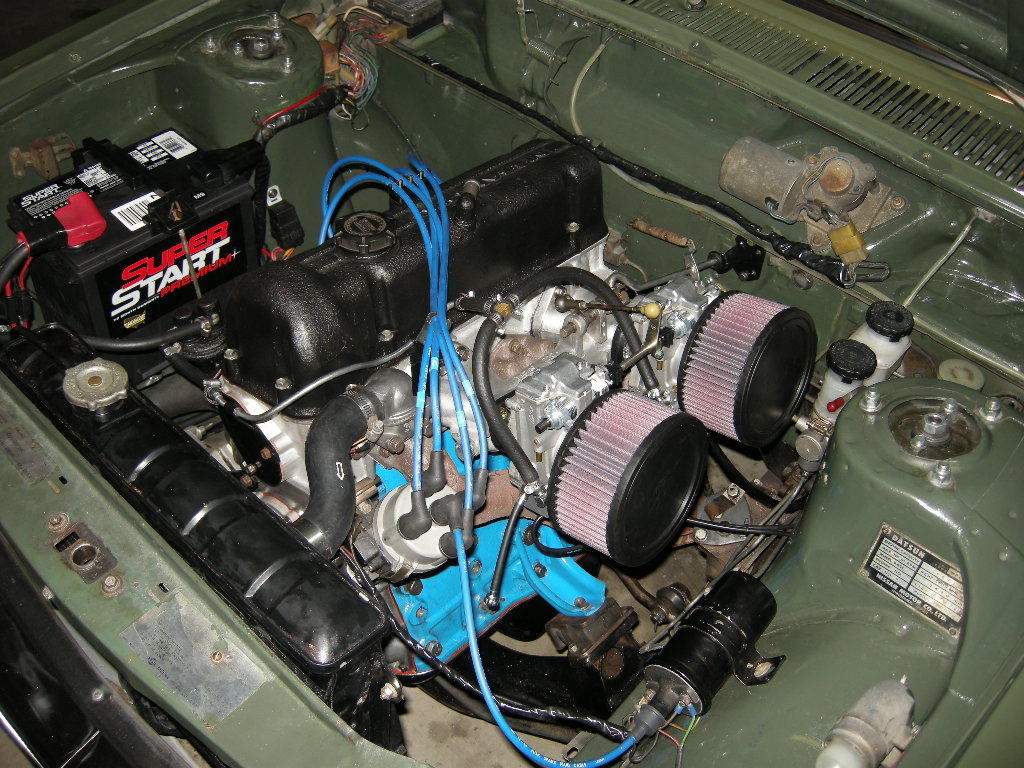 |
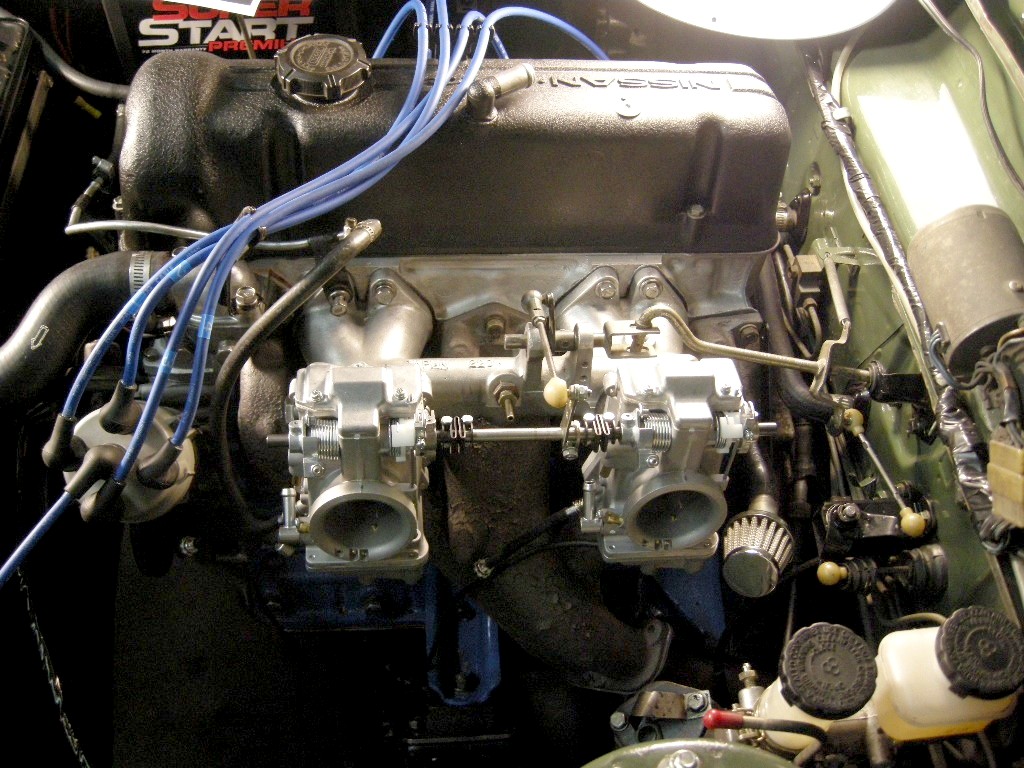 |
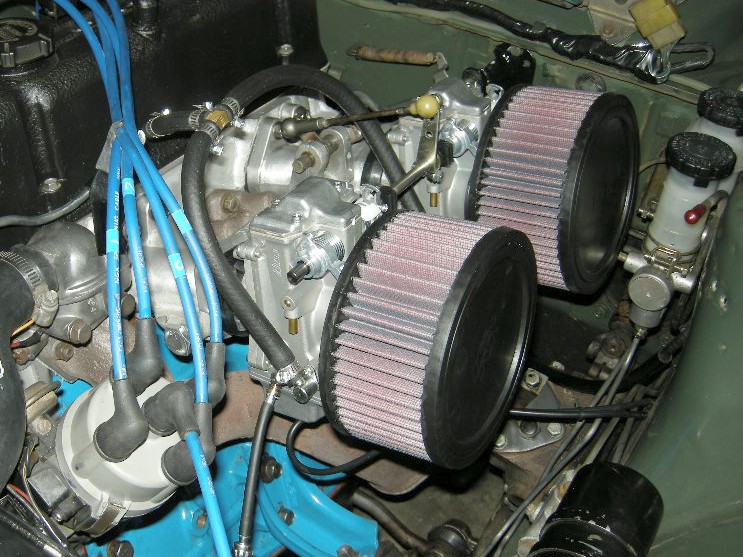 |
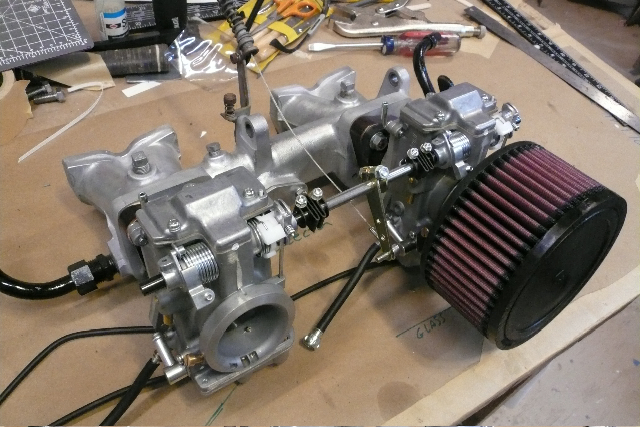 |
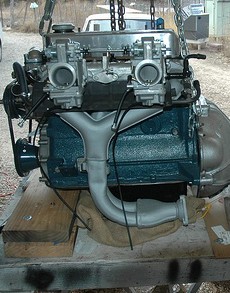 |
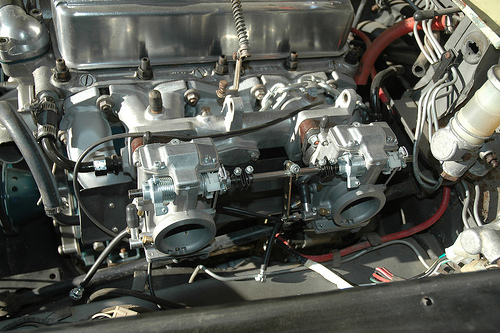 |
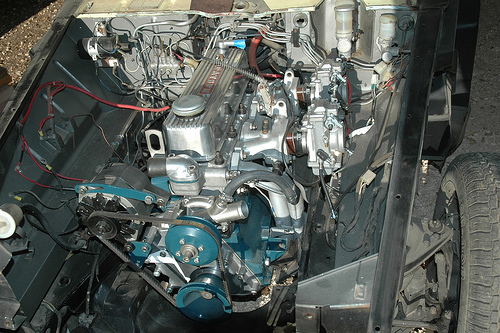 |
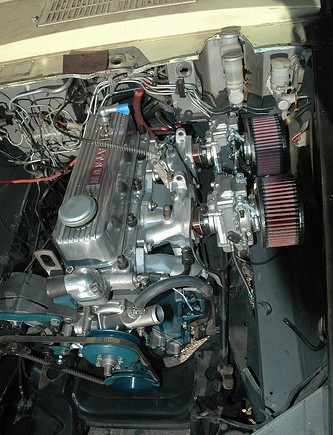 |
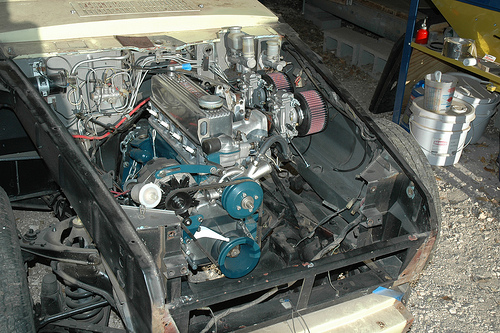 |
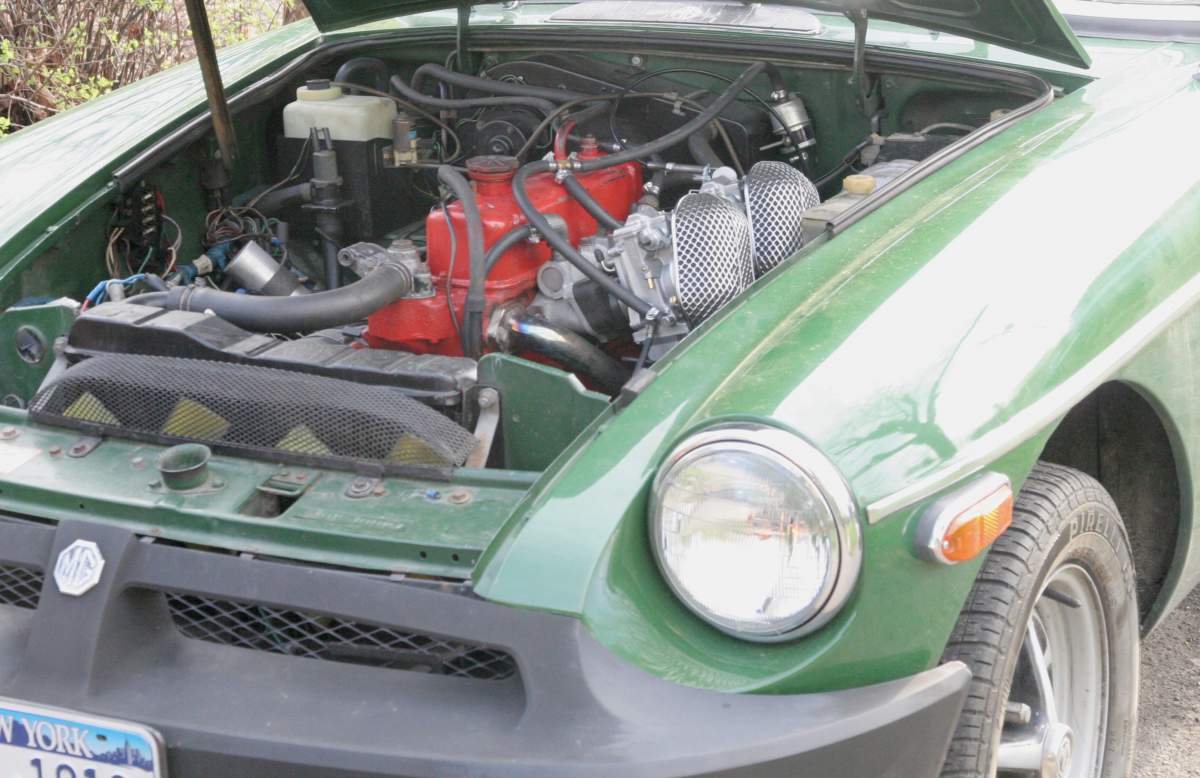 |
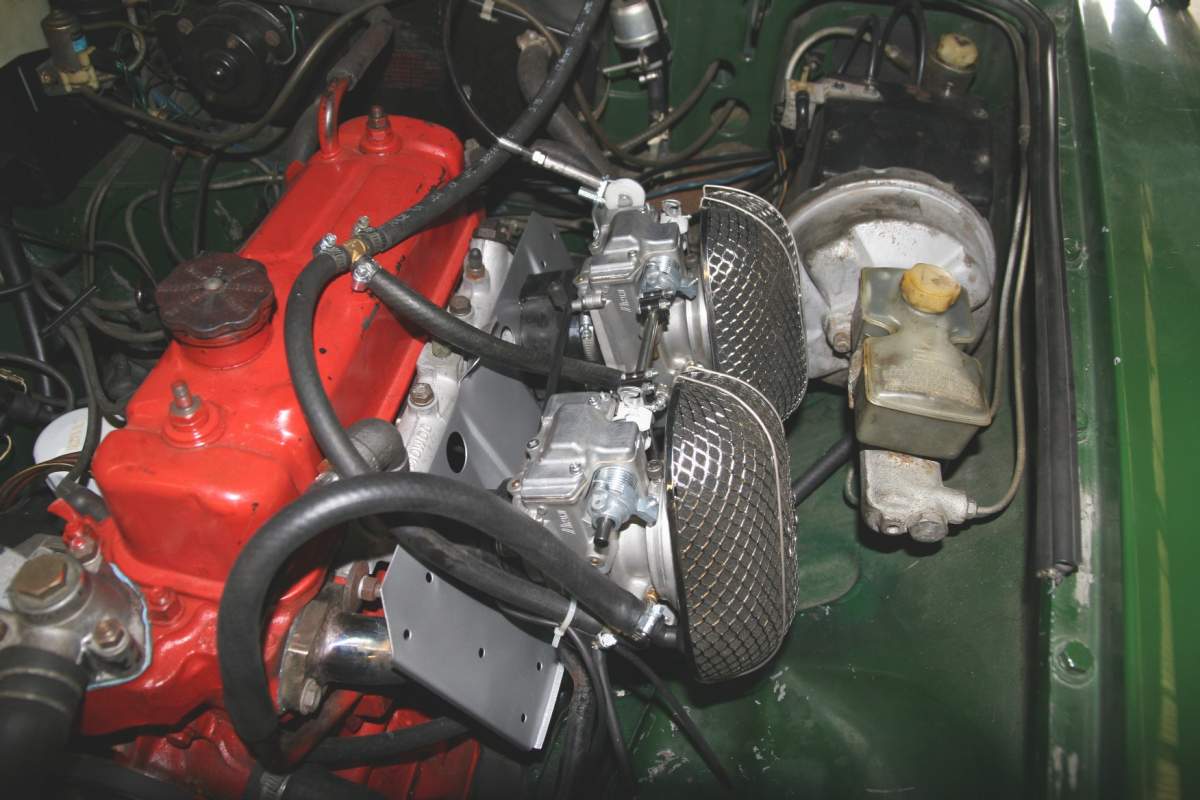 |
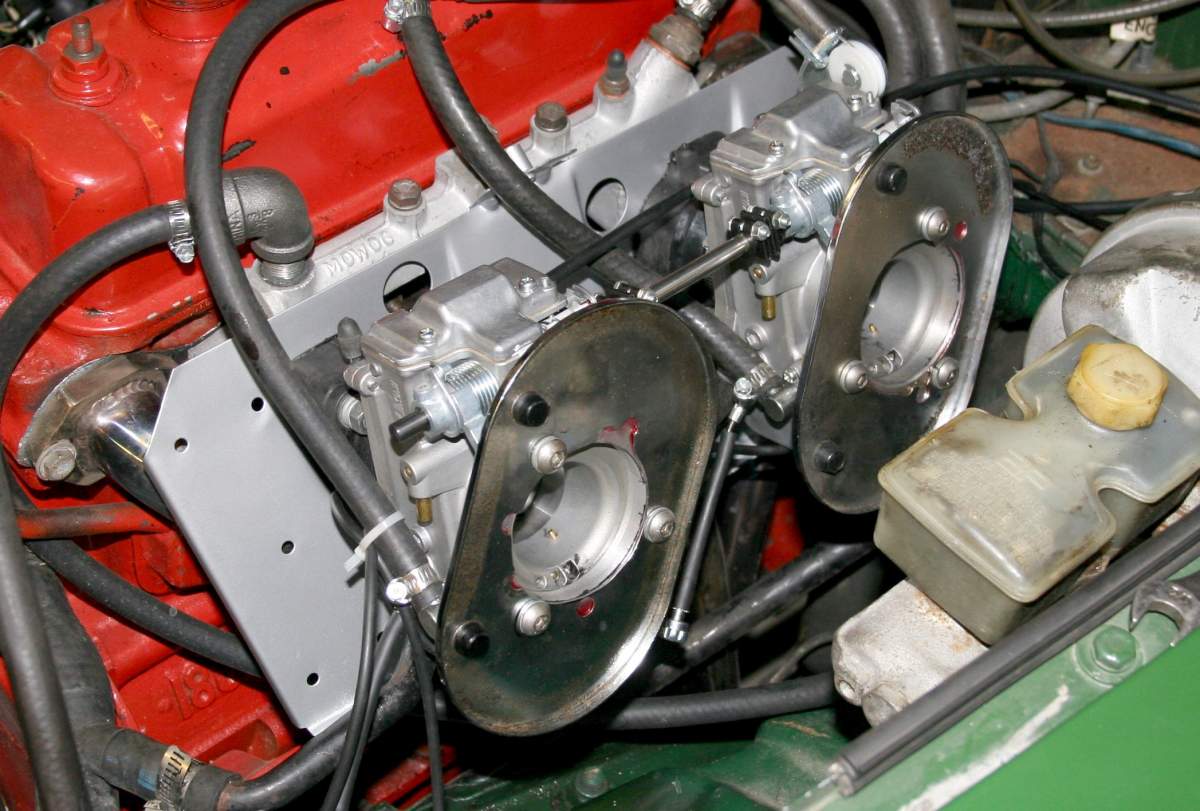 |
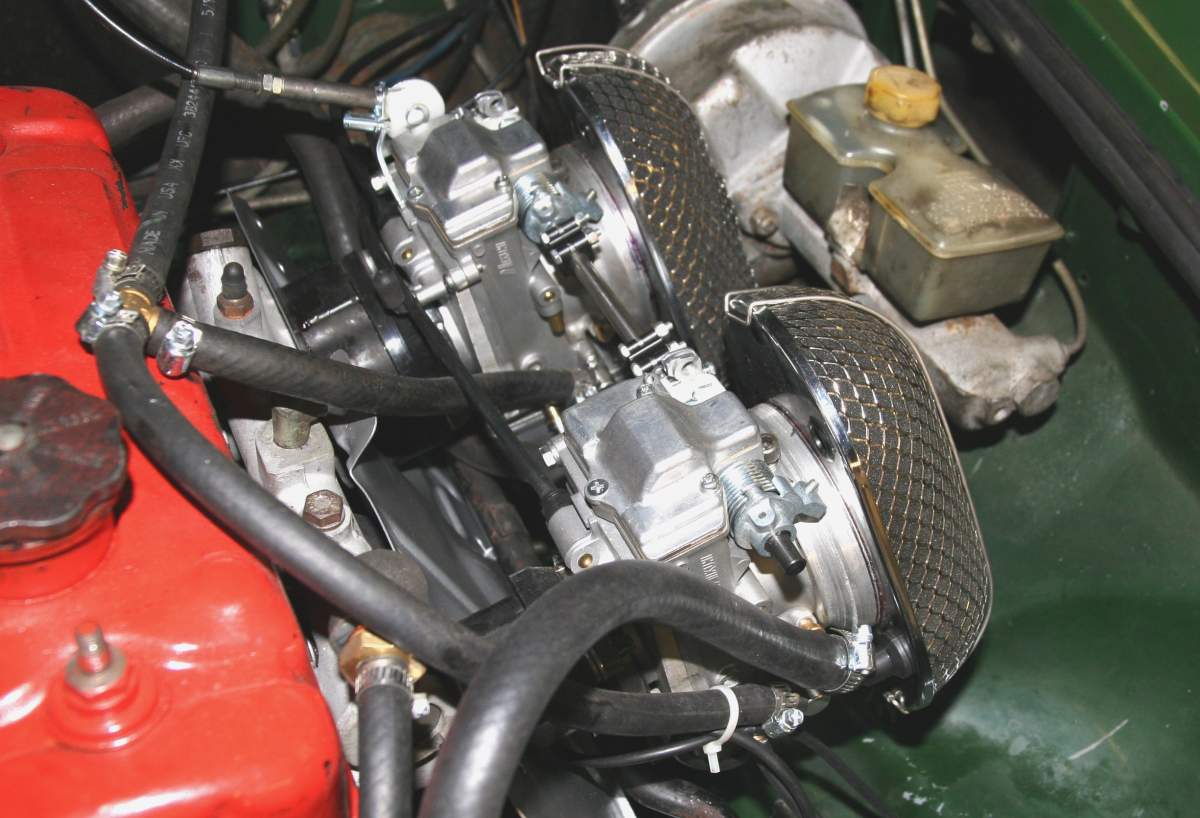 |
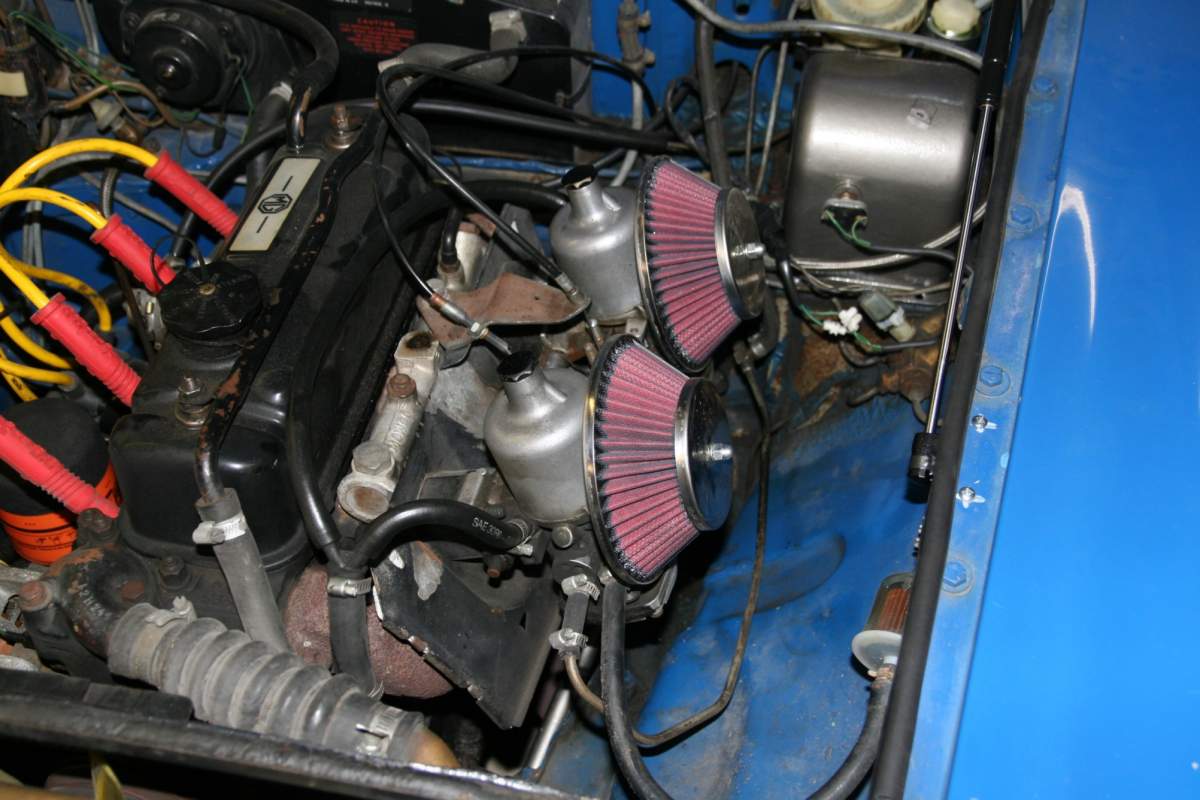 |
|
.jpg) |
.jpg) |
.jpg) |
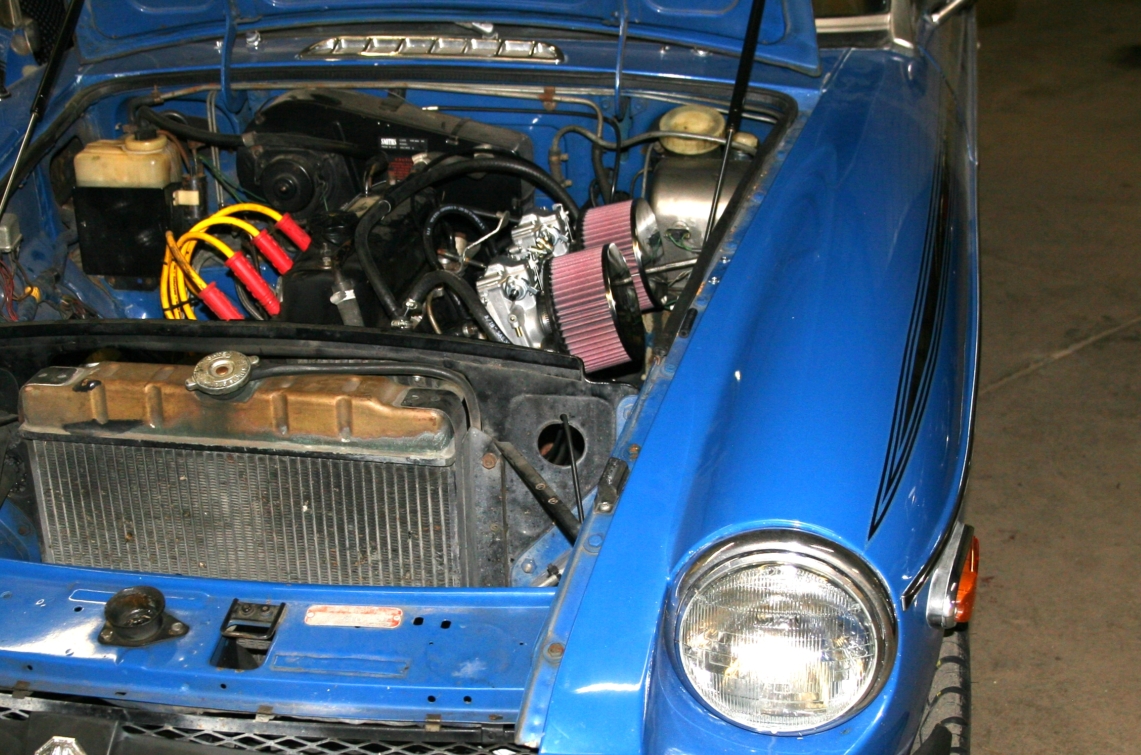 |
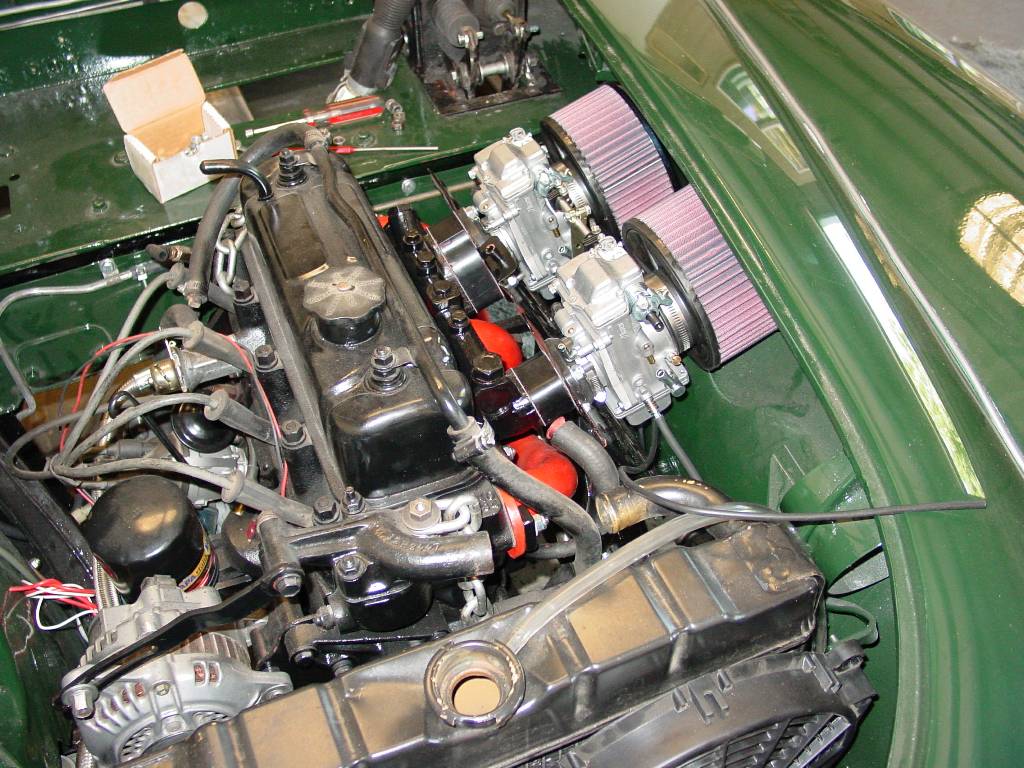 |
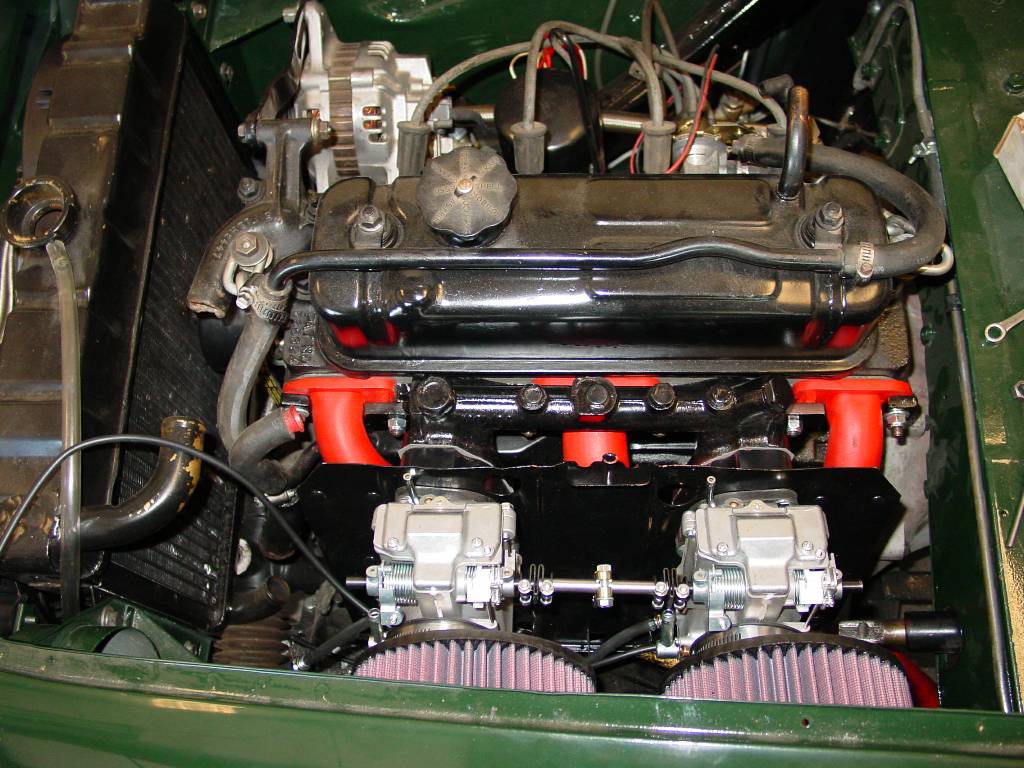 |
|
MGBGT |
Aluminum Cross Flow Head with 45mm Mikunis |
TR4 Installations
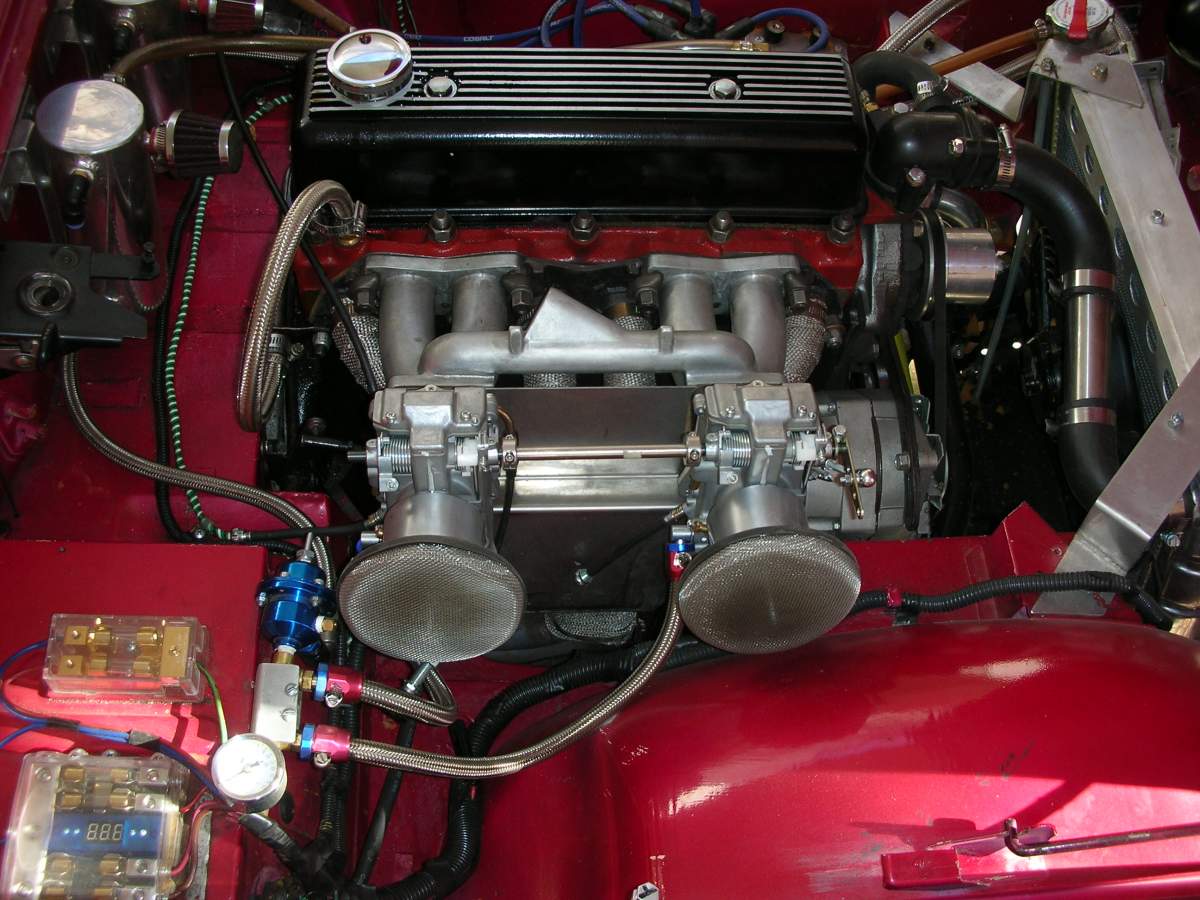 |
.jpg) |
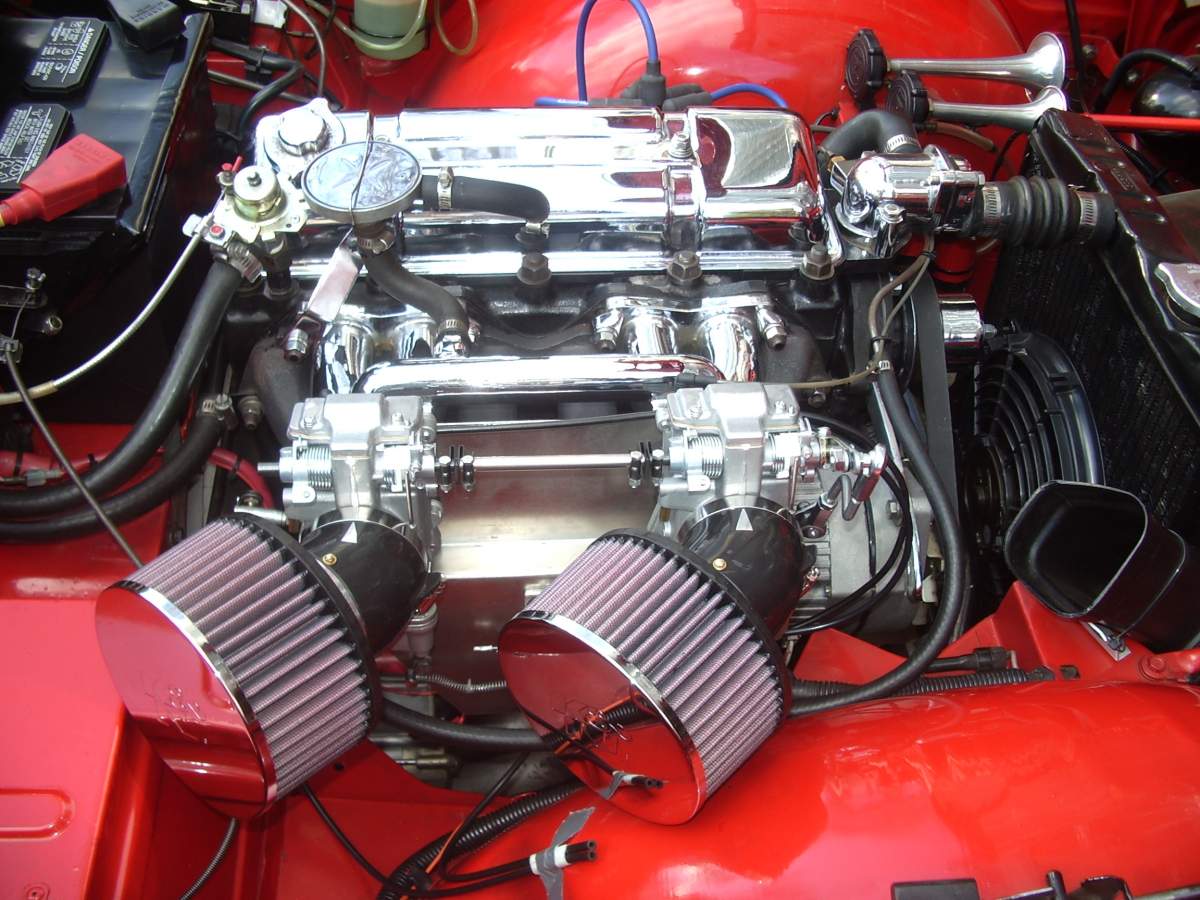 |
|
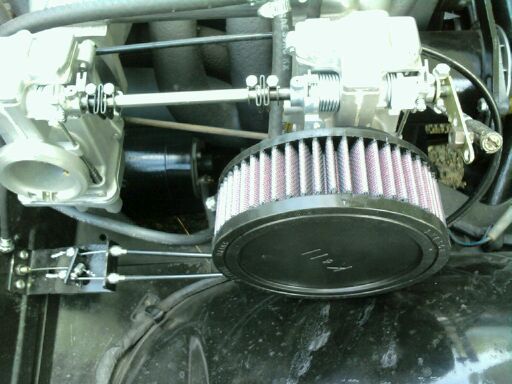 |
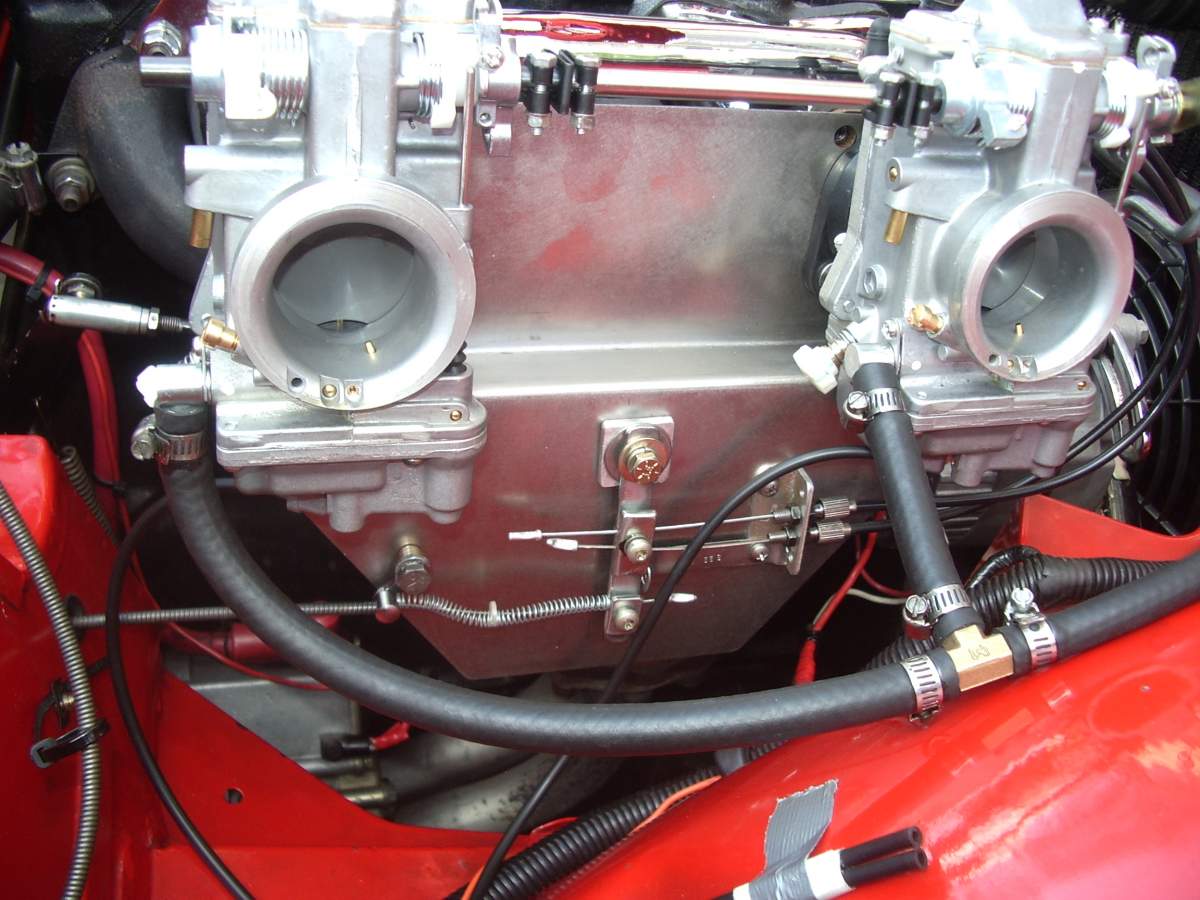 |
Triumph GT6
Triumph TR6
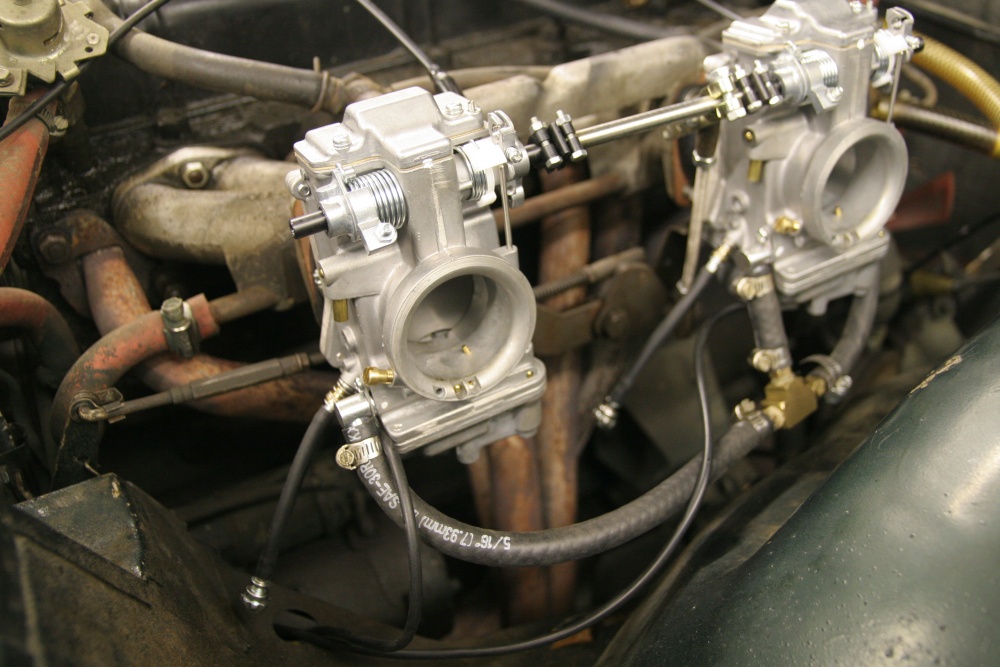 |
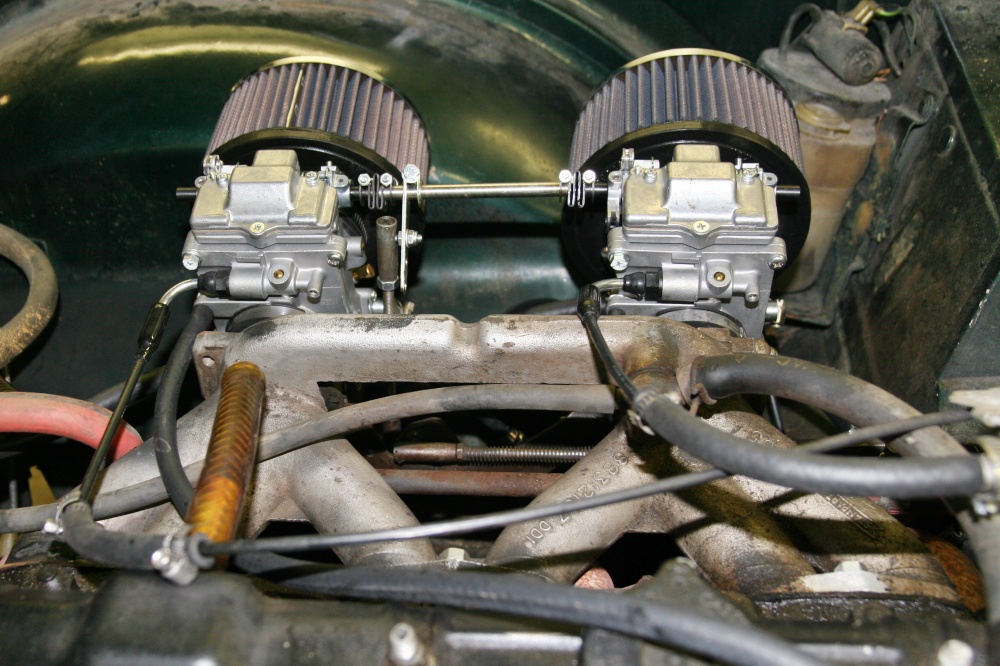 |
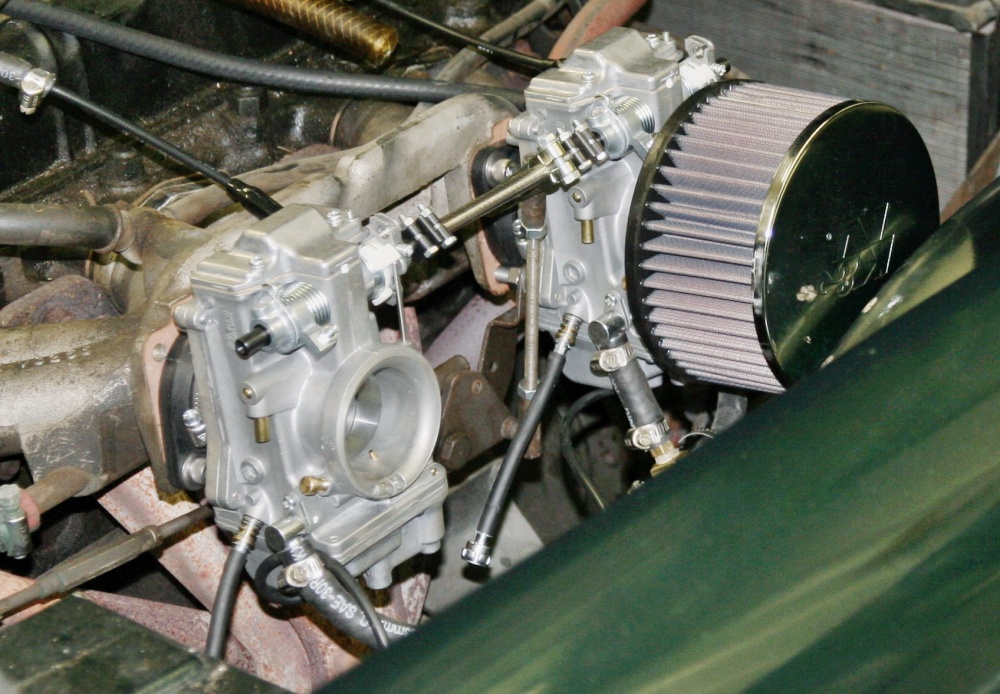 |
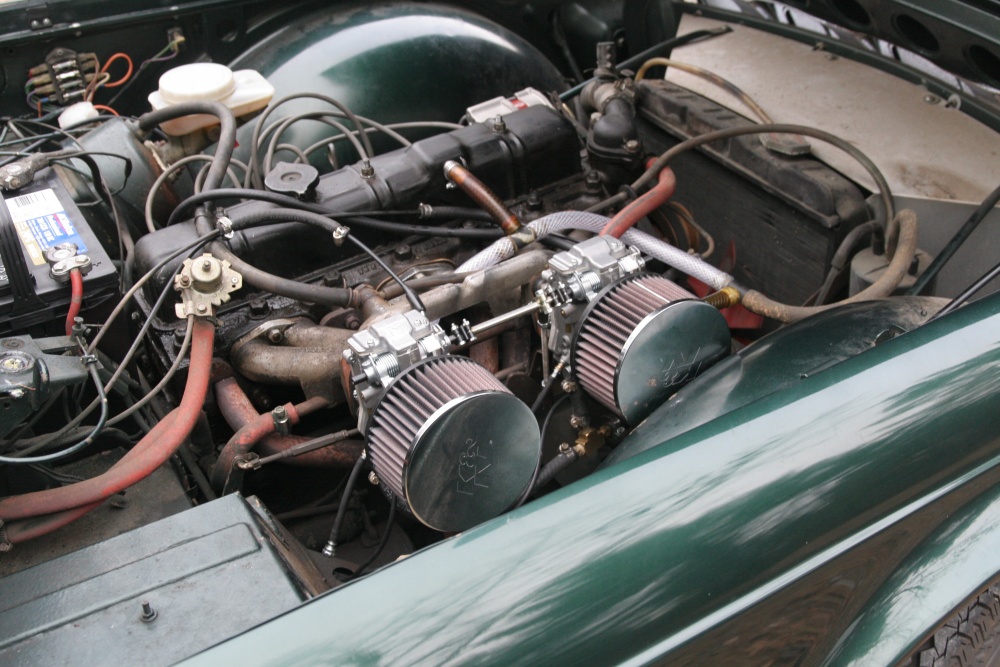 |
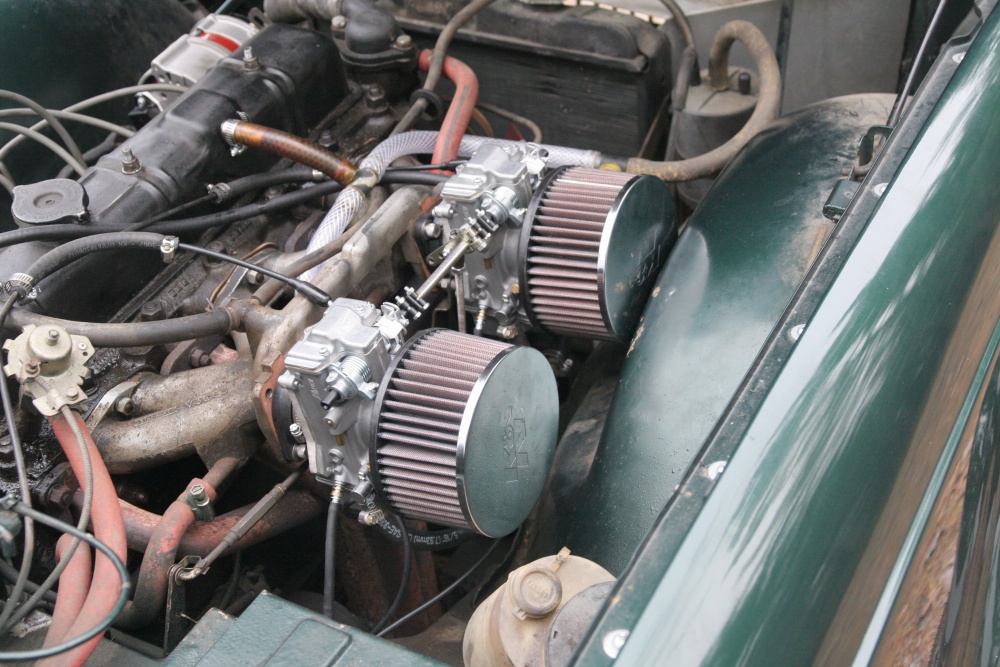 |
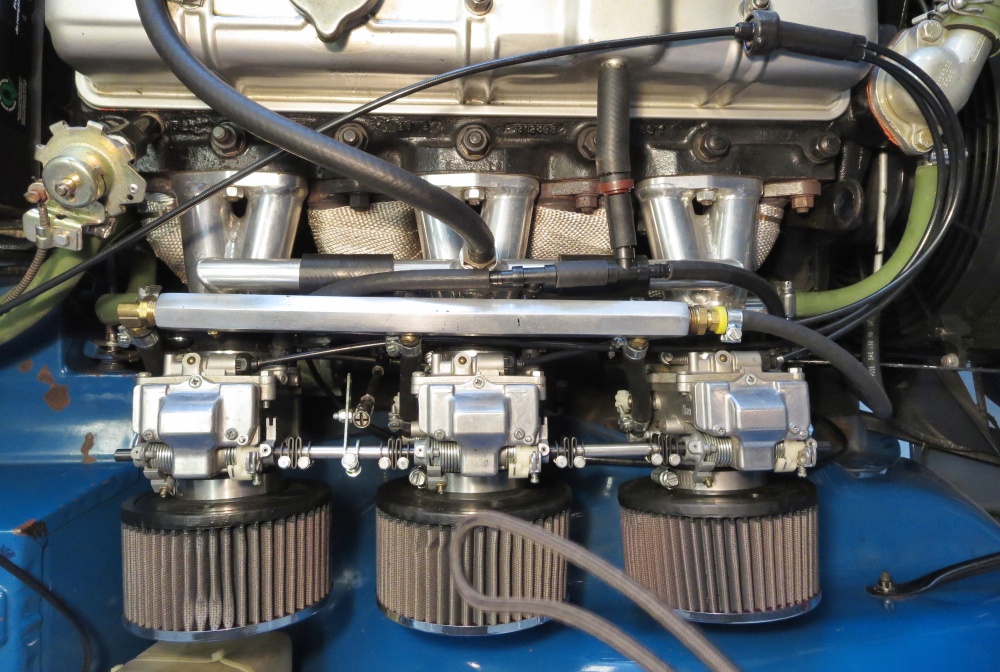 |
Our TR6 system shown in the photos above uses the stock throttle linkage and choke cables with small modifications to both.
Triumph Spitfire - Vintage Racecar
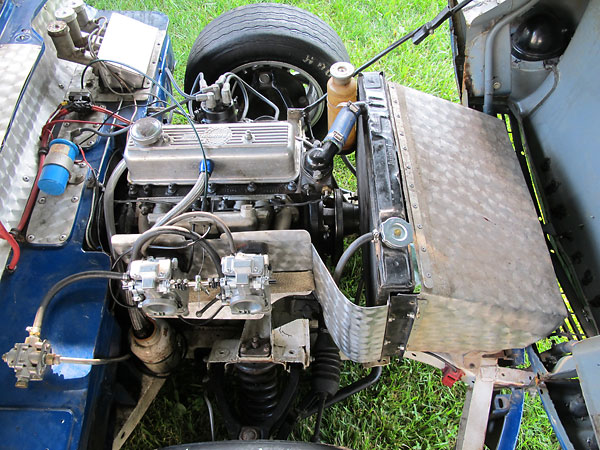 |
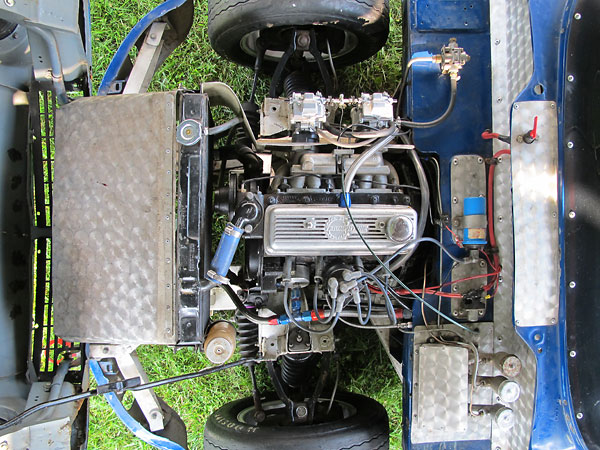 |
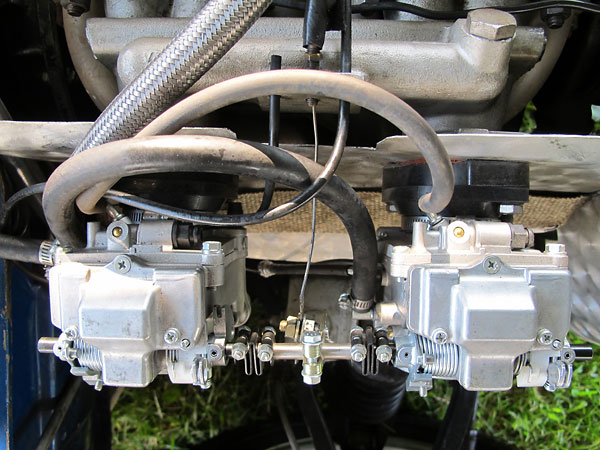 |
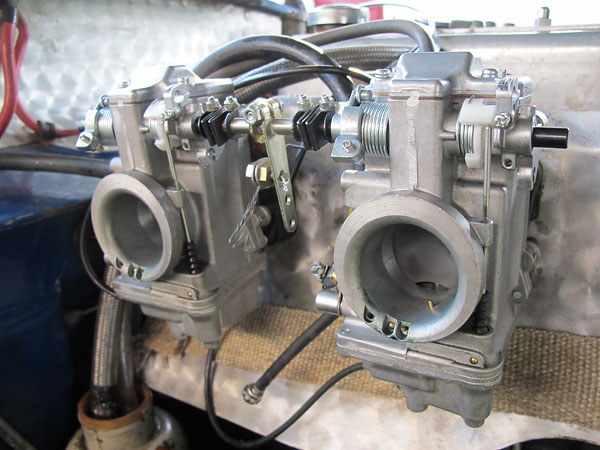 |
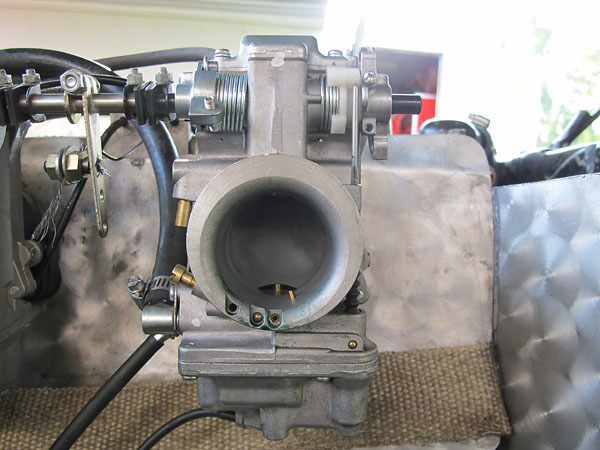 |
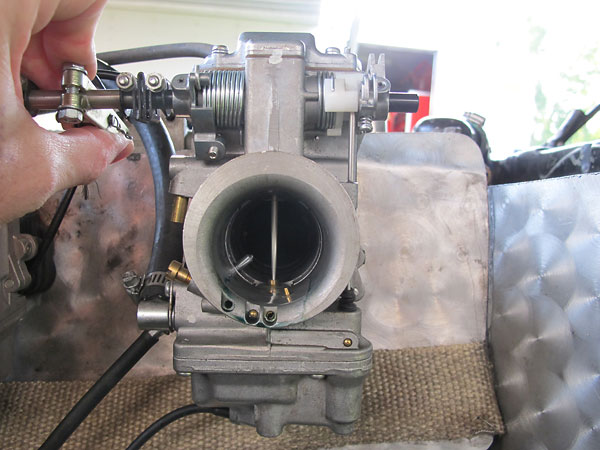 |
See the story on this car and the Mikunis at: http://www.britishracecar.com/RichardBrown-Triumph-Spitfire.htm
And now a photo of a Jag E type installation
See the comments on this installation in the comments section below - 8/21 - James Woolbright
Installations on cars not listed as having documented Mikuni HSR Carb installations.
Comments on MIkuni Carb Installations
1/30/2024 9:29 AM, Adrian Bowles wrote: ( Single Mikuni carb installation on an MG Midget )
Hi John I finally had a chance to drive my 76 Midget with your Mikuni HSR42 conversion kit and all I can say is wow! What a difference. My butt-dyno may not be calibrated but the difference over the Stromberg is amazing. Smooth power delivery - and plenty of it - at all RPMs. I couldn’t stop smiling. Thanks for offering this kit - I plan to install one in my project Midget later this year.
11/21/2023 12:50 PM, Paul Hunter wrote:
>
> Dear John--
Your calls on the jetting and adjustments for my 142 were right on. Runs beautifully, with no hitches or hesitations from idle to wide open throttle. I haven't driven far enough to get the mileage yet, but will see. Turning the two idle jets together at the same time needs to be in your instructions, which proved to be a crucial tip. Thank you, thank you.
>
And have a happy Thanksgiving there.
On 10/5/2023 8:53 PM, Keith Simon wrote:
> Carbs are wonderful, have enjoyed the install.
> Best,
> Keith
On 8/1/2023 3:54 PM, Senga wrote:
> Hello Mr. Parker. The Mikunis and kit I got from you for the 1964 Volvo 544 sport worked wonderful. I would like to order a complete manual choke set up with cables and whatever else is required. It still has the factory splitter located under the dash.
> Also one more quick question. Do you know of a “reliable” mechanical fuel pump. We are on our 3rd one so far and they don’t leak but just don’t seem to last.
> Thank you for your time.
> Ty
On 3/19/2023 10:57 AM, Cameron Pitcairn wrote: ( from the UK about his GT6 )
On 2/24/2023 1:45 PM, Samuel Arant wrote:
On 8/27/2022 8:35 PM, Greg Schnittger wrote:
John,
Dec 20, 2020 at 2:08 PM
Subject: mikuni
To: John Parker <jparker3@twcny.rr.com>
Hello John, just wanted to say i'm very pleased with the mikunis on my volvo 1800. They've got the old thing purring like a kitten and they have definitely boosted hp. I wanted to see if i could buy another choke cable from you if you have one available. I managed to bugger up the longer one in the fan belt before i secured it properly. Let me know.
Jeff
John, I installed the carbs you sent with no issues. They fired up immediately with some choke. I increased the idle adjusters from zero to one half turn and the car idles well and runs like a bandit.. These carbs are terrific! I plan to check the mixture with an air /fuel meter but all seems good for the moment.Best Regards,Brian McCauley
On 9/24/2020 8:34 AM, Brookhouse Volvo Parts wrote:
Quite a few years ago I purchased for you a pair of Mikuni twin carbs for my 1967 Volvo 122S. They have been awesome, but now I need to get a new pair of K&N air filters for them. Can you tell me which K&N air filters you use?
Regards
Simon Richardson
Brookhouse Volvo Parts.
On 8/18/2020 8:15 PM, Brian McCleery wrote: ( TR6 with dual Mikuni 42's )
Running like a top with the points! Might need to shorten the threaded rod about 0.25” to allow the carbs to relax to idle better but awesome! Not a single one.( jet change ). I trusted that you knew your stuff and was not disappointed.
On 6/14/2020 1:07 PM, James Walton wrote:
Finally installed my MGB Mikuni kit last week (photo attached). Really nice improvement..
Most of those British carbs are ported and British Vac argues it is the best way to go. The Zenith Stromberg s are ported. The Hitachi SU's I had were ported. My 76 originally had a vac retard and British Vac came up with a vac advance for it. This is what I was using.
All that aside I want to thank you for the carb's and the set-up. I have had to do very little except raise the main jet one notch. The pilot screw s just needed a quarter turn and adjust idle.
My car was running like crap before so these carbs on my modified engine were the answer without blowing another season of playing what is the best needle with the Hitachi SU's. Paltech who sold me them assured they had the right needle for my engine, etc, etc. I am really glad I spent the money and tried completely different carbs.I had a comment from a couple very long time TR6 owners and found my car the most impressive one they have driven in.So again thank you for your expertise in setting these carbs up. Vac discussions aside I am, really, really grateful. I will send you some under hood pics once I get my air box adapted.The car before would never easily start but with the Mikuni's it was first crank. I couldn't believe it! Thanks😊
5/29/2020 5:15 PM, Dave Luukkonen wrote: ( regarding a dual kit on a '73 MGB )
I finally got to drive the MG with the new Mikuni carbs on it today. I didn’t get enough of a drive taking it just from the garage to the upholstery shop but wow the carbs really seem to work well! I’m gonna have to send you a picture of the choke cable though. I’m not sure I got that right because it doesn’t lock into the receptacle the way I thought it should. It still works great, so it’s not a big deal. I’ll send pictures and maybe a video later; I think the Mikuni‘s are going to be outstanding! Dave luukkonen On 5/27/2020 3:02 PM, David Fallon wrote:
As for the TR-7 is was an EASY install for the carbs. The only thing is I had to go one size larger on the jets. Throttle response is ten times better than the SU’S I had on it when replacing the Stromberg’s. Also get between 22-26 MPG if I keep my foot out of it. I did go with an MSD ign. and headers. The car is still put away from winter however I will get photos on install to you.
I have a TR-6 and a GT-6 also working on. Love this setup!
Dave
5/20/2020 7:17 PM, Paul Slabiak wrote ( regarding a dual Mikuni carb conversion on a 1979 Triumph Spitfire ):
Thanks again, I REALLY LOVE this conversion, and fully intend to order more in the future, as we do a fair amount of webber conversions. (I do not like the webbers).

Paul Slabiak, Project Manager
Classic Auto LEDs & BMC British Automobile, LLC
|
On 1/16/2020 12:14 AM, doctbill wrote:
Re: Mikuni Triple Kit for Holden engine - Australia
|
On 6/5/2019 10:56 AM, Jim Hess wrote regarding his Triple carb TR6 installation ) to tell me that:
I just updated my blog with the Mikuni information.
www.trippstr6.blogspot.com
(There is series of good installation photos there.)
On 6/1/2019 9:00 AM, Larry Berg wrote: ( regarding a Triple carb TR6 installation )
The last install on Gary Stephensons TR6 went quite well and he is very happy.
His first words after pulling out of the drive and onto the street were “This thing could be dangerous”.
Larry Berg
Hi John, Time to send that endorsement letter, now that I have spent some time with the Mikuni set-up. Enclosing letter and some pix. You also asked me to remind you to refund me for the Choke kit that I didn’t need. Thanks again for your help, I am very happy with the change. Letter: To Lotus twin-cam owners thinking about replacing Stromberg carbs; John has made a great update for your Twincam with a Stromberg head. The Mikuni conversion requires no modifications to the engine; just swap out the carbs, hook up to existing throttle and choke cables, some basic tuning, and you will see a real improvement in drivability and performance. If you are looking to replace the Stromberg carbs, this is a fantastic alternative to an expensive Weber-head conversion. I have had my Europa for 45 years, and rebuilt the carbs twice, before deciding to try the Mikunis. I have driven Lotus Twincams with Stromberg and Weber heads, and the Mikuni-Stromberg combination feels somewhere in between, for a reasonable price. The Mikunis are a real improvement, and the work John has done preparing the carbs makes for an easy installation. Thank you John. Robert Schefman 1974 Lotus Europa Special
On 8/4/2018 5:56 PM, Andy Pitman wrote from the UK:
Hi. It’s been a long time past since you sent me the Mikuni carbs for my triumph tr3a, The restoration of the car is know complete and the car is now on the road. As promised I can now let you know how I got on, fitting the carbs was very easy and they really look the part, As you said the engine should start and run without any alterations to settings and that is exactly what happened even to the point that I have only adjusted the tick over and that’s all I’ve had to do. The car runs like a dream , it accelerates like a scolded cat and has bags of low end torque which surprises me as I have fitted a fast road cam and usually you would have to get the revs up to start to feel any power. If you ever need someone to recommend you and your product please feel free to contact me. Yours faithfully. Andy Pitman.
John, I finally solved my niggling miss problem, it was an intermittent leak of the vacuum advance. It was a misinformed casting. The car is running beautifully, much more power. We skipped spring weather this year so I plan to do the final Dyno in the fall. Too hot and humid in the Missouri Ozarks for a summer test. The choke system you had made is a thing of beauty, makes the car much more drivable. Thanks, Fred
|
3/22/2018 11:45 AM, Ron Camillone wrote: 5/21/20 update: We never had to change the jets, it worked perfect the way you shipped it.
Still running great.
|
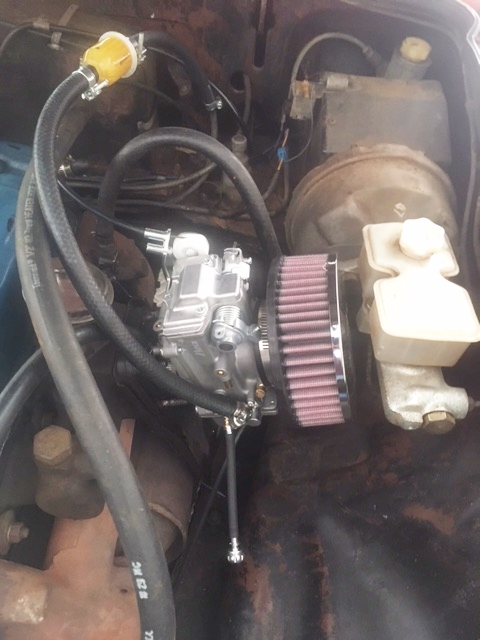 |
2/3/2018 2:27 AM, Stephen Wood wrote: ( from New Zealand )
Hi John
The conversion is now all complete and the MGB is going very well.
Early December we did a 4 day trip to Northlands and all went well.
The fuel economy worked out at 10lL per 100Km over the long trip, pretty happy with that.
I followed nearly all of the installation instructions and it all went well.
Once we got the timing correct tuning was really easy.
I’ve done about 2000km since and it’s been a total joy to drive every km.
There was quite a lot of interest in the Auckland MG car club with comments like Why!! and where can I get a pair.
http://www.mgclub.org.nz/tools/gallery/photos.aspx?SECT=Far-North-2017
Regards,
Stephen Wood
--------------------------------------------------------------------------------------------------------------------------------
5/22/2017 1:41 PM, Fred Ford wrote about his triple 42 Mikuni on a TR6 ( we had been emailing back and forth about a midrange rpm miss and whether it was related to carb tuning or igniition):
Success! You were right, it was ignition, new coil and reset of the dwell and the miss is gone. I couldn’t be happier with the carbs and set up. I will let you know the final dyno numbers. I do want a choke bracket and set up for my triple Mikuni set up. I will call with payment. Thanks. f
------------------------------------------------------------------------------------------------------------------------------
Carbs installed. Runs great much better response then the SU carbs.Air cleaner took some modifications .Thanks for getting them to me so fast.Jerry Derrick--------------------------------------------------------------------------------------------------------------------------------------------------------------
4/9/2017 2:20 PM,Tom Butkovich wrote about his recent TR6 dual Mikuni installation:
John,
Just finished the install on the mikuni’s and damn, what a difference. This car runs like it just grew another cylinder.
You had these things dialed in near perfect and the plugs are beautiful. Just some minor tweaking and I’m home. Thanks again for your help.
Tom
And on 4/13 Tom wrote:
All good on my end with the choke setup, just modified some cables and used a splitter and adjusters. I attached a few pics.
All works fine and the instant throttle response I get with these carbs is awesome. Looking forward to the distributor and I’ll let you know how she works out.
Thanks again. Tom
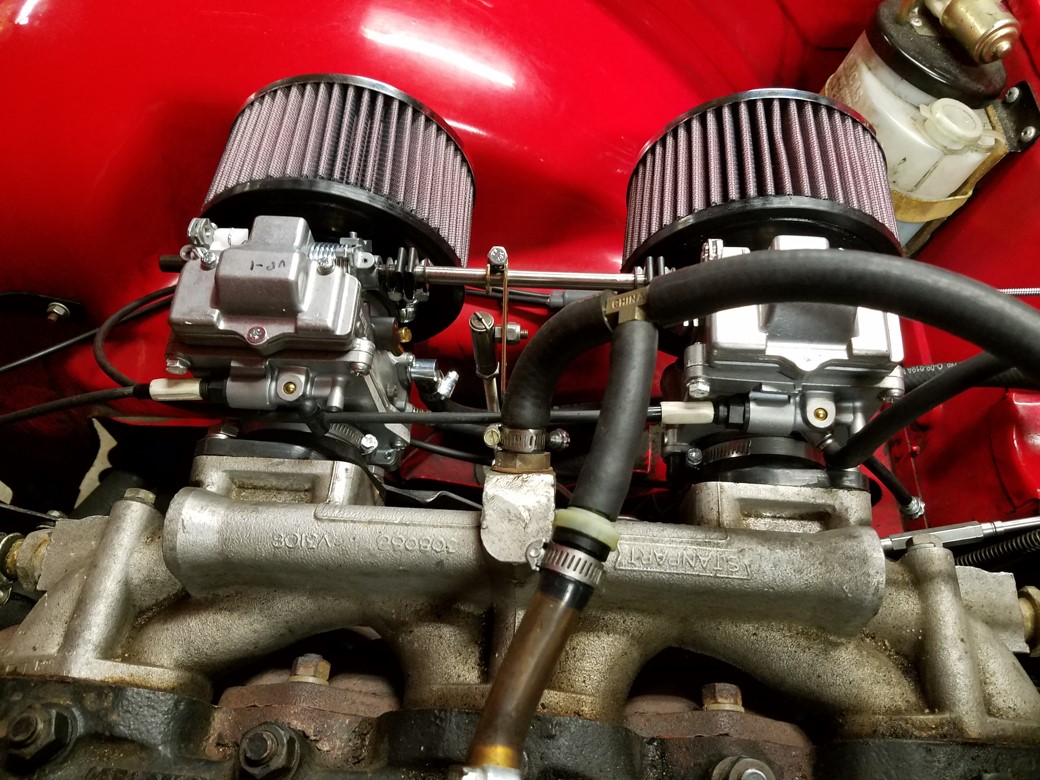 |
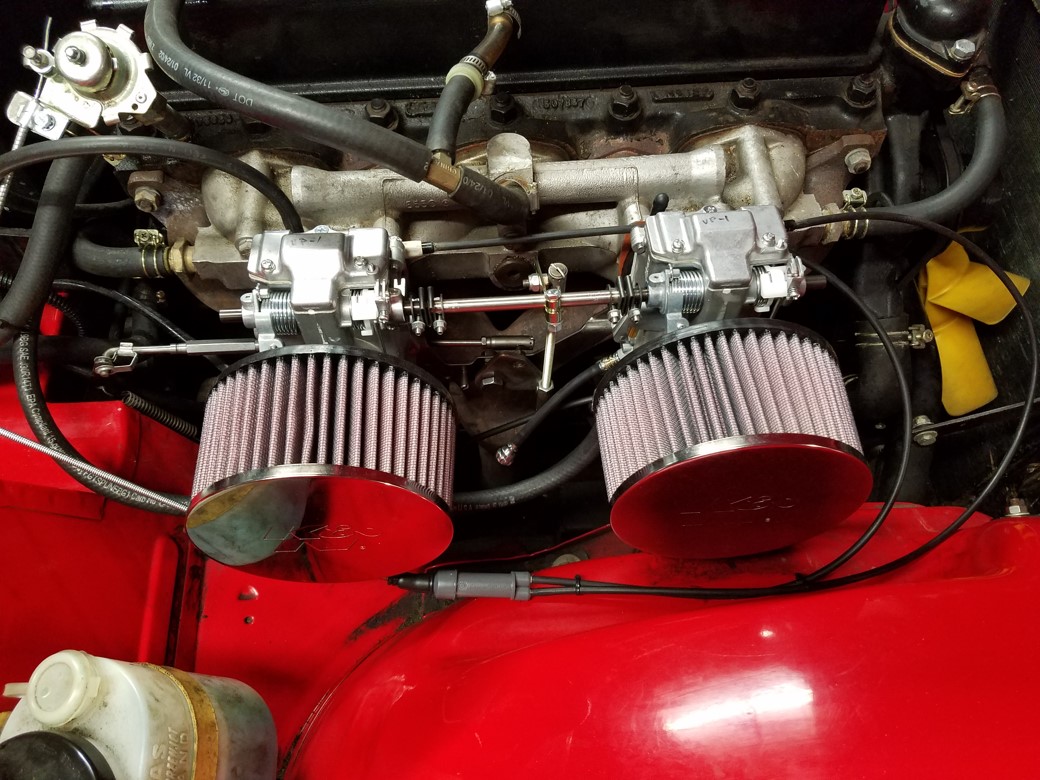 |
----------------------------------------------------------------------------------------------------------------------------------------------------------------
A followup on the Jag E -type installation from 2014 shown in the photo above.
2/19/2017 10:16 AM, James Woolbright wrote:
James
----------------------------------------------------------------------------------------------------------------------------------------------------------------
Hi John,
Andy Thomlinson
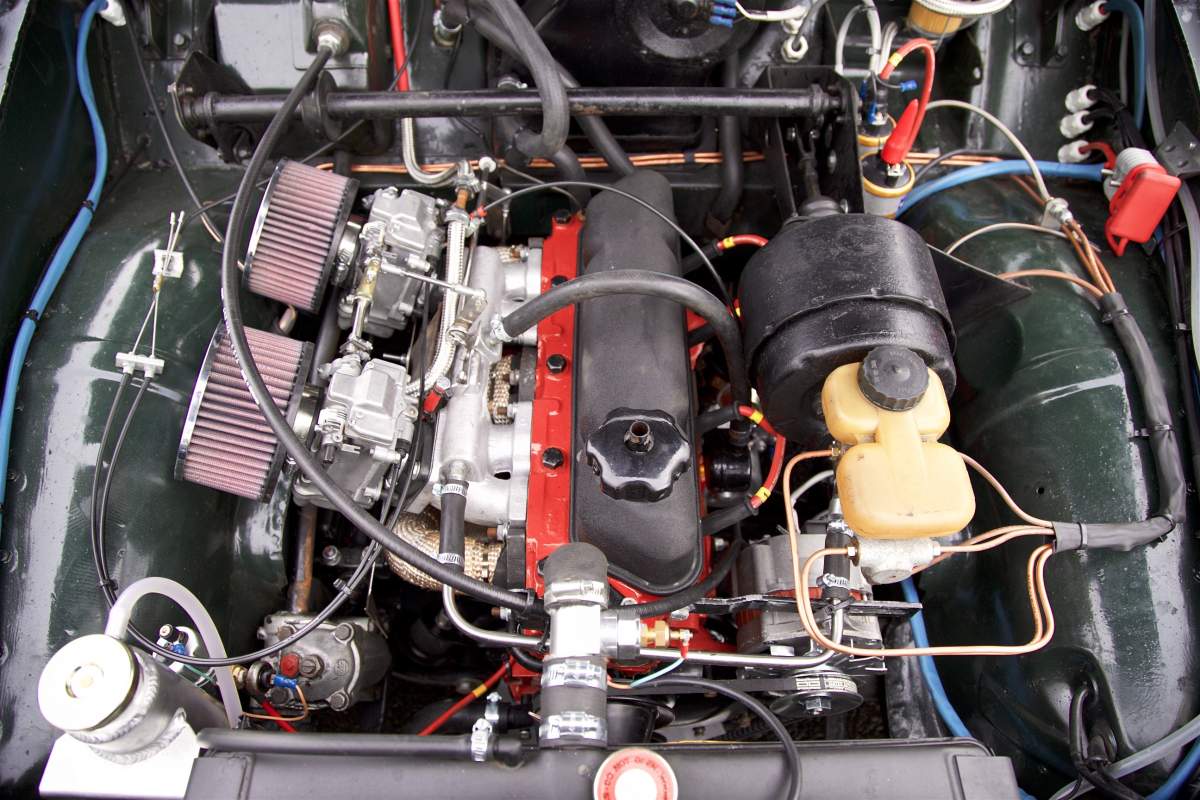 |
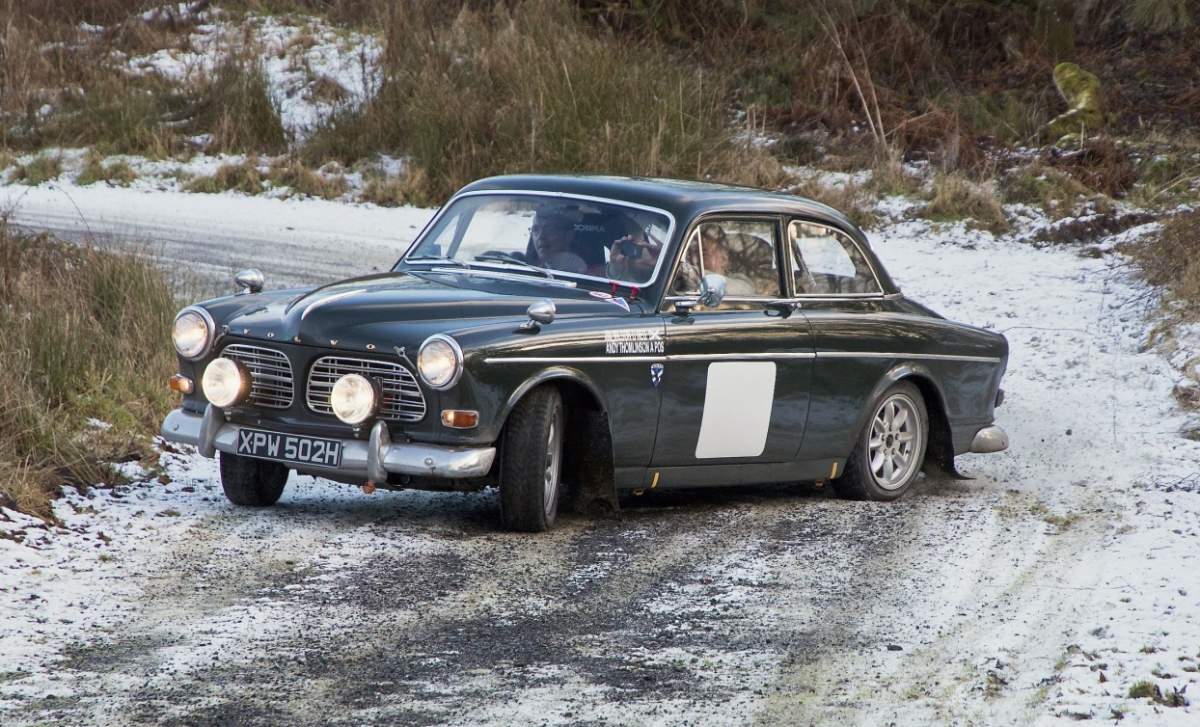 |
---------------------------------------------------------------------------------------------------------------------------------------------------------------------------------------------------
On 4/20/2016 4:05 PM, Dan Borg (TCI) wrote about his 1800 Mikuni installation:
Hi John,
Love the Mikuni’s on the car!!!
Regards, Daniel C. Borg
----------------------------------------------------------------------------------------------------------------------------------------------------------
On 4/12/2016 11:13 PM, Jonny Wonderland wrote:
The carbs absolutely transformed the MGB.
Even did a bit of a video on installing them.
https://www.youtube.com/watch?v=30bXQr4oGmI
Cheers!
----------------------------------------------------------------------------------------------------------------------------------------------------------------------------------
On 4/5/2016 1:54 AM, Urs Umbricht wrote ( from Switzerland ) about his Sunbeam Alpine Dual Mikuni installation:
Hi John,
Thanks a lot for your e-mail and for asking how the Mikunis are working in the Sunbeam.Everything is top cool, the carbs work now perfectly and I love to hear’em breathing.
I first had some troubles installing them because my sunbeam had a different (straight) carburetor adaptor than the one you had in the pictures on your website and hence the Mikis did not fit at first. A club friend had a spare curved inlet adaptor ( MK V manifold ) and the rest of the installation was pretty easy as all parts fitted perfectly.
The car is now much quicker on the throttle, much faster action/reaction and much better acceleration, plus less gasoline consumption over all. All in all, super happy happy happy!
But the best is the sound! The Sunbeam - Guys where interested, but as always there are the originality fanatics and the cool boys who find such improvements great.
Cheerio & have a great day
Urs & Sidna Umbricht
On 2/24/2016 4:19 PM, Ron Miller wrote regarding his Spitfire 1500 single carb installation:
All in all I think the Mikuni is fantastic and a quantum leap from the Zenith Stromberg .
Ron
Weber Carbs
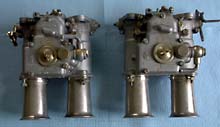 Dual side draft DCOE Weber carbs - the classic performance and racing carb for vintage sportscars. Available used and new, in 40, 42, 45 and 48 mm sizes and can be set up for specific applications and matched to manifolds, porting, cam, etc. Linkage and air filter kits also available. We are not a traditional "dealer" of these carbs and cannot match discount pricing - but with a purchase from us you get advice and help with setup and tuning that can be "pricless". Discount dealers send you the carbs in a box, with the same jetting no matter what the application is, usually with the cheapest manifolds and linkage available, and let you figure out how to make it work.
Dual side draft DCOE Weber carbs - the classic performance and racing carb for vintage sportscars. Available used and new, in 40, 42, 45 and 48 mm sizes and can be set up for specific applications and matched to manifolds, porting, cam, etc. Linkage and air filter kits also available. We are not a traditional "dealer" of these carbs and cannot match discount pricing - but with a purchase from us you get advice and help with setup and tuning that can be "pricless". Discount dealers send you the carbs in a box, with the same jetting no matter what the application is, usually with the cheapest manifolds and linkage available, and let you figure out how to make it work.
These carbs are still the standard for vintage racing, though the Mikunis described above are now a better choice for street use and racing where a period correct carb is not required. Production of Weber carbs has been intermittent in the last few years ( as has quality ) but they are now available again, including the newer type 152 - 45 DCOE - $835 a pair , and the classic and hard to find classic Type 9 - 45 DCOE - $935 a pair . Email for current pricing on other sizes.
.jpg)
Intake Manifolds
Manifolds for sidedraft - DCOE type carbs
Available forVolvo B18, B20, B21, B23, B230 engines. These are copies of the original, no longer available, R- Sport manifold . They should not be confused with the cheap, shorty manifolds usually offered in Weber kits that have flow restrictions due to their short length and comparatively tight bends. In a recent dyno test we gained 12 HP by switching from the commonly sold “shorties” to our longer manifolds. With the longer manifolds and suitable air filters, the inner fender on certain models - 1800 & 122 - may have to be modified for clearnace. These are the best flowing manifolds available, but usually need some casting cleanup. See installation photos.
Recommended for all installations with Weber DCOE type carbs ( and similar sidedrafts ) and our Quad Mikuni System. Mandatory for racing, rallying and large displacement engines $355 - includes soft mounts. Modified for the type of linkage we prefer as shown in the photo in the Weber Carb section immediately above - $395
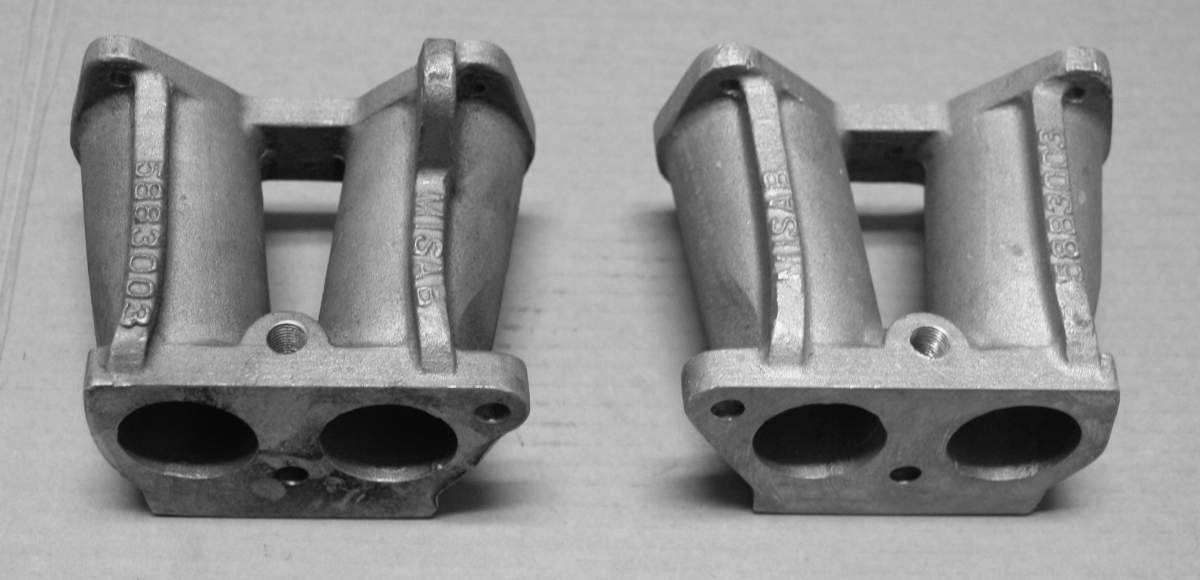
SU intake manifolds
These are the original aluminum intakes used on the early dual SU carbed Volvos and are preferred over the new castings. Provides a significant improvement over the later cast iron combination intake and exhaust manifolds. Shown on the left with linkage bracket and our Mikuni carburetor adapters. These are all used manifolds. Bead blasted and ceramic coated they look new. Getting hard to find so when stock is low we may have to limit sales of these to customers who are also purchasing carb kits. The earlier castings do not have the center port as in the photo below, but can be connected through a port at the end of the manifold.
Silver ceramic coated aluminum - $155 - not currently available
Uncoated in used "as is" condition - $100 Cleaned up to bare casting - $125 ( looks like a new casting and flows better than the new castings)
New aluminum SU type Volvo b18/b20 intake manifolds now available -$125 . These can be used with our Mikuni Carb Kits when the originals are not available. They come as bare castings, as in the photo below, without linkage brackets and other fittings which are shown in the photos of the original manifolds below. Some cleanup of the ports is usually required to improve flow which is why I prefer the original castings.
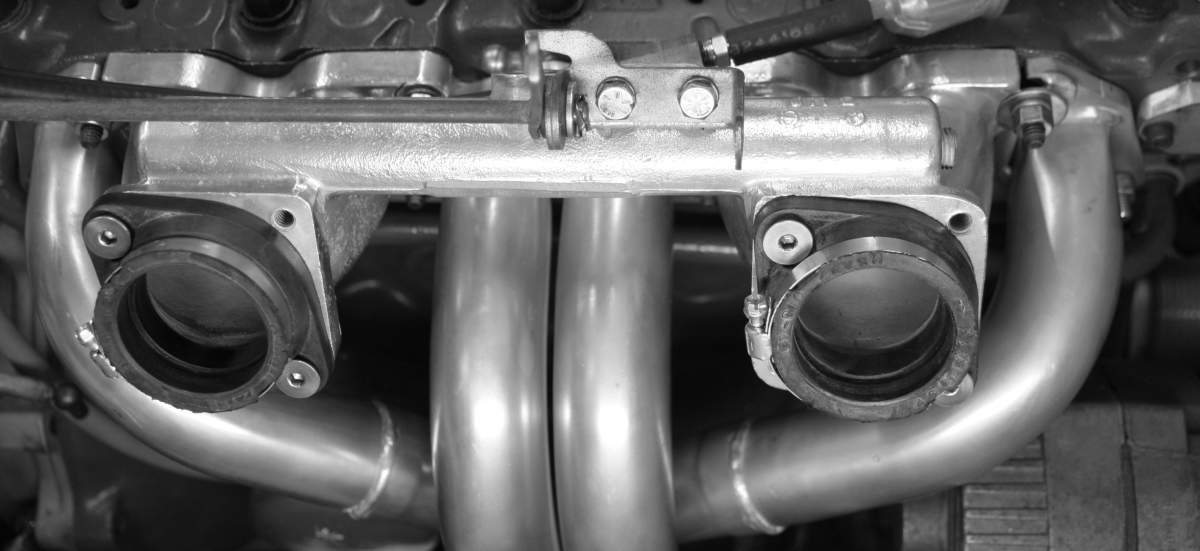 |
.jpg) |
And for those who would like to mount dual Mikjuni carbs on a B21, B23, or B230, we have found that the Volvo Penta AQ 140 manifold will work. Not in stock, but available used if you can find one.
Linkage
Throttle Linkage Lever Arms - Top quality, custom made, machined aluminum throttle linkage arms for Weber sidedraft and other similar carbs - $ 33 each. Email or call for prices and availability of other linkage components including custom made, braided stainless steel throttle cables.
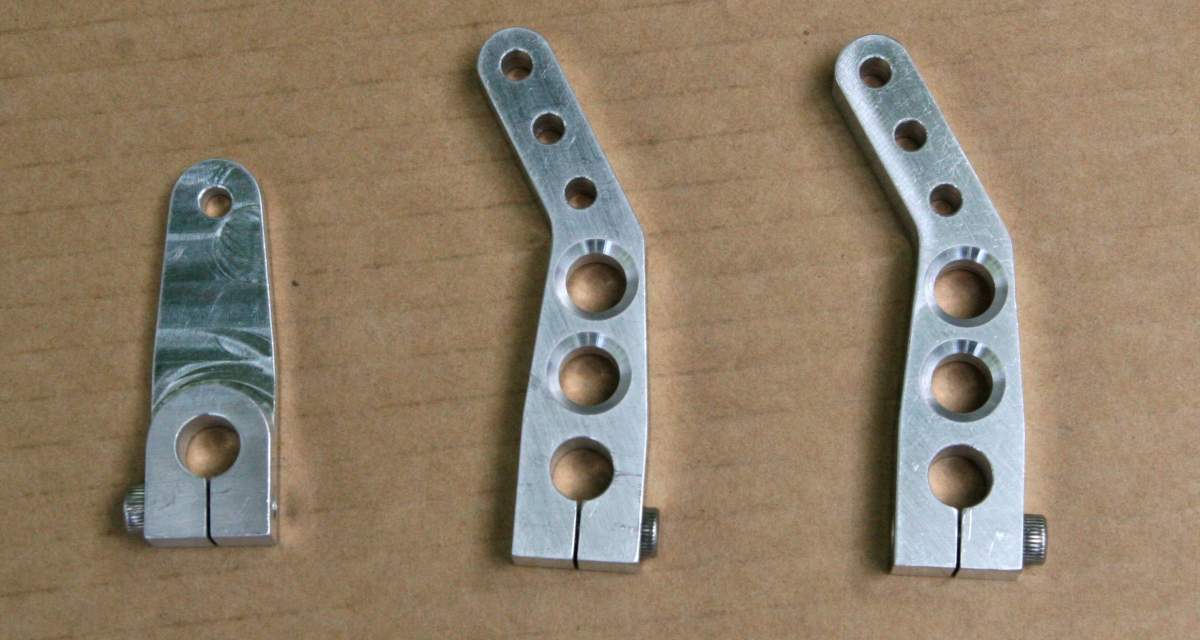 |
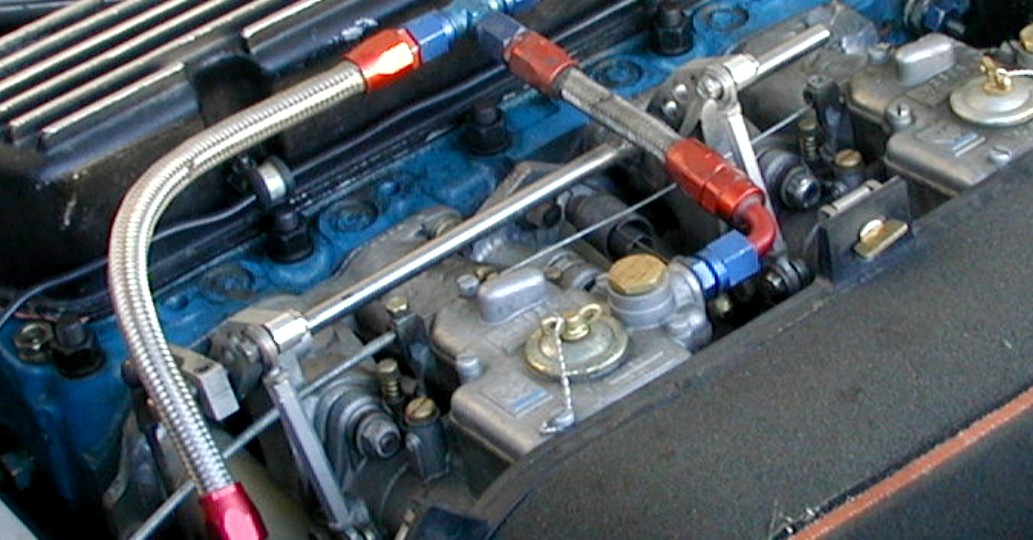 |
Air Horns
Full radius aluminum air horns - in several lengths for Weber DCOE, DCO and similar type carbs. Lengths start at 35 mm and go up from there. Prices start at $ 62 for the short ones for 45 DCOE carbs and $78 for the short ones for DCO carbs. Prices go up a small amount for the longer ones.
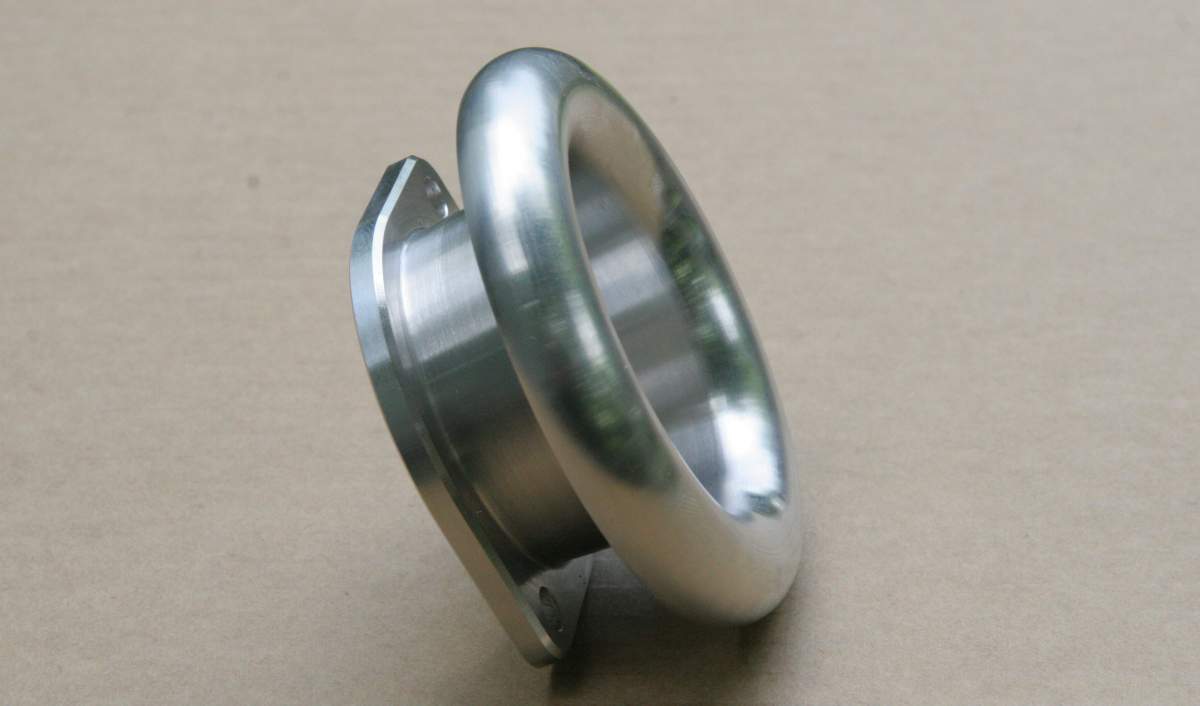 |
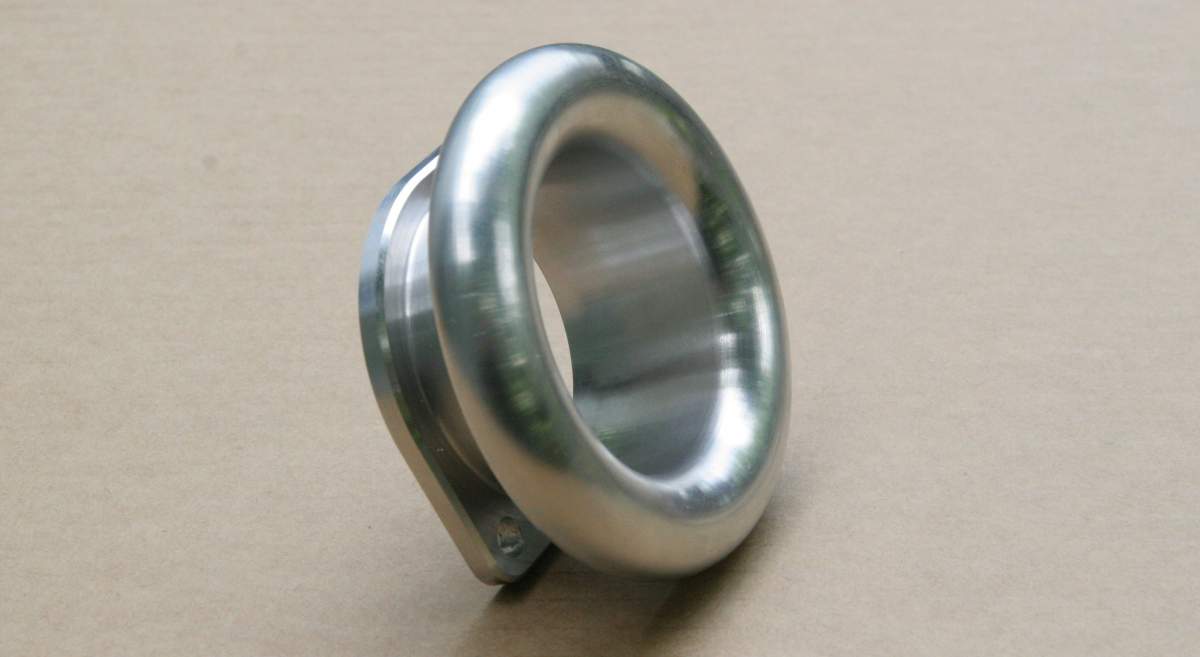 |
The air horns shipped with Weber carbs are basically for decoration only. In dyno testing on Volvos we usually get better power with them removed. The full radius horns really work to improve flow and are available in several lengths to help with tuning. On our Volvo engines we usually find that the shorter horns work best as in the photo below.
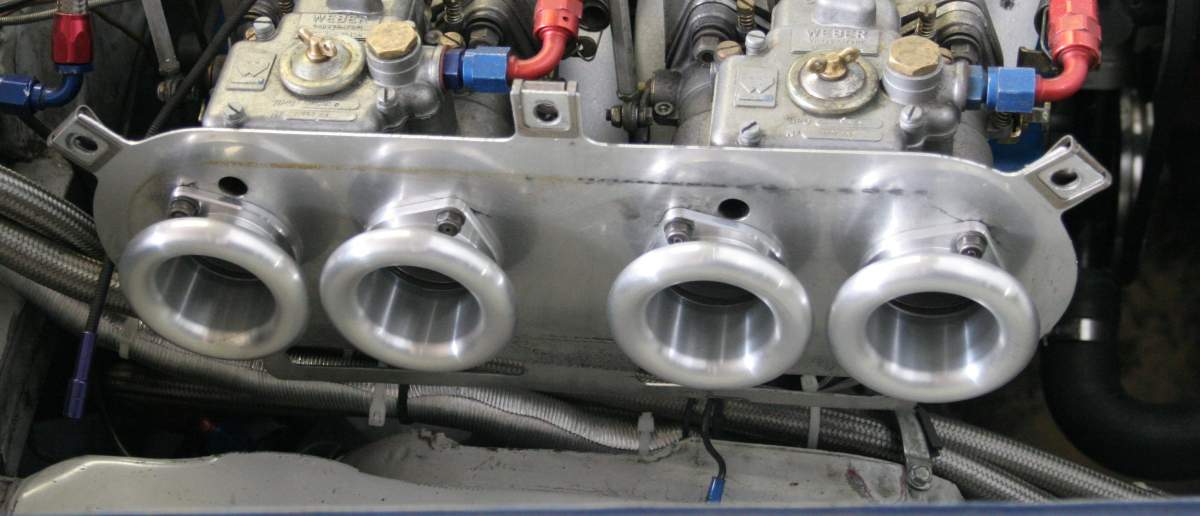
Below are Mikuni air horns with screen type filters - perfect for race applications - $36 for each horn - email for prices and availability of filter screens .
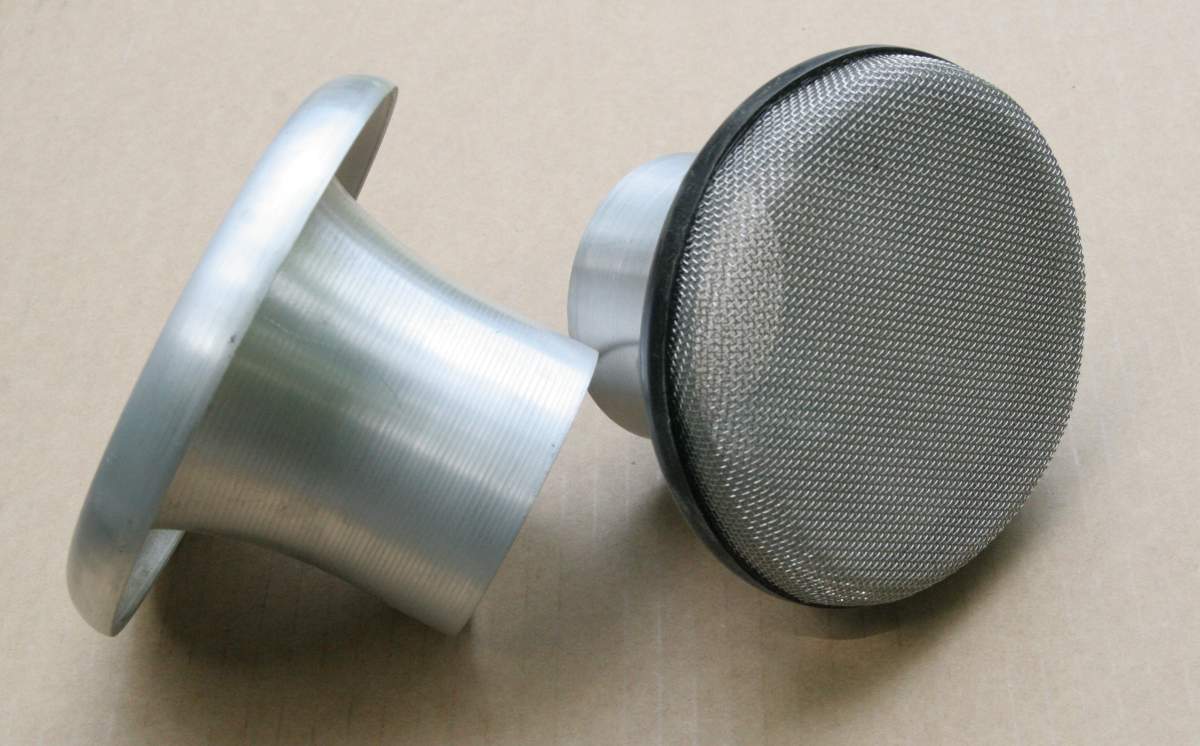 |
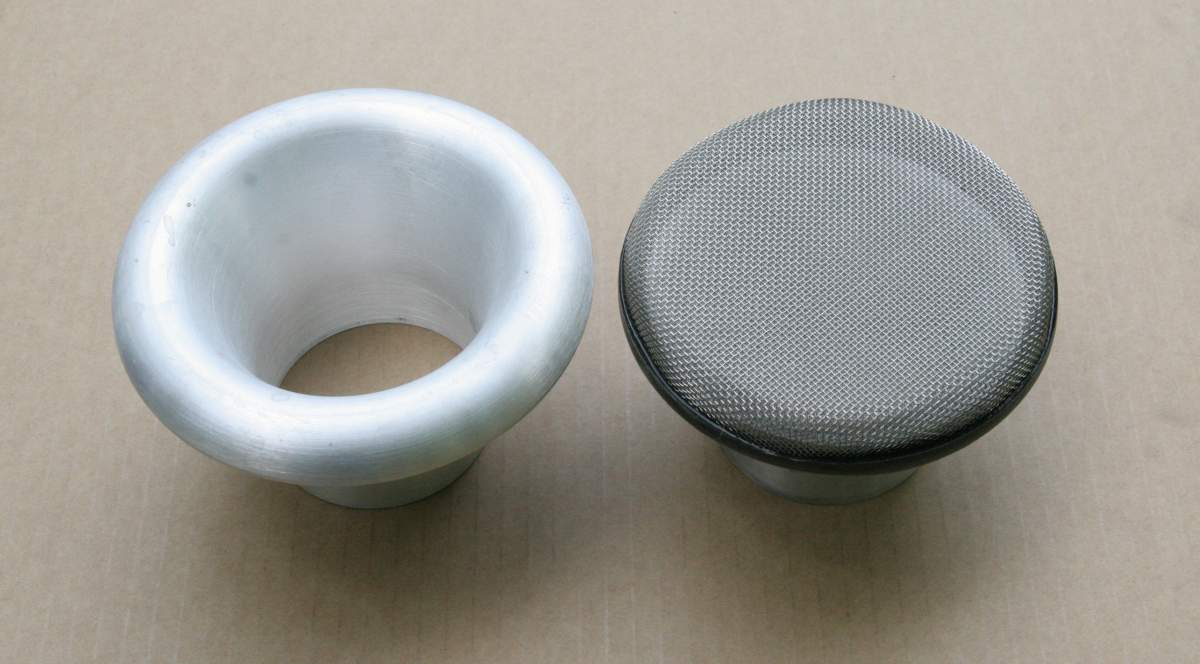 |
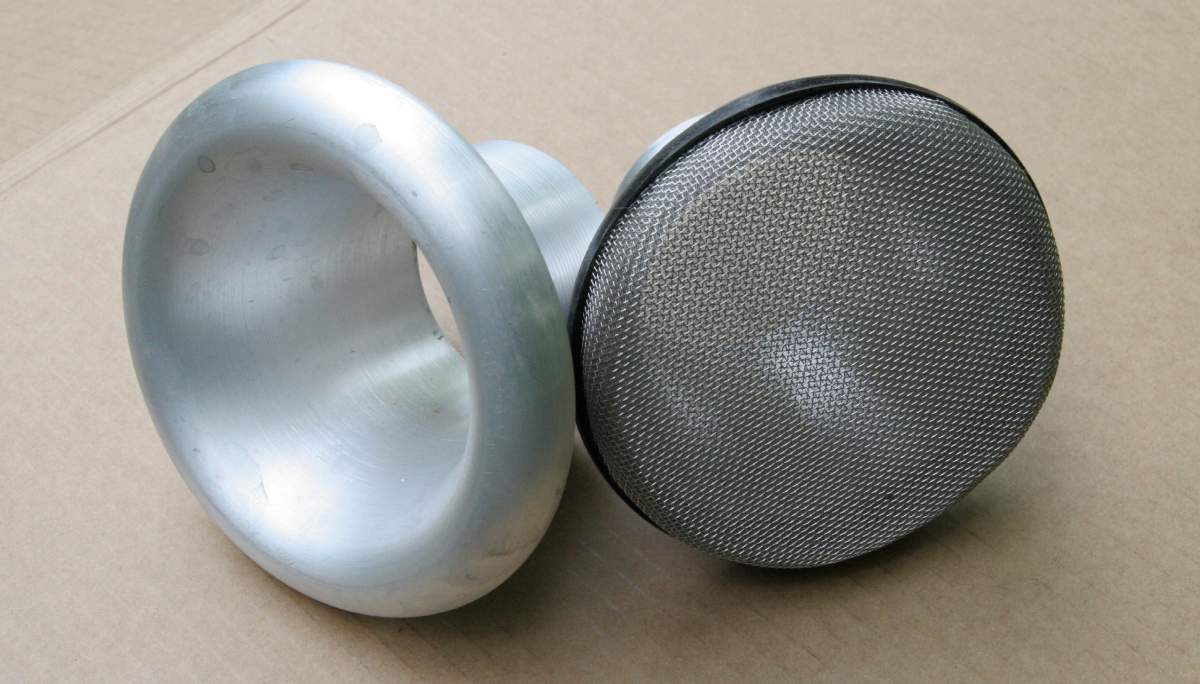 |
Mikuni air horns with screen filters on Jim Grey's TR4 vintage racer
Filters
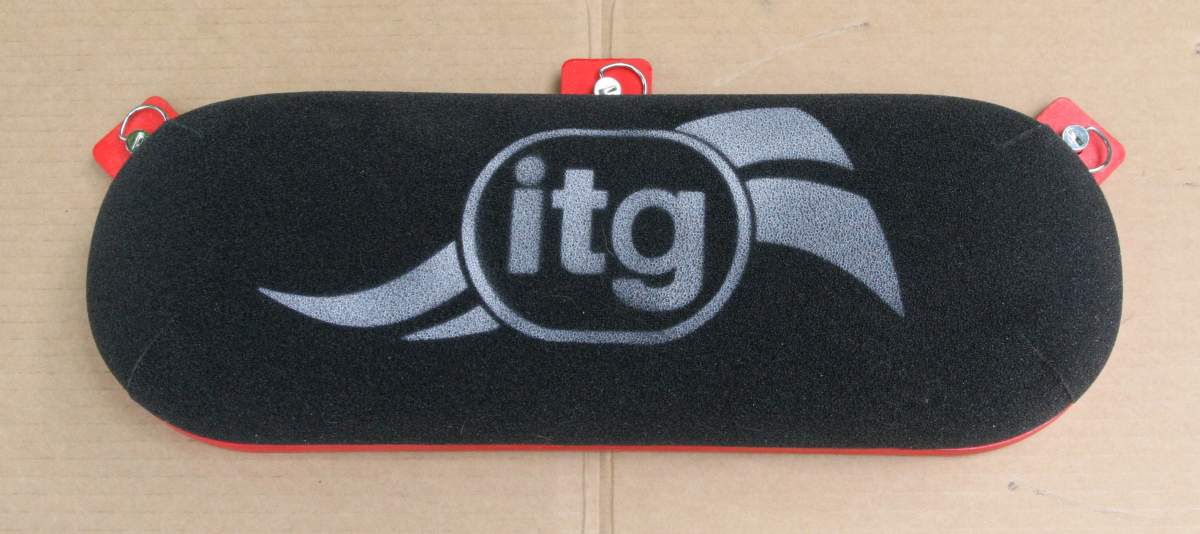 |
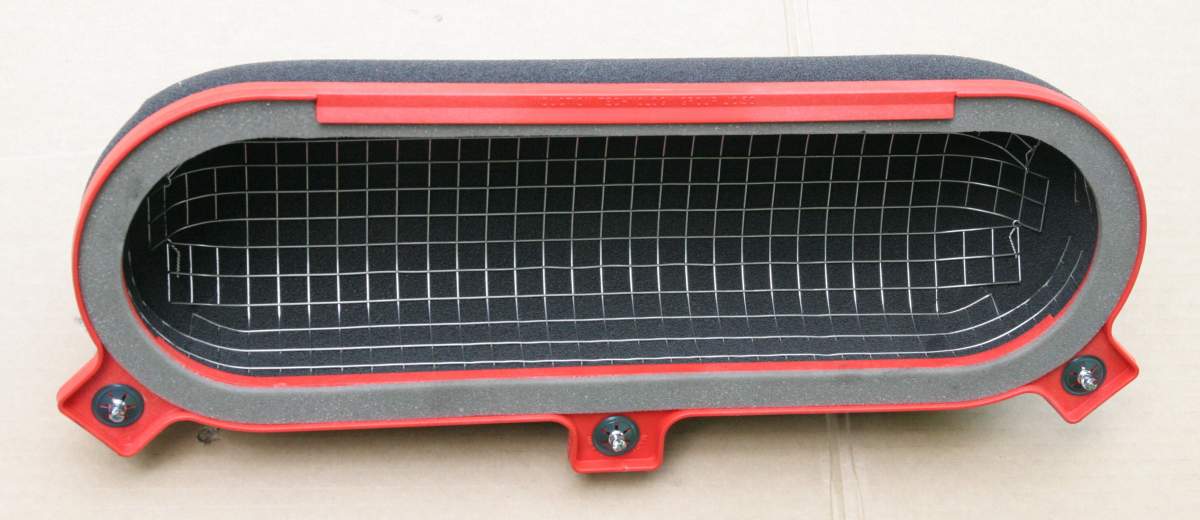 |
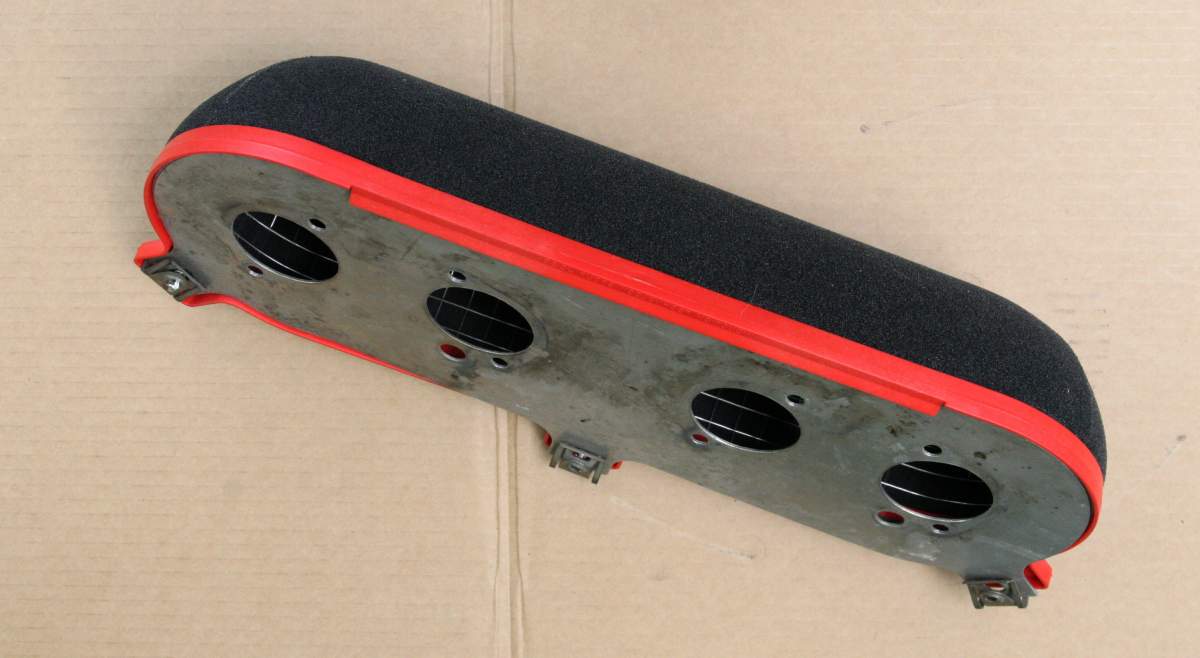 |
ITG Foam Air filters - Imported from England for sidedraft carbs - email for details and pricing.
Available in various sizes, the rounded shape allows them to fit where square filters will not.
Mandatory for use with Weber sidedraft carbs and the longer manifolds on the Volvo 1800.
Accessories
Mikuni HSR jets - main jets - $5.50 per pair. Accelerator pump jets $8 per pair. Re-profiled jet needles $15 per pair.
Soft mounts and spacers for SU and other carbs in performance applications - email for details.
Weber DCOE Jets and Accessories Main jets $6. Air correction jets $6. Idle jets $7. Email for prices on other jets and accessories.
Used Weber Sidedraft carbs We usually have used Weber DCOE carbs in stock. Email for availability and pricing.
Holley fuel pressure regulator - 1 - 4 PSI - $36.50
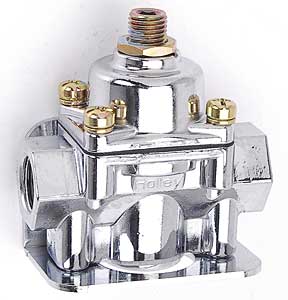
Ignition
Ignition Systems
After many years of testing and using various ignition components we have only found two that meet the criteria to be included in our line of products - The 123ignition Distributors from Albertronics and the Safeguard Ignition Control Units.
Both are high quality, state of the art systems, designed to fill specific needs, and built on a limited basis by small companies.
We have subjected both to extensive testing and can vouch for their performance and reliability.
We have been using the Safeguard for 10 years in our supercharged applications and could not have achieved the same level of performance without it. The selectable boost and knock based ignition retards, plus an enhanced spark, were just what we needed.
The 123ignition distributors are newer and fill the more common need for a reliable replacement distributor with a host of built-in performance features. I have had these in my racecar and street cars for several years, and have used them in extensive dyno testing. Its one of the few items that you can actually install in a few minutes and get an instant improvement in performance. The excitement right now is in regards to their new programable distributors, the 123Tune series, where both the mechanical and vacuum advance curves can be customized and the changes installed even while you are driving. And the best part is that its really easy to do and costs less than $50 more than their standard distributor. See details below.
Both systems are availalbe for vintage Volvos as well as a wide range of other cars.
123ignition Distributors
The one step solution to classic car ignition problems - a high tech ignition system built into a new distributor, with key features not found in other systems:
- Not an add- on but a completely new, state of the art ignition system housed in a classic distributor case. The result: preservation of the original vintage look, but with modern performance.
- Sate of the art electronic components replace the original wear-prone parts including points, advance weights, vacuum diaphram.
- Microprocessor controled spark balancing based on technology developed for Formula I assures optimal performance.
- Sixteen selectable centrifugal advance curves built into each distributor - plus vacuum advance - not the vacuum retard found on all US spec early 70s Volvos.
- Automatic Dwell control provides the optimal dwell angle at all engine speeds, instead of the fixed dwell-angle found in mechanical distributors.
- Simple 2 wire hookup - one to the coil positive and one the coil negative - allows for quick installation
- Now available in a version with programable advance curves for most cars. See details below.
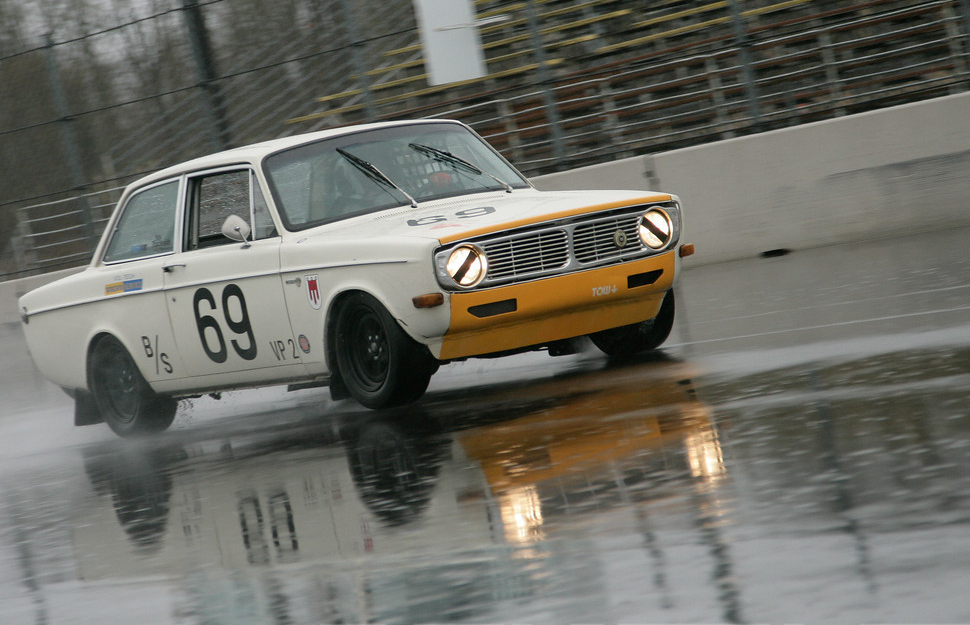 |
Thanks for all your help; the 123 distributor made a big difference!
|
One of our most highly recommended products is the unique line of 123ignition distributors from Albertronics in the Netherlands. Available for Volvo B16, B18, and B20 engines, as well as MG, Mercedes, Minis, Jags, Porsche, Triumph, VW, etc., this is not just a replacement distributor but a complete, state of the art ignition system. Key mechanical parts of traditional distributors that are subject to wear ( points, advance mechanisms, etc. ) are replaced by state of the art, microprocessor controled electronic components that provide optimal advance and dwell throughout the rev range to provide peak spark energy and improved performance. They have an excellent reputation for reliability, are a drop in replacement with 2 wire hookup, and have both selectable centrifugal advance curves and vacuum advance. A great upgrade for any vintage car and a much better option than the common optical or magnetic trigger kits that replace the points but still leave you with an old distributor with unknown amounts of wear in the advance mechanism, shaft, bushings and bearings. Compatible with Smiths tachs as long as they are wired correctly. Compatible with most coils, though for street use the coil primary resistance should be at least 1 ohm. See recommended coils in coil section below.
A complete range of 123 ignition distributor's is available for Aston Martin, Austin-Healey, Austin, Citroen, Fiat, Jaguar, Land Rover, Mercedes, MG, Mini, Morris, Peugeot, Porsche, Rover, Triumph, Volvo and VW as well as other Lucas and Bosch distributor equipped cars.
$435.95 for the standard Volvo B18/B20 and most 4 cylinder engines. Prices for most vintage cars are similar. Email for the details for your make and model. Discounts for group purchases are available. Several computer controled "tune" models are now available including a bluetooth tuned version. Our recommendation for most customers is the version with selectable advance curves.
Volvo prices
B18/20 carbed - 16 selectable advance curves $440.00
B20 FI - 16 selectable advance curves $450.00
B18/20 programable wired $469.95
B18/20 programable blue tooth $489.95
B30 carbed $459.95
B30 FI $469.95
B30 programable blue tooth $509.95
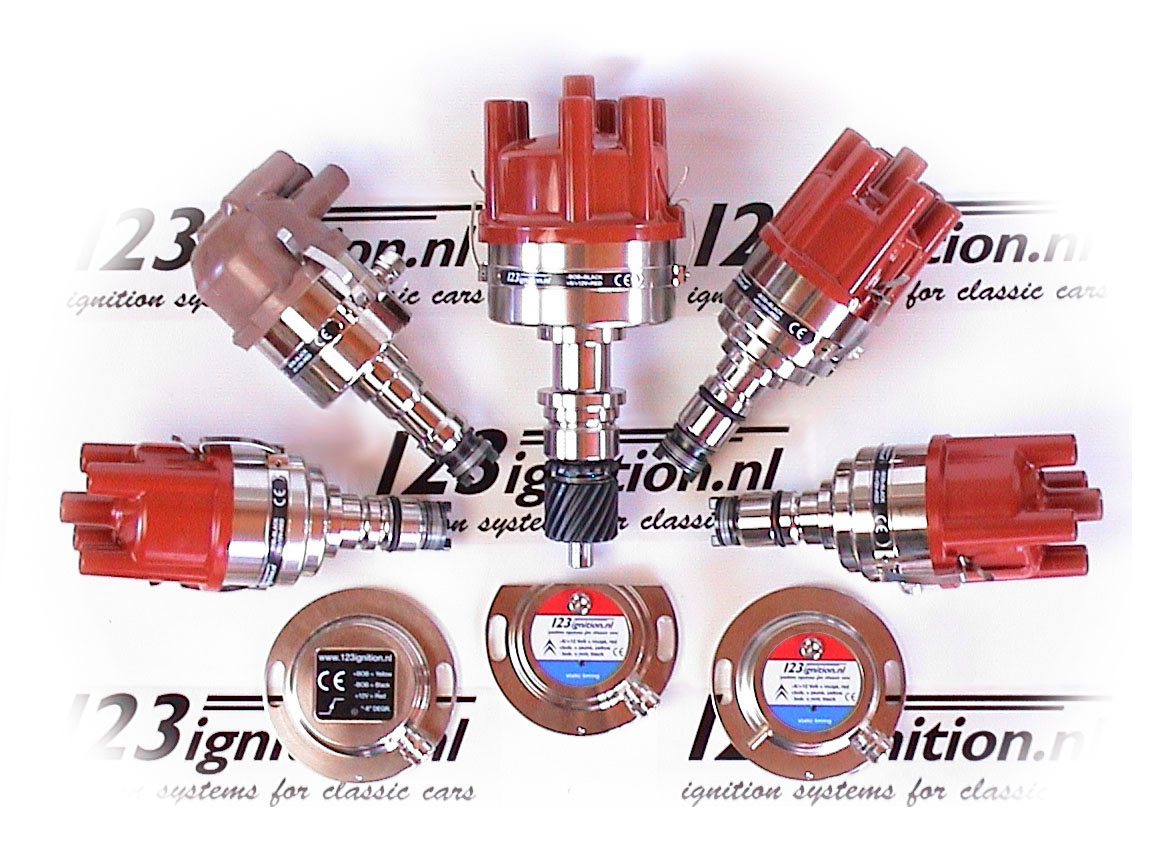
Key features of the 123 Ignition Explained
Spark Balancing - The 123 ignition analyzes engine performance on a per cylinder basis and adjusts the spark timing and energy levels of each cylinder in order to balance the power levels - optimizing engine operation. This spark balancing function, derived from Formula 1 engine management systems, has not been available for classic cars until now.
* As the engine runs, the rotational velocity of the distributor shaft will differ slightly with each power stroke, as a result of the unique combustion characteristics of each cylinder.
* The 123's microprocessor measures these velocity changes and uses this data to calculate the optimal timing and energy level for the next spark sent to each individual cylinder.
* The spark balancing program equalizes power strokes between cylinders, attenuating internal vibrations and resulting in a very smooth running engine with cleaner tailpipe emissions, improved fuel economy and enhanced full range power response.
Gated Switching - The 123 ignition uses a high quality, high speed electronic switch to turn coil current on and off with minimal losses. As a result, more energy is immediately available for each spark event, leading to better combustion and less unburned fuel.
Simple 2 Wire Hookup - All that is required is to attach the black wire from the distributor to the negative terminal on the coil and the red wire to an ignition switched 12 volt positive - usually the + terminal on the coil. For cars with early type Smiths Tachs attach the black distributor wire to the same wire that went from the original distributor, through the tach, to the negative coil terminal.
Selectable Centrifugal and Vacuum Advance Curves - Each distributor is preprogramed with a selection of advance curves appropriate for the particular distributor application. For Volvo B18/B20 engines there are 16 selectable centrifugal advance curves in addition to vacuum advance. This provides the widest possible options for tailoring the timing advance characteristics to a particular engine, whether stock of modified. The photo to the right below shows the dial for advance curve selection.
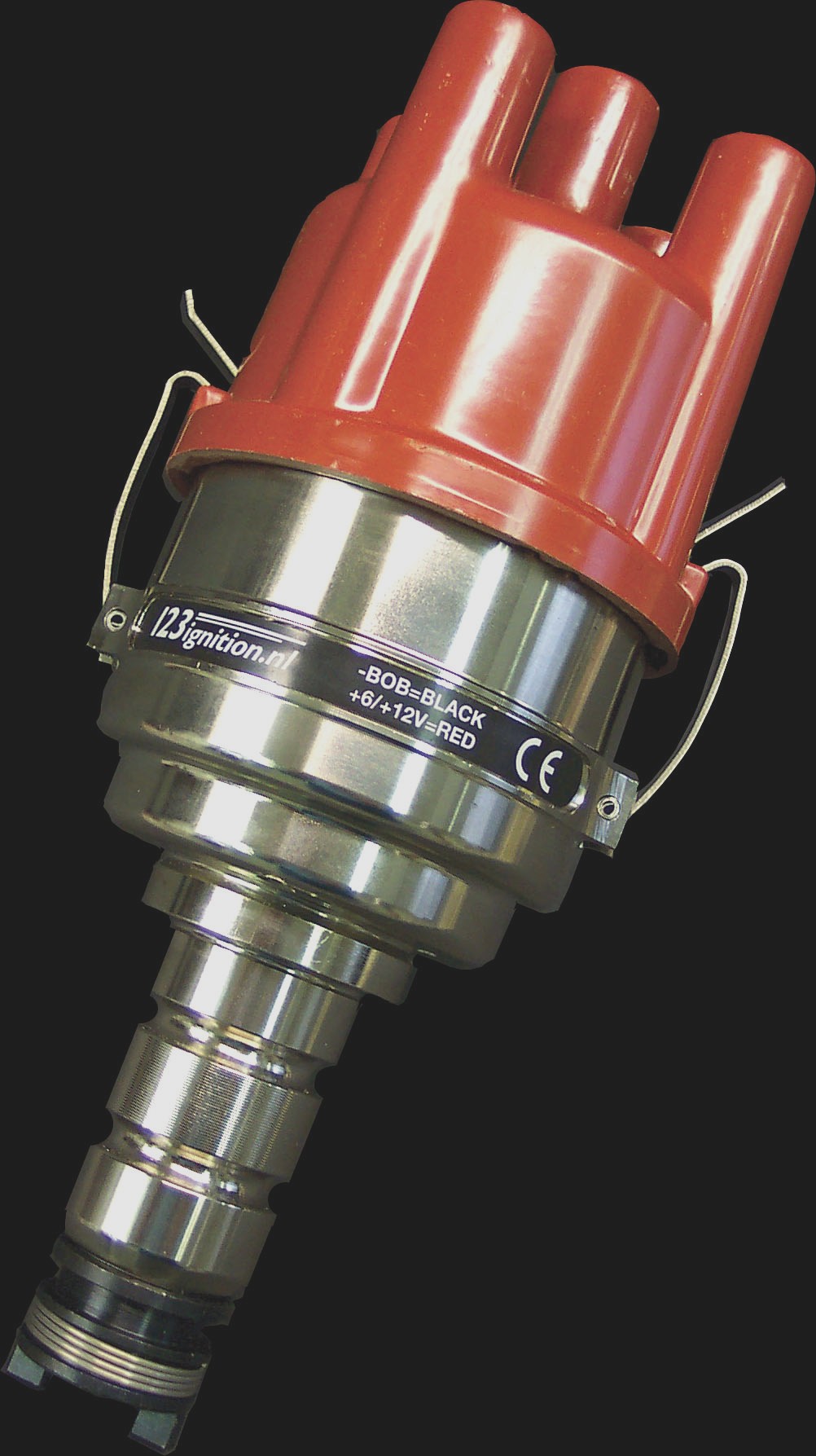 |
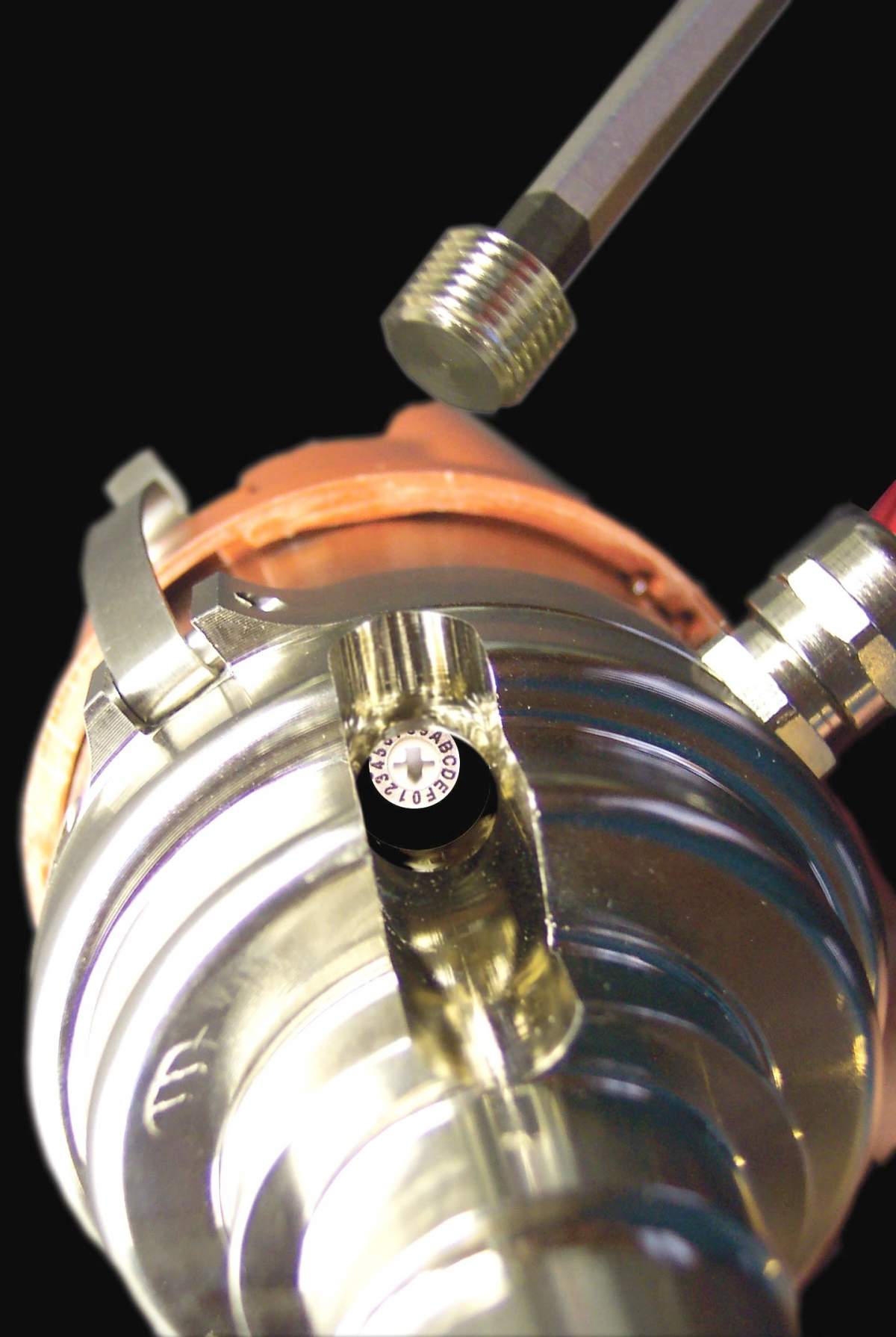 |
A Distributor with Programable Advance Curves
Available Now for most Vintage Cars
The latest innovation - a computer programable distributor for vintage cars connected either by wire or wireless bluetooh - email for prices and availability for your car.
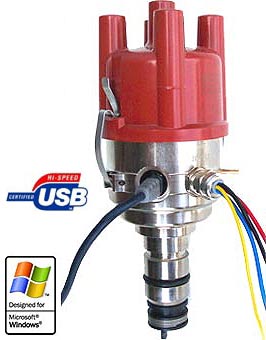
123ignition did it again ! If you want to custom tune your engine, or you have an engine for which there is no standard distributor available with the correct timing curves.....the new 123\TUNE is the answer ! By connecting it to a computer, you can easily adapt the 123\TUNE to fulfill even the most demanding requirements, including boost retard for superchargered or turbocharged applications. Using a laptop computer the ignition timing curve can be modified while the car is being driven or while on a chassis dyno.
Here are all the features offered :
- rotation CW and CCW ( autodetect )
- for 6 Volt and/or 12 Volt cars ( autodetect )
- for positive and negative earthed cars
( 123\TUNE-8 is for neg.earth ONLY )
- two centrifugal advance curves
( 500 to 8000 rpm )
- two vacuum-advance and boost-retard curves
( 0 to 200 kPa or -30 inHg to +15 psi )
- two MAP-start fields
- two rev.limiters ( advanced random spark stealing )
- real-time tuning under keyboard-control ( ideal for working on a rolling road )
- rpm-stopwatch ( ideal for tuning using the road itself as a rolling road )
- luxurious import-from-file and export-to-file ( curves can easily be exchanged over the internet )
- electronic "dashboard" with :
temperature gauge ( selectable in degrees Celsius or Fahrenheit )
manifold pressure ( selectable in Bar or inches Hg / Psi )
rev. counter ( 0 to 8000 rpm crankshaft )
spark-energy gauge ( primary coil current )
total-advance gauge ( in degrees crankshaft )
- available in 4- , 6- and 8- cylinder models with various sizes and shapes.
For more details go to the 123ignition website - http://www.123ignition.nl/downloads/folder/123ignition-tune-productsheet-2010.pdf
We are currently trying these units on various engines, so look for updated reports.
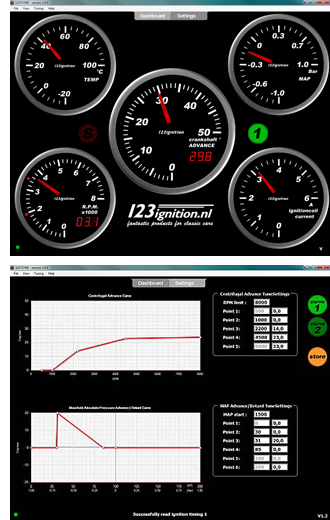 |
To the left are the screens that will be shown on your computer when setting up and using the 123Tune software to change and monitor your ignition timing. The top image is of the "Dashboard" that shows rpm, actual ignition advance, manifold pressure - MAP, spark energy and temperature gauges - reading a temp sensor in the dist.. The lower image shows the mechanical and combined vacuum advance - pressure retard curves. Several are supplied as examples and can be used as the basis for your custom curves. Changing either of the curves is as simple as clicking on the curve and dragging that location up or down. The resulting curve can be saved either to your computer for future use or directly to the distributor which can store 2 curves. Selecting between the 2 curves stored in the distributor can be done with a switch, and does not require a computer connection. Either or both curves stored in the distributor can be replaced with other curves that have been created and saved. Connecting the distributor to your computer requires a USB cable with mini USB connector on the distributor end. A sheilded cable is required if it is going to be used while the engine is running. |
SafeGuard Ignition Control
Knock Sensing Ignition Control Systems
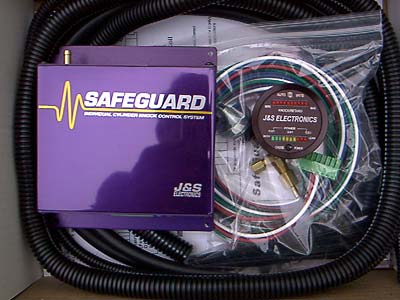
These are perfect for either high compression or forced induction applications. Originally developed for high end racing applications, the adjustable ignition timing retard system based both on knock and/or boost will allow an engine to run a higher compression ratio and/or higher boost pressure than is possible without the system. Highly sophisticated, in knock sensing mode the Safeguard will only retard the timing as much as needed, only in the cylinder(s) where a retard is needed, and only for as long as needed. This ability to customize the timing on a per cylinder, per crank rotation basis is an elegant solution just not found on other systems. On our supercharged engines this system has allowed 50% increases in boost. ( Some people were wondering how I could run nearly 15 lbs. of boost on a 10 - 1 compression engine when we were testing our supecharger system. This is the answer. ) Highly recommended for high CR or turbo/supercharger applications.
Includes adjustable RPM limiter.
With MAP sensor for both boost and knock based adjustable timing retards - $495
With knock retard only, for normally aspirated applications - $450
Available with an optional "dual monitor" ( the round gauge to the right in the above photo ) which senses and displays information on both air/fuel ratio and detonation. A very useful addition to the knock sensing ignition system that facilitates tuning. $179
Email for prices and details on newer units.
Ignition Coils
Pertronix 40011 Flame-Thrower 40,000 Volt 1.5 ohm Coil - $45.95
This is the coil that I recommended for use with the 123 Distributors. It features higher voltage and lower resistance than stock coils for a hotter spark, especially at higher rpms. Not for use with points ignitions where the ohm rating should be 3.0.
For racing where the engine will not be run at low idle speed, I recommend their .6 ohm coil which will have a slighly hotter spark at high rpm.
Exhaust
Headers
Our unique, custom made in the US, stepped primary 4 - 2 - 1 ( Tri -Y ) improved with a dyno developed merge collector - our standard header for street and race use.
( 2023 update - there are a few of these left that were saved for race/rally applications - email/call for availability and price. )
( Custom headers sold out for 2017 )
Instead --
See our new Swedish Designed 4-2-1 Headers for B18, B20, B21, B23, B230 engines in the next section below.
 |
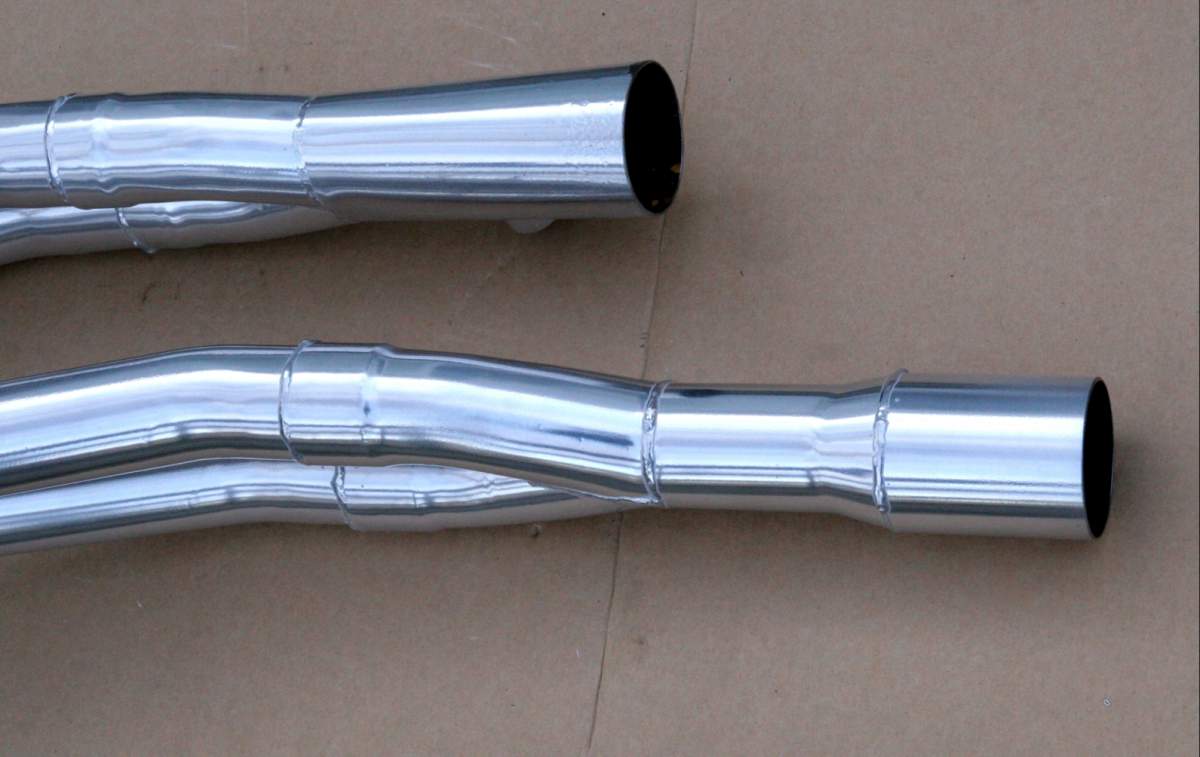 |
For the Volvo B18/B20 our 4-2-1 "tri-Y" header with merge collector has become our standard header for both race and street use. This header is custom made to our specifications right here in northern New York. It is similar in general concept to the header we imported from Europe many years ago, but with better quality control and several generations of dyno developed and tested improvements. As in the photo below, the header has a stepped primary tube design, and a merge collector based on extensive dyno testing. It was designed to provide clearance for a variety of intake manifolds, alternator clearance, and upper A arm clearance on 122s & 1800s set up with less than stock camber. It is less expensive than a 4 into 1 of comparative quality, and allows more room for plumbing, such as the lines to remote oil filters and coolers. The tri-Y designs normally produce more torque and have a wider power band than 4 - 1 headers. In pure race applications they may yield less peak horsepower at high RPM than a properly designed 4-1 header and tuned length exhaust. However, due to its broader power band, the 4-2-1 is recommended for most applications from street, to autocross, to rallying and racing. In road racing applications our testing has shown that an engine with a broader power band and higher average HP over the useable rpm range, is more important than high RPM peak power. Our 4-2-1 is the clear winner here (so we no longer stock the 4-1 race header ). These headers are well worth the cost as compared to other available headers whose only attribute is their lower cost. Now available in Stainless Steel to increase their durability and useful life.

Street and race performance 4-2-1 headers - with new dyno developed merge collector. These are made in the USA to our specifications for 544s, 122s, 1800s, and 140s. Developed on the dyno to increase power and torque over a wide RPM range. Will work with a variety of intakes but may not fit on cars with generators. Normally stocked with silver ceramic coating. O2 sensor mounts are now located in the first pipe after the collector.
- Coated with merge collector $ 475.
- Uncoated $325 by special order.
- Stainless Steel available by special order - $600.
The above custom built headers are not currently available for 2017. See below for alterntives.
---------------------------------------------------------------------------------------------------------------------------------------------------------------------------------
Swedish design 4 - 2- 1 headers for B18/B20,B23,B230 engines
4-2-1 headers for 1800s 122s and 140s.
Very similar to our custom headers shown in the above photos, with all of the advantages of a good 4 - 2- 1 header as compared to 4 - 1 headers. Imported from Sweden and available in three tube sizes. Painted as shown in the photo below. These will not fit cars with generators. Some modification may be required for use in the 544.
TYPE1 has 44mm secondary pipes and 60mm out - usually the best for street use and easiest to fit - $335
TYPE2 has 48mm secondary pipes and 2.5" out - $345
TYPE3 has 51mm secondary pipes and 2.5" out. - designed for racing applications - $ 375
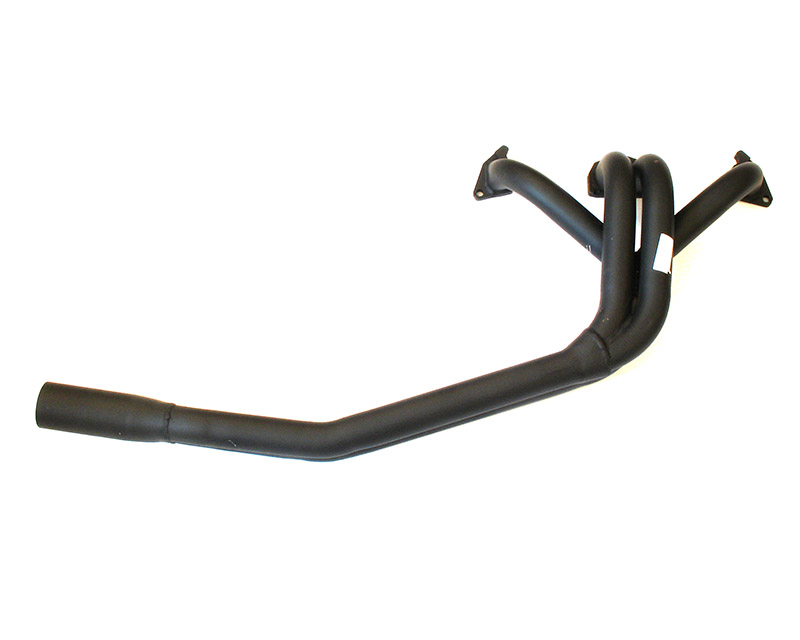
4 - 2 - 1 headers for 240s, 740s and 940s,
Imported from Sweden on special order. 4 sizes available. $345 for the smallest tube size with same increases for the larger sizes.
Tube sizes are as follows, in mm's, starting with the tubes closest to the head. Type 3 & 4 are for rally and race use.
Type1 44-44-60
Type 2 44-48-64
Type 3 44-51-64
Type 4 44-54-64
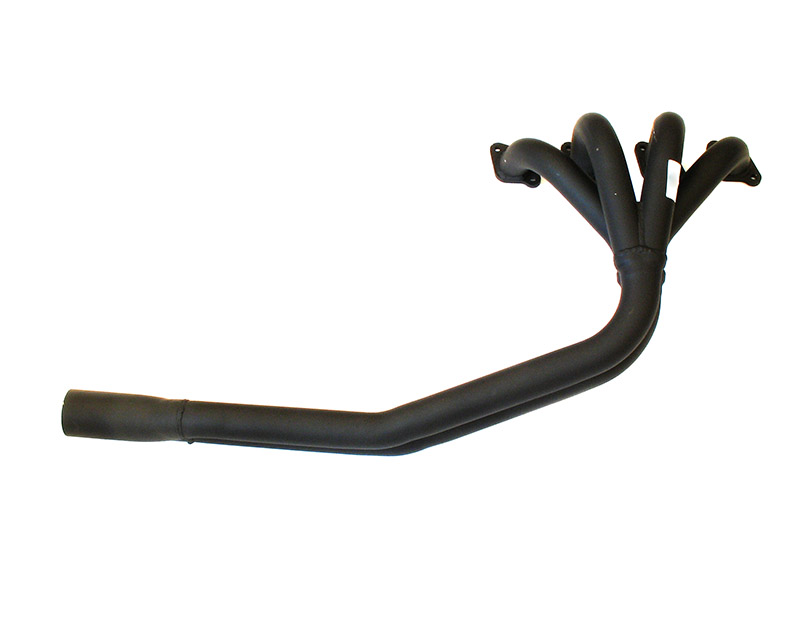
---------------------------------------------------------------------------------------------------------------------------------------------------------------------------------
Custom Built Race headers 4 - 1 - $ 500 - $ 600 depending on type and tube size - add $160 for ceramic coating
( 4 -1 race headers not currently available in 2017. We recommend the 4 - 2 - 1 headers above for most race applications. )
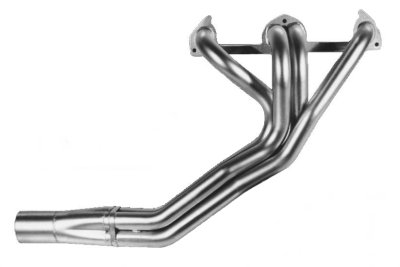
Ceramic Coating of any of the headers, black or silver - $160
Adaptors for oxygen sensors for FI or air/fuel ratio gauges added to any header - $25
-----------------------------------------------------------------------------------------------------------------------------------------------------------------------------------
Important notes on fitting headers.
Once in a while we get a call from a customer saying the header we sent does not fit. Well there's a simple explanation for this, and it is not that there is something wrong with the header. Our headers are made in a jig and its impossible for them to vary more than a small fraction of an inch or they won't fit in the jig. Old Volvos were not made that way and their measurements vary quite a bit from car to car. But most fitment differences are due to engine angle. There is some variance caused by differences in engine and transmission mount bushings, but the biggest difference from car to car is part of the design. The front engine mounts are on the front crossmember along with the front suspension. The suspension alignment is set by shimming the crossmember in relation to the rest of the chassis and this tilts the crossmember and changes the engine angle by raising or lowering the front engine mounts. Not by much, but a small change in engine anlge is enough to effect the clearance at the back of the header located almost 4 feet from the front engine mounts. So what do you do when there is a clearance issue. One way is to put washers on top of the rubber engine and/or transmission mounts - raising the front of the engine or lowering the rear. But a simpler, quicker way is what we do in the shop. I keep a long ( 8 - 10 foot ) piece of pipe handy and use it to carefully adjust the header angle. With the header installed and the car up on jack stands or a lift I use a piece of 1.5 inch pipe so it will fit in the merge collector and then put a piece of short 2.25 pipe around it to fit easily in the end of the collector and prevent deformation. With the leverage provided by 8 - 10 feet of pipe its easy to move the collector up or down several inches. Yes it springs back, but if you move it far enough it will not move all the way back to its original location. So you might have to move it 3 inches to adjust it half an inch, but that is all you usually need. Sounds complicated, but it usually takes about 5 minutes to make clearance adjustments once the car is jacked up.
Another area where there can be a problem on the 122/1800 is clearance with the inboard end of the upper A arm. This usually only an issue where the car is not using the stock camber settings and has instead been modified to reduce the positive camber or use negative camber for performance and racing applications. Using thicker camber shims to provide negative camber will bring the upper A arm in, closer to the header. The solution, used in all of our racecars and a few street cars when necessary, is not to modify the header, but to grind the inner ends of the A arm. This does not reduce strength and will provide sufficient clearance.
Exhaust System Components
Mandrel bent, stainless steel tube system components.
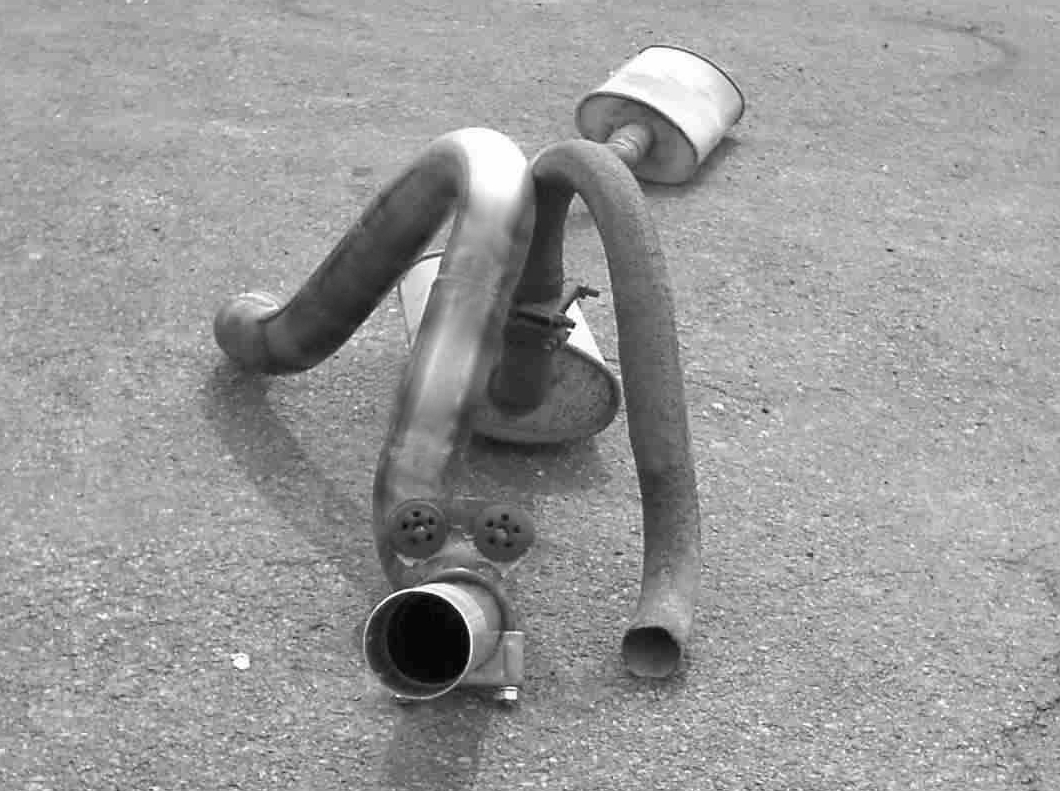 |
Stock 1 3/4 inch tube just won't accommodate performance increases so our components are 2.5 inch - the size we have found works best on our performance engines. To the left is a comparison of the over the axle tube secion from a 73 1800ES with one of our 2.5 " component sections. |
Selected performance exhaust system components for 122 sedans and 1800s in stainless steel. These are not complete systems but mandrel bent 2.5 inch stainless steel tubing pieces that we use to build systems in our shop and that will allow you to build a performance system for your car, or provide them to your local muffler shop and let them finish it up for you. For most applications mufflers, resonators and mandrel bent tubing are available. The tubing sections are designed based on using one muffler ( dynomax ultra flow recommened - see below ) , before the axle and a resonator at the rear next to the gas tank. Although designed to attach to our exhaust headers the tubing can be adapted to other headers and stock exhaust manifolds. Components are available separately so that you can use them to make custom systems with your choice of mufflers. When available - complete sets of stainless steel 2.5 inch mandrel bent exhaust tubes for most models without mufflers - $270. Over the axle stainless tube section as a separate piece - 122 - $165, 1800 ( welded together in 4 sections - $185.
The above exhaust components are currently not available. Email for details on future availability.
Mufflers -
Customers often ask us for muffler recommendations. After much testing ( street, track, and dyno ) and years of use, for performance applications we recommend the Dynomax Ultra Flow mufflers. http://www.dynomax.com/mufflers.php?muffler=ultraflowelded. Usually part # 17222 for a stainless steel 2.5 " offset inlet and outlet muffler, or # 17219 for offset and center inlet and outlet. These are also available in non stainless versions and in 2 " and 2.25 " inlet/outlet diameters. For a round muffler that takes up less space and can be used as a resonator we have used - http://www.dynomax.com/mufflers.php?muffler=racebullet. As it is designed as a race muffler it is not quiet enough to be used on the street by itself but makes a good resonator. With one of each on the system you will get a nice mellow sound - loud enough to be heard when the throttle is opened up, but not loud enough to be disturbing either while idling, or under cruise conditions. There may be other mufflers that will work, but these are the ones we have tested and know will do the job at a reasonable price.
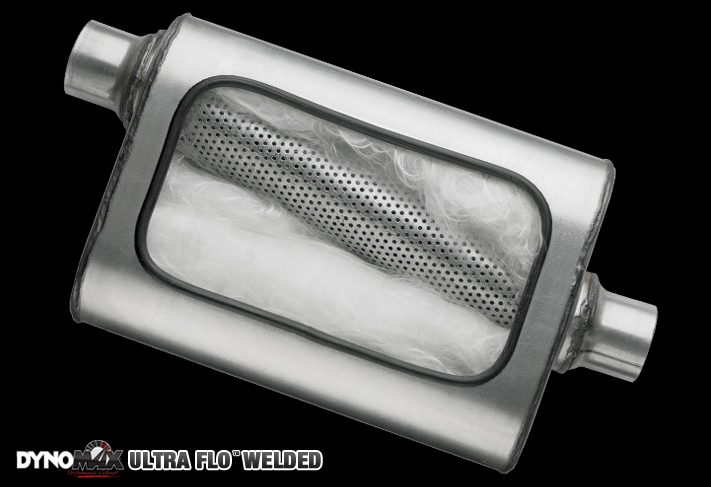 |
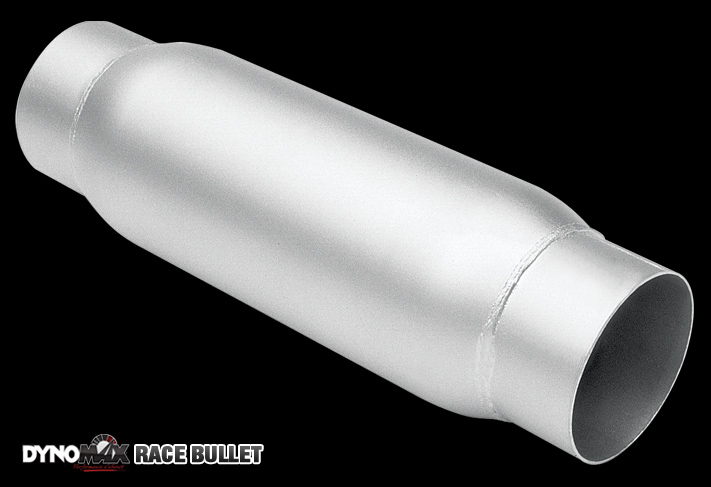 |
Driveline
Clutch
High Performance Clutches
In addition to stock type clutch kits and parts, we offer high performance clutches designed to handling the more rigorous requirements of modified engines and uses that range from street performance to all out racing.
Testing has shown that the stock Volvo clutches cannot cope with power levels approaching or exceeding 200 HP, especially with drivers who like to show off their power with rapid starts and wheel spin. To solve this problem we are now stocking a line of upgraded clutch products including several different types of performance clutch discs and upgraded pressure plates.
The application of these parts is not limited to those cars equipped with turbos or superchargers. Within a range of products there are clutch discs and covers that are perfect for normally aspirated as well as turbo cars, including 240s and 740s. Disc choices include carbon fiber, kevlar, solid hub and button type discs. Clutch covers include those with ranging from stock to 100% additional holding power. Package deals are available with our aluminum flywheels for a true performance clutch and flywheel setup.
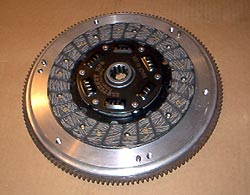
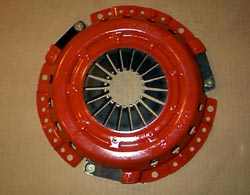
Applicable to Volvo M40/41, M45/46, and T5 and T9 transmissions, 8.5 " diameter unless otherwise stated, others by custom order
- Stock Sachs Volvo 8.5 inch clutch kit - light weight 240 style pressure plate, disc and release bearing - available for either early ( 544/122/1800/140 ) or late ( 240/740 ) input shaft splines $ 235.00. This kit replaces earlier Sachs Clutches for these models and uses the pressure plate referred to below.
- For a complete package add a modified stock type flywheel - resurfaced, lightened and balanced - $195 plus a $60 core charge if we provide the flywheel core. Sachs clutch kit + plus flywheel as above = $430 + $60 core charge = $490
-
Light weight OEM type pressure plate $195 - This is a Sachs 240 style. 8.5 inch pressure plate. Recommended as an upgrade for use on earlier cars as it is lighter and stronger than the earlier style clutches used on the 544/122/1800/140.
-
One of our most popular clutch package - the above pressure plate with our severe duty organic disc - $275
Clutches listed below may be no longer available - email for details -
Dual spring pressure plate - $275 - This is our older style PP made for us by Clutchnet. Good holding power but not recommended for cable clutch cars. - no longer available new - 2 lightly used in stock.
-
2 New and improved designs include the following two clutch pressure plates.
-
Modified pressure plate and heavy duty clutch disc. Designed for street applications in the 200 - 250 HP range where a stock feel clutch is desired. This is a new product designed and tested in 2006 and is superior to those available previously - $400 with heavy duty organic disc. $455 with kevlar disc recommended where semi race use is expected.
-
Dual disc street, street/race, or pure race clutch designed for higher HP ( 250 + ) applications. Available with several different disc types depending on use. Adding a second 8.5" disc is the solution to having sufficient disc area and still fit in the stock bellhousing. Uses the stock 8.5 inch pressure plate bolt pattern. This clutch can do it all - handle high torque loads ( 350 ft.lbs + ) and abuse, but with a street clutch feel & normal clutch pedal pressure. The weight of 13 lbs with discs is less than a stock single disc clutch with disc. This is the clutch that we developed to use in our own supercharged cars and is well worth the price to do it right the first time. Price depends on the disc type and input shaft splines - $935 - $995 including discs.
-
Street performance clutch discs - several types available from $140 - $195
-
Severe duty organic discs- $140
-
High performance 8.5 " kevlar discs - $195 availalbe with solid or sprung hubs - the solution for street / track use.
-
Race type performance clutch discs - email for details
- Race clutches - The best setup is our 7.25 Tilton modified for use with Kevlar discs. Far superior to Tilton's metalic disc. Eliminates wear issues. Complete clutch with disc for the single disc version - $675. Additional kevlar 7.25 race discs - $175 Email for further details.
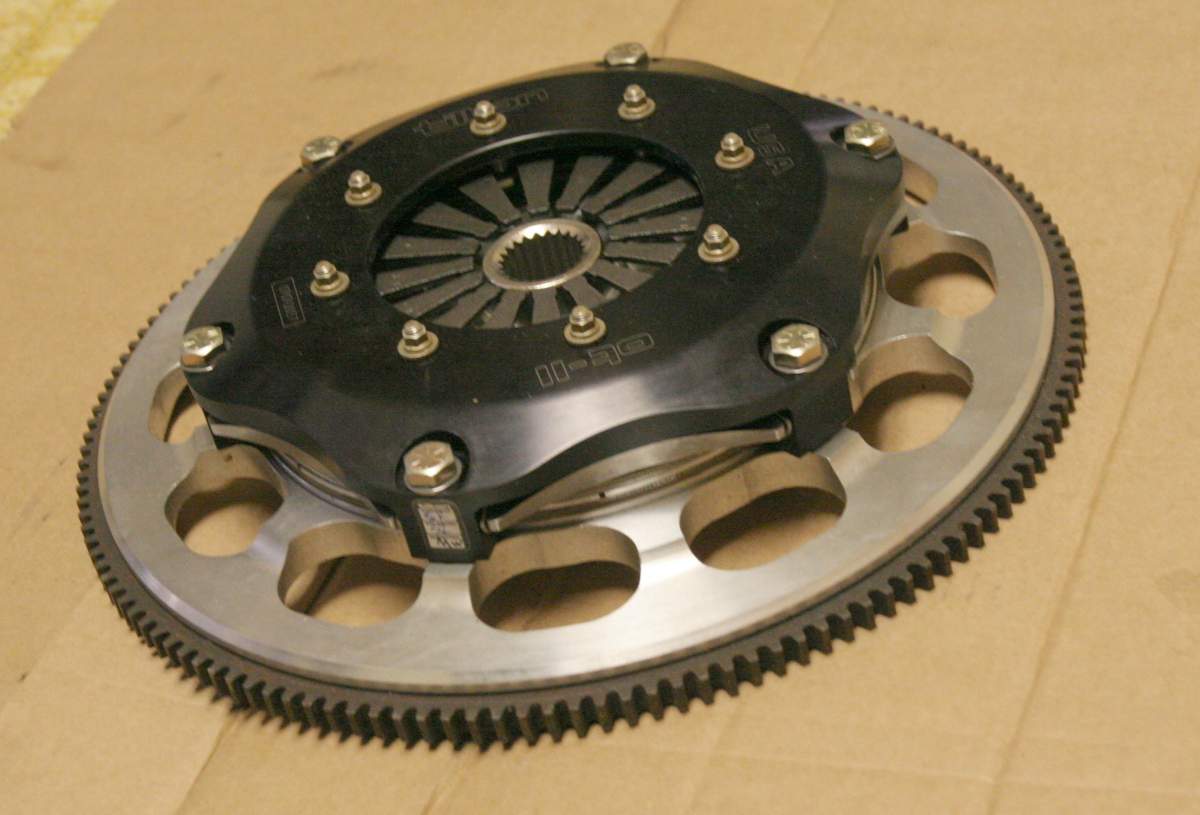 |
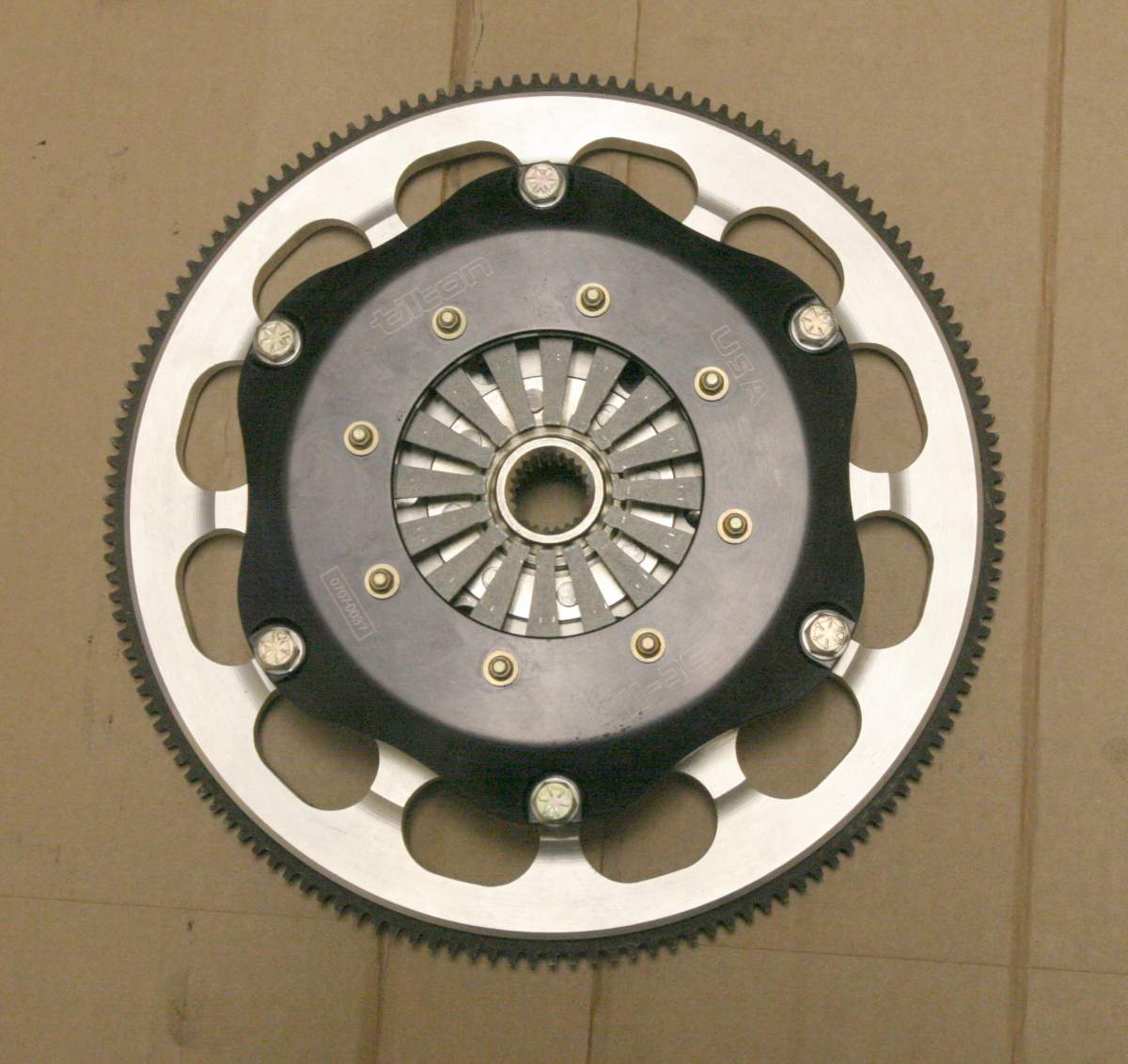 |
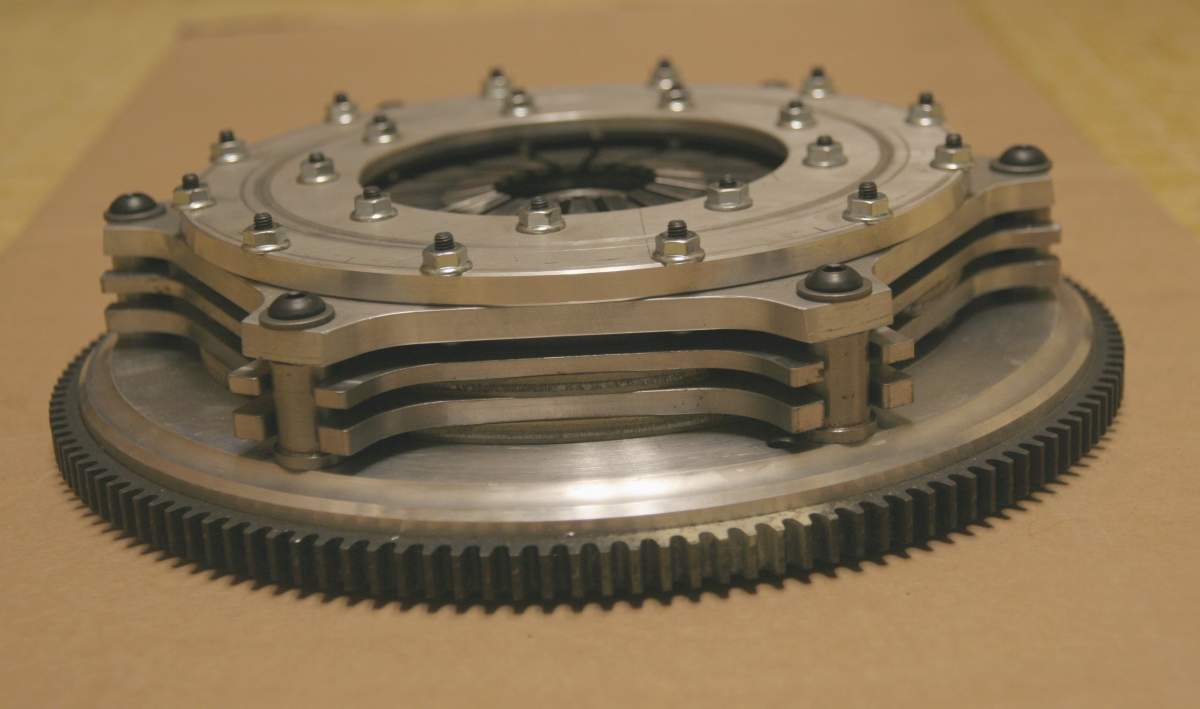 |
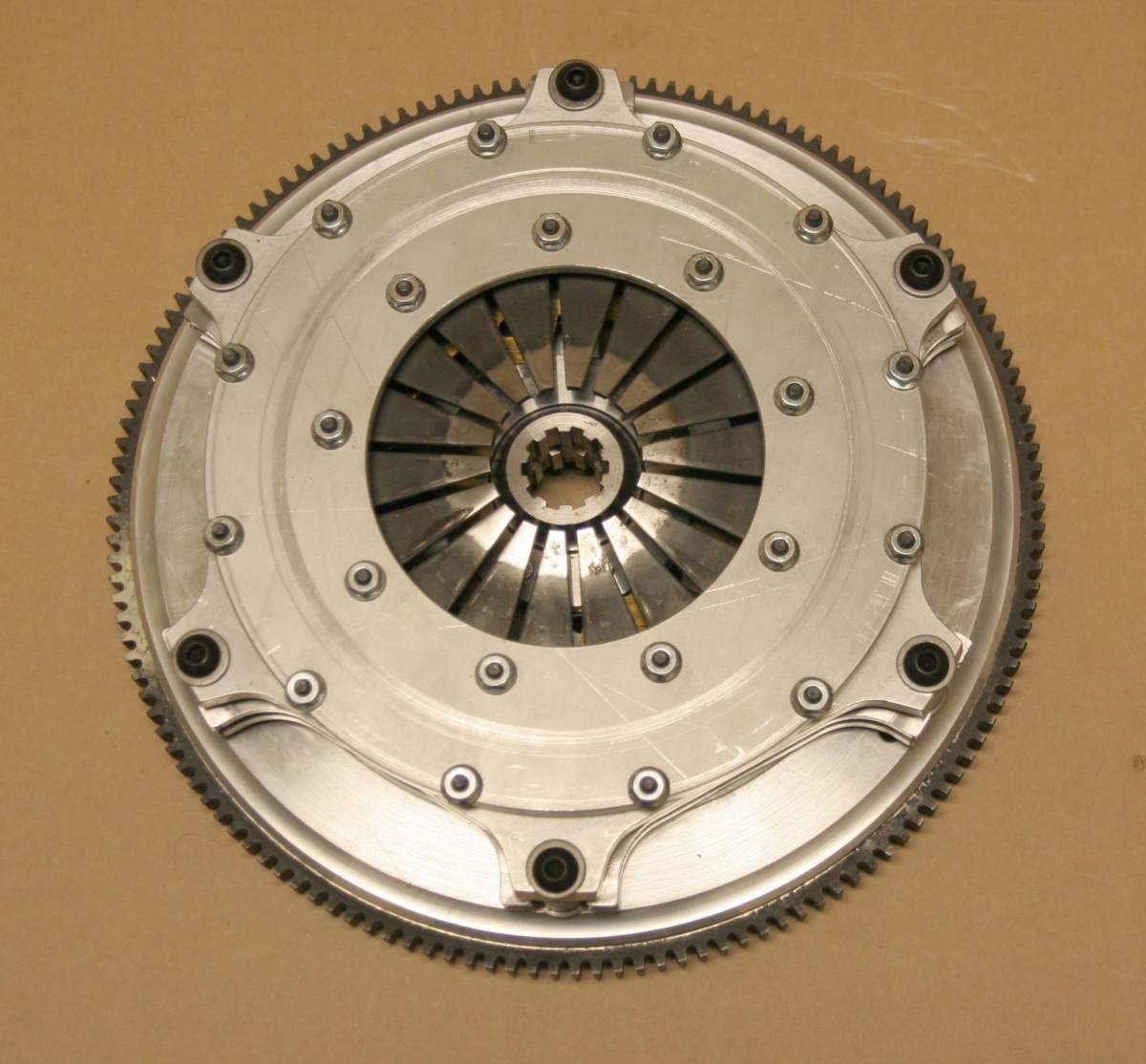 |
Flywheels - Aluminum - Lightened Stock
Lightening the rotating mass is critical for high performance. The most significant weight reduction available is in the flywheel. This is a performance improvement that will help everytime the engine accelerates. Our aluminum flywheels are normally for RWD Volvos, but others can be provided on request. Street AL flywheels are usually less than half of the stock weight. Race AL flywheels less than 1/3 stock weight. For customers looking to retain a stock feel, but still gain a significant advantage, we also have lightened stock flywheels, with 3 - 4 lbs. of weight removed from the outer circumference where it will have a much greater effect than an overall weight reduction.
- Lightened stock flywheels - resurfaced, lightened and balanced - $195. Add a $60 core charge if we provide the flywheel.
-
Street Aluminum Flywheels - 8.5 inches - 9 lbs. ( stock flywheels are 22 lbs. or more!) Can be used on all rear drive Volvos - Specify 6 bolt ( ‘ 73 and earlier ) or 8 bolt ( ‘ 74 and later ) crank - $455 Can also be used as a light duty race or rally flywheel with our single and dual disc 8.5 inch clutches. ( Sustained RPM should be limited to 6800 RPM. For severe race applications contact us regarding upgrades or order the race version below. )
-
Race Aluminum Flywheel for 7.25" Tilton clutch - 6 lbs. --- Versions for 5" and 8.5 " also available. Made from a different alloy than our street flywheels in order to handle the increased stress of race use. Currently out of stock and will be a limited production, special order item for 2013. Order by 12/1/12 for spring 2013 delivery. Email for price.
For precision balancing add $60. The flywheel should be balanced with the clutch pressure plate to be used. Aluminum flywheels, since they are thinner than stock flyhweels, often require a longer release bearing and/or clutch fork pivot modification. Email for details.
.jpg) |
.jpg) |
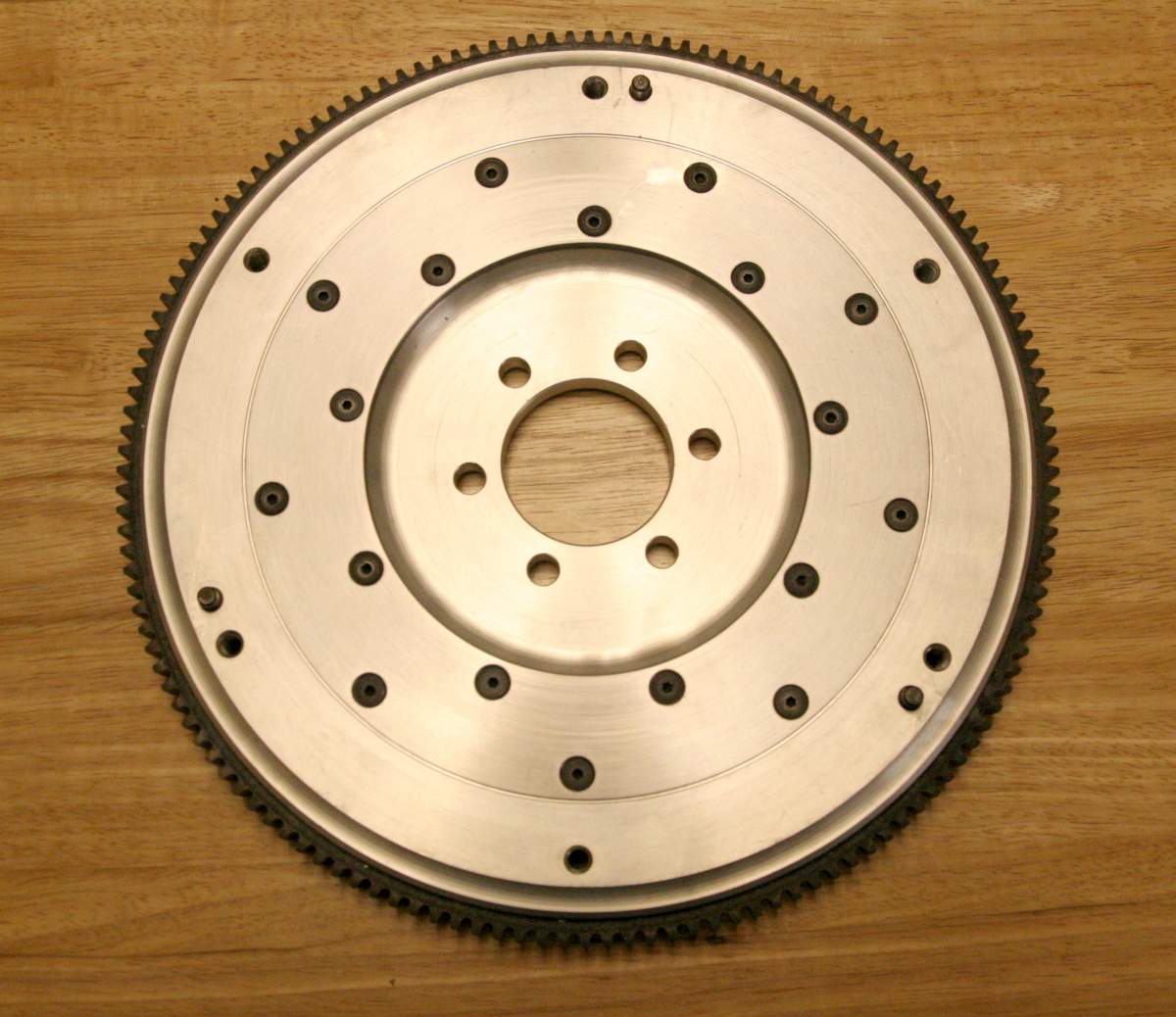 |
.jpg) |
.jpg) |
.jpg) |
Rear End Gear Sets
Increase your rearend ratio for race or rally. Decrease the ratio for highway cruising. 3.73, 3.90, 4.1, 4.56, & 4.88 ratios available for the Dana 30 - $220
Limited Slip Differentials
For Dana 30 rear ends - 27 spline - all disc brake 1800s, 140s, 240s, etc. we recommend the Truetrac® Limited Slip. The Truetrac® is Tractech’s limited slip differential . This is an all gear driven differential that automatically provides smooth torque transfer for traction on demand. The Truetrac® provides durable and dependable performance with no loss in power and no clutch plates to wear out. We use and recommend for both our street and racecars - $540. There is also an installation kit with includes shims, etc. - $50 .
The original equipment disc type Dana “Powr-Lok” is not currently available.
Rearend Conversions
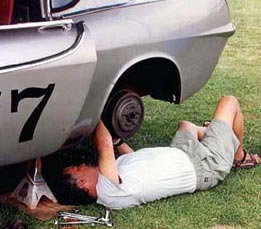 The most common conversions address the safety problems associated with the rear drum brake cars. Unfortunately, breaking of the rear axles on drum brake cars has been a continuous problem in Volvo performance applications since the '50s. As the power and handling of these cars have improved, the stresses on this comparatively weak component has increased the rate of breakage. In vintage racing, most cars raced for more than a season with the original axles have suffered breakage and serious consequences. Options involve either the replacement of the rear end with a Volvo disc brake housing, or modifying the original housing to use Ford axles and drum brakes as was done on my race car almost 20 years ago. ( It still out-brakes the disc brake rear cars.) As most vintage race clubs now allow the conversion to rear disc brakes as a safety upgrade, we no longer offer the Ford drum conversion kit. For 67 - 69 1800s and 122s the disc brake rearends from 70 - 73 1800s will bolt right in, though some extra work is needed to hook up the brakes and convert to the same bolt pattern as in the front. If you need help with this, sourcing a rearend, or converting the bolt pattern, let us know..
The most common conversions address the safety problems associated with the rear drum brake cars. Unfortunately, breaking of the rear axles on drum brake cars has been a continuous problem in Volvo performance applications since the '50s. As the power and handling of these cars have improved, the stresses on this comparatively weak component has increased the rate of breakage. In vintage racing, most cars raced for more than a season with the original axles have suffered breakage and serious consequences. Options involve either the replacement of the rear end with a Volvo disc brake housing, or modifying the original housing to use Ford axles and drum brakes as was done on my race car almost 20 years ago. ( It still out-brakes the disc brake rear cars.) As most vintage race clubs now allow the conversion to rear disc brakes as a safety upgrade, we no longer offer the Ford drum conversion kit. For 67 - 69 1800s and 122s the disc brake rearends from 70 - 73 1800s will bolt right in, though some extra work is needed to hook up the brakes and convert to the same bolt pattern as in the front. If you need help with this, sourcing a rearend, or converting the bolt pattern, let us know..
Transmission
Transmission Swaps
For over 20 years we have been doing transmission swaps into Volvos. At first it was into racecars in order to get a stronger transmission with closeratio gear sets. Then as the horsepower increased in street cars, with both supercharged and turbocharged engines producing more than double their origional power, there was as need to swap in stronger transmissions to replace the broken originals that were not designed to take the increased HP and torque. In 2003 we were contacted by members of Turbobricks who wanted to know if we could modifiy the adapter plates we were using on B20 engines so that the Ford Mustang T5 transmissions could be mated to B23 and B230 engines in 240s and 740s. Since then we have been stocking not only the transmissoin to bellhousing adapter plates, but also modified bellhousings, modified clutch forks, release bearings, pilot bearings, flyhweels, and clutches needed to complete these T5 transmission swaps.
Although the T5 has been our standard transmission swap, it is not a good fit for cars with smaller transmission tunnels. In order to facilitate transmission swaps into the smaller tunnel cars - the pre 1970 1800s, 122s and 544s - we have added Ford T9 transmission conversions. The T9, most commonly found in the Ford Sierra ( Merkur and XR4Ti in the US) fills the need for a small, readily available 5 speed that will fit into the transmission tunnels of the earlier Volvos and other small tunnel cars, while at the same time providing a true 5 speed experience with a high power handling capacity.
See below and in the driveline section for the products needed for both the T5 and T9 transmission swaps.
The T5 Transmission Swap into Volvos
A transmission swap that we originated, and still one of the most popular swaps uses the Borg Warner (now Tremec) T5 transmission. It is a lightweight (70 lbs.), 5-speed transmission that has been manufactured for over 30 years for various OEM applications and is found in Fords, Chevies, and various other cars and trucks. The transmission is of a modular design and can thus be found with various input shafts, tail shaft housings, shifter positions, etc. It is comparatively simple to modify and repair and parts are readily available at quite reasonable prices. It went through a process of upgrades over the first years of its manufacture, increasing its HP and torque ratings from 200 ft. lbs. to well over 300 ft. lbs. The uprated versions are commonly known as "World Class" T5s. Where higher than stock torque ratings are required uprated versions are available with stronger gear sets and custom gear ratios. ( See our T5 transmission section below. ) Fifth gear is an overdrive fifth, comparable in ratio in some models to the gearing in Volvo's overdrives, in others it has higher or lower overdrive ratios.
A rebuilt T5 with our adpater plate, a modified late syle 240/740 bellhousing, and Pro 5 shifter.
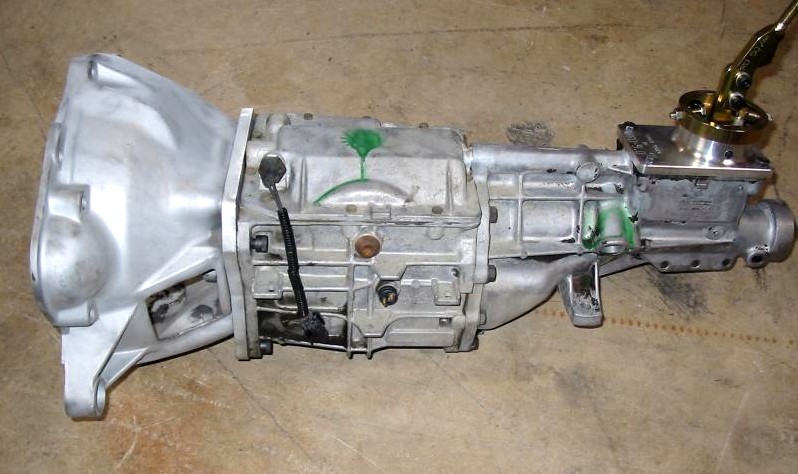
Our adapter plates, CNC machined from 6061 T6 aluminum, allow a T5 transmission with a "Ford bolt pattern" ( the T5s in some GM cars also have this bolt pattern ) -- usually from a '92 and earlier 5-liter Mustang or aftermarket Motorsports T5 -- to be mated to either a Volvo M40/41 or M45/46 bell housing and their associated engines. Using this adapter plate and a recommended transmission, the shifter will be in the stock location in an 1800E/ES, 140s with rearward shifter location, and the 240. On the 740 the shifter will be a lttle over an inch farther forward then stock. These cars all have transmission tunnels wide enough to easily accommodate the T5. The T5 needs a wider transmission tunnel than is normally found in the 544 and early 1800s and 122s -- 9 inches wide vs. 14 inches for later cars. ( Though we recently installed a T5 in a 122 race car without modifying the tunnel.) For these earlier cars the T9 swap is recommended. See the sections on the T5 and T9 swap below.
A chart showing the specs on various Ford type T5 transmissions can be found at the link below along with other T5 information: http://www.fordmuscle.com/archives/2000/09/t5swap/index.shtml. If the above link does not work for the chart. The same chart can be found at http://www.veryuseful.com/mustang/tech/engine/images/T5Identifier.gif ( ignore the yellow highlighting. )
Note when chosing a transmission that the 5th gear ratio should be in the .7 - .8 range, depending on tire size. The Ford Motorsports T5 offered new has a .63 5th which is too much of an overdrive for a 4 cylinder engine. Also, in order to work with our adapter plates, the input shaft should be 7.18 inches or close to that - the 7.4 inch input shafts can be easily shortened to that length. Longer shafts would require thicker adapter plates and would move the transmission and shifter farther back - too far for some applications.
Additional information on the types of T5s and how to tell them apart can be found at this website: http://lugnutz65chevystepside.weebly.com/t5-info-page.html
The parts required for the T5 swap into RWD Volvos are listed below:
-
T5 adapter plates for B18/B20 engined cars - $195 No modifications to the B20/B18 bellhousings are required
-
T5 adapter plates for 240/740 - a modified bell housing is required in order to eliminate the need to modify the transmission - Adapter plate with modified bell housing - $295. Core charge of $100 if we provide the bell housing. Send us your bell housing to speed up the process and eliminate the bell housing core charge.
- Cable type clutch forks with dowel pins for use with Ford type release bearings - Modificaitons $20 Spacers - $20
- Non - dowel pin cable forks -Modifications $40.
- Clutch Fork Core charge - $60 for used forks when available. We suggest that you supply a fork for modification.
- Hydraulic type clutch forks for use with Ford release bearings - Modifications $40 + Core charge -
- Ford release bearings - Steel high performance type - not plastic- $55
- Special pilot bearings for use with the T5 from the 5.0 L Mustang $25
- T5 Slider Yoke $110
T5Z Close Ratio Transmission
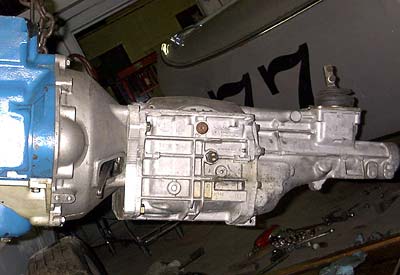 These transmissions are based on the Ford Motorsports T5Z aftermarket trans from Tremec, custom built to our specifications. The heavy duty T5Z has a cluster gear reinforcing plate and stronger fifth gear to meet the needs of customers whose street or track use requires a T5 with higher HP capacity and a close ratio fifth gear that can be used for acceleration rather than just highway economy cruising. The combination of both a 2.95 first and .80 overdrive 5th gear, a combination not normally available, make this a close ratio trans. Also available with .73 or .90 fifth gears. We now also offer an economy version which leaves out the reinforcing plate and uses a stock type .73 5th gear, saving $300 in the initial cost and giving better highway fuel economy in most applications.
These transmissions are based on the Ford Motorsports T5Z aftermarket trans from Tremec, custom built to our specifications. The heavy duty T5Z has a cluster gear reinforcing plate and stronger fifth gear to meet the needs of customers whose street or track use requires a T5 with higher HP capacity and a close ratio fifth gear that can be used for acceleration rather than just highway economy cruising. The combination of both a 2.95 first and .80 overdrive 5th gear, a combination not normally available, make this a close ratio trans. Also available with .73 or .90 fifth gears. We now also offer an economy version which leaves out the reinforcing plate and uses a stock type .73 5th gear, saving $300 in the initial cost and giving better highway fuel economy in most applications.
HD T5Z with cluster gear reinforcing plate and stronger than stock .80 5th gear. With stock shifter $ 2195. With billet Slick Shift shifter $2395.
Economy version T5Z with 2.95 1st and .73 5th. With stock shifter - $1895. With Slick Shift shifter - $ 2095.
The Slick Shift shifter that allows the shifter position to be moved back several inches - ideal for the 700 and 900 series Volvos - . Email for details.
T9 5 Speed Transmission
The perfect replacement 5 speed transmission, expecially for those pre - 1970 Volvos or other cars with narrow trans tunnels. Sometimes known as the "German 5 speed" this is one of the most widely used 5 speeds in Europe. Most commonly in the Ford Sierra, it came to the US in the Merkur, XR4Ti, and some 4 cylinder Mustangs. It is the most widely used transmissions to upgrade to a true 5 speed trans in British sprots cars. While not a trans that I would use with a 300 + HP turbo motor, it's a vary good candidate for normally aspirated motors, is small enough to fit in most transmission tunnels without modification, and is quieter than the T5. In an 1800 the shifter comes out in the same location as the stock M41 shifter. For racing applictions there are both close ratio synchro and dog ring versions.
Below are the specifications and prices for rebuilt T9 transmissions that we previously offered. Due to problems in getting these from a builder in the US, there have been times when these have not been available. Supply may be better in 2018 but at prices higher than those listed below. Email for current details. Other options include finding a good used T9 in the US or purchasing from suppliers of rebuilt T9 transimissions in the UK.
Street, standard ratio version - ratios are 3.65 1st, 2.97 2nd, 1.37 3rd, 1.00 4th, .82 5th. - - Email for current availability and price.
Recommend semi-close ratio version - the ratios are closer to Volvo ratios - 3.36 1st, 1.81 2nd, 1.26 3rd, 1.00 4th, .825 5th - $1975. - Email to confirm current availability and price.
Transmission dimensions: 23.5" overall from transmission face to end of tail; 22" from transmission face to center of shifer; width 7"; height 10"; input shaft length 190 mm.
Three different input shaft lengths are available - ( Note that the short input shaft and Merkur versions work with our adapter plate for Volvo B18/B20 engines. The Merkur requires shortening of input shaft - a very easy modification. The short input may require a thicker than stock pilot bearing. ) Without modifications our adapter plate will not work T9s that have a external support, sometimes labeled as a stub, protruding from the case at the end of the lower shaft.
Short input = 177 mm = 6.97 inches
Merkur input = 194mm = 7.625
Scorpio input = 208mm = 8.19
.
T9 with adapter plate and Volvo B20 bell housing.
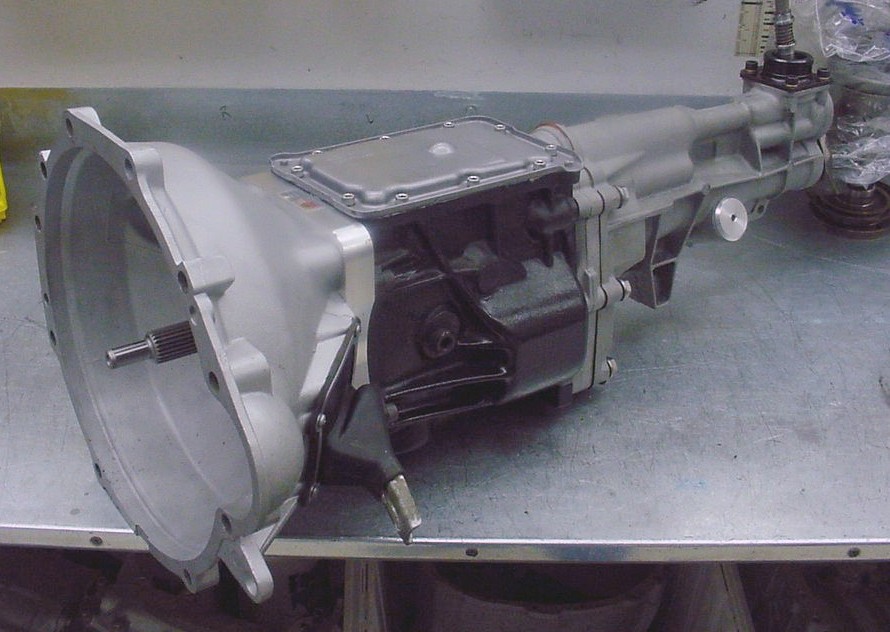
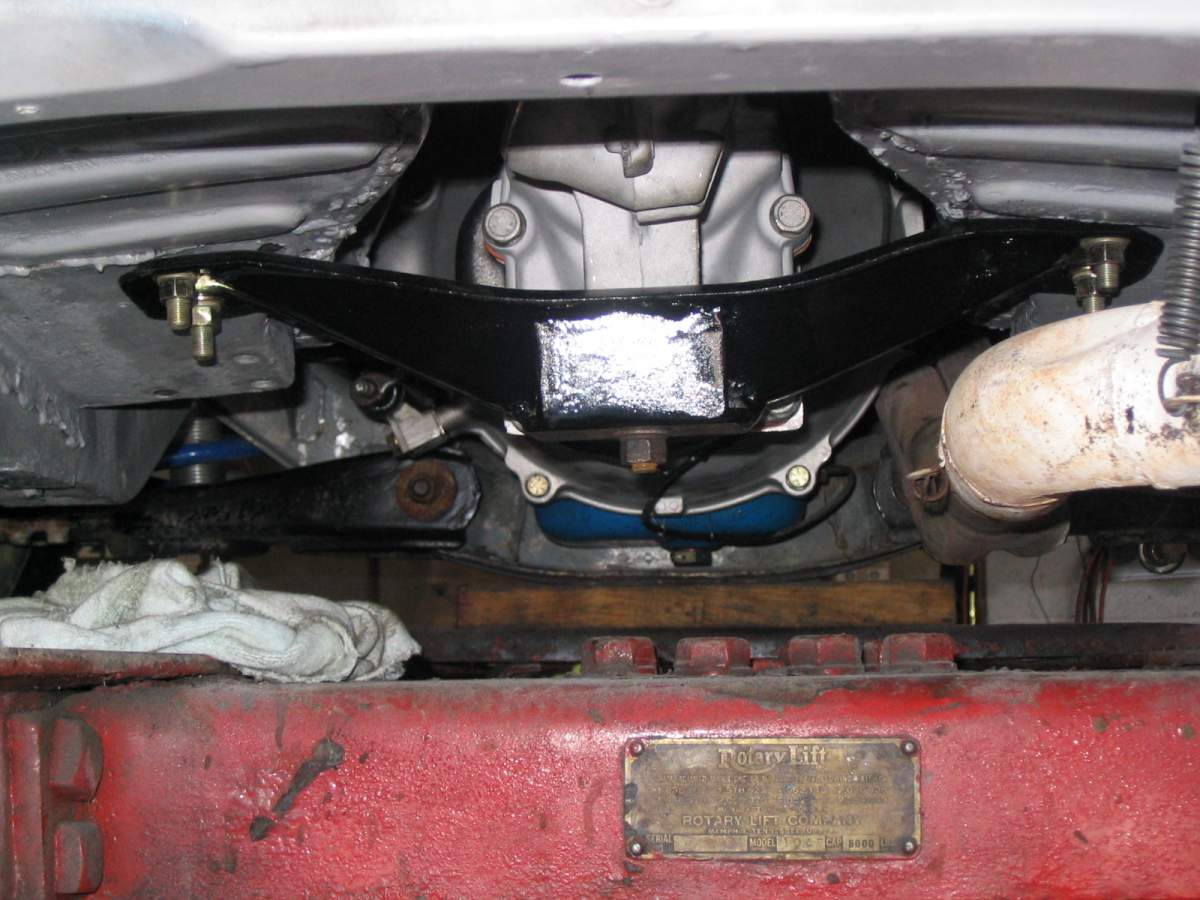 |
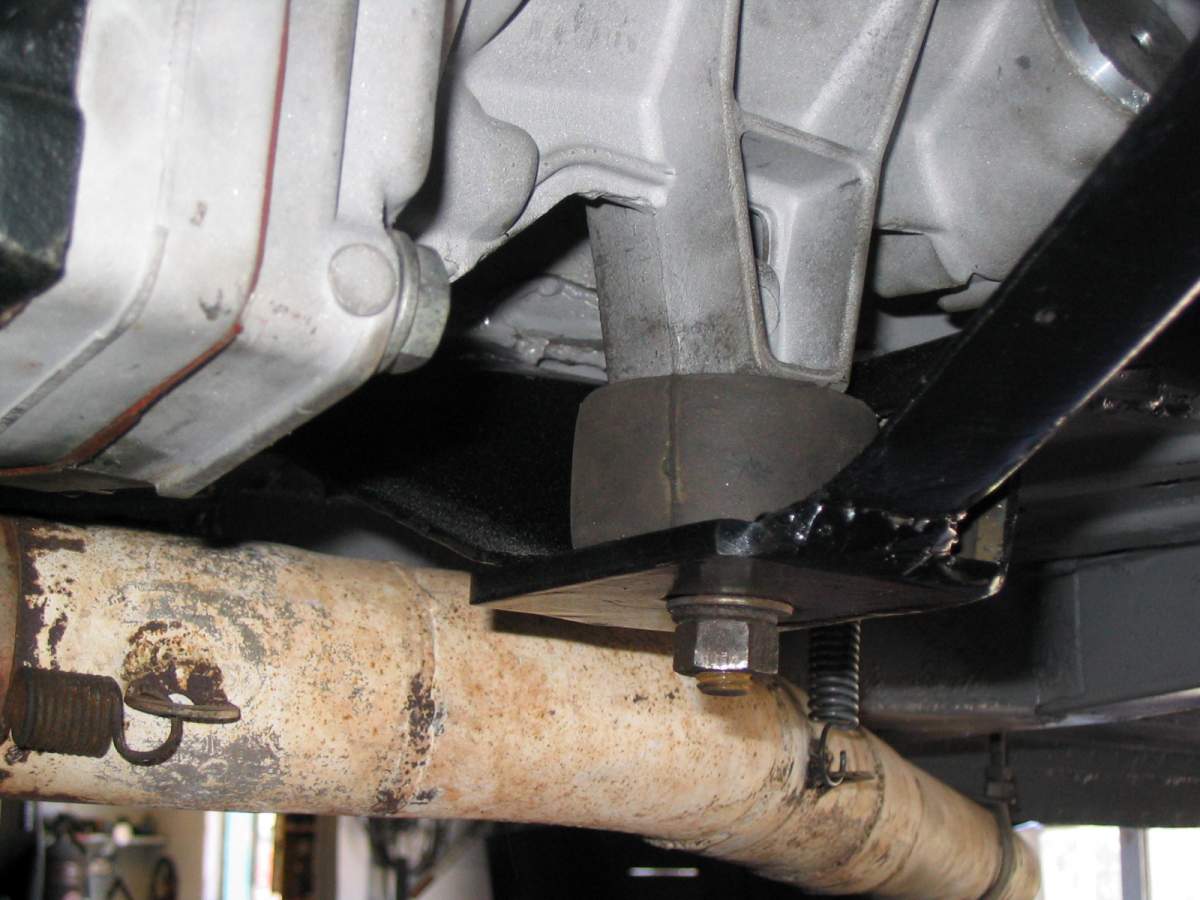 |
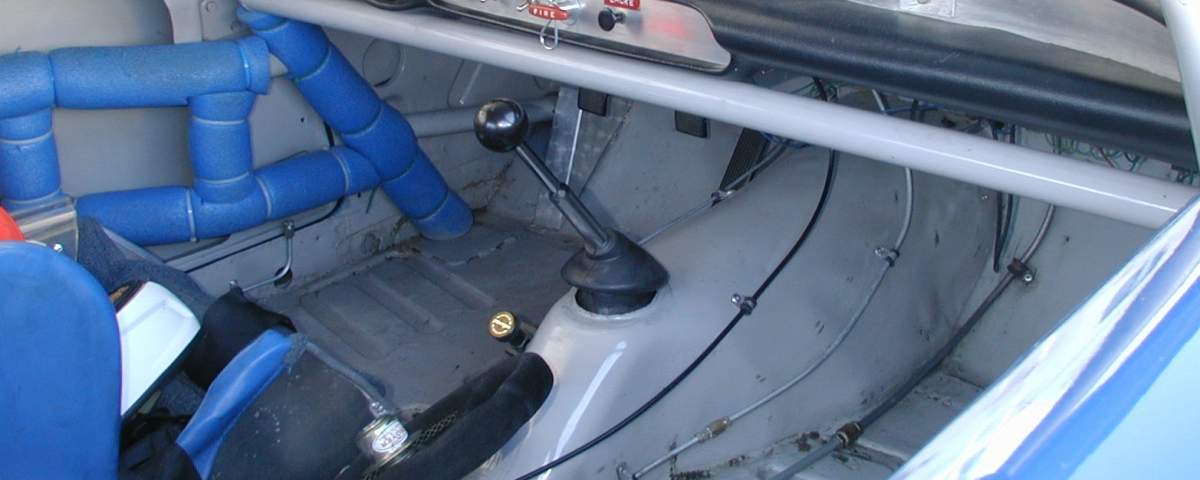
T9 5 Speed Transmission Swap
Unlike the T5 swap, the T9 Transmission swap into a Volvo 1800, 122, 140, or 544 uses the stock Volvo pilot bearing, release bearing and clutch fork. Modifications to the transmission input shaft sleeve, the Volvo bellhousing, the front section of the driveshaft, the transmission crossmember, and in some models its location, are required. The shifter location is approximately the same as the rear shifter location as in an 1800, or 123GT. ( Note that only the short input shaft version works with our adapter plate for Volvo B18/B20 engines without modificatoin. ) Parts that would normally be purchased are as follows:
- T9 to B18/B20 bellhousing adapter plate - $195
- T9 adapter plate with modified bell housing - allows the transmission to be installed or removed with the bell housing attached to the engine - $295 + $100 bell housing core charge if one is not provided
- Clutch disc with correct splines for the T9 - Severe duty organic discs- $140 - High performance 8.5 " kevlar discs - $195
- Slider Yoke - $110 Slider Yoke modified for a better fit in the trans tunnel - $ 160 ( required on most pre-1970 Volvos - parts cores may be needed )
.jpg) |
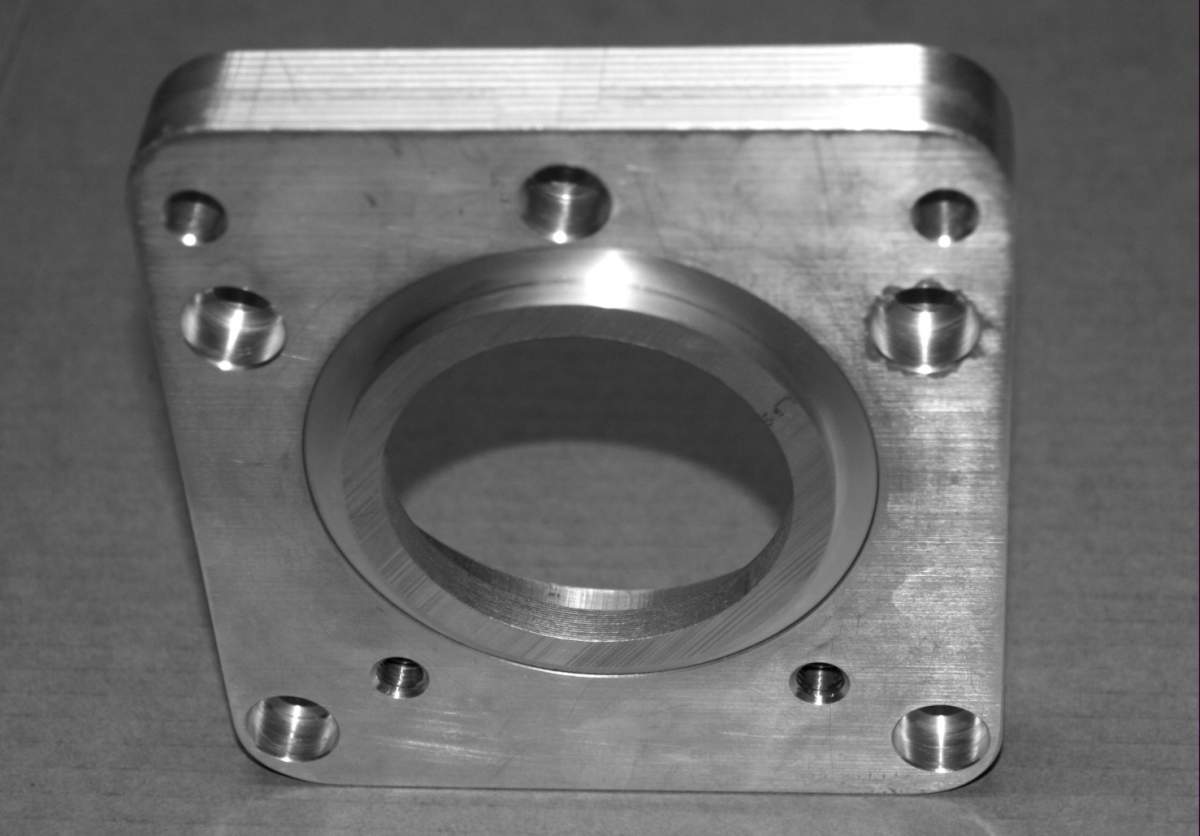 |
Modifications to the transmission, bellhousing, transmission crossmember and driveshaft would normally be done at our shop or another shop where the car is located. The driveshaft modification - attaching the slider yoke and rebalancing - should be done by a specialty driveline shop. In order to use the Volvo release bearing, the transmission input shaft sleeve is slightly reduced in diameter by turning on a lathe. The bellhousing modification is simply drilling additional holes for bolts to attach the adapter plate to the bellhousing as shown in the photos below. As the assembly process involves bolting the adpater plate to the transmission, and then bolting the bell housing to the adpater plate from inside the bellhousing, the transmission and bellhousing have to be installed as a unit. However, a new version of the adapter plate, with modified bellhousing, allows the transmission and adapter plate to be bolted to the bellhousing from the transmission side, allowing the transmission to be installed or removed with the bellhousing still attached to the engine.
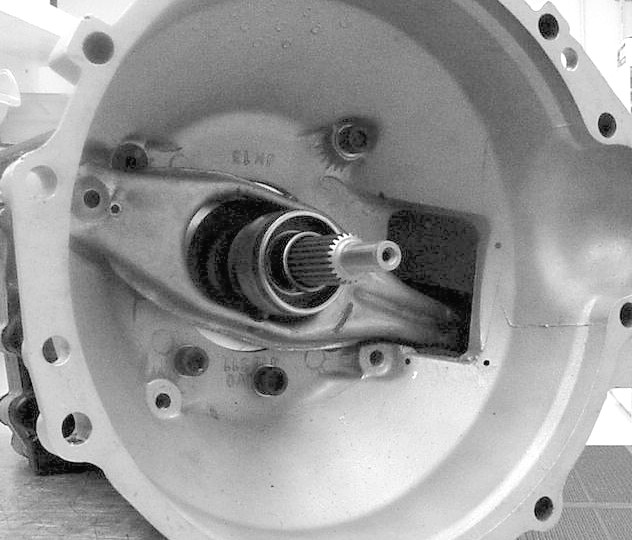 |
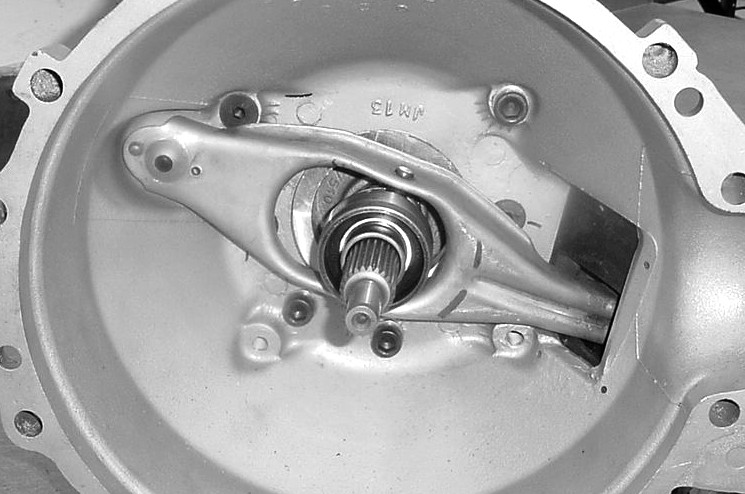 |
T9 transmission installation notes:
1) use a stock T9 gasket or other sealing method to seal the transmission to the adapter plate. around the reverse shaft above the input shaft and the layshaft under the input shaft. There is a clearance hole in the top of the adapter plate that is needs to be sealed to the transmission and bell housing.
2) Fit the bell housing to the adapter plate in order to mark the holes that have to be drilled in the bell housing for the bottom two bolts. Then remove the adapter plate from the bell housing and bolt it to transmission using the stock transmission gasket to be sure of a seal between the adapter plate and the transmission. ( The front of the transmission is not itself sealed and will leak transmission oil around the top shaft which moves in and out when shifting. ) The bell housing is then bolted to the adapter plate and the transmission, adapter plate and bell housing have to be installed as a unit. If using a modified bell housing, the transmission and bell housing can be installed separately, which requires less clearance.
3) The T9 with the short input shaft 6.97 is just long enough to get sufficient contact with the stock pilot bearing. As exact dimensions may differ slightly from one motor to another, you should check to be sure there is sufficient bearing contact. Where there is an isssue of sufficient contact we have used a thicker pilot bearing which is .625 instead of the stock .400 inches thick. Its too long to be used with the retaining clip so you need to make sure that its securely in place and should use loctite to secure.
4) The next longer input shaft 7.625" is too long to be used with our 1" adapter plate, unless it is shortened which is a quick process. It is important that it does not bottom out in the crank, as any pressure on the crank will quickly wear out the crank thrust bearing.
5) You can convert the Volvo speedo cable to work with the T9 by using an end off of a Merkur cable.
6) reverse switch - depending on the model year of car the trans might not fit in the tunnel with the reverse switch installed. Do a trial fit to determine where the reverse switch is going to be lined up and cut a hole in the side of the tunnel that can be used to install the switch through. Make a small plate to cove the hole and put a bulge in the plate to allow enough room for the connector that goes on the switch. When purchasing the transmission get the connector with the transmission.
7) slider yoke - on early cars - most pre 1970, there will not be enough room in the tunnel for the standard T9 slider yoke. Rather than modify the tunnel we can provide a modified yoke with a smaller universal joint that will clear. Parts from a stock Volvo driveshaft are required for this conversion.
Custom Shift Knobs
.jpg) |
A customer needed a shift knob for his T5 conversion and there was no time to order one, so I made one out of some aluminum that was on hand. It came out so nice that I made a few more and can now offer them for the M40/41, T5 and T9 and many other transmissions. It adds a really nice solid feel and unique custom look to your shifter. Several different custom styles are available, or just tell us what you want it to look like - makes a great gift - $50 |
Cars
Custom Racecar Development
P1800 Vintage Racecar -
An example of the racecars we build and can build for you.
Volvo Wins at Indy 2014-06-12
That's a Volvo 1800 winning its class and group at the SVRA Vintage and Historic races at Indianapolis Motor Speedway last weekend. After spending time with us for an engine rebuild and power boost this spring, the familar blue 1800, #68, now owned and driven by Volvo Trucks NA President Goran Nyberg, won its first time out after going through a few days of initial issues with the rebuilt, more powerfull, B20 2 L engine. Still using the head, crank, rods and pistons from its original build in 2001, by applying continued developments in porting, cam design, rocker ratios and carb tuning we were able to boost its peak power while at the sime time giving it a much broader power band - enough for it to win first time out over a field of 70 cars in its group - with a very good driver. To give you an idea of some of the work involved in coming up with the right combination of changes, we did 80 flow bench tests and 47 dyno test runs which included testing 2 different cam designs, two distributors, three different sets of rocker ratios, two different intake manifolds, two carb sizes, several different main venturi sizes, and many different jet combinations.
Sold and shipped to the UK where it raced in 2012 ! But now back in the USA. See the above result.
Below is the old listing. This car is not currently for sale, but we can build another one like it, with upgrades, to your specifications.
$22,000 for the car with spares. $27,500 for the car with enclosed trailer for a complete ready to race package.
This car is a good example of the vintage racecars that we have built and can build for you - now for sale after 10 years years of successful racing with numerous podium finishes. Its setup and equipment are typical of our vintage racecars. Nick Julian did a beautiful job on the body as shown in the photo below. The engine is our 2 liter vintage race engine with dual Weber 45 DCOE carbs, forged pistons, BHP cam, Crower rods, baffled oil pan, ported race head, 13 to 1 compression ratio, dynoed at over 200 HP. The suspension includes Carrera adjustable shocks, race springs and adjustable front sway bar. The car has 4 wheel discs brakes, Tilton brake cylinders with adjustable bias, aluminum flywheel, Tilton 7-1/4 inch clutch, t 9 transmission with Quaife close ratio gear set, fire system, a full set of gauges including exhaust gas temp gauges reading each cylinder, etc.
How much would it cost to build one like it ? - $30,000 - $40,000 depending on parts details - not including the cost of a good condition, no rust street car as the basis of the build.
.jpg) |
At $22,000 for the car with spares. $27,500 with a very nice enclosed trailer, this is an excellant value for a complete, turnkey, ready to race package that could be delivered to the track ready to go. Let me know if you would like more information.
.jpg) |
.jpg) |
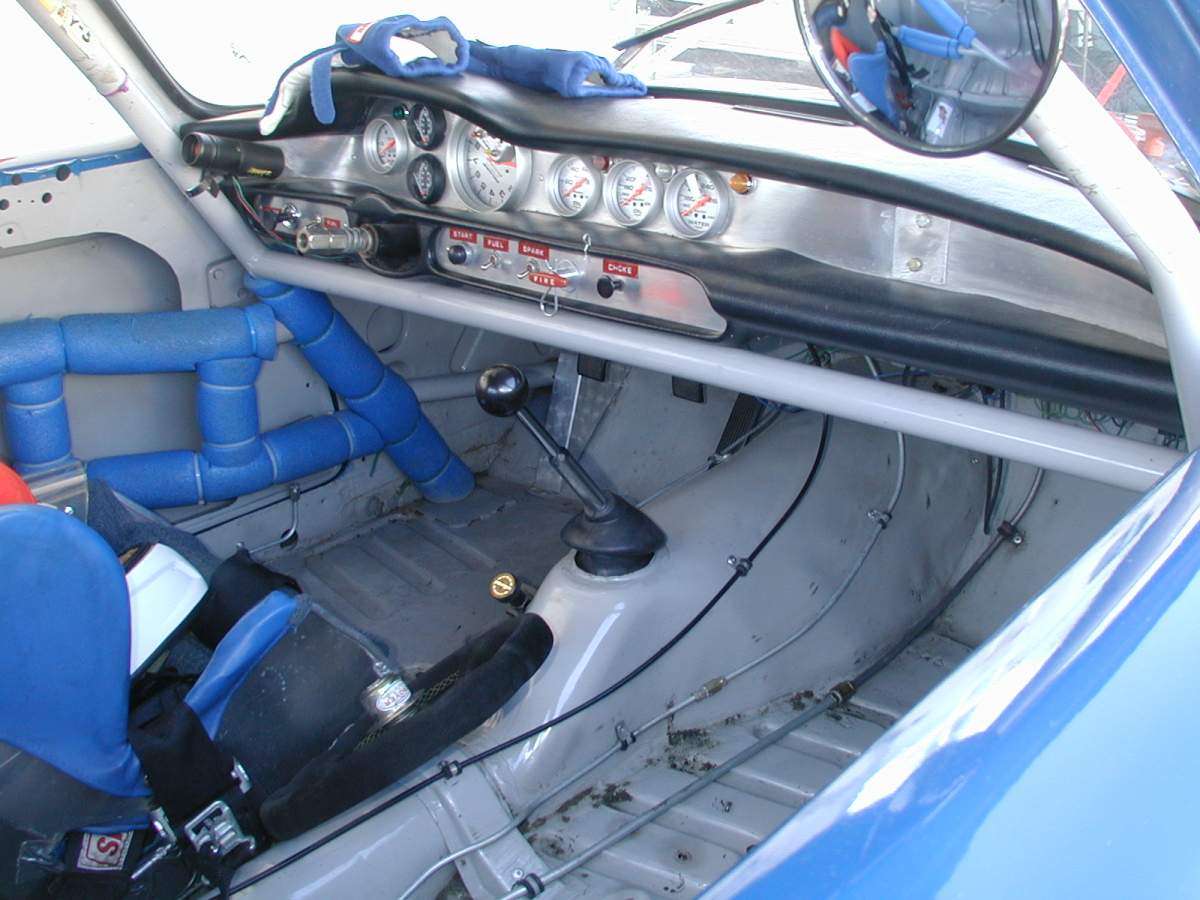 |
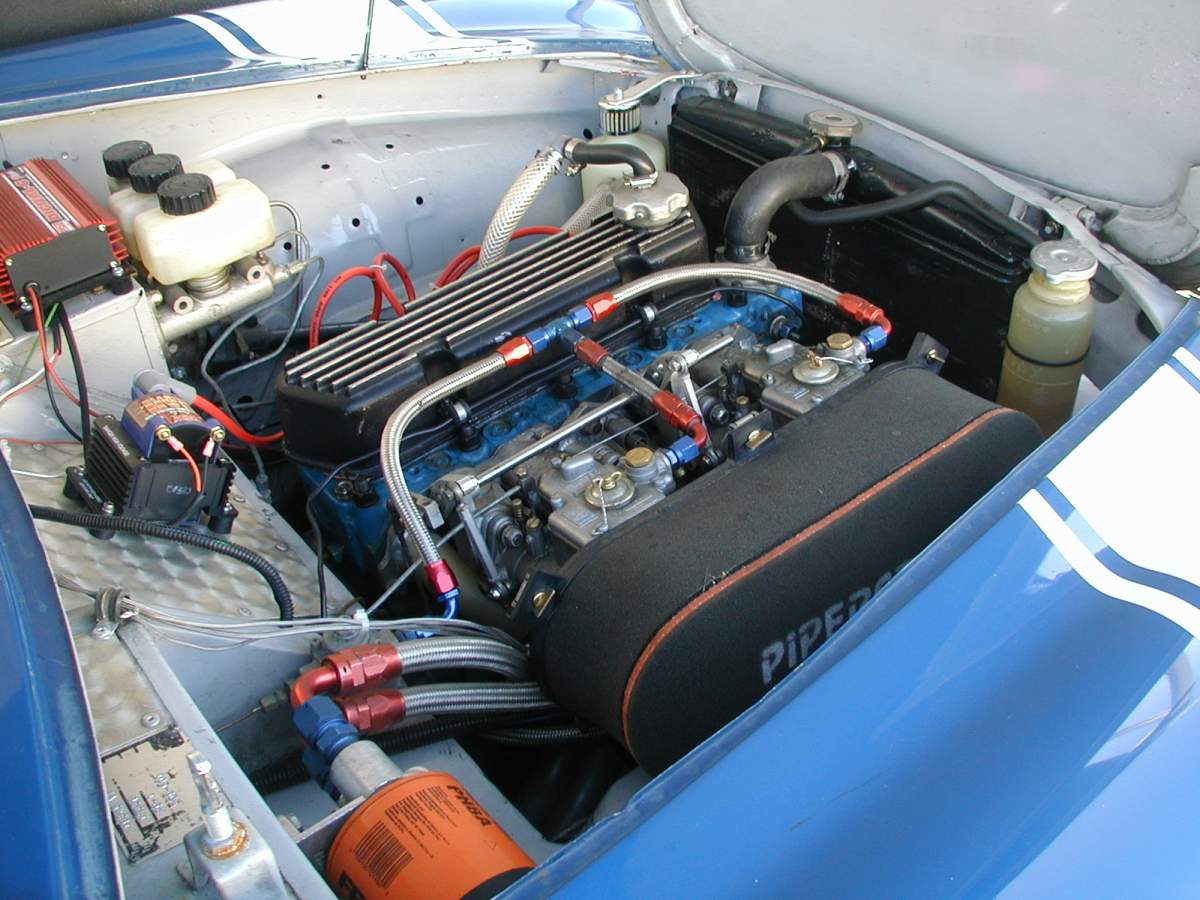 |
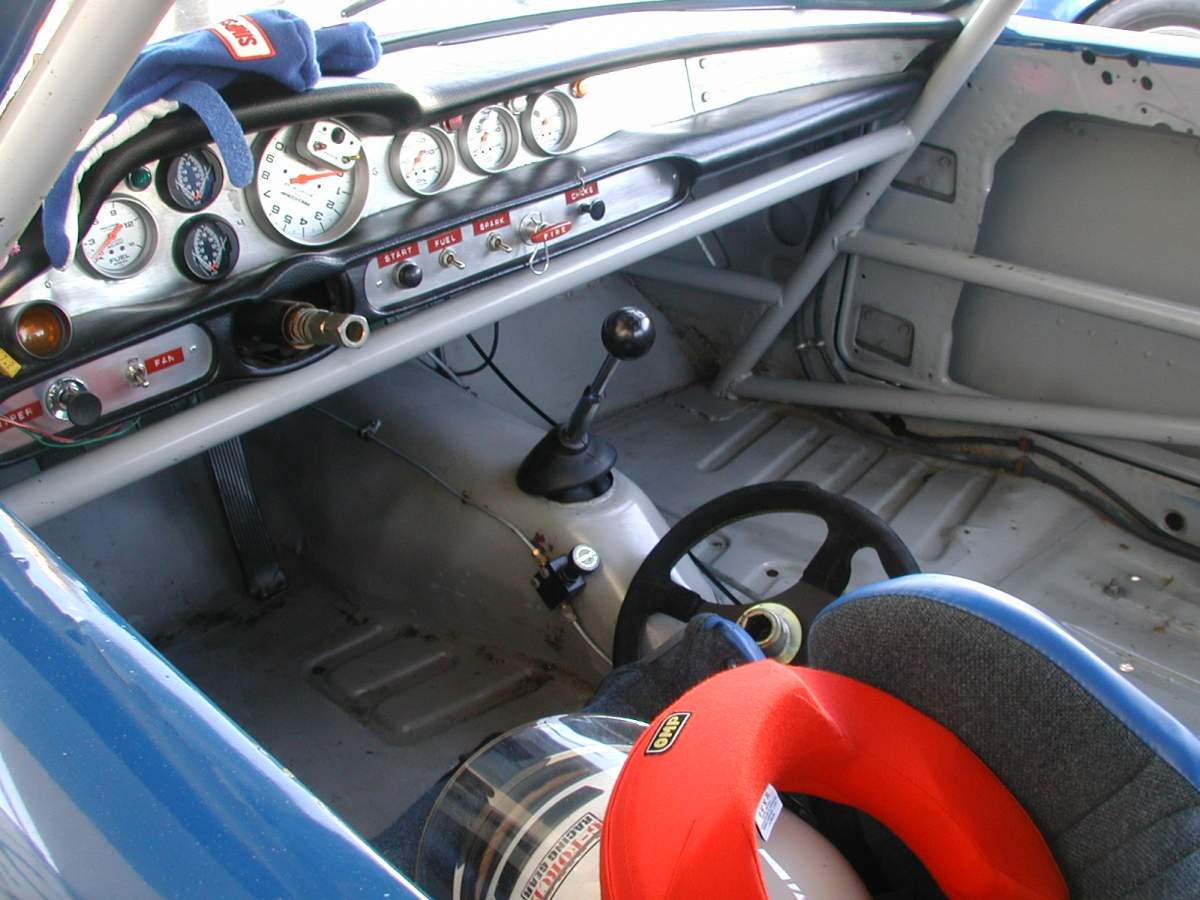 |
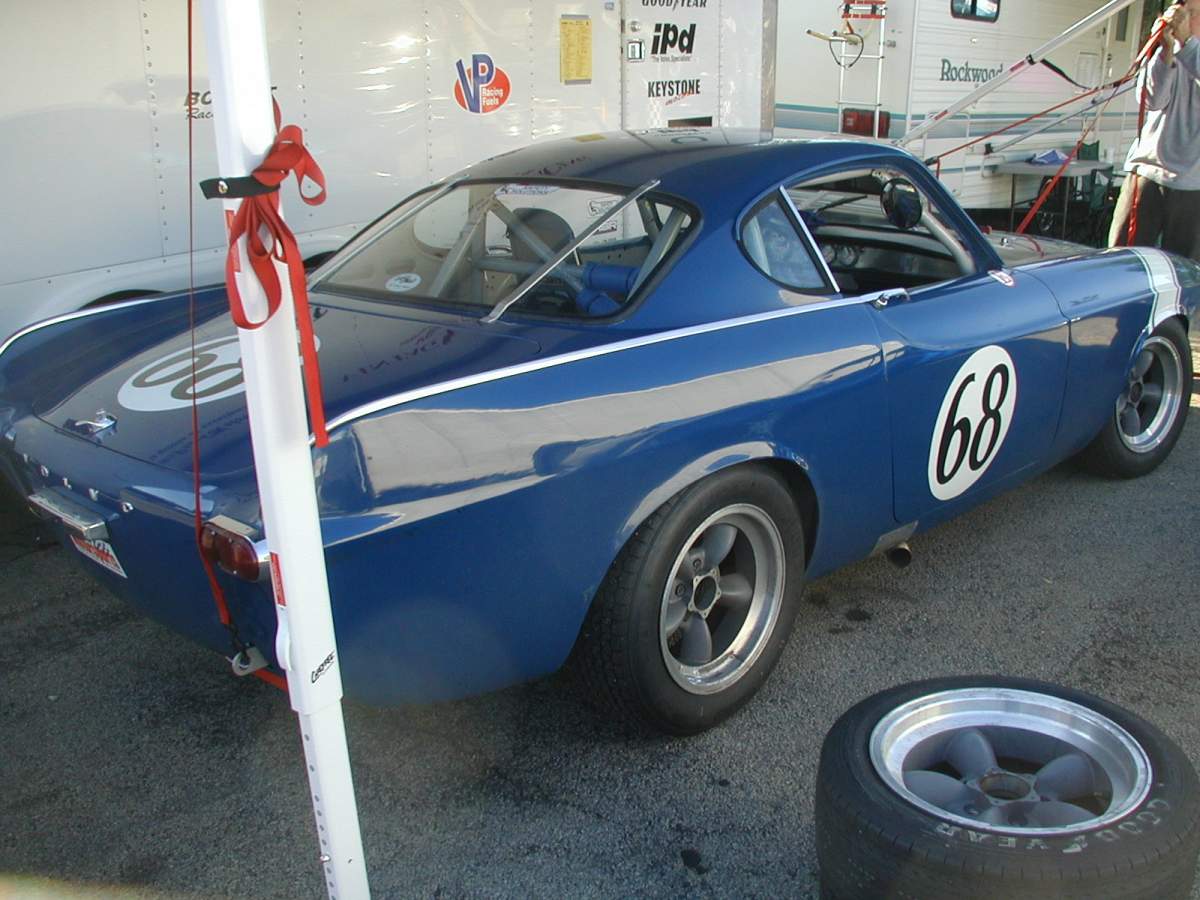 |
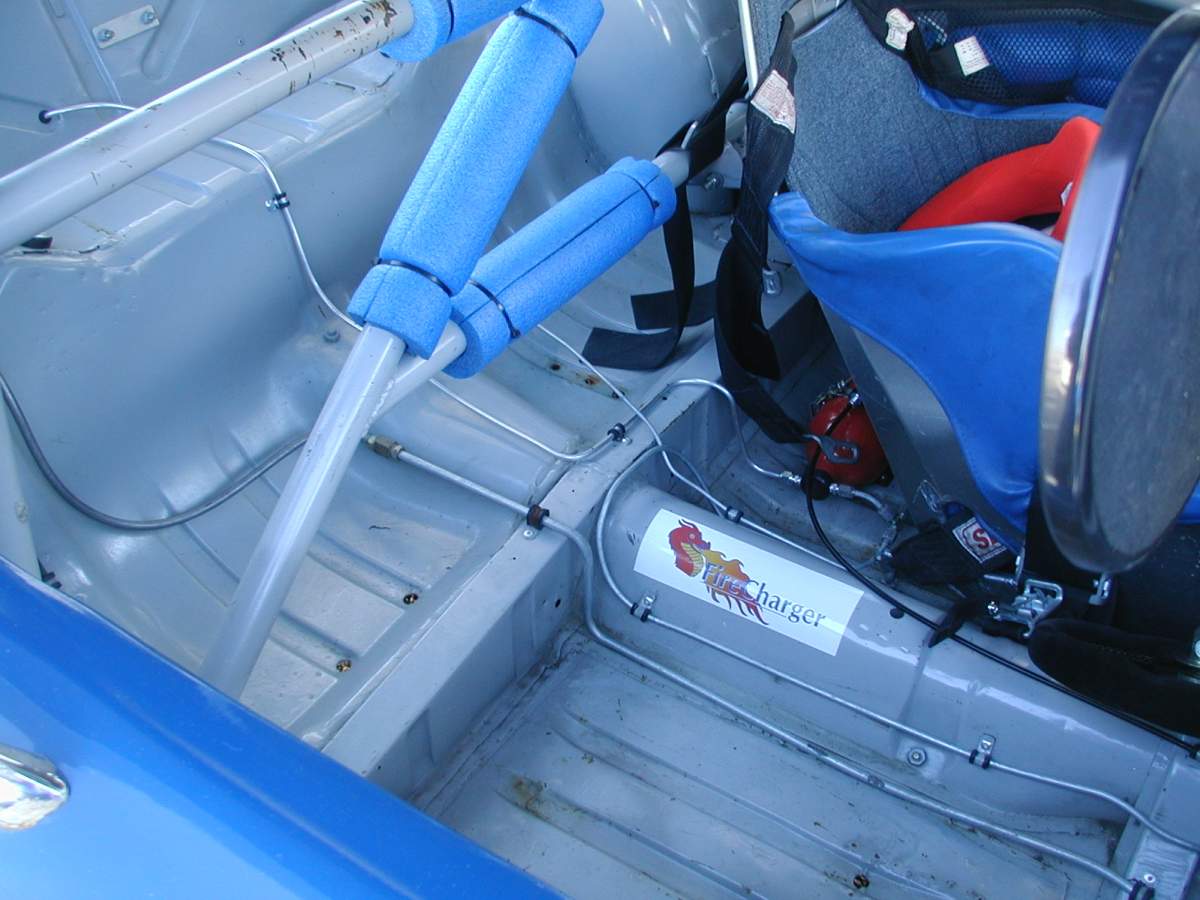 |
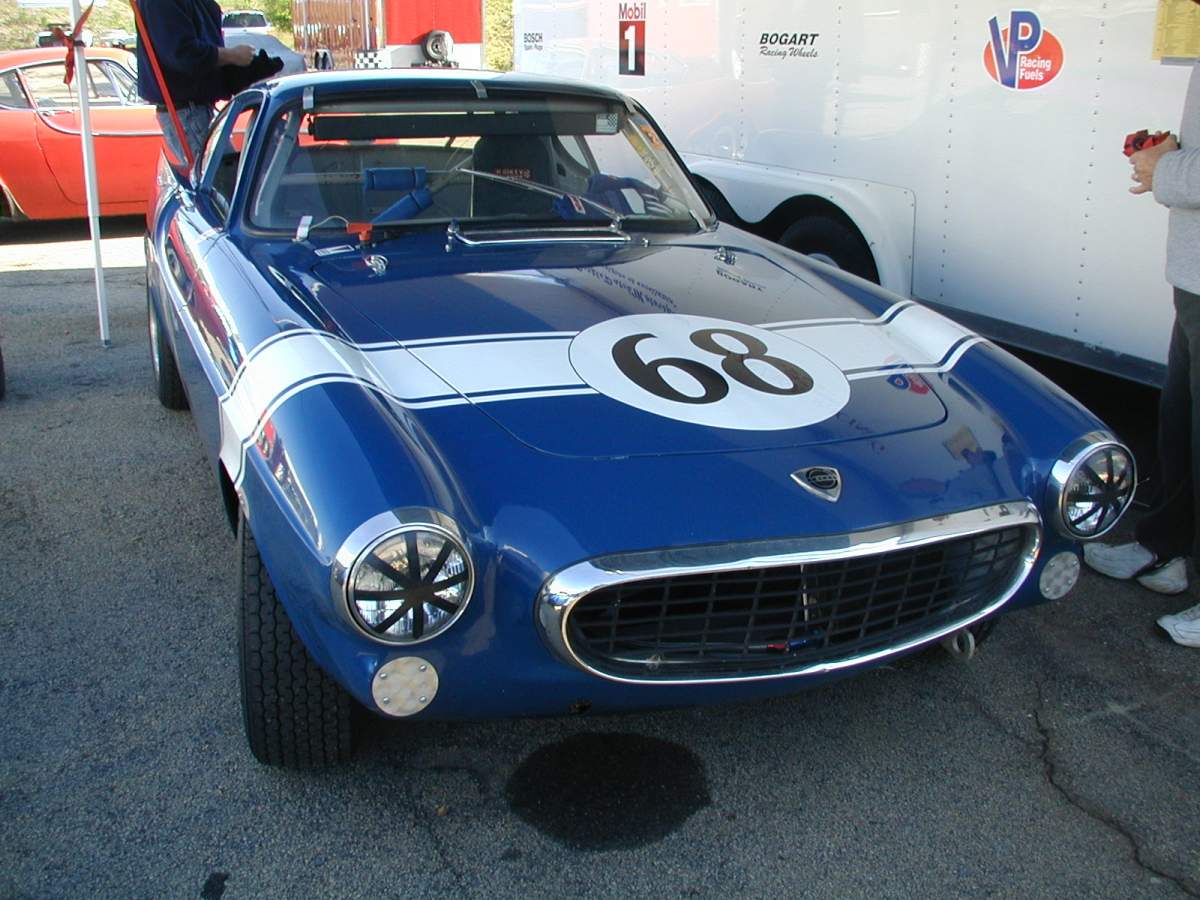 |
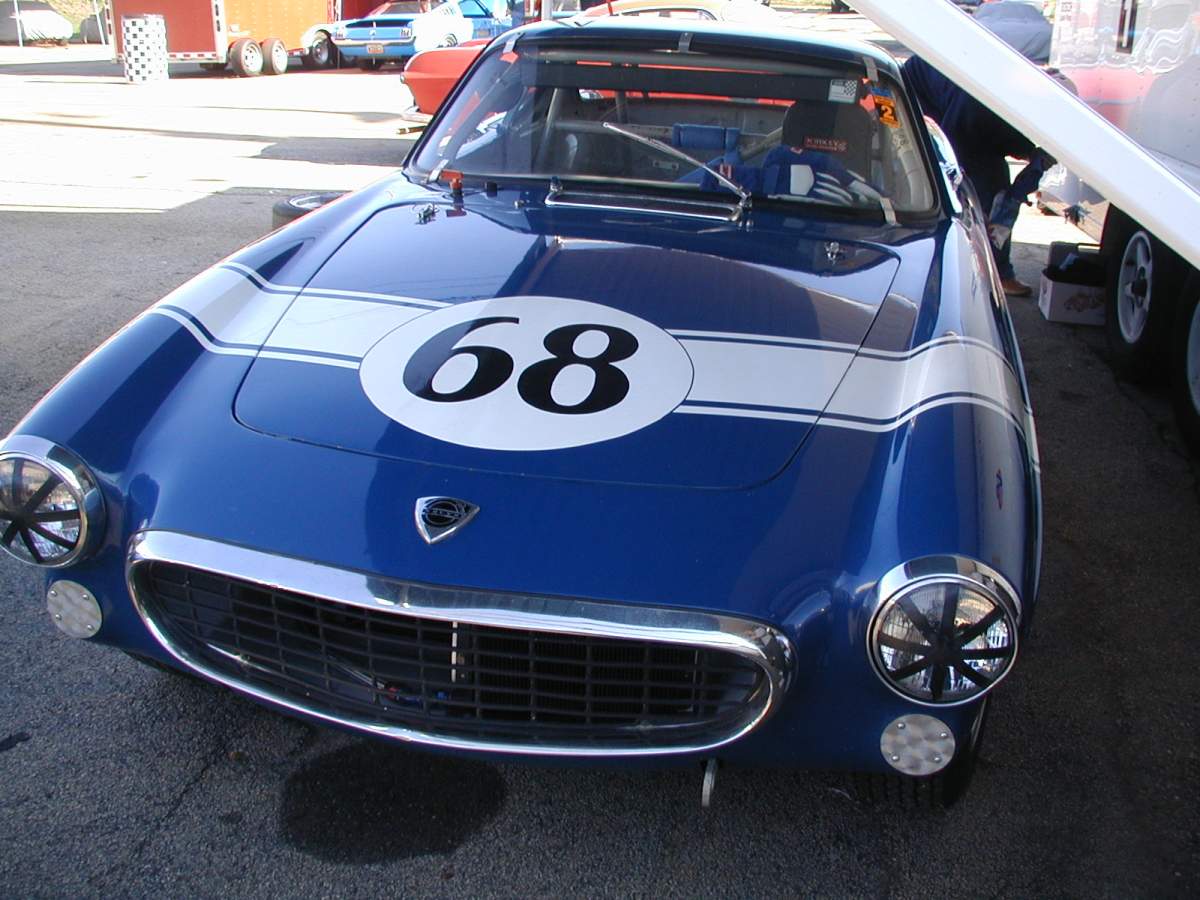 |
1962 P 1800 Sold
One of our customers has asked us to sell his P1800 that is currently in our storage garage. He lives outside of the US and has decided that the cost of transporting the car is more than he wants to spend. The car is in the same condition as when purchased from a restorer in Massachusetts 4 years ago, and has not been on the road since. It has a new interior and comparatively new paint though there are areas that need some additional work. The body is basically solid with no obvious rust problems. Not a show car, but with a small amount of additional fix up it could be a fun daily driver in its present condition, while needing some body and paint work in the future to bring out the car's potential. See photos below. Email me at jparker3@twcny.rr.com for details. $5200.
Sold for $5,000.
.jpg) |
.jpg) |
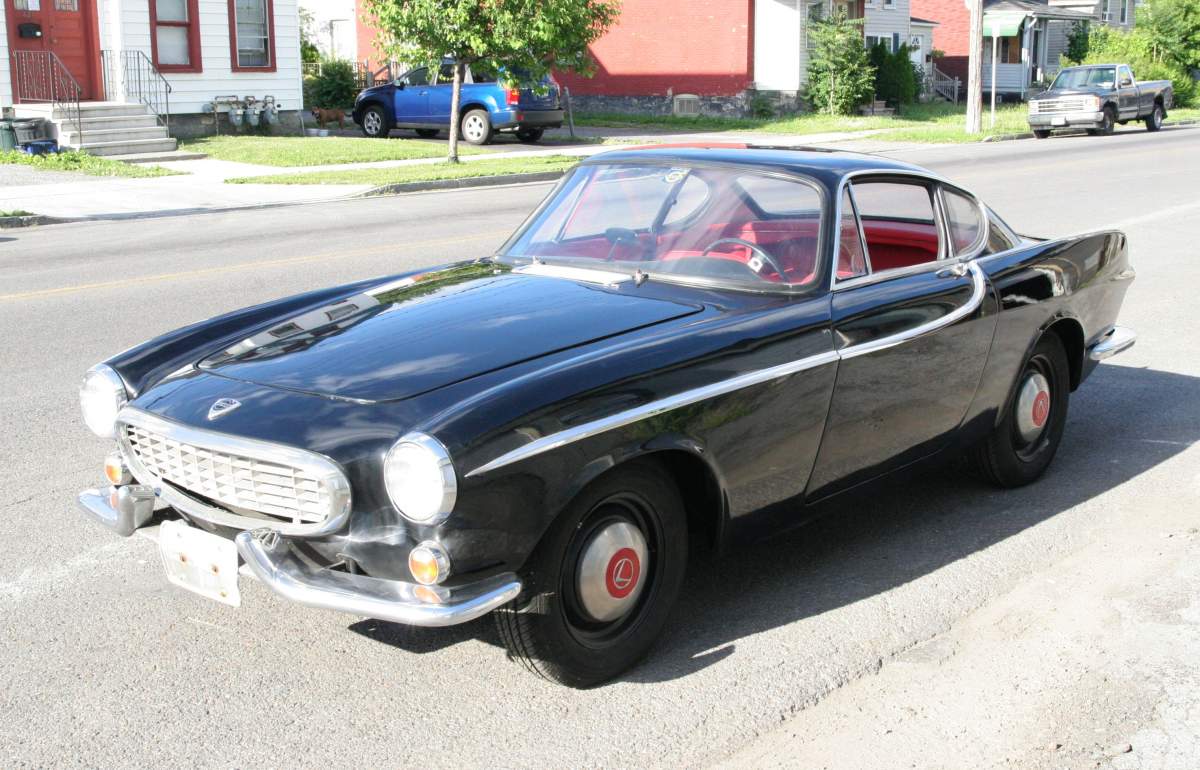 |
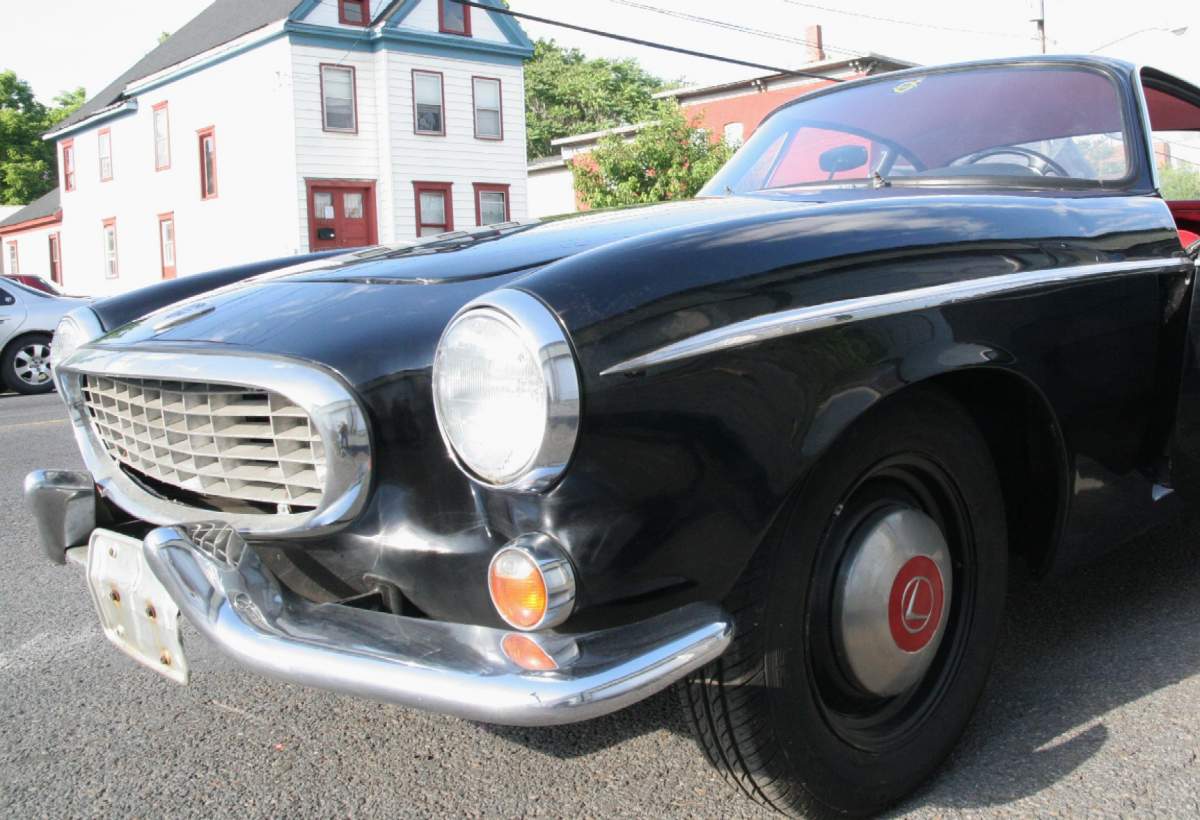 |
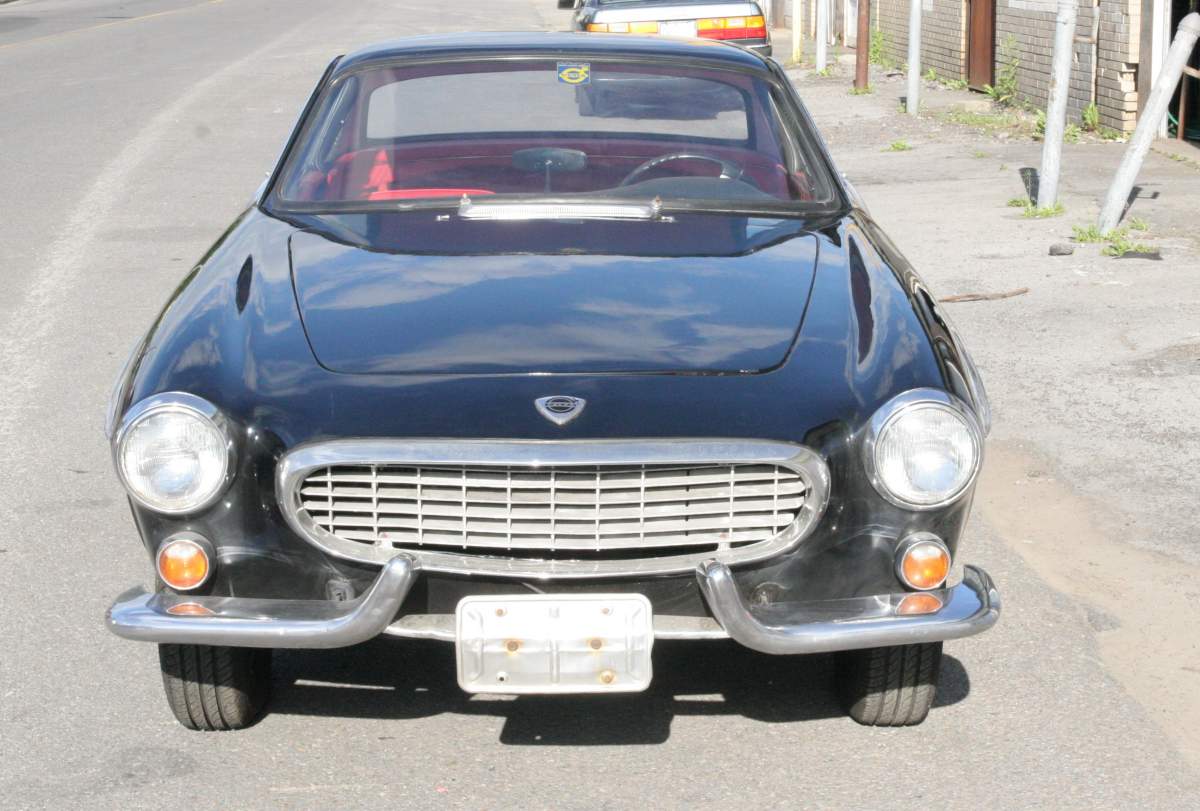 |
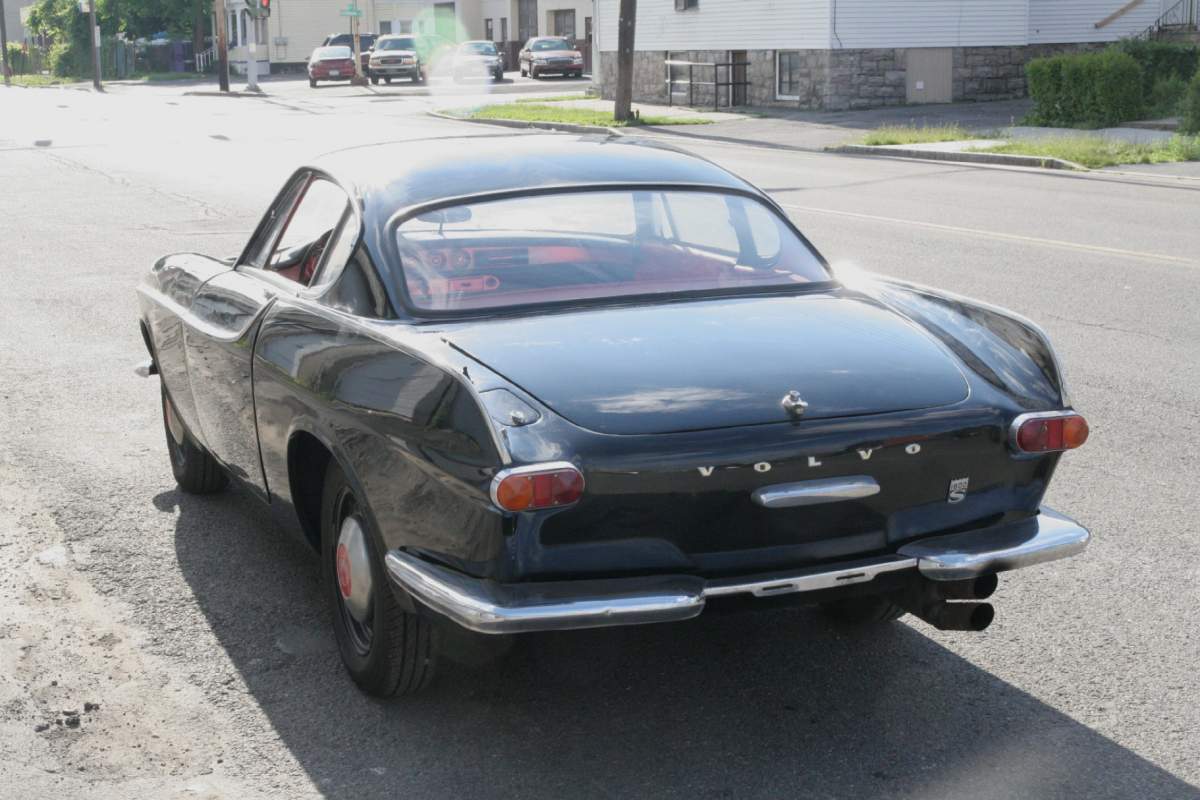 |
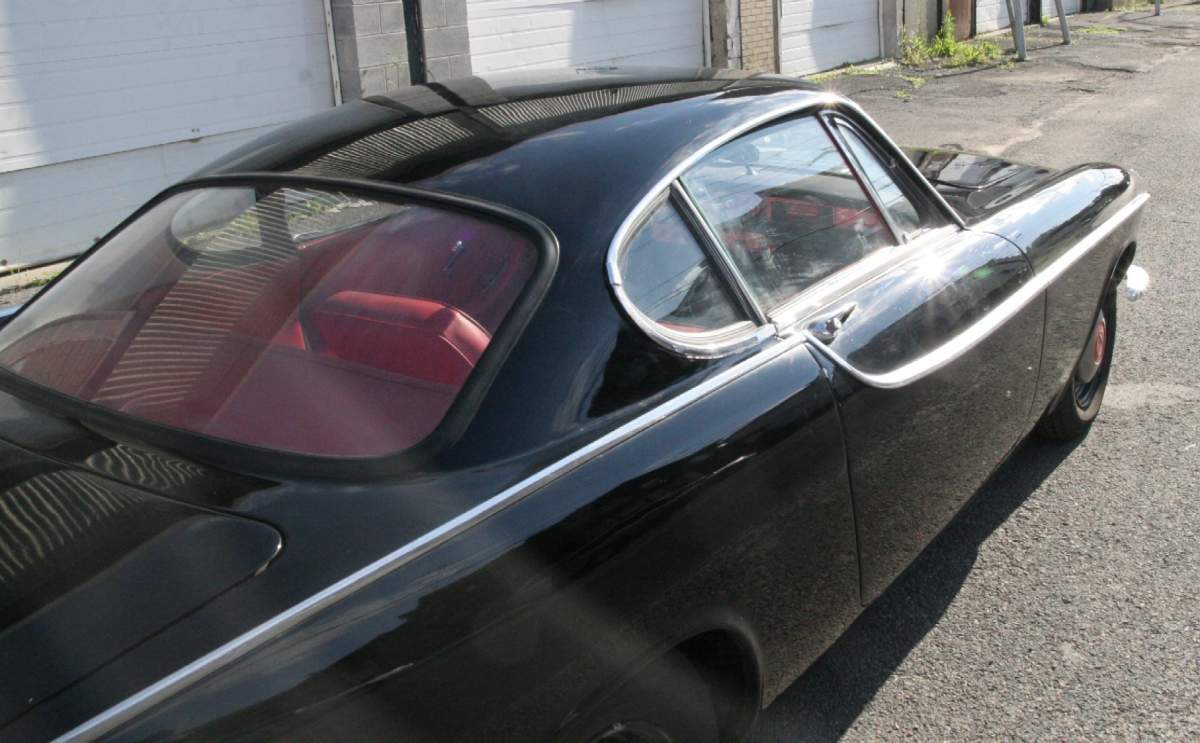 |
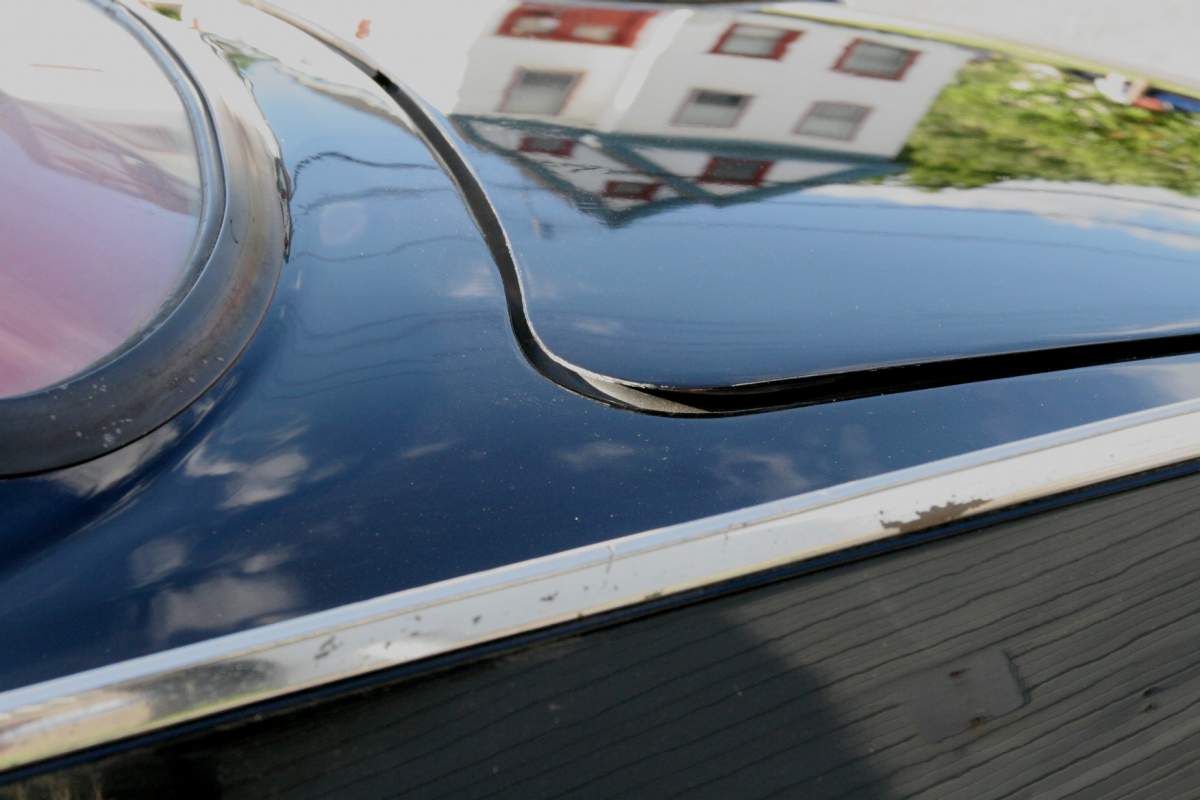 |
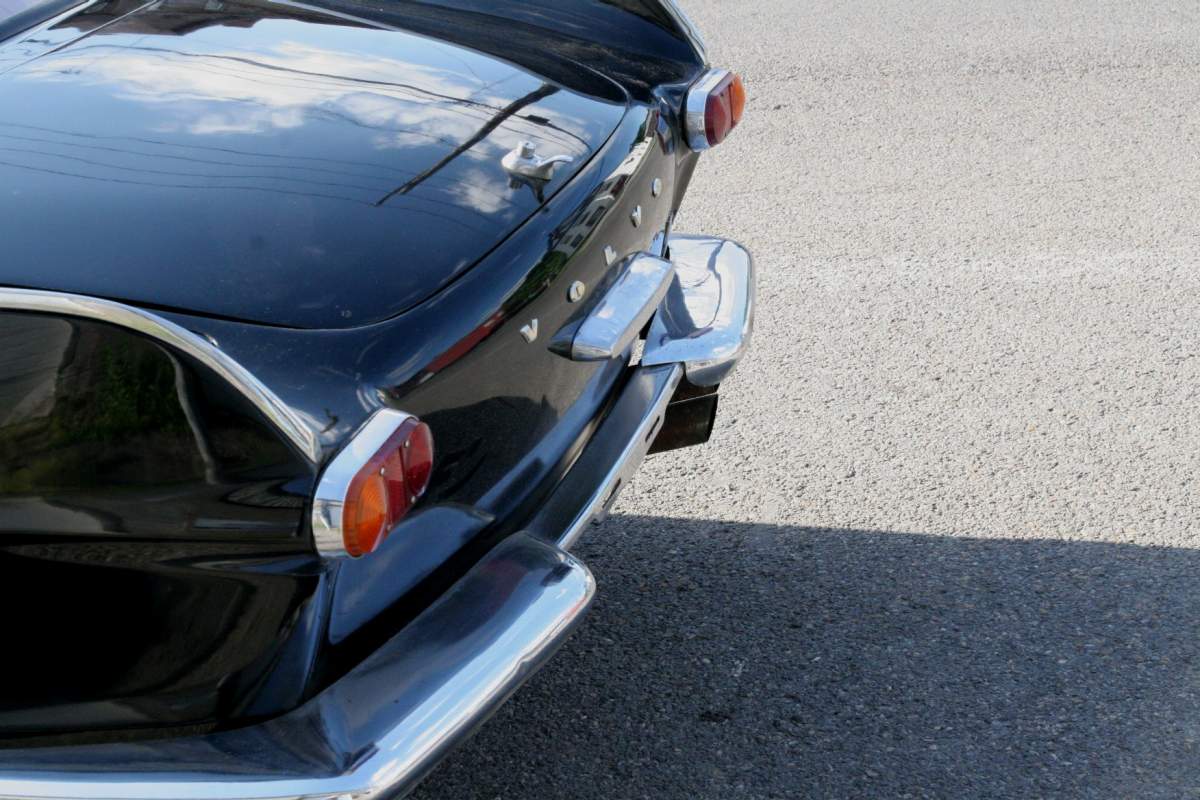 |
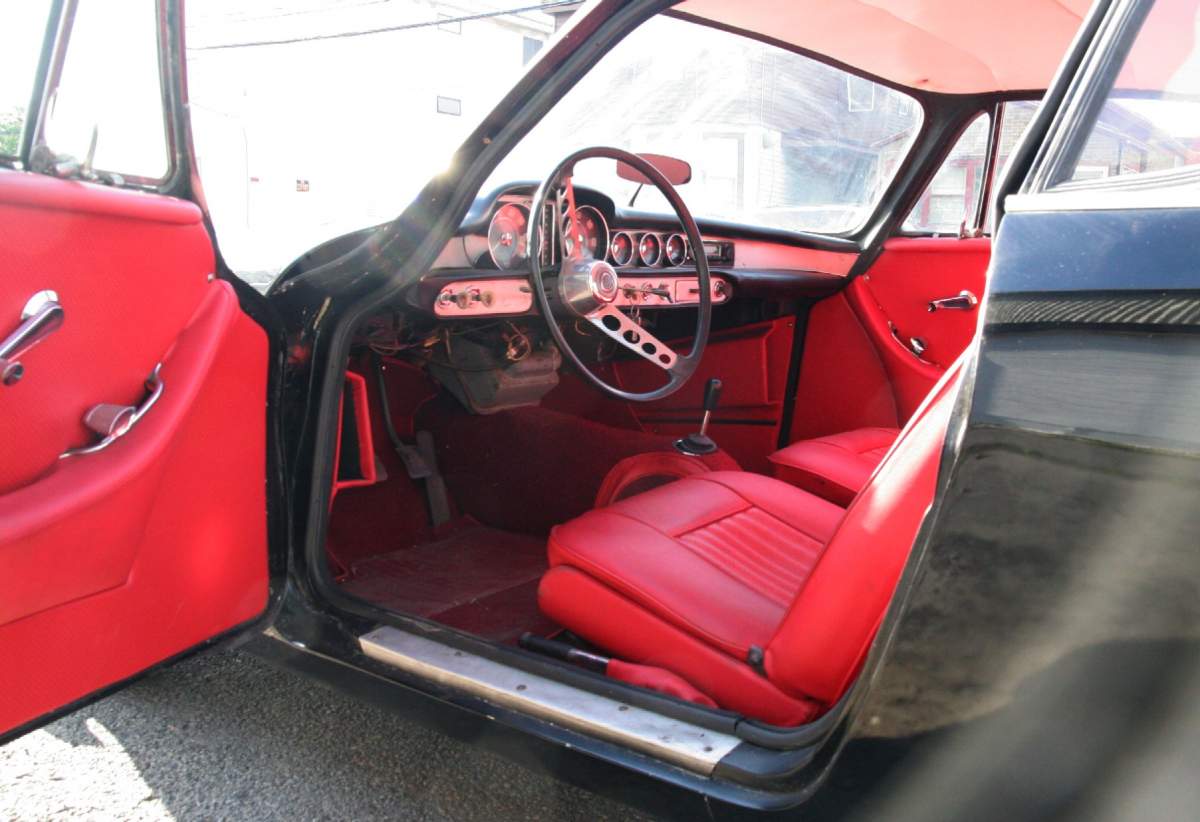 |
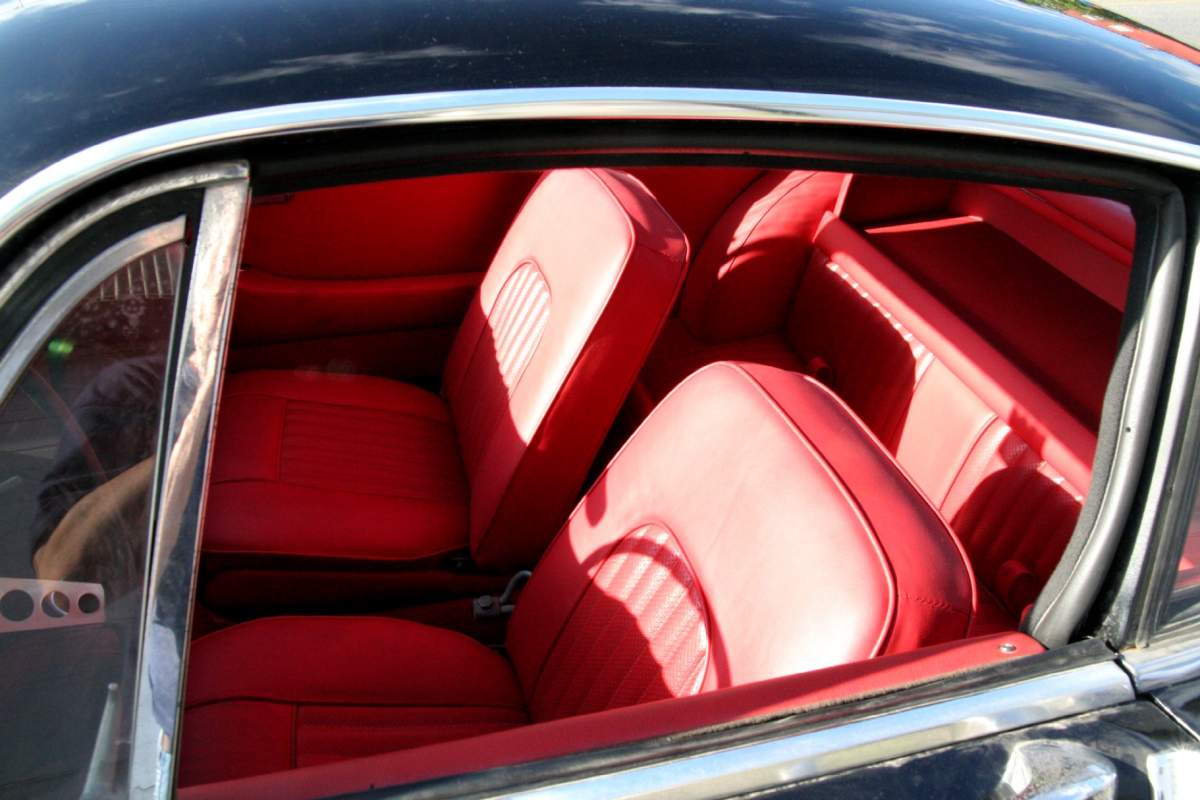 |
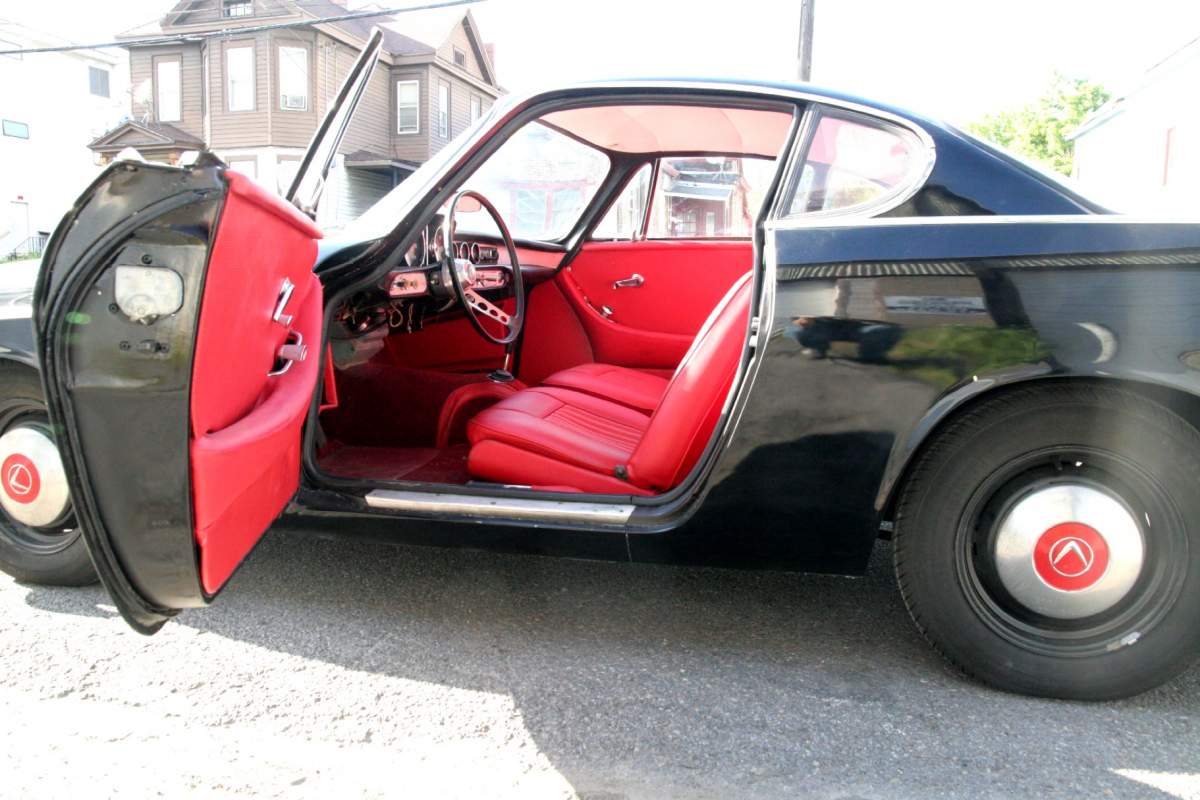 |
Universal Products
123 Distributors for all makes
Under construction. See the ignition section above.
Mikuni Carbs for all makes
Under construction. See the Carb section above.
>> Questions - Order Process - Payments
Questions -Email correspondence strongly preferred. Email with questions on your particular needs as we have many other parts and services available. If we don't have it we can usually get it or make it. If you need to call, the best time and number is usually 315 478 1229 mornings 10:00 AM - 1:00 P.M. eastern US time. Leave a message if there is no answer as we may be in the shop and cannot get to the phone. If we do not answer or call back try cell # 315 440 6560 and leave a message. There are often periods of 3 - 5 days, especially during the summer, when we are away due to other commitments and the office is closed, though shipping and engine work is continuing at other locations. Although I try to return calls and emails even when out of town, some are replied to when we return.
Orders - The easiest way to order is to send an email listing your parts order along with your address and we will reply with information on parts availability and a total price with shipping. Please include information indicating the car model & year with each email, and indicate under "subject " the make of the vehicle and type of part you would like to order. This will keep it from being filtered out as spam.
Payments - Payments are normally made by check, credit card, or through Paypal (www.paypal .com) Payments made by Paypal should be made to the account under our email address: jparker3@twcny.rr.com, or we can send you a paypal invoice. We also accept bank wires for larger amounts.
© Vintage Performance Developments 2024

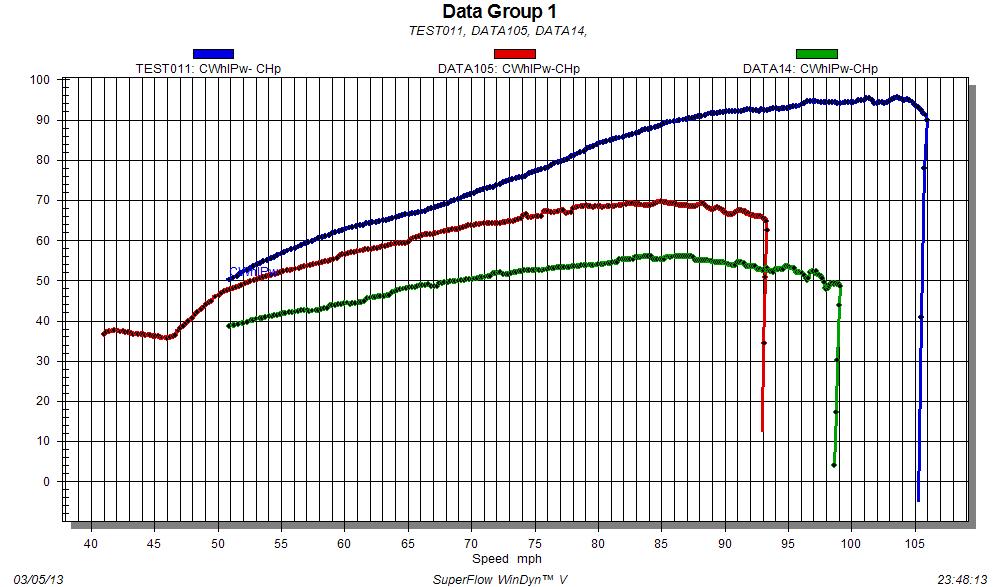
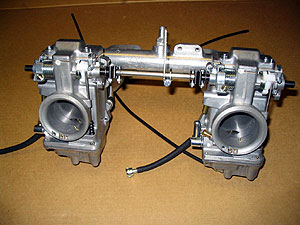
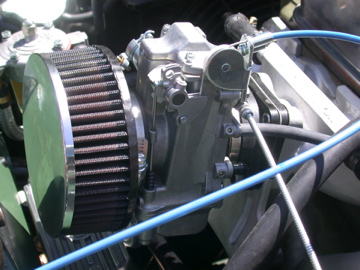
.jpg)
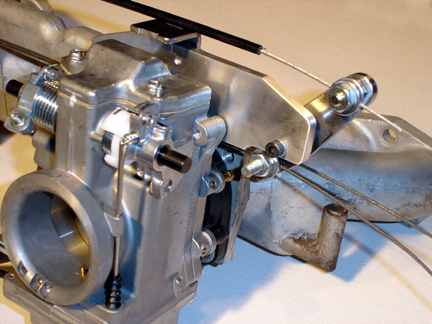
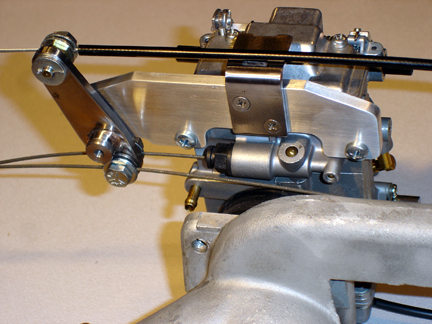
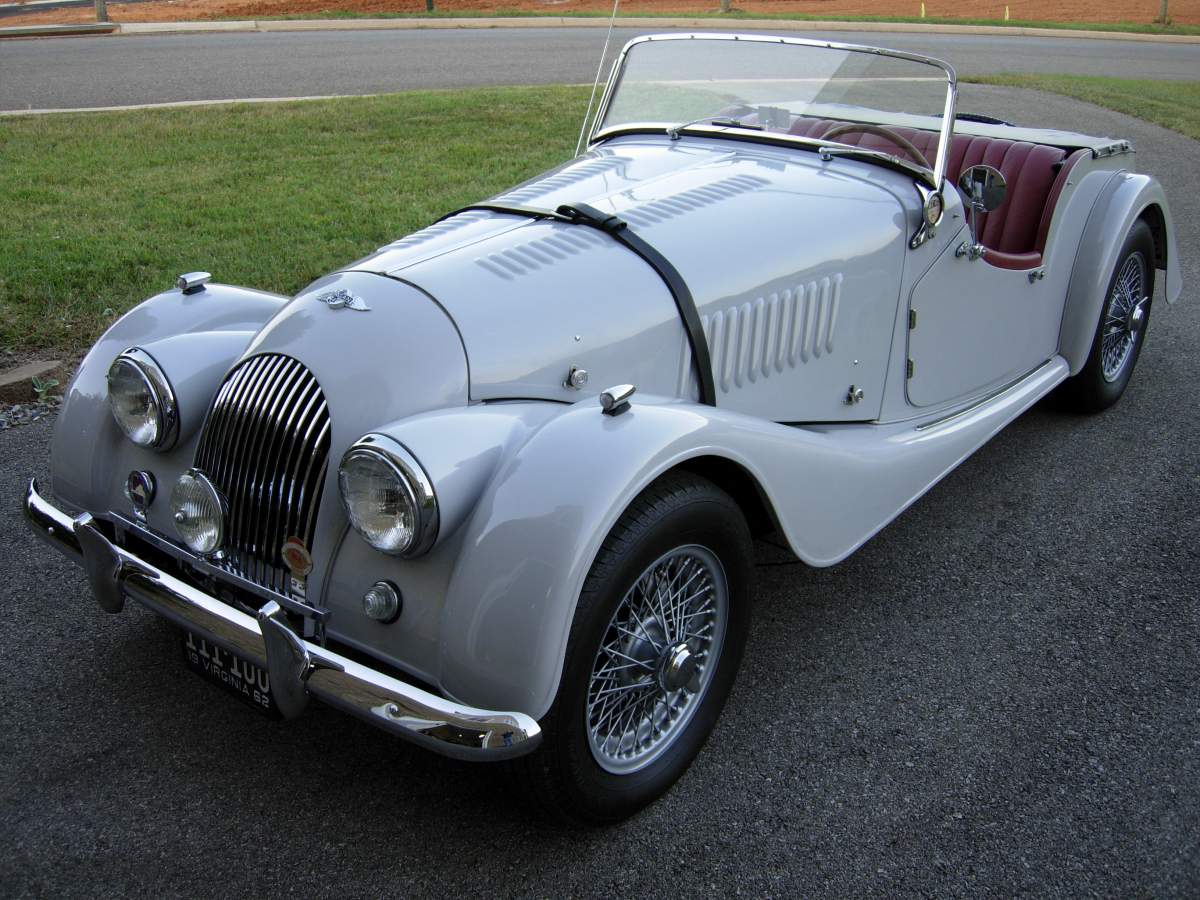
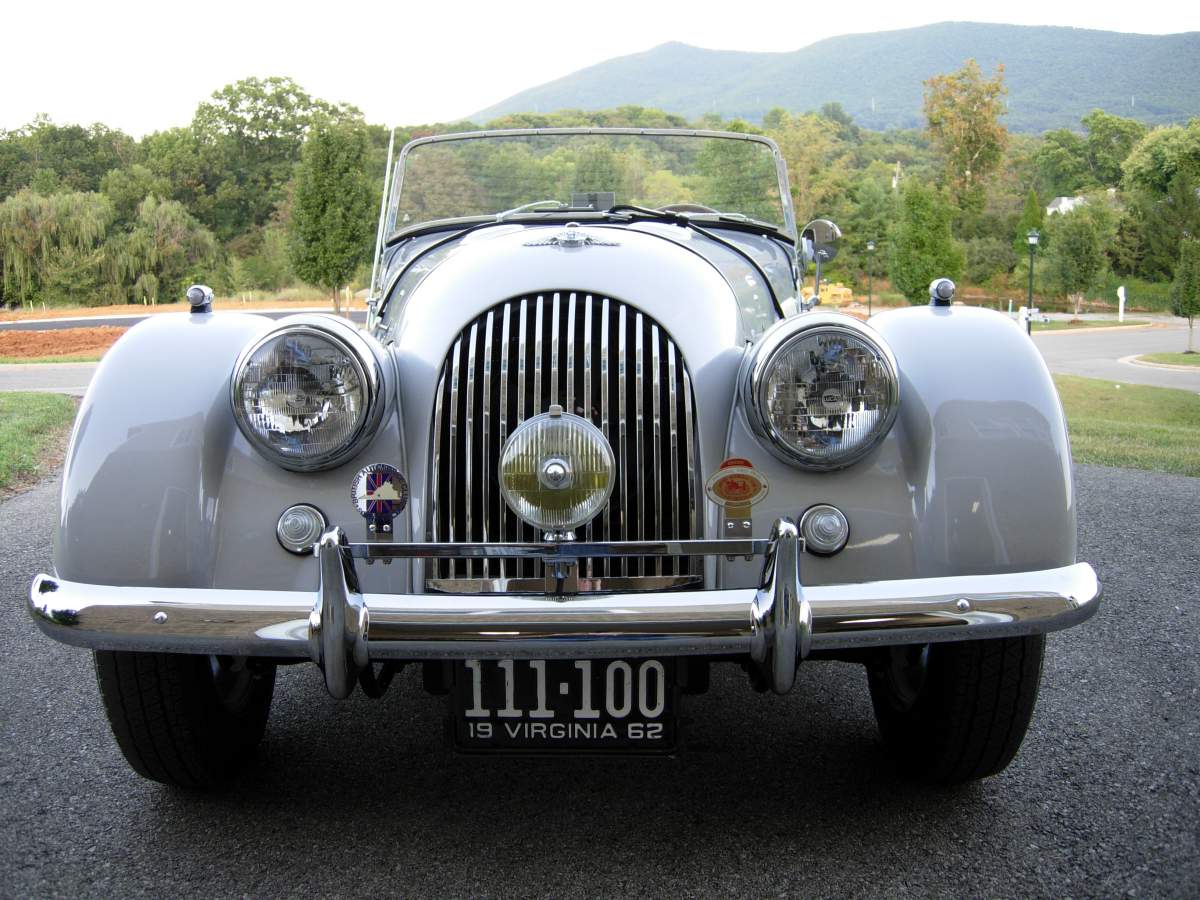
.jpg)
.jpeg)
